- Things To Do
- Ancient Egypt
- Area Guides
- General Information
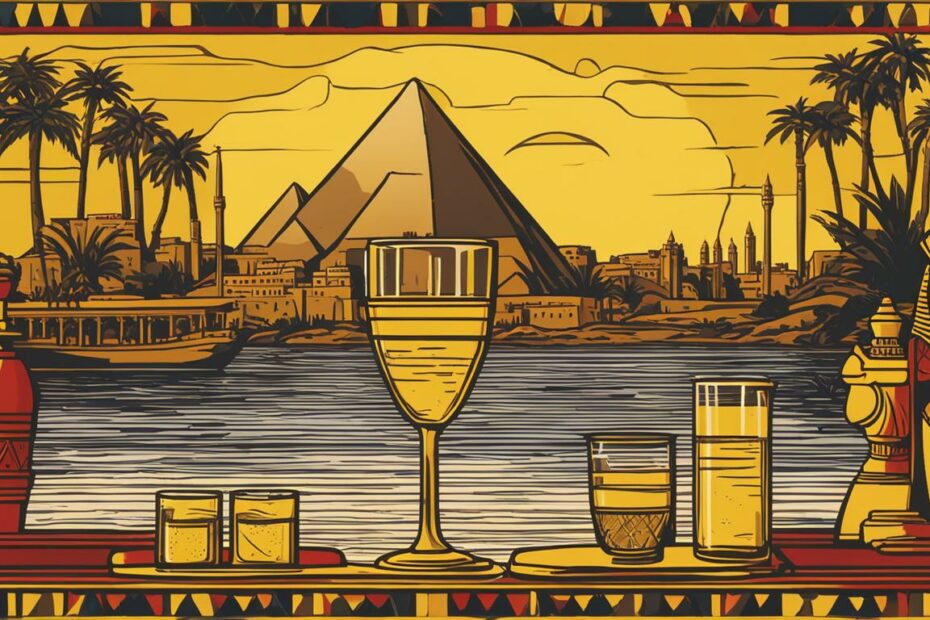

Is Egypt’s Tap Water Safe to Drink? Know Before You Go.
When planning a trip to Egypt, one of the questions that often comes up is whether the tap water is safe to drink. While travelers may have concerns about the quality of the tap water, it’s important to be well-informed before making any decisions.
According to multiple sources, including travelers on TripAdvisor, Egypt’s tap water is generally safe to drink in tourist areas. While the taste may not be as pleasant as bottled water, there is no significant health risk associated with drinking tap water.
However, it is important to note that some people may experience stomach upset due to the different mineral composition of the water. It is recommended to exercise caution and use bottled water for drinking, especially in areas with known hygiene and sanitation issues.
If you’re curious about the tap water in Egypt and want to know more about its safety, continue reading to get a better understanding of the situation.
Table of Contents
Water Treatment in Egypt
The quality of tap water in Egypt can vary depending on the region. Water treatment systems and pipes may be old and rusted, leading to potential contaminants in the water. Poor sanitation in some areas can also contribute to water contamination. Moreover, agricultural run-off water, untreated waste, and chemical pollutants can further affect the water supply. These factors can potentially increase the risk of waterborne diseases and gastrointestinal issues. Therefore, it is advisable to take precautions and opt for bottled water or boil tap water before drinking.
The Need for Water Treatment in Egypt
Egypt faces several challenges when it comes to maintaining water quality and preventing water contamination. The country’s aging water treatment infrastructure, coupled with inadequate sanitation practices, poses significant risks to the safety of tap water. Agricultural run-off, untreated waste, and chemical pollutants from various sources also contribute to the contamination of the water supply.
These factors highlight the importance of implementing effective water treatment processes to ensure the provision of safe and clean drinking water to the population. By treating the water at the source and regularly maintaining and upgrading the water treatment systems and pipes, the risk of waterborne diseases and gastrointestinal issues can be significantly reduced.
Water Contamination in Egypt
Water contamination in Egypt can result from various sources, including industrial activities, agricultural practices, and inadequate waste management systems. Chemical pollutants, such as pesticides and fertilizers used in agriculture, can seep into water sources and contaminate the water supply. Additionally, untreated waste, both human and animal, can introduce harmful pathogens into the water, further compromising its quality.
Furthermore, the presence of heavy metals, residual chlorine, and other pollutants in the water can have detrimental effects on public health. These contaminants can lead to acute and chronic health issues, ranging from gastrointestinal problems to more severe conditions.
The Impact on Water Quality
The poor water treatment practices and contamination issues in Egypt can significantly impact the overall water quality. Increased levels of bacteria, viruses, and chemical pollutants can pose health risks, making it important for individuals to take proper precautions when consuming tap water.
Bottled water, which is widely available, ensures a safe and reliable alternative for drinking. Boiling tap water before consumption is another effective method to kill pathogens and reduce the risk of waterborne diseases. However, it is essential to note that boiling the water may not eliminate chemical contaminants. Therefore, using a combination of water treatment methods, such as filtration and disinfection, can provide an additional layer of protection.
Overall, to safeguard personal health and well-being, it is advisable to prioritize bottled water or adequately treated tap water for drinking purposes in Egypt.
Water Treatment Methods in Egypt
Efforts are being made in Egypt to improve water treatment processes and enhance water quality. Various methods, including filtration, disinfection, and desalination, are employed to treat the water and remove contaminants.
Water treatment plants in Egypt use advanced filtration systems to remove suspended particles and microorganisms from the water. Additionally, disinfection methods, such as the use of chlorine or ultraviolet (UV) light, are employed to kill bacteria, viruses, and other harmful pathogens.
Desalination, the process of removing salt and other minerals from seawater, is another method used to ensure a sustainable and reliable water supply in coastal regions where access to freshwater is limited.
By implementing these water treatment methods and continually investing in water infrastructure, Egypt strives to enhance water quality and provide safe drinking water to its population.
Implementing a combination of these water treatment methods enables Egypt to tackle the challenges associated with water quality and ensure the provision of safe and clean drinking water to its residents and visitors.
Tips for Safe Hydration in Egypt
To ensure safe hydration in Egypt, there are a few measures that can be taken. The following methods can help purify tap water and minimize the risk of waterborne diseases:
1. Boiling Tap Water
Boiling tap water is a common and effective method to purify it. The process involves bringing the water to a rolling boil and then allowing it to cool before consumption. Boiling kills pathogens that can cause gastrointestinal infections, making the water safer to drink.
2. Bottled Water
Relying on bottled water is also a safe option as it is free from contamination. However, it is important to check for proper sealing of the bottle to avoid reusing or recycled containers. Bottled water is readily available in most tourist areas in Egypt.
3. Water Treatment Methods
Some establishments in Egypt use various water treatment methods to ensure safe drinking water. These methods include filtration, UV (ultraviolet) disinfection, and chemical disinfection. These processes remove or kill harmful contaminants, making the water suitable for consumption.
It is important to note that water purification methods may vary depending on the region in Egypt. As a precaution, it is advisable to use bottled water or boil tap water before consumption, especially in areas with known hygiene and sanitation issues.
In addition to purifying drinking water, it is essential to ensure proper hydration by drinking an adequate amount of water throughout the day. Staying hydrated helps prevent dehydration and maintains overall health and well-being.
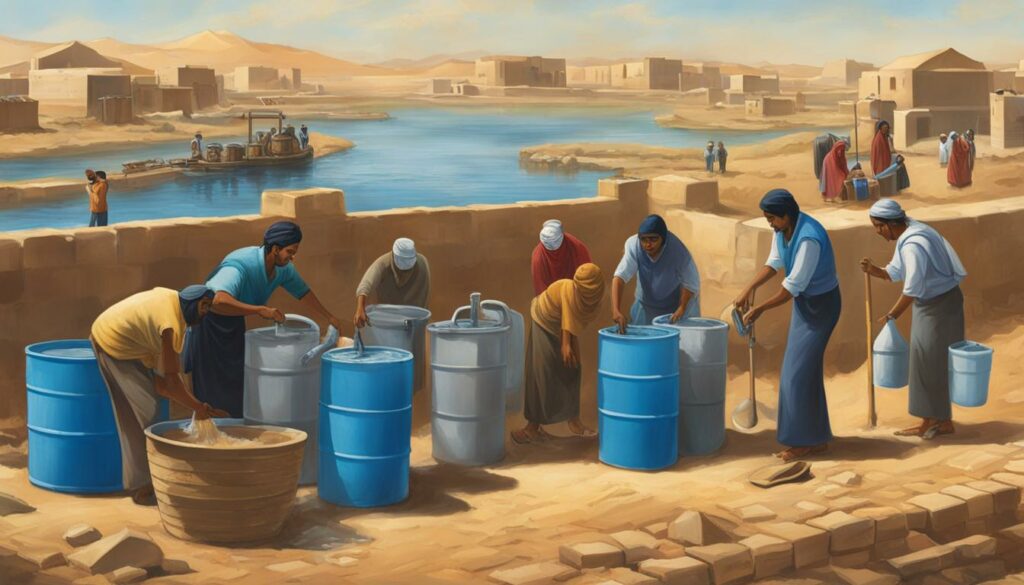
Food Safety in Egypt
In Egypt, food safety is a crucial consideration for travelers. The risk of gastrointestinal illnesses through food consumption can be high, especially when consuming unfamiliar dishes or dining at unhygienic establishments. To minimize the chances of foodborne diseases, it is recommended to follow these guidelines:
1. Prepare Fruits and Vegetables Properly
Peeling or cooking fruits and vegetables before consumption is essential to remove potential contaminants. This reduces the risk of waterborne diseases in Egypt.
2. Avoid Undercooked or Raw Meat, Seafood, and Unpasteurized Dairy Products
Consuming undercooked or raw meat, seafood, and unpasteurized dairy products can expose you to harmful bacteria and parasites. Ensure that these foods are thoroughly cooked and properly handled to ensure food safety.
3. Practice Proper Hand Hygiene
Poor hand hygiene can contribute to food contamination. It is important to wash hands thoroughly with soap and water before handling food, especially when eating street food or dining at local establishments.
4. Prevent Cross-Contamination
Cross-contamination between raw and cooked food should be avoided. Keep raw and cooked food separate, use separate utensils and cutting boards, and ensure proper cleaning and sanitization of kitchen surfaces.
5. Choose Reputable Restaurants
When dining out in Egypt, it is advisable to eat at reputable establishments that prioritize food safety. These restaurants generally have higher hygiene standards and properly trained staff.
Following these food safety practices will help minimize the risk of foodborne diseases while traveling in Egypt.
Travel Insurance and Health Expenses in Egypt
When planning a trip to Egypt, it is crucial to prioritize your health and ensure that you are adequately prepared for any unforeseen circumstances. One vital aspect of your travel preparation is obtaining travel insurance that covers health expenses in Egypt. This is especially important since Egypt does not have health agreements with countries like the United States, Canada, Australia, or the UK.
Travel insurance provides you with financial protection in case you require medical attention during your trip. From minor illnesses and injuries to more serious emergencies, having travel insurance can help alleviate the financial burden that may arise from unexpected healthcare expenses.
To avoid any potential financial strain due to health-related issues, it is strongly recommended to obtain travel insurance before traveling to Egypt. By booking a travel insurance policy, you can have peace of mind knowing that you are covered in case of any medical emergencies that may occur during your time in Egypt.
In addition to covering health expenses, travel insurance may also provide other benefits such as trip cancellation or interruption coverage, baggage loss or delay coverage, and emergency medical evacuation. These additional benefits can further enhance your overall travel experience and help mitigate any potential disruptions or losses.
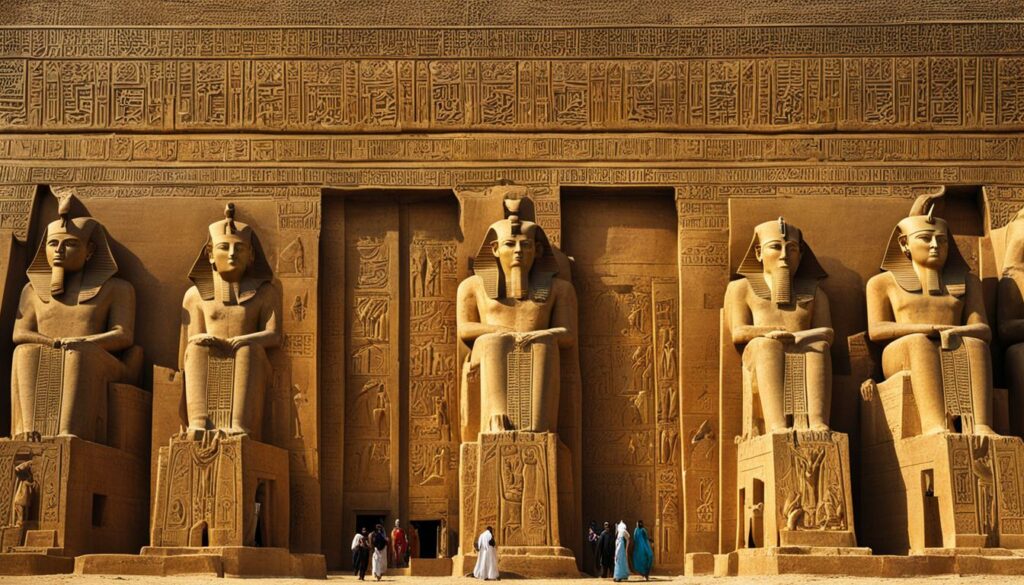
Remember, accidents or illnesses can happen at any time, and being prepared with comprehensive travel insurance ensures that you have the necessary financial protection to handle any unforeseen situations that may arise during your trip to Egypt. Prioritizing your health and well-being through travel insurance is an essential step towards enjoying a safe and worry-free journey.
Staying Hydrated and Sun Protection in Egypt
With its high temperatures, staying hydrated is essential when visiting Egypt to avoid dehydration and sunstroke. Additionally, protecting yourself from the sun’s harmful rays is crucial for maintaining good health. Here are some tips to ensure you stay hydrated and protected during your time in Egypt:
1. Carry and Apply Sunscreen Regularly
Protect your skin from sunburn and damage by carrying a high SPF sunscreen and applying it regularly throughout the day. Choose a sunscreen that provides broad-spectrum protection against both UVA and UVB rays, and don’t forget to reapply after swimming or excessive sweating.
2. Drink Plenty of Water
To prevent dehydration, make sure to drink plenty of water. The hot climate in Egypt can cause excessive sweating, leading to fluid loss. Keep a bottle of water with you at all times and aim to drink at least 8 glasses of water each day. Avoid consuming too many caffeinated or alcoholic beverages, as they can contribute to dehydration.
3. Avoid Prolonged Exposure to Direct Sunlight
Avoid spending prolonged periods in direct sunlight, especially during the hottest parts of the day. The sun’s rays are strongest between 10 am and 4 pm, so try to seek shade or indoor locations during this time. If you need to be outside, wear a wide-brimmed hat, sunglasses, and lightweight, breathable clothing that covers your skin.
By taking these precautions, you can stay hydrated and protect yourself from the sun’s harmful effects while exploring the wonders of Egypt.
Hand Hygiene and Health Precautions in Egypt
Maintaining proper hand hygiene is crucial for preventing illness while in Egypt. Travelers should regularly wash their hands before eating or touching their faces to minimize the risk of infections. As with any trip, it is important to take general health precautions, such as getting necessary vaccinations and practicing good personal hygiene. By following these simple measures, travelers can minimize the likelihood of health-related issues during their stay in Egypt.
Hand Hygiene Tips:
- Wash hands with soap and clean water for at least 20 seconds before eating, after using the restroom, and after touching surfaces in public places.
- If soap and water are not available, use hand sanitizer containing at least 60% alcohol.
- Avoid touching the face, especially the eyes, nose, and mouth.
General Health Precautions:
- Ensure you are up to date with routine vaccinations, including measles, mumps, rubella (MMR), diphtheria, tetanus, pertussis (DTaP), and influenza.
- Protect yourself against mosquito-borne diseases by using appropriate insect repellents and wearing protective clothing.
- Practice safe food handling and avoid consuming raw or undercooked meats, seafood, and dairy products.
- Stay hydrated by drinking plenty of bottled water and avoiding tap water.
- Protect yourself from the sun’s harmful rays by wearing sunscreen, a hat, and sunglasses.
Conclusion: Exploring Egypt Safely
When planning a trip to Egypt, it is important to prioritize your health and safety to ensure a memorable and enjoyable experience. While tap water in Egypt is generally safe to drink, it is advisable to take precautions by using bottled water or boiling tap water as added measures.
Another critical aspect of maintaining good health in Egypt is focusing on food safety. Be sure to practice proper hand hygiene and avoid consuming potentially contaminated food. By peeling or cooking fruits and vegetables, avoiding undercooked meat and seafood, and opting for reputable restaurants, you can minimize the risk of foodborne illnesses.
Additionally, travel insurance is essential to cover any unexpected health-related expenses that may arise during your trip. It is recommended to obtain travel insurance before traveling to Egypt to provide peace of mind and financial protection.
Lastly, staying hydrated and protected from the sun is vital, especially in Egypt’s climate. Drink plenty of water, apply sunscreen regularly, and avoid prolonged exposure to direct sunlight during the hottest parts of the day.
By following these guidelines and taking necessary precautions, you can explore Egypt safely and fully embrace all that this remarkable country has to offer.
Is Egypt’s tap water safe to drink?
Egypt’s tap water is generally safe to drink in tourist areas. However, some people may experience stomach upset due to the different mineral composition of the water. It is recommended to exercise caution and use bottled water for drinking, especially in areas with known hygiene and sanitation issues.
What affects the quality of tap water in Egypt?
The quality of tap water in Egypt can vary depending on the region. Water treatment systems and pipes may be old and rusted, leading to potential contaminants in the water. Poor sanitation in some areas and agricultural run-off water, untreated waste, and chemical pollutants can further affect the water supply.
How can I ensure safe hydration in Egypt?
To ensure safe hydration in Egypt, you can boil tap water to purify it or rely on bottled water, which is free from contamination. Some establishments in Egypt also use water treatment methods like filtration, UV, and chemical disinfection to ensure safe drinking water.
What should I know about food safety in Egypt?
To minimize the risk of foodborne diseases, it is recommended to peel or cook fruits and vegetables before consumption, avoid undercooked or raw meat, seafood, and unpasteurized dairy products, ensure proper hand hygiene, and prevent cross-contamination between raw and cooked food. It is also advised to eat at reputable restaurants and avoid street food.
Do I need travel insurance when visiting Egypt?
Yes, it is important to have travel insurance when visiting Egypt, as the country does not have health agreements with countries like the United States, Canada, Australia, or the UK. Travel insurance will help cover any health-related expenses that may arise during the trip.
How can I stay hydrated and protected from the sun in Egypt?
To stay hydrated, it is crucial to drink plenty of water and avoid prolonged exposure to direct sunlight, especially during the hottest parts of the day. Travelers should also carry sunscreen and apply it regularly to protect themselves from the sun’s harmful rays.
What should I know about hand hygiene and health precautions in Egypt?
Regularly washing hands before eating or touching the face is crucial for preventing illness in Egypt. It is also important to take general health precautions such as getting necessary vaccinations and practicing good personal hygiene.
How can I explore Egypt safely?
By following guidelines such as using bottled water or boiling tap water, ensuring food safety, having travel insurance, staying hydrated, protecting oneself from the sun, maintaining proper hand hygiene, and taking necessary health precautions, travelers can explore Egypt safely and enjoy their trip to the fullest.
Leave a Reply Cancel reply
Your email address will not be published. Required fields are marked *
Save my name, email, and website in this browser for the next time I comment.
Egypt Travel Tips: 24 Essential Things You Should Know Before You Visit Egypt (2024)
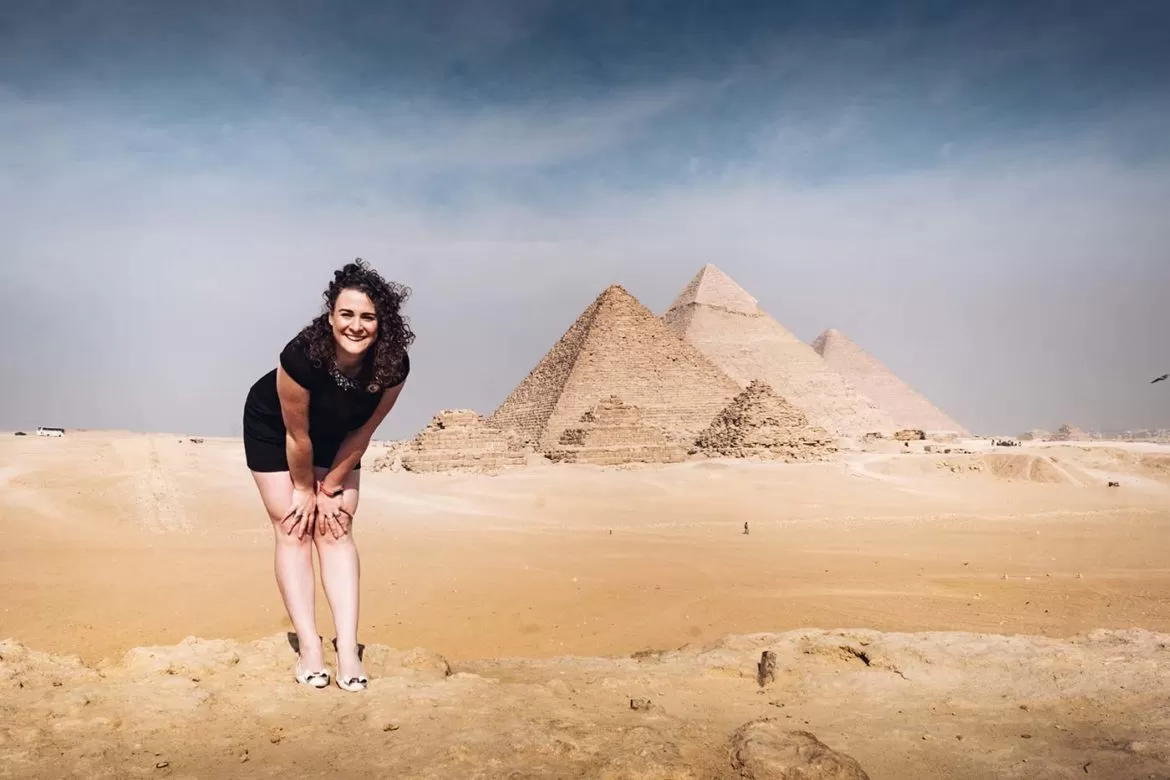
Travelling to Egypt? This Egypt travel tips guide will give you a detailed rundown of absolutely everything you should know before visiting Egypt. Including what to wear, tipping culture, scams, and loads of other useful hacks.
Egypt is awesome. Seeing its magnificent monuments and the mighty Nile will no doubt leave a lasting impression on you.
If you’re reading this, then there’s are good chance you have either booked your flights to Egypt or you’re seriously considering going. Either way, that’s great! You’ve come to the right place and are in good hands.
You won’t regret deciding to travel to Egypt. I know you will have a fabulous time.
How do I know that? Because you’re here reading this article!
You’re doing the right thing by researching and arming yourself with information. This is guide covers literally everything you need to know before visiting Egypt.
This is a very honest (and sometimes brutally honest) guide. No sugar-coating. My intention is not to be a Debbie Downer. I simply want to prepare you, so you will have a wonderful time because there won’t be any nasty surprises.
You won’t find a more comprehensive guide out there on how to prepare for and what to expect in Egypt. I’ve literally poured all my knowledge (and then some!) into this guide because just like you, I was both excited about going to Egypt but also very anxious and probably a bit paranoid too.
With that in mind, here’s everything we’ll cover. Plus a bonus tip at the end you won’t want to miss!
Looking for something in particular? Use this table of contents below to jump around using the links.
Table of Contents
Why you should go to egypt, is it safe to travel to egypt.
- Is Egypt Safe for Solo Female Travellers?
- Survival Arabic Language Guide
When Should You Go to Egypt?
What is the safest way to travel around egypt.
- Food and Upset Stomachs
- Heat and Hydration
- Vaccinations
- Haggling and Bargaining
- Nothing is free
- Cairo Airport
- Crossing the road
- Photography
- Camel Rides
- School Children
- Mosques and Religious Sites
- Fridays and Saturdays
- BONUS TIP: Fake Papyrus Scam
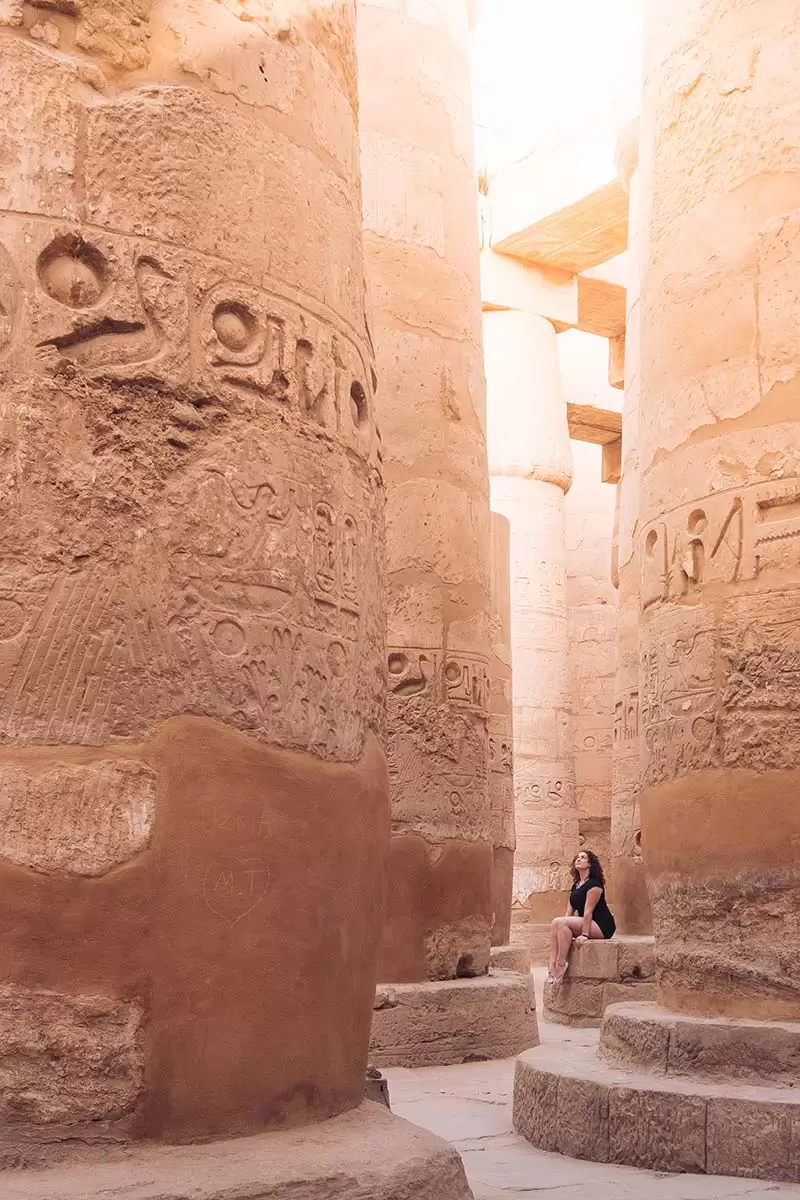
Karnak Temple
There’s so much to love about Egypt and nothing comes close to experiencing it in in person and not through a TV screen. The history, the temples, the smells, the heat, the sand, the Nile and the moment when your eyes finally gaze up at the Pyramids of Giza. All along the Nile you can trace the Ancient Egyptians through history as you visit their impressive and carefully decorated temples and tombs. Learning about the Ancient Egyptians, how they lived, their beliefs, inventions, and actually seeing their creations is something that will stay with you forever. Egypt is simply a marvel that should be experienced by everyone.
Yes! It’s much safer than the media may lead you to believe. Which is probably why you’re here reading about this Egypt travel tips guide
As an Aussie, I always check the Australian Smart Traveller site for travel warnings. This is the equivalent of the travel warning list by the U.S Department of State for American citizens.
While Egypt is currently listed with a Level 2 travel warning (go to page 4 ) (True as of August 19, 2018), it’s important to remember that governments will always err on the side of caution.
There are four levels used. Where Level 1 means ‘exercise normal precautions’ and Level 4 means ‘do not travel’.
As you can see, this particular warning doesn’t mean you shouldn’t travel. It just means that certain areas are better off being avoided and you just need to be more cautious when visiting them. That’s up to you to decide what you’re most comfortable with.
As of August 2018, the areas of Egypt which are flagged as dangerous are:
- The Sinai Peninsula (with the exception of travel to Sharm El-Sheikh by air) due to terrorism.
- The Western Desert due to terrorism.
- Egyptian border areas due to military zones.
The site goes on to suggest ways in which you can reduce any risk:
- Stay alert in locations frequented by Westerners.
- Avoid demonstrations and crowds.
- Obtain comprehensive medical insurance ( get a free quote here ) that includes medical evacuation.
- Enroll in the Smart Traveler Enrollment Program (STEP) to receive Alerts and make it easier to locate you in an emergency.
- Follow the Department of State on Facebook and Twitter.
- Review the Crime and Safety Report for Egypt.
- U.S. citizens who travel abroad should always have a contingency plan for emergency situations. Review the Traveler’s Checklist.
There are other ways you can ensure your safety and help you to feel more confident with your decision to travel to Egypt. This is covered in a later section.
Because of all the negative attention Egypt has received, tourism has fallen drastically which is great for us travellers but not so great for the locals who depend on the tourist dollar.
With fewer visitors, there are also fewer scammers and smaller crowds at famous attractions. So, there is a silver lining.
On a more personal note, I felt safe during my entire Egypt trip which started in Cairo and went all the way down the Nile to Abu Simbel near the Sudan border.
If I can offer any addition peace of mind, it’s that tourist attractions are generally the safest areas to be in in Egypt as they are heavily guarded.
In addition to this, the locals who I met in hotels, restaurants, supermarkets, souks and the Telecom store where I bought my local SIM card, were all very helpful, kind, and friendly.
Is Egypt safe for solo female travellers?
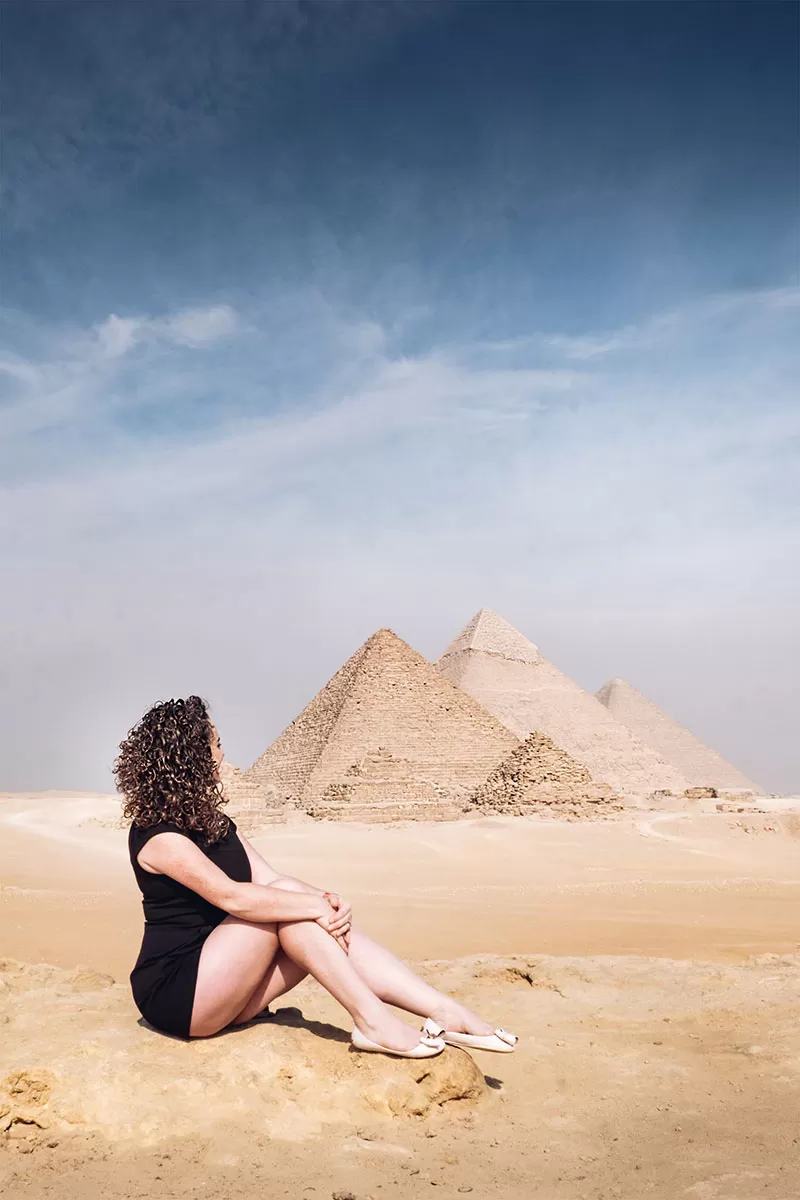
Admiring the Pyramids
Yes! While Egypt is safe, as a female, you will feel a little bit uncomfortable. This feeling will come mainly in open public places such as walking down the street and in souks.
It’s in these places that you will find men loitering, either by themselves or with a couple of other men. I can only describe this as people watching as most of the time they are sitting on plastic chairs and watching the world go by, including us.
If you’re female, you will receive a lot of looks. In my experience they were harmless. If anything, it just made me feel a bit self-conscious.
Sometimes these men will try to start talking with you or guess where you’re from (they’re very good at getting this right, by the way). Somehow they can tell an Australian from an American just by looking or listening to us speak. Very clever cookies.
It’s at this point, you should do what a local Egyptian man told to me, and that is, to ignore them. Don’t even look at them. This will be enough to discourage them. It might seem like you’re being rude, but ultimately it will protect you.
I was told that the seemingly harmless conversations that start with something like guessing where you’re from, will eventually lead into being invited into their home, shop or restaurant, where they will offer you tea (a traditional welcoming custom), then after some more small talk, they will present you with something and insist you buy it. If you decline, they will get angry.
Okay, so I just painted a terrible picture, but it’s important to be aware of these things. I experienced this first-hand and didn’t know what had happened until my local guide told me that it’s a very common ploy.
Not all men are like this by the way. Just some that give the rest a bad name.
Let’s move on, shall we?
Survival Arabic Travel Phrase Language Guide
Knowing some Arabic ahead of travelling to Egypt is such a game changer. When you can show that you speak a bit of the Arabic language and can recognise certain keywords, this will give you an extra layer of protection, especially when it comes to dealing with money.
Not only will you feel more in control, but locals will appreciate and respect your efforts to learn their language.
Here are 13 useful Egyptian Arabic words and phrases you should learn and use:
- Hello – salam / marhaban / ahlan
- Peace be with you – As-salāmu alaykum – Even though this literally means ‘peace be with you’, it is a commonly used greeting. The response would be Alaikum Salaam, meaning ‘upon you be peace’.
- Thank you – shukran
- Please – min fadlak (if you’re a male), min fadlik (if you’re a female)
- Y ou’re welcome – Afwan
- Yes – aywa, No – lā, Ok – Mashi
- How much is this? – bi-kam da. You can say, I’ll pay 100 – Enna hafda meeya. Incidentally, if you say ‘meeya meeya’ (’100, 100′) this means ‘perfect’ or ‘really good’.
- It costs too much – Da ghali awi
- I would like… – momkin
- I want – Enna iza (if you’re a female) or Enna ayez (if you’re a male). To negative the sentence, add ‘mish’. For example, ana mish iza/ayez (I don’t want)
- I don’t understand – ana mish fahem
- Go away – Em’shee
- Pyramid – Haram. Most Egyptians don’t understand the word “Pyramids”, so make sure you learn the Arabic word for them, especially if you’re taking a taxi there. Haram also means. The strict translation of the Arabic word ‘harim’ means (a prohibited place) and is from the verbal root ‘harama’ (prohibited), designated as ‘haram’ (a pyramid). ( Source )
For more Arabic phrases, get my free Arabic travel phrases guide here.
Between June and August, the temperature in Egypt is unbearable. While you may have the luxury of quiet tourist attractions and more hotel options, to be honest, in that heat you won’t want to do anything but relax in a pool somewhere.
The best time to visit Egypt is in Spring. The weather is pleasant and the major attractions such as the Pyramids of Giza, Aswan, and Luxor are still fairly quiet.
You’ll also benefit from cheaper hotel prices, especially if travelling either side of the high season which is December to February.
Avoid traveling during Ramadan.
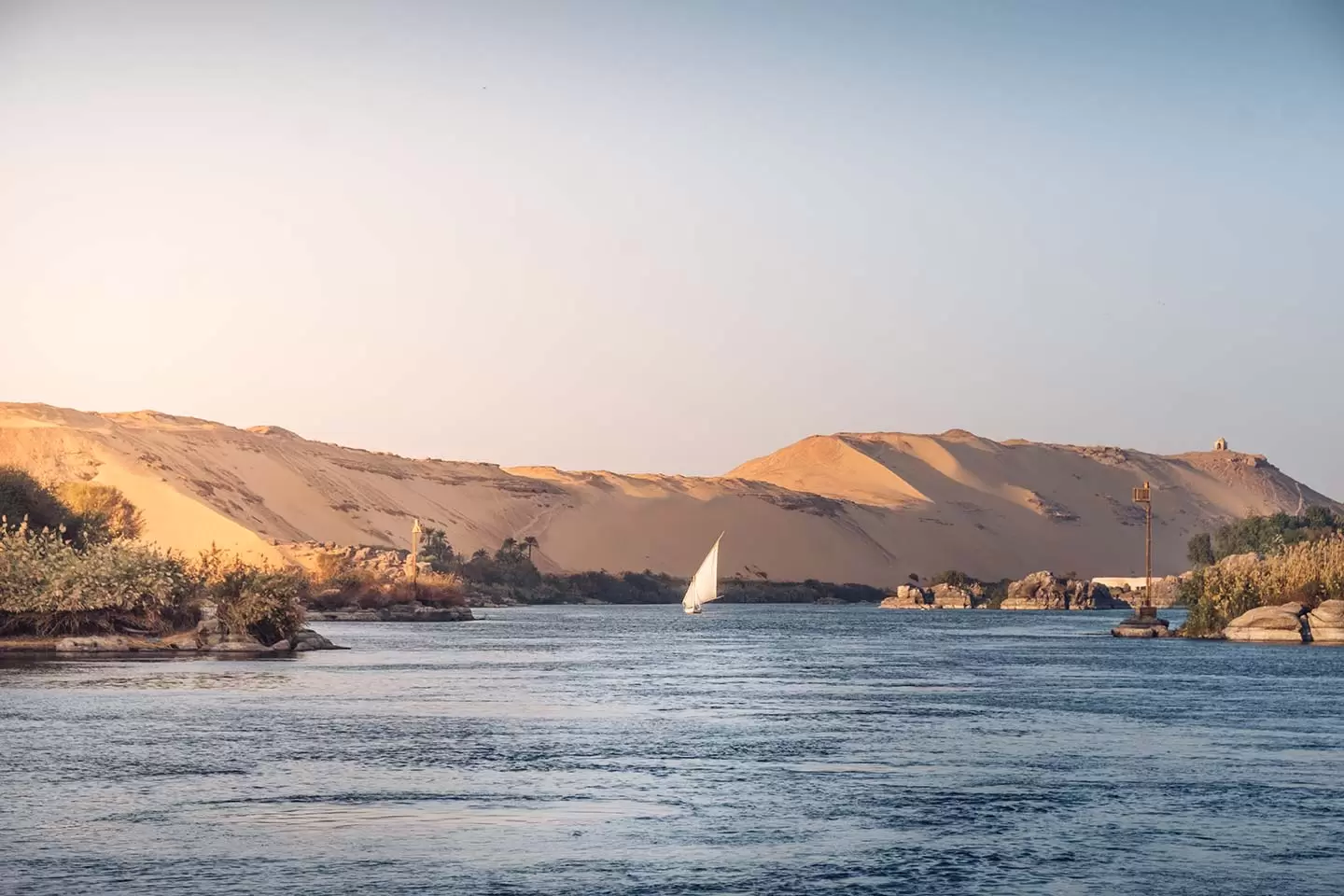
Cruising down the Nile at sunset
This is probably my top tip in this guide. It’s not Earth shattering, but it made all the difference to me and was the only way I could see myself travelling around Egypt and finally fulfil my childhood dream.
Go on an organised group tour!
To simplify and avoid overthinking everything, I knew that I had to travel with an organised group tour. That way I would have a local guide with me, I wouldn’t have to worry about transportation and other logistics and I could just concentrate on having a good time.
Choosing Topdeck to go to Egypt with was a no brainer, for two reasons. I’d already travelled with them before around Outback Australia and really rated my experience with them. The accommodation, transportation, guide and organisation was all spot on. Plus, I met some wonderful people that I’m still friends with.
The second reason (which might sound a bit silly) was that they are an Australian company, which I knew would put my dad’s mind at ease. I knew he would be super worried about me going. Even me living in London makes him worry!
By the way, remember that Egyptian guy I mentioned earlier who warned me about talking to strangers? That was our Topdeck tour manager, Ramzy. Top bloke!
Ramzy gave a bunch of useful tips, a language guide (on behalf of Topdeck), and was basically a kind of bodyboard who protected us from negative experiences and scared off a few scammers. This made all the difference. If you’re curious, I went on the Egypt Express tour . Book your Egypt tour here.
Now, let’s get into the niggity gritty of the everyday realities of travelling in Egypt.
Top 24 Egypt Travel Tips You Should Know Before You Visit Egypt
The tap water in Egypt is heavily chlorinated and tastes terrible. It’s okay for brushing your teeth with, but don’t drink it. Especially if you have a sensitive stomach. Buy bottled water. It’s easy to get and only costs 5 EGP (0.28 USD) for a 1-litre bottle.
2. Food and Upset Stomach
You’re in a foreign place with foreign food, diarrhoea will happen. To help prevent this, again, buy bottled water and check the seal isn’t broken. Avoid eating salads, raw vegetables, unpeeled fruit, and meat that isn’t thoroughly cooked. Don’t buy food from street vendors that don’t have running water. If you want an ice-cream, check that it hasn’t melted and been refrozen. If you do get an upset stomach, take diarrhoea relief tablets and drink plenty of purified water with fresh lime.
3. Heat and Hydration
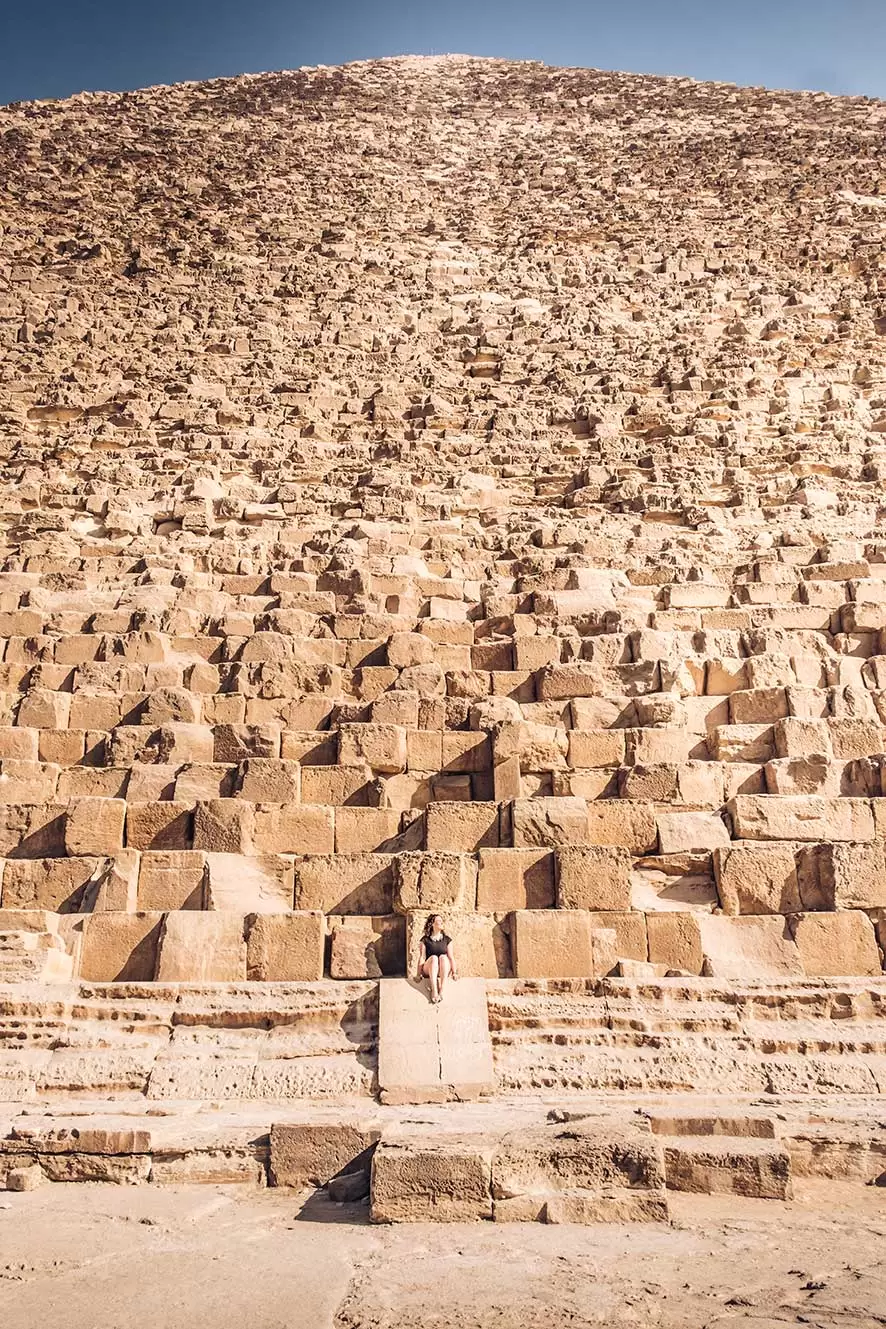
Looking up at the Great Pyramid of Giza
Egypt gets hot, obviously. You’re in the desert! Dehydration, sunburn and heat exhaustion are common, especially in Upper Egypt. As your sweat evaporates you may not realise how dehydrated you are.
If you’re travelling outside of winter, then I highly recommend wearing loose-fitting clothes made of natural fibre. Keep up your fluids up by carrying around this travel bottle and add a bit of extra salt to your food to replace salts lost in sweat. Pack electrolyte tablets to take just in case you feel unwell.
If you need further medical assistance, Egyptian pharmacists generally speak English and can be trusted to provide sound advice and help you find a doctor if needed.
4. Vaccinations
Officially, visitors to Egypt do not require any vaccinations unless you’re coming from an infected area. However, there are some vaccinations you should get or have topped up as a precaution.
Check with yourr GP what they recommend. Beyond ensuring your tetanus and polio is up to date, other common recommendations include getting vaccinations against typhoid, Hepatitis A and B, and rabies. Rabies is a problem throughout Egypt, so avoid touching stray animals such as cats, dogs, monkeys, and bats.
Money and Valuables
5. currency.
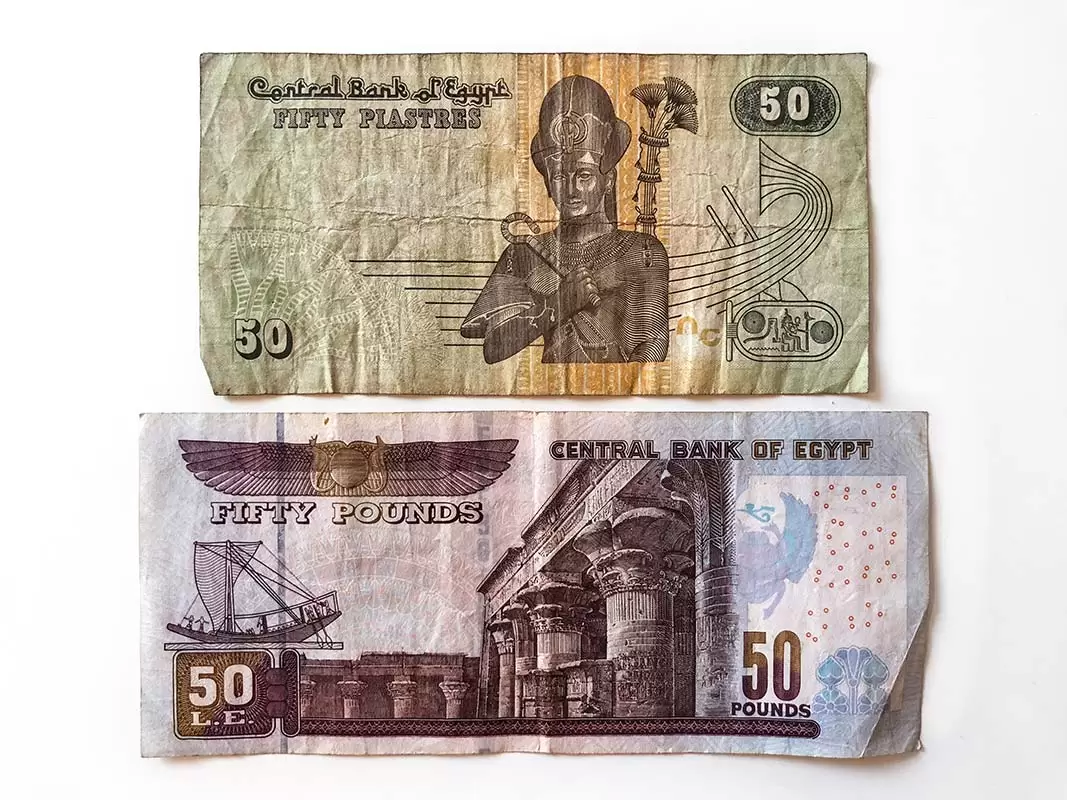
Remember the difference between 50 Piastres (top) and 50 Egyptian Pounds (bottom)
The unit of currency used in Egypt is the Egyptian pound, written £E or LE. The Egyptian pound is divided into piastres (pt). My top tip is to recognise the difference between the 50 pt against the 50 Egyptian Pound notes since they are very different in value.
Make sure that if you’re given change or are paying for something, that you’re not duped into thinking that 50 piastres (or cents) is the 50 Egyptian pounds note. This is a common scam that is used on unsuspecting tourists. When I found out about this, I made sure I kept both denominations on me so I could tell them apart. Compare the difference of the 50 pt and 50 LE in the photo above.
Another word to add your vocab is ‘baksheesh’, which means ‘tip’. You’ll hear this one a lot and it will be expected for anything and everything. Tipping locals for their services is expected and a way of life in Egypt.
Many Egyptians are paid such low salaries that receiving tips is an important part of their income. But rest assured you won’t have to fork out much.
In restaurants, it’s normal to round up the bill or give 10 per cent directly to the waiter. Smaller tips (0.25 piastres to 1 EGP) are given to the likes of lavatory attendants, porters, and anyone willing to bend the rules a bit like letting you enter a site after hours or taking a photo in a restricted area.
While the rules are often bent in Egypt, authorities are cracking down on certain things (like being able to take a photo inside King Tuts tomb) with hefty fines. Don’t risk offering money just to get your way.
7. Haggling and Bargaining
One of the best things to do in Egypt is to visit a souk market. When browsing comes to buying and you ask, bi-kam da? (How much is it?) be prepared to bargain hard or walk away. As a general rule, offer one third of the asking price and expect to pay half.
8. Nothing is free
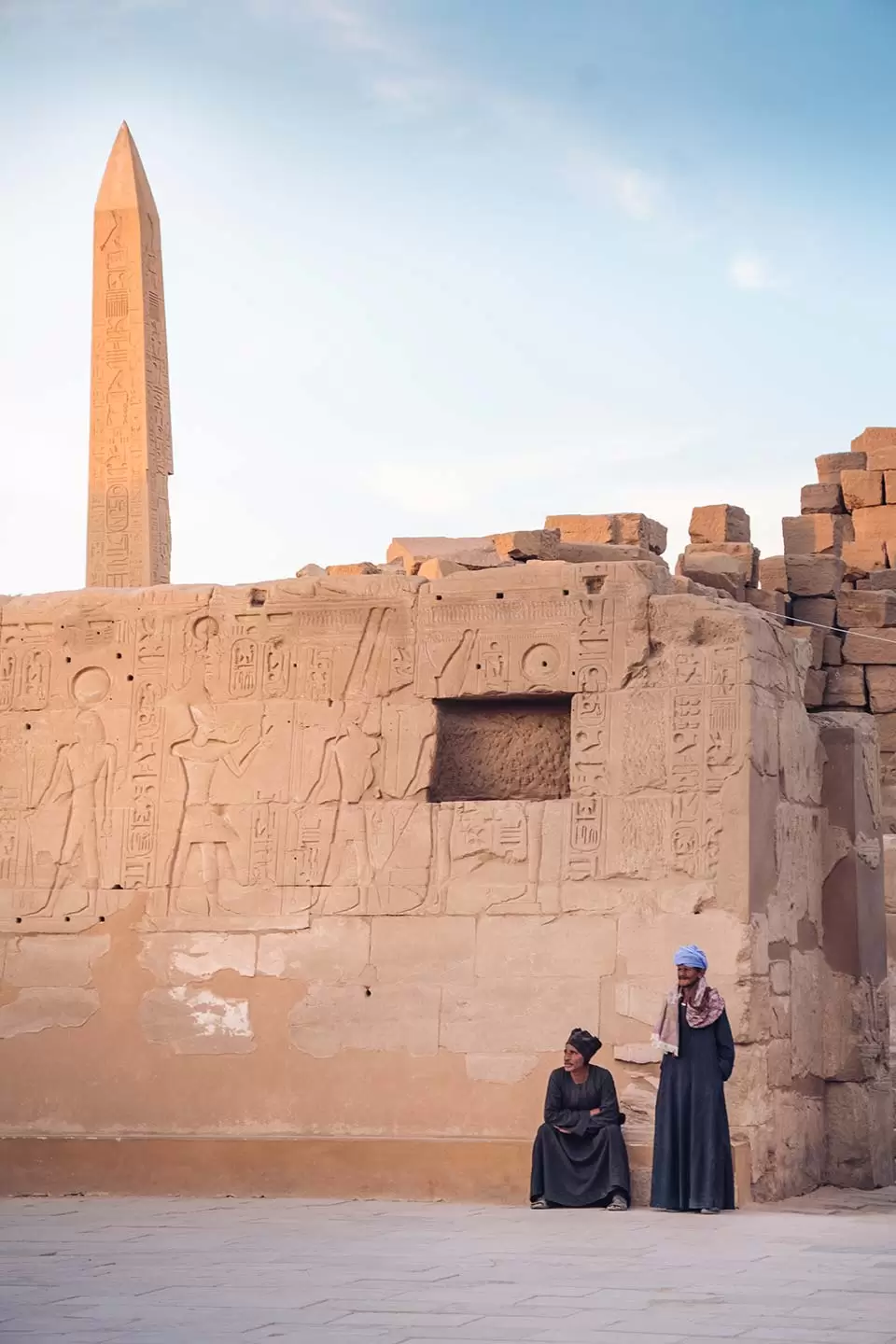
Taking a sneaky photo at Karnak Temple without being spotted
Want to take a photo of a camel at the Pyramids? If the owner catches you look, he will probably demand to be paid.
I learned this lesson the hard way. I was at least 20 metres away when I was spotted taking a photo of a camel resting. It’s up to you if you choose to offer the owner something and if you feel like you’ve done something wrong.
A similar incident happened when I was at Philae Temple. Three men were talking amongst themselves and with the temple behind them I thought it would make a great shot. With at least 50 metres between us , I took the shot. They spotted me and came over and offered to have a group photo. By this point I knew the drill and was happy to give them a little baksheesh.
9. Belongings
It goes without saying that you should always keep your valuables with you. Decide on whether or not you feel comfortable leaving your passport, laptop or iPad in the hotel room safe or if you’re better off keeping it on you. Using a PacSafe is a great option if you want to leave stuff in your room and there is no safe available.
If you go on a tour, don’t leave anything valuable on the bus, even if the driver is around. They can’t be responsible if something happens.
What to Wear
10. clothing.
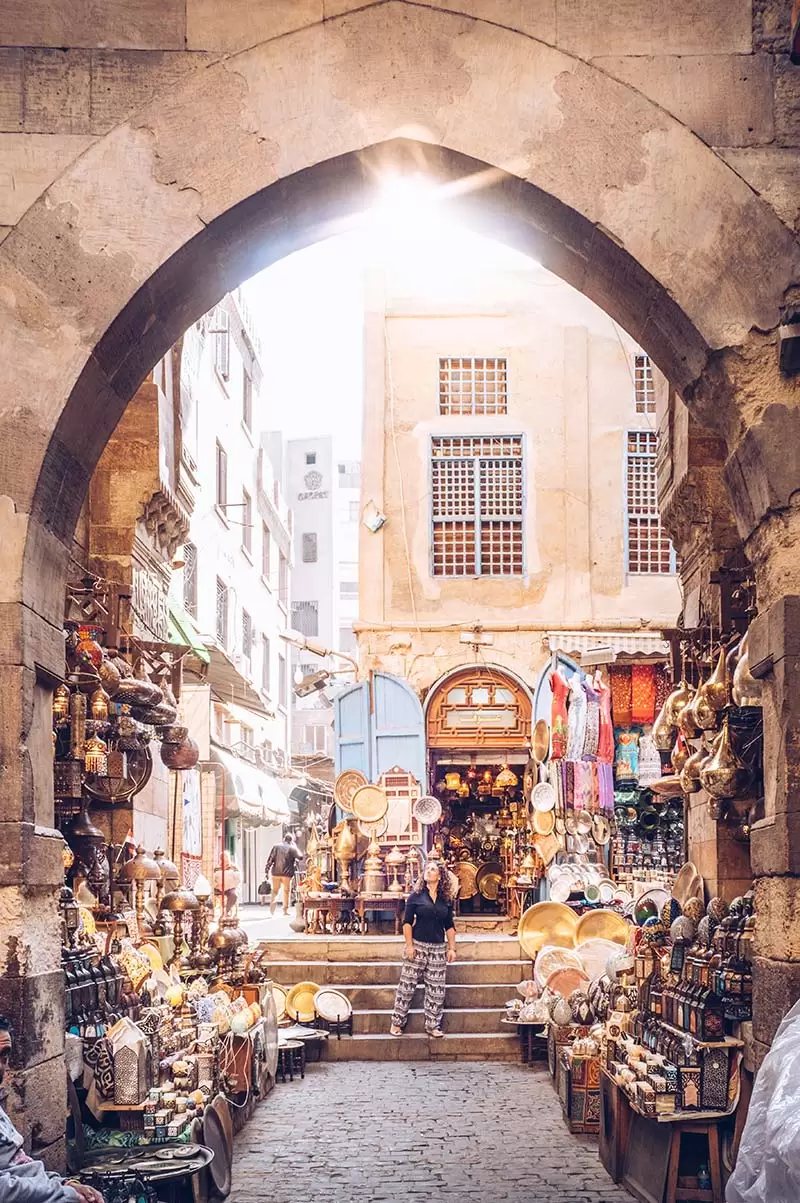
Khan el-Khalili market in Cairo
Egypt is dusty, sandy, and dirty. Your clothes will dirty easily and you’ll be washing your hair most nights. Be prepared to rinse out your clothes each night ( this will do the trick ) or pack extra items to wear.
So, what should you wear? As a general rule, wear loose-fitting clothes that are made of breathable material.
Ladies, it’s a bit more complicated for us. While Egypt is one of the more liberal Islamic countries, it has become more conservative in recent years with many women wearing a hijab or headscarf. Female tourists aren’t obligated to wear these but you may feel more at ease doing so, especially in mosques.
As a general rule, avoid showing your chest, shoulders or legs below the knees.
At this point you’re probably looking at my photos wondering why I didn’t cover up my legs, and you’re right! I did pack longer dresses, but when Ramzy told the group that it’s ok to wear shorts and normal summer attire when visiting monuments such as the Pyramids and the temples along the Nile, I felt comfortable in taking his advice.
The only exception he made was when visiting mosques, markets or souks. Which is why you’ll see me wearing long pants in the photo above in Khan el-Khalili souk in Cairo.
If you’re a female travelling alone, place ring on your wedding finger, this will show respectability.
11. Footwear
However hot and tempting it maybe to wear flip flops, with all the dirt, sand and grime present, I recommend wearing closed toe shoes.
You’re going to be doing a lot of walking in some pretty unclean areas and the last thing you want is having dirty feet all day.
Getting Around and Transportation
You need a visa! For Americans and Aussies, and a few other countries, you can either apply in advance for an Egypt e-Visa , or queue at the border for a visa on arrival.
For most travellers, the visa will cost roughly $USD25 (single entry, valid for 30 days) or $USD35 (multi-entry). Since I travelled with Topdeck, they organised my visa once I arrived. All I had to do was bring American Dollars to pay for it. Only American Dollars or Egyptian Pounds are accepted. In addition to your visa, ensure your passport is valid six months beyond your planned date of entry.
Taxis are cheap and easy to use. Simply go to a main street and wave your hand, that’s it. They even have Uber if you prefer! Just be sure he follows the GPS.
Before jumping in the taxi, agree on the price beforehand and stick to it. Not matter what reason they come up with. For getting around Cairo, you can expect to pay 50 to 80 EGP. (2.70 – 4.50 USD).
If you’re staying in Downtown Cairo, getting to the Pyramids should only take 30 minutes, but Cairo has very busy roads so it can take 60-90 minutes.
There are three kinds of taxis in Cairo: Black Taxis, Yellow Taxis and White Taxis. Black taxis are the oldest ones. Most are without a meter and without air-conditioning. White taxis are the modern equivalent of black taxi. They have a meter and air-conditioning. Yellow taxis are professionally run and can be booked over the phone but are the most expensive. I recommend getting a white taxi and bargaining hard.
14. Air travel
With raised safety concerns in Egypt, some airlines like British Airways are becoming more strict with what you can take in your carry-on luggage or even in your checked luggage.
I flew both ways with British Airways but they only had an issue when returning to the UK. They had very strict guidelines on what size lithium batteries were allowed on board.
A bunch of us were fuming when we were forced to leave behind expensive powerbanks which we weren’t reimbursed for or given alternatively means of keeping them. To give you an idea, this is the one I had to part with. *sniff*.
Air France, who were also flying that day but didn’t have this rule. Check with your airline ahead of travelling so you’re not caught out and left out of pocket.
15. Cairo Airport
Cairo Airport is unlike any airport you’ve experienced. Upon arrival, everything seems pretty standard until after you go through passport control.
Once you pick up your luggage and head to the exit, there will probably be a massive long queue that wraps around the luggage collection hall. Guarding the exit is one or two men who will look you up and down and decide if they want to check your luggage.
Since we were with a Topdeck escort who came to help us get a visa and take us to the hotel, he was on familiar terms with the airport staff and was able to get us through quickly.
Once we got through to the other side, our escort disappeared briefly to hand back a permit he was given in order to come and meet us inside. This is just another reason why travelling with an organised tour is great.
If, at the end of your trip you leave via Cairo Airport, be prepared for three separate security checks; one as soon as you enter the airport at the entrance, one at customs, then another at the gate. The first one is where they’ll flag any illegal objects like my poor powerbank .
16. Crossing the road
Crossing the road in Cairo is a skill. If you’ve ever been to Rome and stared down a driver then confidently walked out into a busy street, then you’re well-prepared for Cairo.
If locals see you struggling to cross, they will either let you join their own crossing convoy or come and assist you.
If you’re still too nervous to go it alone, you have some other options for crossing the road:
- Wait for a lull in the traffic before crossing (this may take a while).
- If possible, cross where there is only 1 or 2 lanes of traffic. Don’t stop in the middle of the road between the two lanes either. Cars will drive dangerously close to you while you wait for the other lane to have an opening.
- Ask someone to join them as they cross. If they can’t understand English, simply smile and indicate to the other side of the road.
- Find a policeman to help you, there are plenty around.
17. Driving
Whilst driving from Cairo to Luxor during the night, I noticed that many drivers didn’t have their headlights on. This is totally normal and nothing to be concerned about. Egyptians believe they see better this way.
When a car is approaching, they’ll flash their lights to let them know they’re there. Some drivers may keep their fog lights on. If you’re wondering, our Topdeck driver kept his headlights on.
Cultural Tips and Other Useful Tips
18. photography.
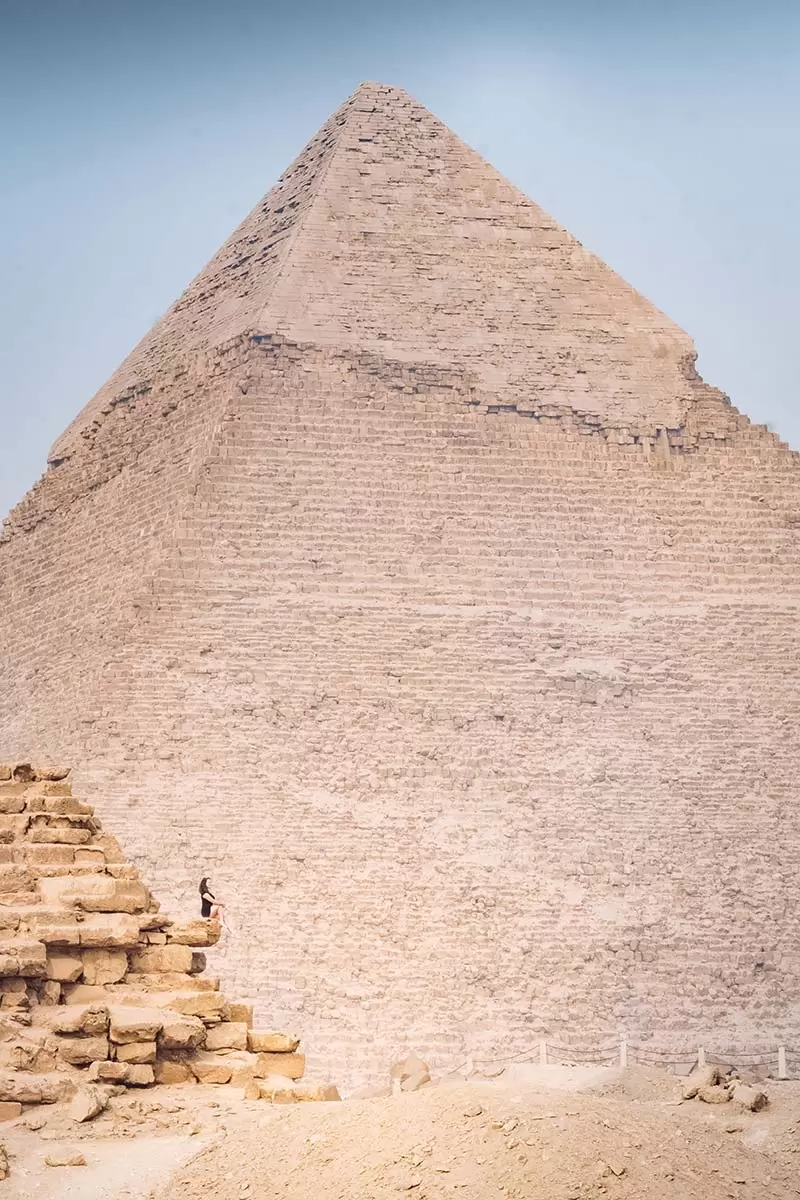
You will have to pay a small fee to take your camera inside the Pyramids Complex
Want to take your camera with you? Be prepared to pay for it!
Whether you want to take photos or film video, every monument, temple, tomb and museum you visit will charge a small fee just to take it inside. Expect to pay anything from 50 to 100 EGP (2.70 – 5.60 USD).
I was even charged extra when guards are Philae temple saw my tripod. At first they wouldn’t let me take it at all then they came around when I said I wouldn’t use it so they charged me for another camera ticket.
Once inside, flash photography is generally forbidden and should be strictly followed.
19. Camel Rides
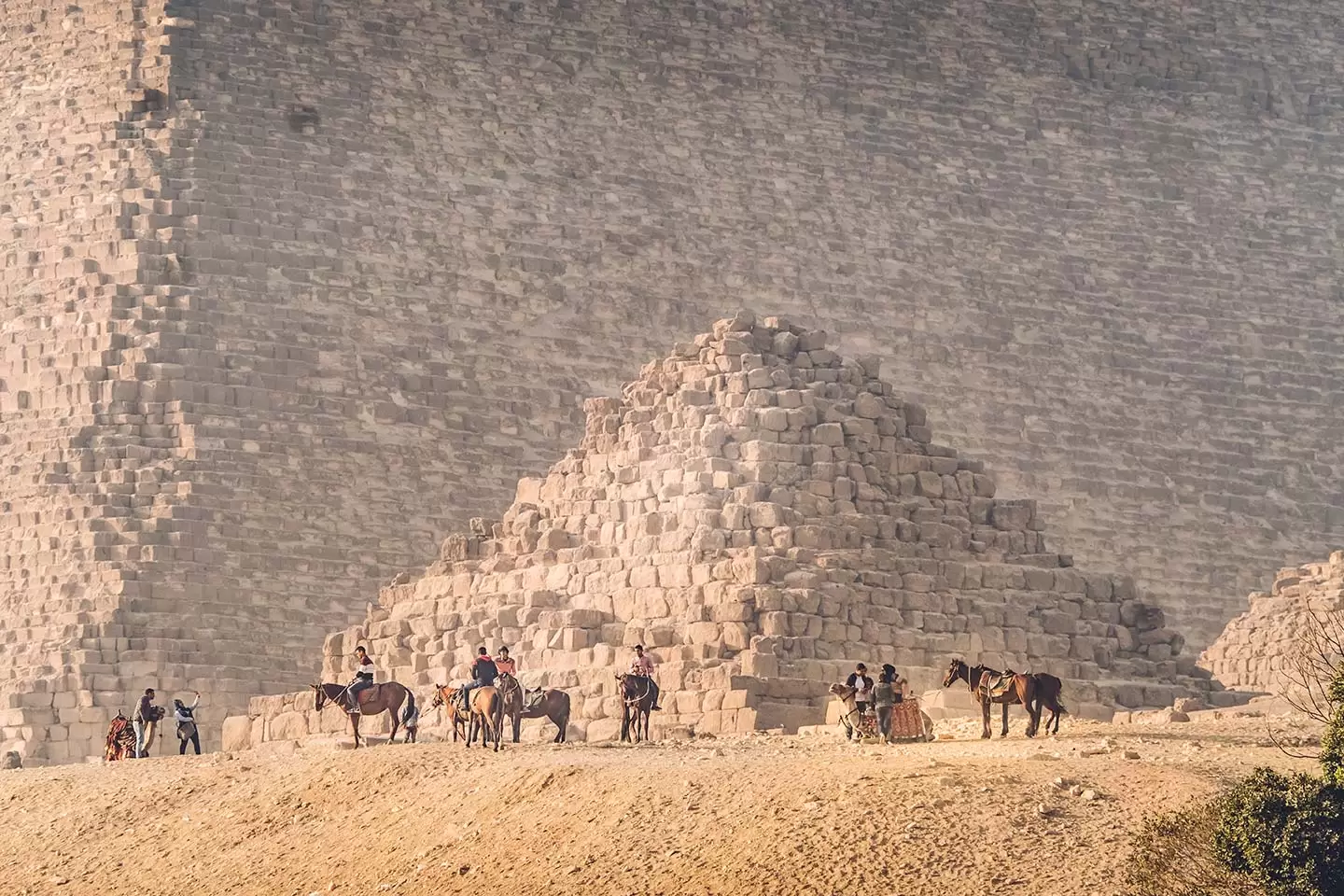
Camel and horse rides at the Pyramids of Giza
Going on a camel ride and taking a photo with the pyramids behind you is one of the most desired tourist souvenirs from a trip to Egypt.
If you know that going on a camel ride around the pyramids is something you definitely want to do, you may (and I hope), reconsider once you arrive and see how malnourished and badly treated the camels, and horses for that matter, are.
Egypt is a third-world country and many citizens are living in a state of desperation. As such, the men who run these camel rides prioritise feeding their families over feeding their camels. While they may have their priorities right, I can’t bring myself to support them. This has only become worse since tourism has declined.
If you do choose to take a camel ride, make sure you’re not hassled into paying more than the fair price. In order to crack down on scamming tourist signs have now been put up showing set prices for camel rides which are 50 Egyptian Pounds for 30 minutes.
Make sure you check out my guide on everything you need to know about visiting the Pyramids.
20. Toilets
Public toilets in Egypt are not the best, and that’s putting it lightly.
A trip to the loo will set you back 1 or 2 EGP and give you access to either a squat or western toilet. They generally don’t have toilet paper, are dirty, and the tap water may not be running. Bring your own toilet paper ( these flushable wipes are great ), hand sanitizer, and wipe down the seat if you must sit or get one of these.
There will usually be a hose next to the toilet, but the water will only be turned on if you pay a baksheesh.
Toilets in restaurants and hotels are usually staffed by an attendant who will give you toilet paper and turn on the tap for you. Giving a baksheesh of 25 – 50 piastres is standard.
21. School Children
You might feel famous when travelling around Egypt. At least that’s how the students in large school groups will make you think,
On countless occasions, at the Egyptian Museum in Cairo, the Pyramids, and Karnak Temple, young kids would run up to us asking for selfies or yell out and wave as our group walked passed. They were so excited and interested in us.
When I asked Ramzy why, he said that we are sort of celebrities to them. They watch people like us on TV who have very different lives from their own so they get excited when they see us in their country.
It’s actually very sweet. However, if you say yes to one, they’ll all come running. It’s best to politely decline from the start.
22. Mosques and Religious Sites
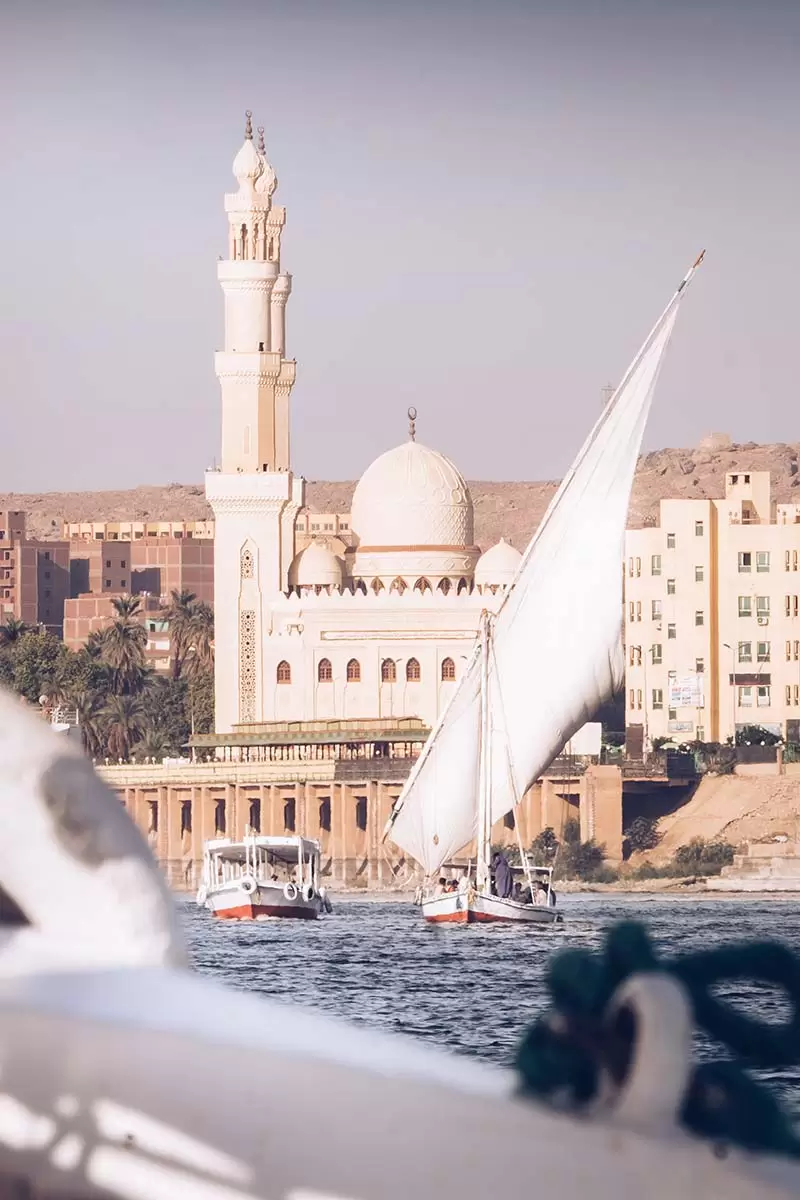
A beautiful Mosque on the Nile
Dressing modestly is a must when visiting mosques. Some places may ask women to cover their hair and will provide you with a headscarf. Before entering you will be required to remove your shoes and leave them with a shoe custodian (give him a baksheesh).
If you want to climb the minaret (tower), carry your shoes with the soles pressed together. It’s best to avoid visiting mosques during prayer times as to not intrude on worshippers.
23. Smoking
Everywhere you go, everyone will be smoking. Whether it’s a cigarette or shisha water-pipe, if you’re a non-smoker it can get really annoying.
Smokers are allowed to light up pretty much anywhere. The only exception is in fast-food restaurants thanks to an initiative by the environment ministry.
Restaurants have non-smoking tables, but these are almost pointless since they are surrounded by smoking tables. If you’re outside, try and stay upwind and always ask for a non-smoking room in your hotel.
24. Fridays and Saturdays
As in most Arab countries, their weekend falls on a Friday and Saturday. This means tourist attractions are much more busy on these days than the rest of the week.
I strongly recommend not visiting the Pyramids, Cairo Tower or the Egyptian Museum in Cairo on either of these days. The queues will be torture.
25. BONUS TIP: Fake Papyrus Scam
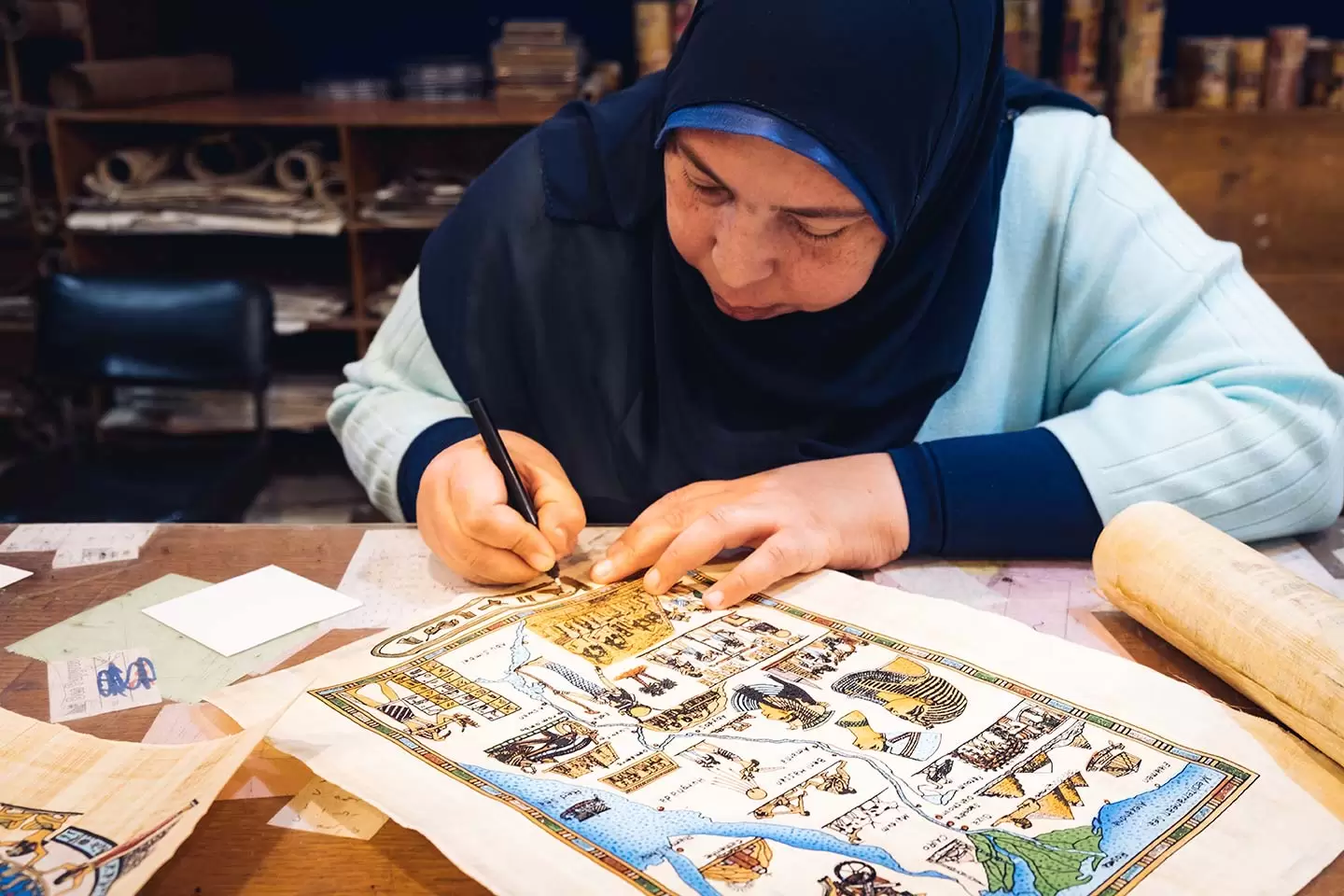
Lady writing my name in hieroglyphics on real papyrus
The Ancient Egyptians were one of the first to master the production of paper, known as papyrus. One of the nicest souvenirs you can get after a trip to Egypt is a papyrus print. But, there is a very common scam take catches out many tourists. Fake papyrus!
In many markets and other street vendors will sell fake papyrus that is actually made from banana leaf, not the papyrus plant. These will be cheaper than the real thing.
So, how do you spot a fake papyrus? Easy! First, notice how these vendors show or display their “papyrus”, it’s stiff, like cardboard and will tear when rolled which is why they’ll never roll it. Real papyrus is strong, flexible and durable and can be rolled up. Second, hold the papyrus up to the light, you should be able to see vertical and horizontal strips that make up the papyrus sheet, within these strips you should see little dark fibres or flecks. This is a good sign!
I hope this guide has helped you feel more prepared for your trip to Egypt. Remember, every country has its quirks. If things were the same as home, you wouldn’t be visiting.
I would go back to Egypt in a heartbeat. Everything I saw blew me away. It’s such an incredible country with a wonderful history. The locals are welcoming and it’s very cheap to travel to.
If you still have any questions or concerns, please reach out and leave a comment below. I’d be happy to help where I can. If not, then I wish you a wonderful trip! Support this blog and book your Egypt tour here.
Shukran for reading! 😉
Take a day trip from Cairo
- Alexandria Day Tour: See the city built by Alexander the Great
- Private Full-Day Tour of Historical Alexandria from Cairo
- Pyramids of Giza, Sakkara & Memphis: Private Tour with Lunch
- Pyramids, Museum & Bazaar Private Tour with Entrance & Lunch
- Cairo: Dinner Cruise on the Nile River with Entertainment
- Cairo: Egyptian Museum 4-Hour Private Tour with Transfer
- Cairo: 1 or 2-Hour Felucca Ride on the Nile with Transfers
- Old Cairo and Khan El Khalili Bazaar: Private Half-Day Tour
- Cairo: Best Kept Secrets Night Tour
- Plus loads more here …
Let me remind you again why Egypt is amazing and watch my Egypt vlog below.
Going to Egypt? Get my free Arabic travel phrase guide.
Like it? Pin it for later
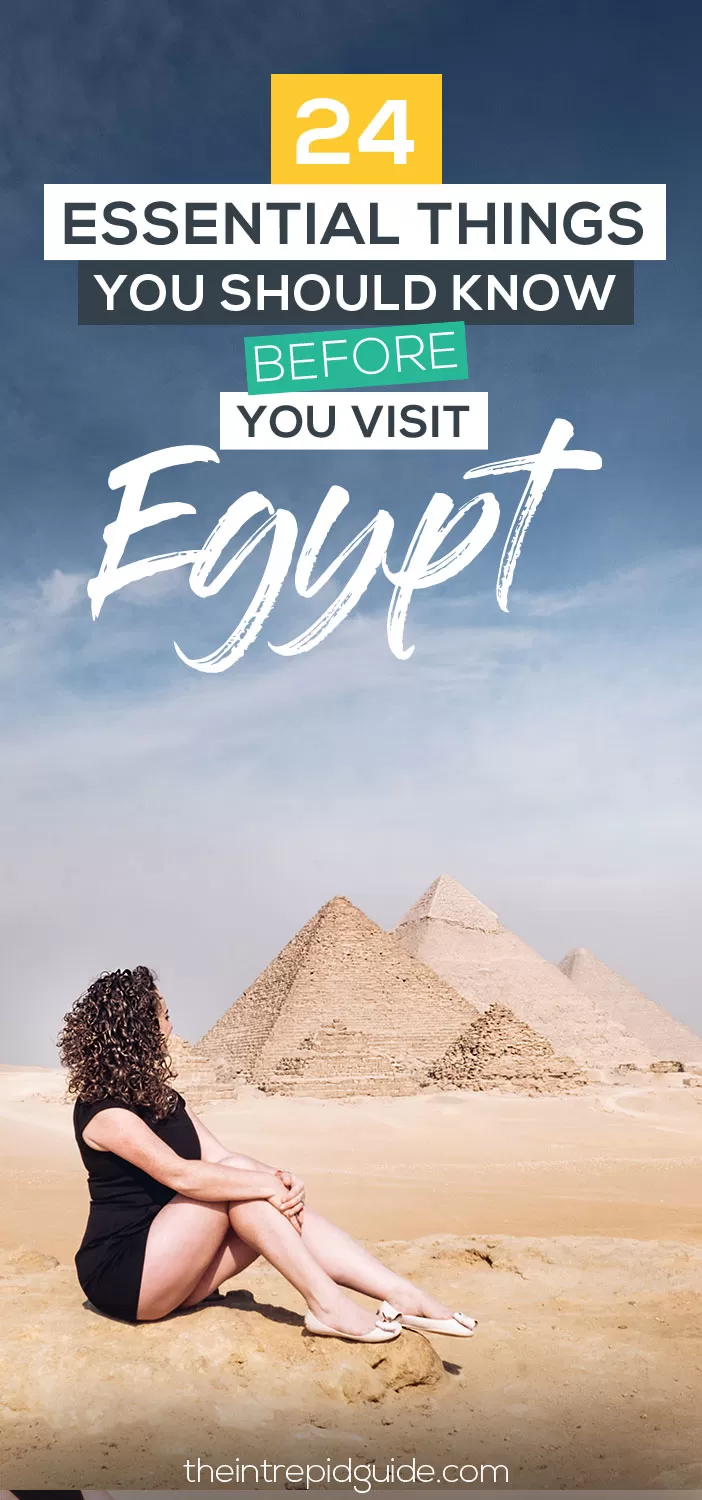
Sources Eyewitness Egypt
Over to you!
Which of these tips did you find the most useful? Is there anything you would add? Tell me below! Let me know using the comments section below or join me on social media to start a conversation.
Thanks for reading and I hope you enjoyed this post.
Like what you see? Subscribe using the form below to have all of my posts delivered directly to your email.
Success! Now check your email to confirm your subscription.
There was an error submitting your subscription. Please try again.
Get my best language and travel tips FREE by email...
Subscribe to my newsletter to receive detailed travel guides, exclusive travel and language learning tips, priority access to giveaways and more!
I will never give away, trade or sell your email address. You can unsubscribe at any time.
Michele creates language learning guides and courses for travel. What separates her from other instructors is her ability to explain complex grammar in a no-nonsense, straightforward manner using her unique 80/20 method. Get her free guide 9 reasons you’re not fluent…YET & how to fix it! Planning a trip? Learn the local language with her 80/20 method for less than the cost of eating at a tourist trap restaurant Start learning today!
Italian Tenses: How to Use ALL 15 Verb Tenses in Italian (+ Verb Tenses Chart PDF 📚)
26 best things to do in verona, italy + where to stay, 17 comments.
Thank you so much for all the information.
Looking forward for a trip to Egypt !!
My pleasure! Have a wonderful trip 🙂
Hi Michele, a lovely and useful article to read! Just wanted to check with you about passport safety: was it with you at all times, or you left it in your hotel room? Also – when entering Egypt have you been questioned about what, if any medication you had with you – as some over the counter meds in Europe or US can be problematic to bring into Egypt? Thank you!
Hi Jo, thank you so much and thank you for your questions. Yes, I always carried my passport on me. In fact, I do this wherever I travel. I would also ensure you have a photocopy in your luggage and a copy saved on your phone or on the cloud as an extra safety measure. When it comes to medication, I would email the airport directly for any questions you have. I was worried when flying from London to NY after I had heard that you can’t take a certain quantity of protein powder in your luggage. I emailed US customs and they said it was ok. I also kept a copy of that email on me and on my phone and was ready to show the customs officers on arrival if I had any issues. This is good practice as the problem with customs is that it’s sometimes open to interpretation and depends on how the officers feel on the day. I hope this helps 🙂 Have a wonderful trip!
Where do you recommend converting US $$ to LE and what volume of notes should I get to handle all the tipping. If at airport, is this best done before the border/customs or after? Thanks!
Hi David, before arriving, I ordered some USD so I would have enough to pay for my visa on arrival and have some money for incidentals. I had heard that they accept both USD and Egyptian Pounds at the airport. The tour company I travelled with had a guide on the ground who helped me through this process and I knew I need 100USD to pay for the visa. The rest of the time I used Egyptian Pounds. There is no tipping culture like the USA, so you can tip if you like but it’s not always necessary.
Hi David, before arriving, I ordered some USD so I would have enough to pay for my visa on arrival and have some money for incidentals. I had heard that they accept both USD and Egyptian Pounds at the airport. The tour company I travelled with had a guide on the ground who helped me through this process and I knew I need 100USD to pay for the visa. The rest of the time I used Egyptian Pounds. There is no tipping culture like the USA, so you can tip if you like but it’s not always necessary.
Hi, I have read and re-read this several times. Thank you. I’m going with a friend to Egypt early March and want to go on organised trips but I’m disabled and can only walk very slowly. In other countries I’ve just let the group go ahead and done my own thing then joined back at the coach. Is this a good idea in Egypt or can I hire an electric mobility scooter while there.
Hi Gabrielle, I’m not 100% sure how this works and it will vary depending on the accessibility of the group tour company. I would reach out to them directly for advice before booking. Best of luck and I hope it works out 🙂
Hello, thank you for your honesty. I enjoyed reading all of your tips. I am considering going in February from the 19th to the 24th. Do you think this is enough time to see everything you saw?
Hi Caroline, I went on a Top Deck tour, this is the best way to ensure you that we see everything and safely too. I highly recommend it. You can see the tour I did here http://bit.ly/EgyptExpressTour
Great info! Where did you take your photos??? THEY. ARE. FABULOUS.
Thank you SO much, Naomi. I took them during my Top Deck tour around Egypt . I highly recommend it! 🙂
This has been helpful and has eased my mind about travelling to Egypt. Going in a tour group, can’t wait ! 😀
I’m so happy to hear that. You’re very welcome, Jacinda 🙂
Thank you so much for such a wonderful article, I can’t wait to land egypt.
Thank you so much, Priya 🙂
Leave a Comment Cancel Reply
Save my name, email, and website in this browser for the next time I comment.
This site uses Akismet to reduce spam. Learn how your comment data is processed .

If you don't know where you are , how do you know where you're going? Find out how well you know Italian grammar today!
14 things to know to help you plan the perfect trip to Egypt

Aug 18, 2023 • 9 min read
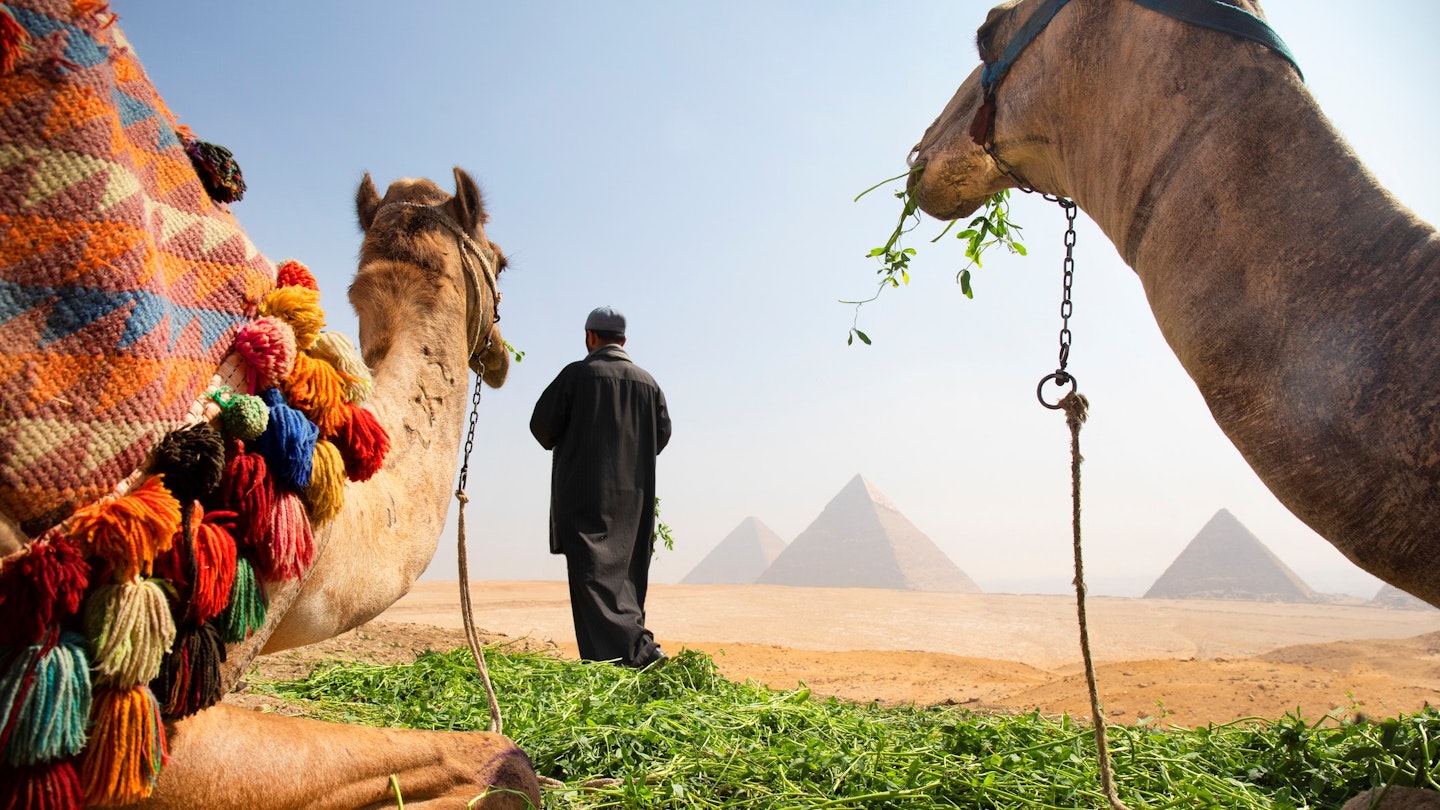
Plan the perfect trip to Egypt with these essential tips on etiquette, health and safety © Grant Faint / Getty Images
Egypt’s rich history reverberates through its modern-day culture. There’s plenty to do that will engage all your senses, from majestic ancient sights to lively streets rife with aromatic foods, and the vibrant and eclectic nightlife.
To fully indulge in all the excitement, there are some things you should consider, including the country’s cultural traditions. But worry not: this guide to planning and packing along with tips on health, safety and etiquette will have you ready for the a fantastic experience in Egypt.
1. Consider getting your visa in advance
Bags in one hand and paperwork in the other is all many travelers need to get on a plane and fly to Egypt. If you’re eligible , you can get a renewable single-entry tourist visa on arrival for USD$25, valid for 30 days. However, if you’re missing any documents or if there’s a problem processing your visa on arrival, you may be denied entry.
If you prefer a multiple-entry visa or want to avoid lines at the airport, you can apply for an e-Visa through the official government portal before travel to avoid any entry issues or delays.

2. Prepare a rough itinerary
There’s so much more to Egypt than the pyramids, and planning ahead will help you avoid a logistical nightmare. Plan your days by area (especially in major cities where traffic is both intense and unpredictable) so it’s easier to move around between locations.
If you’re a beach lover , there are plenty of destinations on the North Coast or Naama Bay for diving or snorkeling trips. If you’re an avid explorer and prefer something off the beaten track , Egypt’s lesser-known gems – like the stunning Siwa Oasis – are absolutely worth the adventure.
Egypt truly caters to every kind of traveler, and the best way to create a personalized experience is to focus on what’s important to you and plan accordingly.
3. Learn some basic Arabic phrases
Whipping out Google Translate for quick questions about directions can be helpful, but organic responses to basic niceties will prove useful.
Most Egyptians are eager to help when asked, but you might need to tie up a few odds and ends in Arabic with unilingual locals. They also come in handy if you need to fend off hustlers or persistent merchants. Learning a few words and phrases like “ al salam alaykom ” (hello), “ shukran ” (thank you), “ aywa ” (yes), “ la’a ” (no), and “ ma’ al-salama ” (goodbye) will go a long way.
4. Don’t underestimate Egypt’s weather – both hot and cold
Sunscreen is key if you don’t want to spend the better half of your vacation huddled up with ice packs. This is especially true if you’re visiting during the summer, but holds up throughout the year.
July is the hottest month, with temperatures ranging anywhere from 34.7°C (94.5°F) to a scorching 43.3°C (109.9°F). Yet, despite its year-round sunny skies, Egypt’s overall desert climate makes winters especially cold – the kind of cold that creeps beneath your clothes and gives you chills right down to your bones.
It doesn’t help that the poorly insulated buildings barely keep the freezing weather at bay, so you have to talk yourself into going outside because it’s warmer outdoors than it is indoors. Temperatures drop as low as 10°C (50°F) at times, so if you’re visiting between October and March , make sure to pack some warm clothes along with your sunscreen.
5. Pack for the heat, but keep it conservative
Egypt is known for its cotton, and what better place to wear cotton than here. Pack airy breathable clothes, and break out all the pastels and bright colors in your closet. Most people in major cities dress casually and embrace comfort over fashion. But remember that Egypt is a country with primarily conservative locals.
You can’t go wrong with loose clothing, and exposing too much skin is generally frowned upon. Men can sport tank tops if they’re comfortable with a few extra stares, but short shorts are not advisable, and women should avoid low-cut tops, short shorts/skirts or revealing dresses.
Beach destinations bend these unspoken rules, however, and locals are accommodating to visitors, so if you're heading for the beach, you don't need to leave all your shorts and sundresses behind.

6. Keep transportation in mind when booking accommodation
While booking your lodgings, look into modes of transportation in the surrounding area. If you’re planning a short time in your destination, opt for lodgings central to the sights on your itinerary or close to a metro station so you don’t waste too much time stuck in traffic. If you’ve got more time, you can opt for something a little less central, but remember that you could spend a chunk of your time traveling.
Cairo and Giza are mostly accessible using the metro system, and if you’re a female traveler we recommend you seek out the carriages reserved for women.
Some destinations will require further planning, and white taxis and Uber rides are your best bet. If you opt for a white taxi, always make sure the meter’s running before you hop in, and hail it a few meters away from your hotel for a cheaper ride. Avoid taxis that don’t use meters and aren’t very tourist-friendly. Long-distance buses and domestic flights are an option too, depending on your budget.
7. Be mindful of your etiquette at religious and historic sites
It’s important to not just dress appropriately but to also be mindful of local etiquette especially at certain sights.
Visiting a mosque? Take off your shoes before entering and, if you’re female, cover your head.
At a historic site? Don’t touch the antiquities and always use cameras without the flash.
On the beach? Yes you can sport your best swimsuit and relax, but like every place in the world, there’s always a code of conduct. Be observant and if in doubt, do what the locals do.
Local tip: Photography is encouraged at tourist sites, but don’t photograph people without their consent, and don't take photos where it is explicitly prohibited.
8. Avoid public displays of affection
We’ve established that Egypt leans toward conservative, and this extends to public displays of affection. While holding hands with your partner won’t garner much attention, limit your public physical interactions to what would be considered mild and proper.
Platonic kisses on the cheek are a common greeting between friends in Egypt but, depending on your surroundings, should be limited to members of the same sex.
9. Bring small bills and be prepared to tip
Tipping in Egypt is still standard practice, especially in the service industry. Tips, or baksheesh , can range from 5 EGP (<$0.50) to 100 EGP ($5.50), depending on who you are paying and where.
Egypt is largely cash-oriented, so pick up both large and small bills when you’re exchanging currency to make payments and tipping easier.
Restaurants and cafes are easier to figure out, with 10-15% of the bill being customary, and loose change is the norm for food purchases from street vendors. Higher tips are usually reserved for people who provide you with long-term services, such as drivers and tour guides. While you’re not required to tip delivery services, taxis, and ride-hailing apps, you can round up the bill if you’ve had a satisfying experience.

10. Haggling for souvenirs is part of the experience
From papyrus papers and traditional souvenirs to carefully crafted silverware and hand-painted ceramics, markets in Egypt are a treasure trove. But if you feel like something is overpriced, don’t shy away from haggling.
While vendors aren’t particularly fond of the back-and-forth, it’s all part of the experience and no matter what you pay in the end you can convince yourself it was a great deal.
Don’t attempt to haggle in bigger shops in or outside tourist attractions, and if there’s an official price posted on the product, it’s usually non-negotiable.
Pro tip: Keep your eyes and ears open and gauge the price range of similar items in nearby stores so you can tell if you’re being overcharged. Haggling is mainly confined to souvenir spots, souks (markets) and less formal selling areas.
11. Don't drink the tap water and beware of food carts
To dodge any stomach bugs that might ruin your Egyptian adventure, avoid drinking tap water unless it’s filtered, especially if you have a sensitive stomach. Pack a good water-filtering system or do like the locals and use bottled water.
While Egyptian cuisine is one of the country’s best assets, and the temptation to sample it every chance you get is understandable, some carts improperly store their food. It can be difficult to tell as a visitor, so it may be wise to opt for local shops instead. They often offer similar food but are generally safer to indulge to your heart’s content.
12. Flood season is June to September
Flooding is an issue in Egypt in June to September, but it’s usually mild and mostly limited to some coastal areas. It’s always a good idea to activate news alerts on your phone anyway and keep an eye on the local news.
The floods are usually easy to manage, but roads can be impacted, especially in some areas in South Sinai.
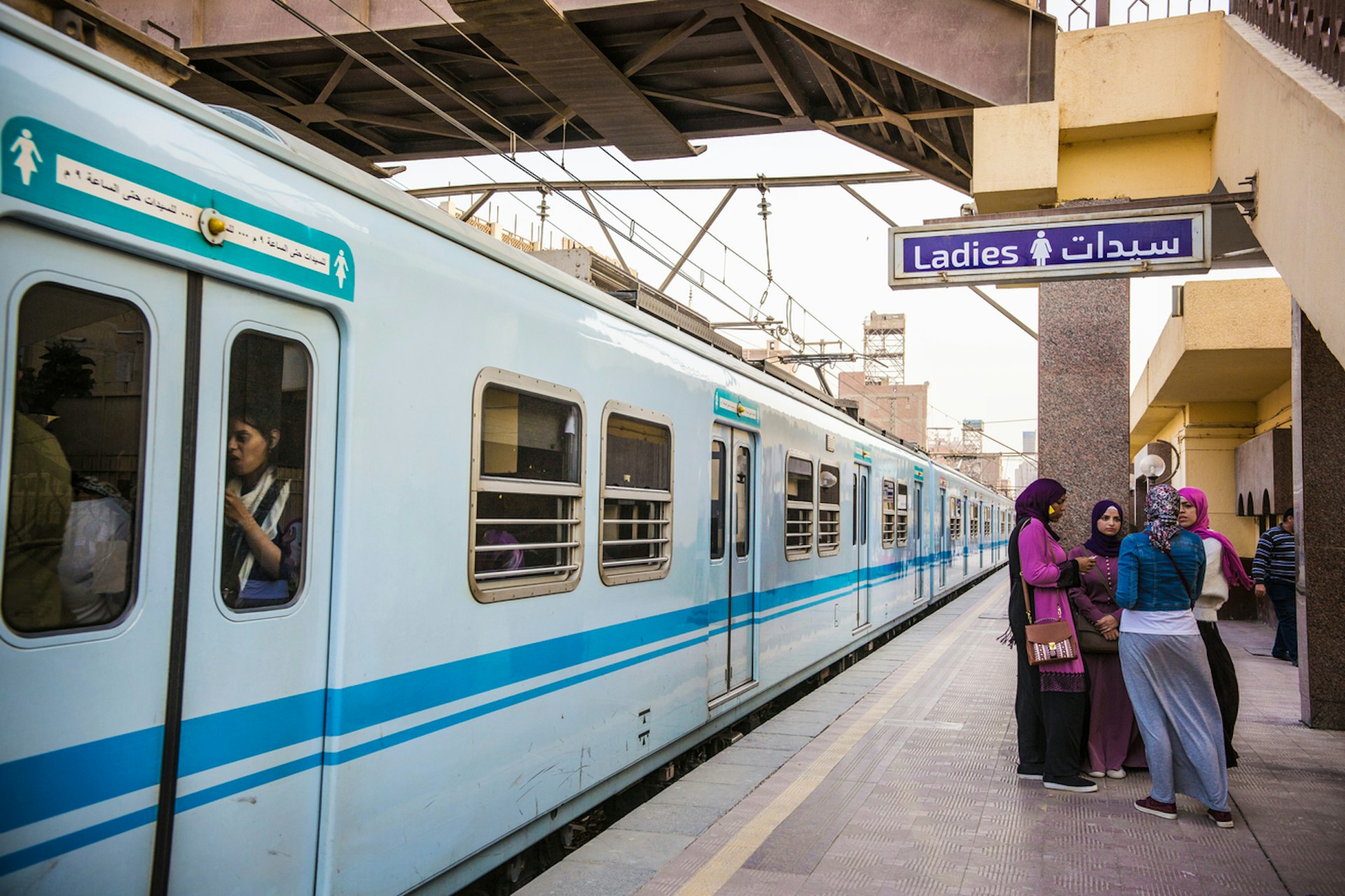
13. Solo female travelers may receive unwanted attention
If you’re a woman traveling on your own , keep an eye out for harassers, scammers and hustlers who may be pushy and persistent. Confident interactions are often key to driving them away, but calling out for assistance or announcing you’ll involve the police can be a good deterrent as well.
As a rule of thumb, try to avoid interactions with individuals in suspicious settings, like quiet alleyways, dark street corners, and empty spots, and look for crowds with women and children if you feel unsafe. Never get into a taxi or Uber with anyone but the driver. Ride in the carriages reserved for women on the metro in Cairo. And, as is sadly the case in most of the world, avoid walking alone late at night.
14. Tourist police can assist you in an emergency
Egypt is generally considered safe to visit, but if you face any issues that you believe require law enforcement interference, look for police officers with a tourism police badge on their shoulders – it’s a navy blue half sleeve with a gold eagle in the middle, and “Tourism and Antiquities Police” written at the bottom. They are stationed at every tourist destination in Egypt and can also be reached by dialing 126 from any Egyptian mobile number.
If you’d rather file a complaint later, you can dial 19654 and communicate directly with the Egyptian Ministry of Tourism and Antiquities. It's also a good idea to keep the number of your home embassy or consulate handy.
Pro tip: Invest in an Egyptian SIM card upon arrival. They’re cheap and will make local interactions much easier for you. Vodafone, Etisalat, Orange and WE are Egypt’s top mobile service providers; you can find their booths in the final hall on your way out of Cairo International Airport.
This article was first published Jul 23, 2022 and updated Aug 18, 2023.
Explore related stories
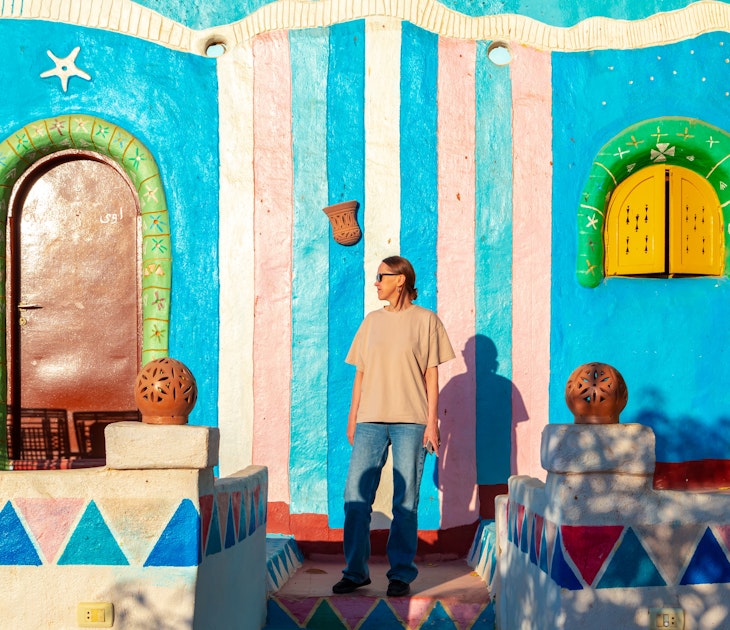
Destination Practicalities
Mar 12, 2024 • 4 min read
With tombs, pyramids and towering temples, Egypt brings out the explorer in all of us. This handy month-by-month guide shows the best time to visit Egypt.
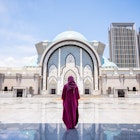
Mar 4, 2024 • 4 min read
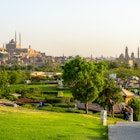
Jan 18, 2024 • 4 min read
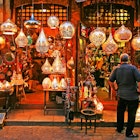
Jan 11, 2024 • 7 min read

Jan 11, 2024 • 4 min read
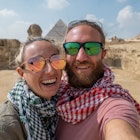
Dec 8, 2023 • 7 min read
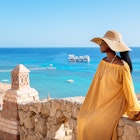
Aug 17, 2023 • 5 min read
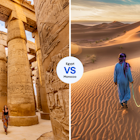
Aug 10, 2023 • 7 min read

Dec 20, 2022 • 3 min read
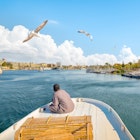
Oct 26, 2022 • 9 min read
National Geographic content straight to your inbox—sign up for our popular newsletters here

A practical guide to travel in Egypt, from tipping culture to independent touring
From packing tips to advice on haggling, here’s everything you need to know while planning your trip.
Whether you want to sail down the Nile on a felucca, explore ancient temples, browse the museums of Cairo or go trekking in Sinai, there are a few things to bear in mind when planning your trip to Egypt. Here’s what to be aware of when it comes to visas, tipping, guides and more.
Do I need a visa?
Almost all travellers, including visitors from the UK and the EU, need a visa to travel to Egypt. While it’s possible to get a visa on arrival, it saves time at the airport if you apply online in advance. A single-entry tourist visa costs US$25 (£20). If you plan to stay in the resort towns in Sinai for fewer than 15 days, you do not need a visa. Instead, you receive a ‘permission stamp’ in your passport when you land at Sharm el-Sheikh International Airport. While this option is a money saver, the list of places you’re permitted to visit is quite limited — even Ras Mohamed National Park at the southern tip of Sinai is off limits without the full visa.
What should I pack?
Egypt is a majority Muslim country, so it’s respectful for travellers to dress modestly. For all genders, this means covering everything between your shoulders and knees. You will likely be asked to cover up more if you visit a mosque or church.
The tap water is not safe to drink here so bring a water bottle with a filter, such as those from Lifestraw .
Wi-fi ranges from infuriatingly slow to nonexistent across the country, even at five-star hotels. Get mobile data through your service provider at home or buy an Egyptian SIM card when you land at the airport.
Can I pay by card in Egypt?
Cash reigns supreme but you can use a card at some higher-end hotels and restaurants. Take some Egyptian pounds out of a cash machine when you arrive, but be mindful of the fluctuating exchange rate and don’t take more out than you need. For bigger expenses, consider bringing US dollars, the most — and sometimes only — accepted foreign currency.
Tipping, called baksheesh, infiltrates almost every interaction you’ll have. It’s customary to tip nearly everyone you come in contact with, even for services you don’t want or require. Keep small change on hand for toilet attendants, porters, mosque caretakers and guards at temples and tombs.
Should I join a tour or travel independently?
Egypt has been a package-tour destination since the days of Thomas Cook, who first led a group to Egypt in 1869. The country is well set up for tour groups, and many first-time visitors find this option easiest, with guides and transport logistics arranged for you. Egypt’s historic sites have little signage, making a tour guide a necessity for deeper understanding.
Nile cruises generally run between Luxor and Aswan in both directions, but a few make the long journey from Cairo. Trains, planes and buses connect cities along the Nile, and buses or internal flights can take you to the Red Sea coast.
For Hungry Minds
Related topics.
- ANCIENT HISTORY
- ANCIENT EGYPT
- CITY GUIDES
You May Also Like

How to plan the ultimate adventure in Egypt, from Cairo to the Red Sea

A guide to island-hopping in the Seychelles

10 whimsical ways to experience Scotland

The essential guide to visiting Scotland

The essential guide to visiting San Diego
- Environment
History & Culture
- History & Culture
- History Magazine
- Gory Details
- Mind, Body, Wonder
- Paid Content
- Terms of Use
- Privacy Policy
- Your US State Privacy Rights
- Children's Online Privacy Policy
- Interest-Based Ads
- About Nielsen Measurement
- Do Not Sell or Share My Personal Information
- Nat Geo Home
- Attend a Live Event
- Book a Trip
- Inspire Your Kids
- Shop Nat Geo
- Visit the D.C. Museum
- Learn About Our Impact
- Support Our Mission
- Advertise With Us
- Customer Service
- Renew Subscription
- Manage Your Subscription
- Work at Nat Geo
- Sign Up for Our Newsletters
- Contribute to Protect the Planet
Copyright © 1996-2015 National Geographic Society Copyright © 2015-2024 National Geographic Partners, LLC. All rights reserved

34 Best Travel Tips For Egypt: Things to Know Before You Go

Grey Globetrotters Travel Blog contains affiliate links. As an Amazon Associate, I earn from qualifying purchases. See my disclaimer for more information.

Egypt has something for every traveller, from awe-inspiring ancient sites to vibrant markets. However, navigating this historically rich and culturally diverse country can be daunting for even the most seasoned globetrotter.
That’s why I’m sharing my best travel tips for Egypt, drawn from months of exploring this fascinating (and sometimes frustrating) country.
Whether you’re interested in exploring the iconic Pyramids of Giza, delving into Egyptian history in the Valley of the Kings, learning about the ancient Egyptians in Luxor, or relaxing on a Nile River cruise, these tips will help you make the most of your Egyptian adventure.
After visiting Egypt for nearly 30 years, the 34 helpful travel tips for Egypt travel in this article are the ones I wish I’d known before I visited Egypt for the first time.
You’ll find everything in this Egypt travel guide, from Egypt travel safety tips to what not to do in Egypt, packing tips for Egypt, and everything you need to know when travelling to Egypt, including what to do about tips in Egypt and how to deal with harassment.
Ready to get started? Let’s dive straight into these essential Egypt travel tips!
Practical Travel Tips For Egypt
Let’s get started with the absolute basics 🙂
1. Never (Ever) Drink The Water In Egypt!

Of all the travel tips for Egypt, this is the top one – and you need to be very clear about it. Tap water in Egypt is unsafe for human consumption everywhere – on swanky cruise ships, in posh hotels or anywhere else.
No one drinks it, and it will likely make you as sick as a dog if you do – even if you only use it to brush your teeth in your hotel room.
Of course, you could rely on buying bottled water while visiting Egypt. But, I must tell you that the quality (and taste) of the bottled water brands available in Egypt is variable – while some are palatable, some are pretty horrid. And then there’s the environmental cost of plastic bottles!
Because of this, you’ll want to include a Water-To-Go Filterable Water Bottle on your packing list for Egypt (see below).

💦 FILTERABLE WATER BOTTLE
The Water-To-Go Bottle will keep you hydrated and filter out the nasties that often make people sick in Egypt.
The built-in, three-stage filter in Water-To-Go Bottles filters out 99.99999% of water-borne contaminants, including bacteria, parasites, toxins, chemicals, microplastics and heavy metals. It’s your best defence against getting sick in Egypt from the water. I carried mine everywhere 🙂
🤮 Need tips on what to do if you do get sick while visiting Egypt? Head to How to Deal With Delhi Belly
2. Get Travel Insurance for Egypt

Egypt is a fantastic country to visit, but it’s not a great place to be if something doesn’t go according to plan or you get sick! I don’t mean to scare you — just to make you think about these crucial things .
One of the most important travel tips for Egypt is to protect yourself from potential pitfalls on your vacation with travel insurance .
Just as you insure your car, home and health, you can also insure your luggage, belongings and health while travelling – and you absolutely should do this when travelling to Egypt!
🏆 Best Egypt Travel Insurance
What is the best travel insurance for Egypt? I only ever recommend Travel Insurance Master because they have outstanding customer service.
3. Check Your Passport

To visit Egypt, your passport must be valid for at least six months from when you arrive in Egypt. If you need to renew your passport before your trip, be sure to apply for a new passport in good time.
4. Pre-Book Your Tours in Egypt
UK Government travel tips for Egypt warn of a risk that “tourists at high-profile sites like the Giza Pyramids may be confronted aggressively for money or business, even while travelling by car or taxi.”
They also say that “visitors using a pre-booked guide or taking an organised tour to visit the Giza Pyramids are likely to face fewer difficulties.”
➡️ The best places to book your Nile cruise or tour of the great pyramids are Viator and GetYourGuide . Each tour carries a user rating, so it’s easy to see which ones other visitors have enjoyed the most – and you can read all the reviews before making your booking.
5. Sort Out Your Egyptian Visa Before You Travel
You need a visa to enter Egypt if you’re a citizen of the United States, Canada, the United Kingdom, and many more countries.
How to get your visa for Egypt
- Apply before you travel using the official Visa2Egypt e-visa system . Your Egypt visa will be valid for a maximum of 3 months and will cost US$25 for a single entry to the country as a tourist.
- If you love standing in a queue after a long flight, you can get a visa on arrival in Egypt from one of the approved bank kiosks in the airport arrivals hall just before immigration. These visas cost US$25 (payable in US dollars) and are valid for 30 days.
⛔️ Do not buy a visa from an agent at the airport!! They will sting you with an additional fee of more than US$25 for your visa. YOU DO NOT NEED TO PAY THIS. If you feel harassed, it’s easy to report any agent’s behaviour to the tourist police officers at the airport.
Travel to Egypt requirements for visitors to South Sinai resorts
👀 If you’re visiting the Red Sea resorts of Dahab , Nuweiba , Sharm el Sheikh , or Taba for up to 15 days, you receive a free entry permission stamp when you arrive. However, you will need a visa if you plan to stay longer than 15 days or travel out of these areas .
👀 If you change your plans mid-trip and want to travel beyond one of the South Sinai resorts, you can usually buy a visa at Sharm el Sheikh airport , allowing you to travel beyond the Sinai Peninsula.
⚠️Leaving Egypt with an out-of-date visa is problematic, to say the least, and you’ll likely have to pay a fine if your visa is more than 14 days out of date.
➡️ Contact the Egyptian Consulate in your home country for further information and enquiries.
Safe Travel Tips For Egypt
6. pre-book your transport from cairo international airport.
One of the most important things to book before you arrive in Egypt is your airport transfer from Cairo Airport .
It’s the best way to avoid the masses of scammy taxi drivers badgering you for the chance to drive you to your hotel and the safest way to travel as a female traveller.
7. Stay Safe Online & Protect Your Data With a VPN

Whenever you use an open network to access your information on the web, you’re sending out an invitation for others to steal your data – from any device you use to connect to the web. This includes passwords, debit card and credit card info, and many other things you need to keep private.
This is why you need a VPN!
👀 What is a VPN?
A VPN (Virtual Private Network) is essential in preventing cyber criminals from stealing your online and personal information. NordVPN is a trusted name in VPNs.
👀 How does a VPN work?
With a VPN, you create a secure (private) connection when you use a shared connection, for example, when you use a coffee shop WiFi. Without a VPN, you’re digitally connected to everyone else on the same shared network! And that’s risky!
⚠️ As you’ll likely need to use free, shared WiFi more when you’re travelling than at home, the risk of your information being accessed by criminals is higher – unless you use a trusted VPN .
I recommend purchasing NordVPN , one of the biggest and most-used VPNs, to keep your data safe while travelling.
▶︎ Get started now and protect your data with NordVPN – it’s easy to set up 🙂
8. Take Care On Microbuses
Egypt generally has a low crime rate; however, some visitors have been victims of crime – especially petty crimes. Be cautious if travelling alone to reduce the risk of unwanted attention or harassment.
✔️ Don’t be the last passenger left on a bus or microbus.
✔️ Be vigilant when travelling alone in taxis and microbuses, particularly at night.
✔️ Report any crimes to the tourist police immediately .
9. Don’t Swim in the Nile!

“ Can you swim in the Nile ?” is one of the questions I’m most often asked about visiting Egypt! The simple answer is a resounding NO! The Nile River is contaminated with industrial, animal and human (!) waste. It’s also home to more than a few deadly snakes.
Read More: How Safe is Swimming in the Nile River?
10. Wear a Hat/Headscarf and Sunglasses

Most Egyptian women cover their hair, so you’ll attract less attention if you wear a long, lightweight scarf that covers your hair and neck. I forgot to pack a scarf on my first visit to Egypt, but I found it easy and cheap to buy one from a local market.
😎 Top Tip: Sunglasses will help to disguise the colour of your eyes (not many Egyptians have blue or green eyes), and, like a mask, they can help you avoid eye contact.
11. Wear a Wedding Ring

Whether you’re married or not, wearing a simple gold band (or an inexpensive “ fake wedding ring “) is a simple, inexpensive deterrent against unwanted male attention. I wore one on every trip to Egypt!
12. Respect Local Customs and Laws
I managed to get arrested in Siwa Oasis for swimming at the wrong time of day! It was a pretty scary time.

Fortunately, it was sorted out very quickly. Still, it was frightening at the time, and it made me realise how important it is to be aware of local customs and laws to stay safe .
Egyptians can’t share a room with someone of a different gender (other than a spouse), as sex outside marriage is illegal! Don’t be surprised if your host(s) conduct room checks in rural areas!
13. Look After Your Valuables
Leave valuable jewellery at home and be careful with your camera, phone and other valuables. I use an ancient Kipling cross-body bag and an anti-theft Pacsafe backpack with a zip closure and a clip to keep my valuables safe.
Top Tip: In crowded places, I wear my backpack on my front and my cross-body bag with the strap across my body. I also have an RFID travel belt to stash my cards, cash, passports, and important documents.
14. Be Careful with Your Cash
One way to keep your cash safe while travelling is to hide it in an RFID bra wallet ! Remember you’ll need somewhere discreet, like a public loo or changing room, to extract your secret stash.
❌ Never put valuables in your pockets, even ones with a zip! It’s much too tempting (and easy) for pickpockets and thieves. You don’t want to attract that sort of attention!
15. Security Before and On Your Trip
Security has been a problem for tourists in Egypt; however, there is a robust and visible police presence. You’ll also see special “tourist police” hired to protect tourists. Bag checks and scans at tourist sites and hotels are also there to keep you safe, although these can be a bit haphazard.
Egypt is still a volatile country, with some areas unsafe to visit. Other sites are safe, and almost 320,000 British tourists visited the country in 2017, mostly without any problems.
Check the latest travel advic e for Egypt here and purchase comprehensive travel and medical insurance before you travel . I always use Travel Insurance Master because their rates are competitive; you can extend coverage if you travel longer, and making claims online is easy.
Egypt Travel Fit Tips
16. check whether your medications are legal in egypt.

Egypt’s rules about prescribed and over-the-counter medicines differ from those of many other countries.
Some widely used medications are considered controlled substances in Egypt and you can’t take them to Egypt without permission from Egypt’s Ministry of Health. You risk prosecution under Egyptian law if you arrive in Egypt without the necessary documentation.
⚠️ Travelling with prescription medications? Get an official letter from your physician confirming that the medicine is for a medical condition.
This should include details of your condition and how much medication you will be carrying. The letter should also state that the medicine is for personal use only.
➡️ Contact the Egyptian Embassy in your home country for more information and to find out which medicines are not permitted in Egypt.
17. Pack Plenty of Bug Spray
The mosquitoes in Egypt mean business and will soon make your life miserable if you’re not prepared for them!
I’ve always used Jungle Formula spray combined with this plug-in mosquito killer for my room. And if those nasty, itchy bites do happen, this inexpensive cream has been my go-to relief for decades!
18. Stock Up On Sun Protection Cream
Egypt is a hot country, where temperatures often soar well above 40 ° C (104 ° F) in the summer months. In addition to covering up and making sure to stay out of the sun, you’ll want lashings of high-SPF sun cream.
Cultural Travel Tips For Egypt
19. pack culturally appropriate clothes.

With my pale Northern European skin, blue eyes, and light coloured hair, I was a magnet for unwanted attention in Egypt.
From the irritating (constant offers of taxi rides, to change money or to buy things, and never-ending catcalls) to the offensive (blatant staring and leering, creepy handshakes, touching, and “accidental” brushing up against your breasts or bottom), there are lots of things to watch out for.
RELATED POST: Travel Packing List for Egypt
I remember looking at handmade rugs in a crowded souk, only to realise that the man behind me was rubbing his erection against my bum! Many people saw what he was doing, but no one did anything…
⚠️ You need to rethink your wardrobe for Egypt to avoid being harassed. Dressing modestly is important if you’re going anywhere outside the main tourist areas.
✔️ Leave tight, revealing, or form-fitting clothes at home. Forget the strappy tank tops and shorts for anywhere outside of the main tourist resorts
✔️ Think conservative, loose, and floating, with everything covered up from your neck to below your knees.
✔️ Covering up shows respect for the local culture and will help you avoid attracting unwanted attention.
❌ Don’t flash any bare flesh or “show off” the shape of your body.
While I found the unwanted attention annoying, I never felt unsafe , and most of the local people I met were delightful, welcoming, and kind.
20. Learn a Few Words in Arabic
Learn a few essential words in Arabic as a courtesy and to summon help.
✔️ Google Translate usually helps ; however, I always feel safer when I have a few local words imprinted in my brain for emergencies.
21. Carry Small Bills For Tipping in the Local Currency
The custom of tipping or “baksheesh” is firmly embedded in Egyptian culture, and you should expect to tip a few Egyptian pounds in small change for most services.
While tipping is not mandatory in Egypt, it is customary as a way to thank an individual for great service. As a rough guide, here’s what to consider leaving when tipping in Egypt:
- Restaurants : leave a 10-15% tip
- Tour guides : Leave 10-15% of the tour price for the tour guide and 5-10% for the driver
- Hotels: Leave 10-15 Egyptian pounds per day for housekeeping staff, 5-10 Egyptian pounds per bag for porters and bellhops, and 10-15% of the bill for room service.
Practical Egypt Travel Tips
22. copy important documents before you travel.
Before any trip, make copies of all essential travel documents.
✔️ Save a scanned copy of the documents online to access them while travelling if necessary. Just in case! Leave copies with trusted contacts at home and take one copy in your carry-on bag.
✔️ If your hotel has a safe space, consider using it for important documents.
✔️ Save a scanned copy of the documents online to access them while travelling if necessary. Just in case!
23. Make a Contacts List
What would you do if your phone got lost or stolen? I’d be pretty lost! Making a copy of your key contacts is an excellent way to protect yourself if your phone does get broken or goes AWOL.
✔️ Save all your complete contact list online, including the contact details for your Embassy.
✔️ Carry a paper copy of your contacts list in your hand luggage.
Hopefully, you’ll never need it, but being prepared is good.
24. Watch Out If You’re Offered Egyptian Bananas
Watch out if anyone offers you “Egyptian bananas”. While bananas are grown in Egypt, they may not be talking about the fruit but being suggestive!
25. Bring Earplugs (Egypt is Noisy)
Egypt is a fantastically vibrant Muslim country, which means it can be loud! You’ll likely hear muezzins calling the faithful to prayer from the minarets of multiple mosques – five times a day, from early morning until late.
Then there are the street vendors touting their wares, the incessant blaring of horns and general traffic noise! You get the idea, but if (like me) you like a good night’s sleep, you’ll need good noise-cancelling earbuds to cope with the cacophony of Egypt!
🎧 These noise-cancelling earbuds have thousands of positive reviews on Amazon and work perfectly! If you don’t have wireless headphones, travelling is the best time to treat yourself and upgrade.
26. Always Carry Toilet Paper
It’s a massive understatement to say that public conveniences in Egypt are not up to Western standards.
Restrooms/loos in museums, on coaches and on trains range from the tolerable to the downright grim, so be sure to have TP and wipes with you whenever you leave your hotel!
27. Camel and/or Donkey Rides
Animal welfare is not the same in Egypt as it is in most Western countries . You simply cannot be sure that any animals you’re offered a ride on are well-treated . In a horrifying number of cases, they are not.
Better and more ethical ways exist to get out and explore this amazing country. This incredible tour includes a hot air balloon ride and a felucca sailing boat adventure , while you could also have a magical ATV adventure into the desert on this tour .
28. Snake Charming

I don’t love snakes (I’m scared of them), but there is nothing charming about this barbaric practice. And it’s almost entirely driven by tourist interest.
Some (not all) snake charmers make their living by capturing wild cobras, ripping out their venomous fangs and then sewing their mouths closed. The snakes suffer horribly for months before dying of starvation – only to be replaced by newly caught victims.
Please don’t support this animal cruelty on your trip to Egypt. There are much better things to post on Instagram.
29. Don’t Take a Minibus Tour to Abu Simbel

Seriously, this was one of my worst travel mistakes in Egypt! Lured in by a cheap ticket, I handed over my cash. I spent over four miserable hours (each way) travelling through the baking desert from Aswan to Abu Simbel in a bone-shaker minibus without air conditioning.
While the Temple of Abu Simbel is one of the best tourist landmarks in Egypt , I was too dehydrated when I arrived to really appreciate it!
Here are the three best ways to visit Abu Simbel:
- Fly to Abu Simbel and join this 3-night/4-day cruise from Lake Nasser to Aswan for a more comfortable and relaxing trip. [ Highly recommended ]
- Pick a private tour, including direct flights from Aswan to Abu Simbel and mercifully short transfers from the airport [ Likely to sell out ]
- Choose this highly-rated tour and make the road trip from Aswan to Abu Simbel in a private, air-conditioned car. [ Best budget option ]
30. Egypt Swelters in the Summer – Other Times Are More Pleasant
To help you plan your dream trip to Egypt, here’s a quick look at what the weather is like for each season:
Spring (March – May)
Spring in Egypt is a delightful time for exploration as temperatures are moderate and pleasant. With warm days that average around 25-30°C (77-86°F), you can comfortably discover attractions like the Pyramids of Giza, and Luxor’s temples or cruise along the Nile without enduring extreme heat. Additionally, blooming flowers add splashes of colour to various regions across Egypt.
Summer (June – August)
Egypt’s summer brings scorching temperatures that might be challenging for some visitors but there will be fewer crowds and lower prices. Daytime temperatures soar above 35°C (95°F) in most parts of the country; however, coastal cities like Alexandria or Hurghada provide respite with slightly milder conditions due to sea breezes.
If you choose to visit Egypt during the summer, you’ll need to stock up on sun protection essentials such as hats and sunscreen.
Autumn (September – November)
Autumn is an ideal time to explore Egypt’s wonders, with more comfortable temperatures returning after summer’s blistering heat subsides.
Average daytime temperatures range between 25-30°C (77-86°F), making it an excellent season for sightseeing at popular destinations like Cairo or Aswan without feeling overwhelmed by crowds.
Winter (December – February)
Winter in Egypt provides ample warmth for outdoor activities. Daytime temperatures hover around 15-20°C (59-68°F) in most regions, making exploring sites like the Valley of the Kings or Abu Simbel pleasant.
Evenings can be cooler, especially in desert areas and Upper Egypt, so you’ll want to pack a light jacket or sweater.
31. Expect to Pay To Take Photographs at Key Tourist Destinations
Whether you’re visiting the Egyptian Museum , the Pyramids of Giza or the vast temple of Abu Simbel, be prepared to pay a small fee for the right to photograph at or on the site.
Camel drivers and others will likely also demand a fee if you want to take their photograph.
Best Food in Egypt Tips
32. try the incredible street food.
Egyptian food is sublimely tasty. It’s well worth venturing out from your hotel to see what’s on offer from the local s treet stall street vendors and local restaurants. Kushari, baba ghanoush and hummus are all delicious!
In addition to the well-known sweet mint tea, why not sip some karkadeh (hibiscus juice)? It’s a very refreshing alternative!
33. Cover Up When Visiting Religious Sites
While some of Egypt’s ancient mosques allow tourist visits, it’s important to be respectful if you do visit.
When can I visit an Egyptian mosque?
Muslims pray five times a day, so it’s not appropriate to visit mosques during these times or to take photographs.
How should I dress to visit a mosque in Egypt?
All visitors should remove their shoes before entering, and women should cover their hair with a scarf. A long-sleeved shirt is useful to cover up shoulders and arms, and you should wear a modest skirt or trousers.
What about visiting a Coptic monastery in Egypt?
The rules for entering an Egyptian Coptic monastery are similar in that you should dress conservatively and remove your shoes before entering. In addition, it’s not appropriate to visit during the period of Lent .
34. Always Pay in Local Currency When Making Digital Payments
Whether you’re using debit or credit cards to make payments when visiting Egypt, it’s important to make sure you always choose the option to pay in the local currency , not in your home currency.
If you choose to pay in the local currency, eg in Egyptian pounds, you will likely be stung with a worse currency exchange rate than your bank would charge you,
TRAVEL TIPS & RESOURCES
Here’s a quick look at all my favourite travel resources – the ones I use to plan every trip. Find more information on my travel resources page .
🏠 Need a place to stay? Browse Booking or VRBO 💃 How about fun experiences? Get Your Guide and Viator have it all 🚗 Considering renting a car? Use Rentalcars 🚂 If you need transfers, bus or train tickets, check Omio 🔒 Don’t forget about travel insurance from Travel Insurance Master
- Your Ultimate Packing List for Travel to Egypt
- Visiting Siwa Oasis in the Western Desert – An Off-the-Beaten Path Adventure
- How to Avoid Holiday Tummy When Travelling
Final Thoughts on Travel Tips for Egypt
Whether this is your first trip to Egypt or you’ve been before, these are my best travel in Egypt tips: I hope they help you when you visit Egypt.
Egypt is a remarkable destination offering travellers rich historical and cultural experiences. By following these travel tips, you can ensure a smooth and enjoyable trip to this fascinating country.
From planning your itinerary to respecting local customs and traditions, being aware of safety precautions, and embracing Egypt’s unique sights and sounds, you can make the most of your journey.
So pack your bags, immerse yourself in the wonders of ancient Egypt, explore bustling markets and tranquil oases, indulge in delicious cuisine, and create memories that will last a lifetime. Happy travels!
Pin this post for later!

Related Posts
- Visiting Siwa Oasis in the Western Desert – An Off-the-Beaten Path Adventure
Coralie Thornton, the owner and author of Grey Globetrotters, has been a traveller for more than four decades. Today, she helps others experience the UK, Europe and bucketlist destinations with meticulously crafted guides and affordable luxury itineraries, Her passion for adventure has led her through over 40 countries, seeking cultural experiences, delicious foods, and hidden gems.
Similar Posts

Glamour on a Dime: A Guide to Luxury Travel on a Budget!
Grey Globetrotters Travel Blog contains affiliate links. As an Amazon Associate, I earn from qualifying purchases. See my disclaimer for more information. ARE YOU…

15 Things I Can’t Travel Without: Travel Expert Tips (2024)
One indisputable truth of getting older is realising that there are things I can’ttravel without.

33 Things You Need to Know When Planning a Trip to China
Grey Globetrotters Travel Blog contains affiliate links. As an Amazon Associate, I earn from qualifying purchases. See my disclaimer for more information. When the…

How to Overcome Jet Lag | 19 Trusted Hacks
Grey Globetrotters Travel Blog contains affiliate links. As an Amazon Associate, I earn from qualifying purchases. See my disclaimer for more information. Wondering how…

How to Get From Leeds Airport To Leeds City Centre: All Options
Grey Globetrotters Travel Blog contains affiliate links. As an Amazon Associate, I earn from qualifying purchases. See my disclaimer for more information. Leeds Bradford…

15 Ways to Get Flight Upgrades (+ 6 Things NEVER To Do)
Grey Globetrotters Travel Blog contains affiliate links. As an Amazon Associate, I earn from qualifying purchases. See my disclaimer for more information. Are you…
- Destinations
14 EGYPT TIPS for FIRST TIMERS (How to Save Time, Money, and Be Safe)
This site uses affiliate links, meaning that if you make a purchase through our links, we may earn an affiliate commission.
Traveling in Egypt can be challenging, even for the most seasoned nomad. There’s so much to know about Egypt and consider before planning a trip, however, with these 14 Egypt tips for first timers, you will make the most of your time, avoid possible challenges, and ensure you have a safe and enjoyable stay in Egypt.
Learn More About Egypt:
Perfect 2-Day Itinerary in Luxor, Egypt (7 Things You Can’t Miss)
5 Best Day Trips from Luxor (Maps+Photos+Practical Tips)
18 Best Things to Do in Luxor (Ultimate Luxor Bucket List)
7 Best Tombs to Visit in the Valley of the Kings
You Might Also Like:
12 Practical Tips for Hot Air Balloon Ride in Luxor
How to Visit Abu Simbel: Everything You Need to Know to Plan Your Visit
- 1. 14 Egypt Tips for First Timers
- 1.1. Is It Safe to Travel to Egypt
- 1.2. When Should You Go to Egypt
- 1.3. Will You Need a Visa to Travel to Egypt
- 1.4. Should You Hire a Tour Company
- 1.5. What Should You Wear in Egypt
- 1.6. Is It Safe to Drink Tap Water
- 1.7. What You Need to Know About Tipping in Egypt
- 1.8. Do You Need to Exchange Money When Traveling in Egypt
- 1.9. How to Get Around in Egypt
- 1.10. Can You Fly a Drone in Egypt
- 1.11. How to Bargain in Egypt
- 1.12. Should You Go on a Camel Ride
- 1.13. How to Use a Public Toilet in Egypt
- 1.14. What to See in Egypt for First-Time Visit
- 2. Intrepid Scout's Egypt Tips for First Timers
14 Egypt Tips for First Timers
Is it safe to travel to egypt.
Safety is the number one concern when deciding whether to travel to Egypt or not.
I understand it because, for many years, Egypt remained on my list of places to visit, however, it was not a safe place to travel to due to political instability and terrorism. It was not until 2019 that I started looking at the possibility of visiting Egypt and finally, I decided to travel to Egypt that year.
I have to honestly say that I felt safe during my entire trip to Egypt which started in Cairo and went all the way down the Nile to Abu Simbel near the Sudan border.
During my visit to Egypt in 2019/2020, I saw police and military at all major tourist attractions. While traveling to the Temples of Abu Simbel, we had to stop at several security checkpoints. And, every time I entered my hotel or visited a popular tourist site, I had to go through metal detectors. All these measures were in place to protect tourists and make them feel safe.
Tourism in Egypt used to be one of the leading sources of income, crucial to Egypt’s economy.
- At its peak in 2010 , the sector employed about 12% of the workforce of Egypt, serving approximately 14.7 million visitors to Egypt, and providing revenues of nearly $12.5 billion.
- Between 2015-2016 that revenue dropped to $3.3 billion due to political unrest and terrorism.
- In 2017 , Bloomberg said Egypt has “shed its years of social and political unrest” and made the top 20 list of 2017 travel destinations.
- Egypt was on the path of recovery until the Covid epidemic. In 2020 , Egypt’s tourism revenue dropped by about 70% to $4 billion, reducing tourist arrivals to 3.5 million from 13.1 million in 2019. Egypt’s revenues from tourism for the months of the 2020-2021 fiscal year plunged by 67.4%.
When Should You Go to Egypt
- The best time to visit Egypt is spring or fall . About mid-March until mid-May and mid-September until mid-November are the best times to travel to Egypt. In these transition months, temperatures are mild and the weather is pleasant. Spring and fall are the most perfect times of the year to visit Egypt.
- Summers (July, and August) are unbearably hot. Temperatures can range from 104F to 130F. By all means, avoid traveling to Egypt in the summer months.
- Winter months can be cool (especially at night, down to 50F), but temperatures during the day should be nice and perfect for exploring Egypt. December and January are the most popular months for travel to Egypt, so expect crowds at all popular destinations in Egypt.
Will You Need a Visa to Travel to Egypt
Most foreign visitors who want to visit Egypt need a visa as well as a valid passport.
- The best and simplest way to obtain a visa is to apply for an e-Visa . Currently around 150 countries can apply for an electronic visa for Egypt through a quick online application. Once approved, the e-Visa will be electronically linked to the passport and a copy will also be sent via email . You will need to print it and present it to immigration control upon your arrival in Egypt. An Egypt tourist e-Visa allows a total stay of 30 days per entry.
- You can also obtain a visa on arrival at any immigration checkpoint. In the Cairo International Airport, right before the passport control, there is a bank window where you can purchase a visa on arrival. It costs USD 25 and you need to pay in cash. Next, take your visa and passport to passport control where the immigration officer will add the visa to your passport and stamp it.
Should You Hire a Tour Company
I recommend hiring a reputable travel company that can assist you with navigating from one attraction to the next while you are visiting Egypt. I want to caution you against self-driving in Egypt due to heavy and unpredictable traffic as well as poor road conditions.
I am not recommending using public transportation either. You will find bus systems in larger cities like Cairo and Alexandria. However, buses are not the easiest mode of transport for visitors in Egypt. First of all, the bus numbers are displayed in Arabic. Second, they are overcrowded and uncomfortable.
In my opinion, taxis are the most efficient way to get around in Egypt.
I collaborated with Your Egypt Tours to help me put together an itinerary for Egypt. They supplied drivers and guides, as well as booked a cruise on River Nile for me. On the other hand, I researched and booked all the hotels and flights. Honestly, I recommend them and have to say that they have done a great job! Just to clarify, I am not getting paid for recommending them.
What Should You Wear in Egypt
Egypt is a conservative Muslim country . However, Egypt is used to foreign visitors and there are no set rules as far as the dress code. But, my recommendation is to be modest and respectful of Egypt’s religion and culture.
With that being the case, I would suggest wearing short or long sleeve shirts and loose or baggy-fitting pants during the cooler times of the year.
During the summer months, when temperatures soar above 100F, it is just fine to wear longer shorts and short sleeve shirts. I have seen many female travelers wear loose-fitting dresses and capris as well.
Simply put, be comfortable and yet be modest !
You will see the majority of Egyptian women wearing headscarves, and many women keep themselves completely covered. It is not required that you comply with these rules at all unless you are visiting a mosque – in that case, you do need to respect the fact that you are entering a religious building and it is advisable that you cover up. I usually carry a scarf wherever I travel and I have it handy.
As a female traveler to Egypt, I stay away from sleeveless or strapless tops and dresses, and shorts out of the respect for Egyptian culture and religion.
If you are planning on going on the River Nile cruise or visiting any of the resorts while in Egypt, you will find a very different and relaxed atmosphere with tourists wearing western summer attires – sleeveless tops, shorts, bathing suits, short dresses, etc.
Is It Safe to Drink Tap Water
It is not fun to get sick while you are traveling and I got very sick several times while traveling to different destinations around the world. So, I tend to stay super cautious when it comes to drinking tap water, consuming uncooked foods, or consuming food in general. While food and water might be safe for locals whose systems are used to them but can create quite gastrointestinal havoc for visitors.
The bottom line, it is not safe to drink tap water, brush your teeth with tap water in Egypt, or eat uncooked foods that might have been rinsed with tap water. Tap water in Egypt can contain harmful organisms such as viruses and bacteria that could make you sick if you ingested them.
Buy bottled water in Egypt and check that the seal is not broken. Drink bottled water, brush and rinse your teeth with bottled water, and above all stay away from any uncooked foods like salads, raw vegetables, unpeeled fruit, and meat that isn’t thoroughly cooked.
If you do get an upset stomach, take diarrhea relief tablets and drink plenty of purified water .
Supposedly, it is safe to use tap water in Cairo since it is heavily chlorinated, but, I was told, it tastes awful and requires some getting used to it. I would not recommend it either since a lot of chlorine in the water might upset your digestive system.
What You Need to Know About Tipping in Egypt
Tipping is a tradition in Egypt and while traveling in Egypt be prepared to tip a lot. By tipping, you are showing your gratitude for the services that were provided to you.
How much should you tip? It is recommended that you tip at least 5-10% of the total cost of the service.
I tipped in US Dollars and before traveling to Egypt, I prepared envelopes with tips for drivers, guides, porters, the River Nile Cruise staff, and the list goes on and on.
Following are some guidelines that you can follow:
- Restaurant – it is usual to leave between 5 and 10% of the tip amount, in addition to the service charges.
- Hotel – normally, $1-$3 usually left with the doorman and other employees
- Hotel Bags – between 10 and 20 Egyptian pounds.
- Tour Guide and Driver – a standard tip for the tour guide is $30-$50 per person for the trip and for the driver $10-$20.
- Toilet Attendants – 5 Egyptian pounds is appropriate
- Guardians at archaeological sites – 10 Egyptian pounds are suitable for a particular extra service. The tip is only to be given if you have formulated your agreement and accepted or requested this service, for example: taking your picture.
Also, just want you to be aware that if someone offers to take your picture, they are not doing it for free. They will want to be paid. So, be prepared to tip them for their service. If you see a photogenically positioned camel in front of the pyramids, be aware that if you snap a picture of the camel, then you will have to pay the owner of that camel.
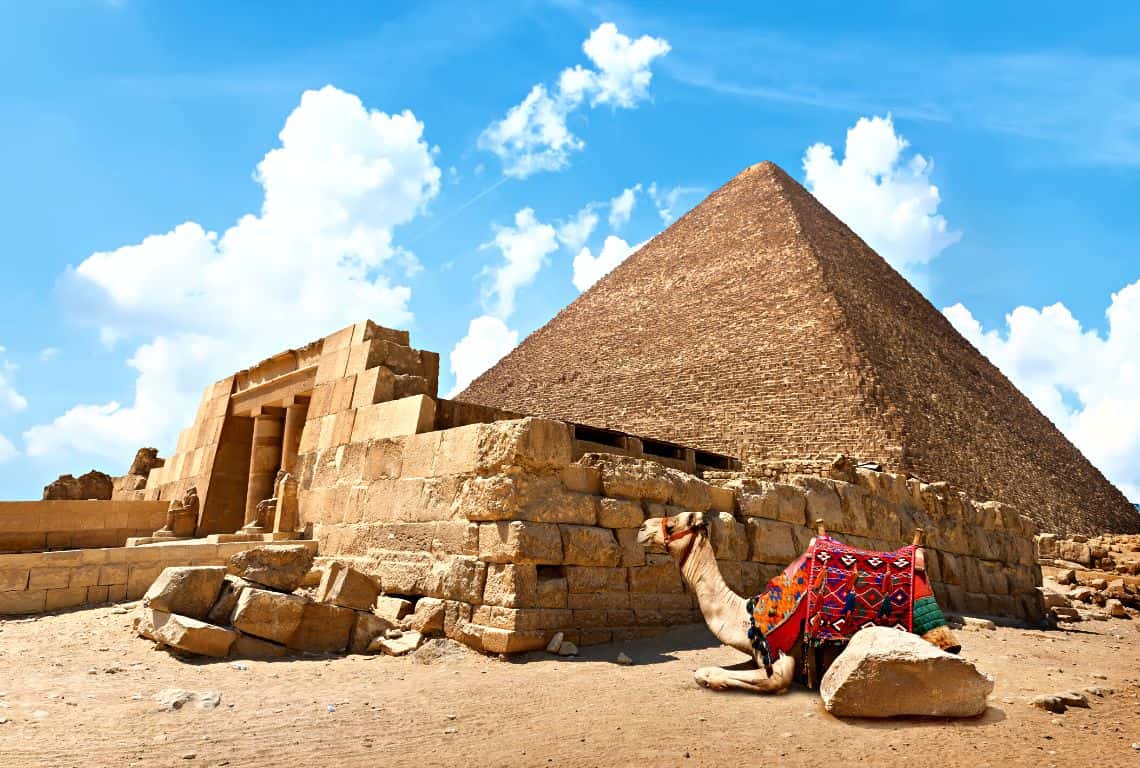
What You Need to Know About Tipping in Egypt / Egypt Tips for First Timers
Egypt Tips for First Timers
Do You Need to Exchange Money When Traveling in Egypt
You do not need to exchange a lot of money while traveling in Egypt. Exchange just enough money to cover some of the tips and have some on hand.
Other than that, US Dollars are widely accepted and a preferred method of payment and tipping. Also, credit cards are accepted almost everywhere.
If you need to exchange money, then there are plenty of ATM’s pretty much every place that tourists visit.
How to Get Around in Egypt
- My recommendation is to collaborate with a reputable tour company . They can provide drivers and tour guides and you can book flights and hotels. Or, they can do it all. Honestly, having drivers and tour guides scheduled for each day of your trip is the most efficient way to get around in Egypt.
- Another option is to j oin a bus tour that stops at all major attractions in each location you plan to explore. It is probably one of the least expensive options. It does not give you much flexibility and you are stuck with a large group of visitors.
- Another pretty efficient option is to just book a taxi and head to all the major attractions You will always be able to hire a guide right at the entrance.
- I do not recommend renting a car in Egypt . The roads are in poor condition, the traffic is incredible (Cairo or Luxor), and traffic rules do not exist. On the roads outside the cities, there are security checkpoints, and you need to be able to communicate with the officers.
Can You Fly a Drone in Egypt
To bring a drone to Egypt and fly it, you need to receive permission from the country’s Civil Aviation Authority (CAA).
If you do not have documentation of authorization, your drone will be confiscated at customs.
However, it’s difficult to get permission to fly a drone from the CAA.
How to Bargain in Egypt
Bargaining or haggling is an integral part of the Egyptian shopping experience and should be considered more like a fun game, rather than a serious battle.
Here are a few tips:
- First of all, ask the seller for the price of an item you are interested in.
- Most sellers will start their offer at some exorbitant price. My suggestion is to counteroffer with one-third of the asking price.
- The seller will appear to be appalled by your offer and will ridicule it. Stay calm and just keep smiling. Remember, it is all a game and you should have fun.
- If the seller is not willing to lower the price, then pretend you are no longer interested in the item and walk away.
- I can assure you that you will be followed and offered a lower price.
- Don’t feel guilty about getting the item at a lower price. It is a process and the seller is still making a profit.
Make Sure to Read:
How to Visit Khan el-Khalili Bazaar in Cairo
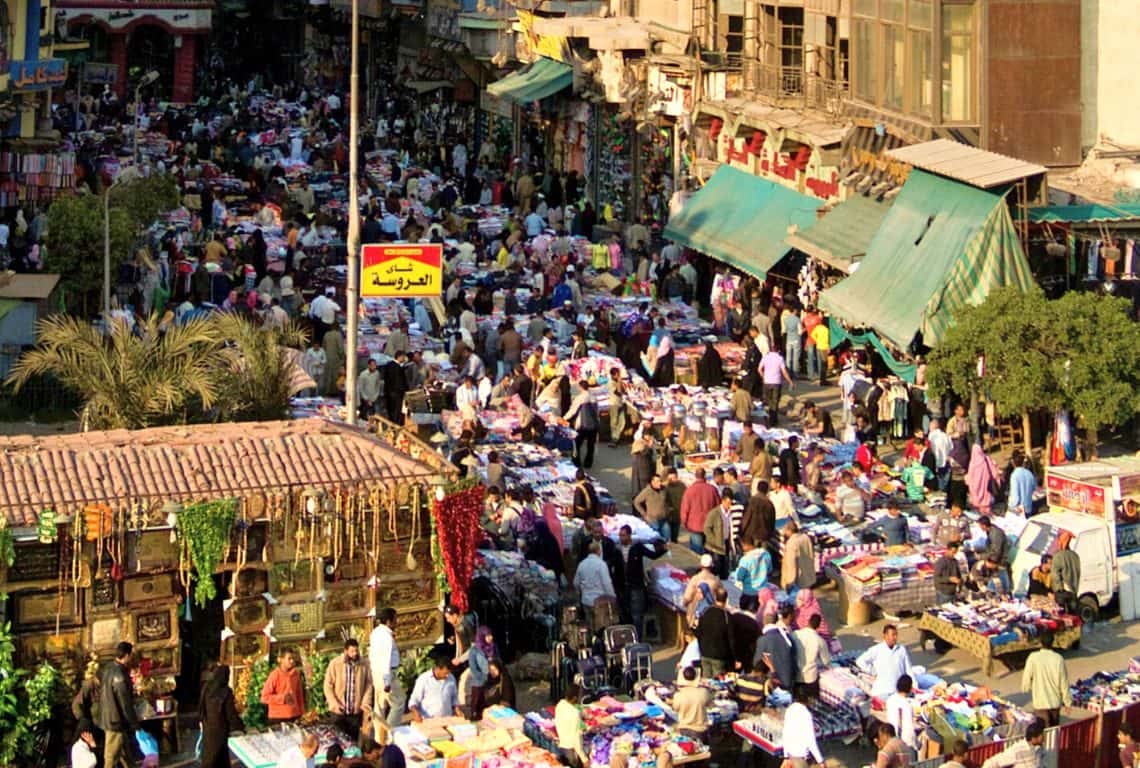
Busy Market in Cairo / Egypt Tips for First Timers
Should You Go on a Camel Ride
Should you go on a camel ride at the Pyramids of Giza ? My answer is yes! YES!
Going on a camel ride and taking a photo with the pyramids behind you is one of the most touristy things to do in Egypt, however, it is a tradition that everyone coming to Egypt needs to do.
How much does it cost to go on a camel ride at the Pyramids of Giza? For a 30-minute camel ride, the average price is 300 EGP, which is about $20 USD.
However, this price can vary a lot. You will need to negotiate the price, time, distance, etc with the camel owner. Then, the camel handler will take you to several good photo locations and take your pictures. You will need to tip the camel handler at the end of the ride as well.
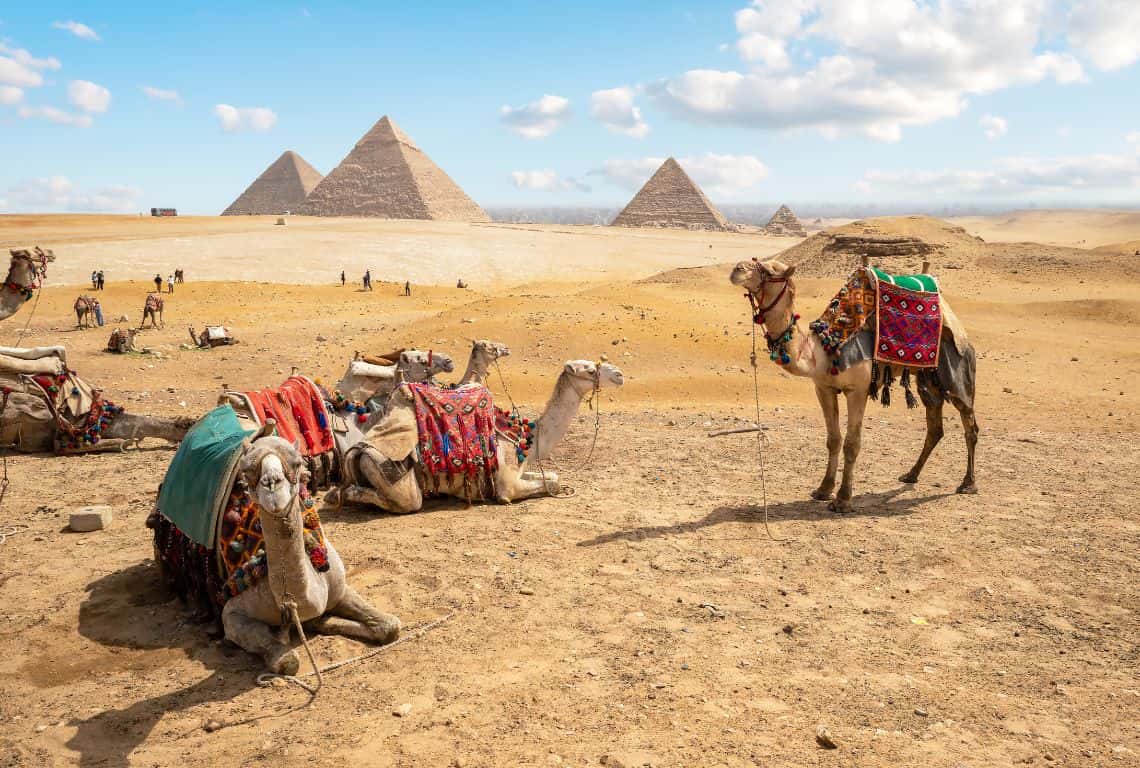
Pyramids of Giza / Egypt Tips for First Timers
How to Use a Public Toilet in Egypt
Public toilets in Egypt are not maintained to the best standard. Here are a few suggestions about how to use public toilets in Egypt:
- Public toilets in Egypt are usually staffed by a toilet attendant . So, make sure to leave a tip for the attendant before leaving the restroom. They might hand you a piece of toilet paper and turn on the facet, but it is not a rule.
- Bring your own toilet paper.
- The water faucet might not be working. There might not be any soap. Make sure to bring hand sanitizer with you.
- Be prepared that the restroom might have only ‘squat’ toilets. However, I have seen both “squat” and “sit down” toilets.
What to See in Egypt for First-Time Visit
From the incomparable pyramids, majestic sands of the Sahara, breathtaking Temples of Abu Simbel, and the beauty of the River Nile, the list of places to visit in Egypt goes on and on.
While you are working on your Egypt itinerary, make sure not to miss these must-see places:
- Pyramids of Giza
I am sure you heard of the Seven Wonders of the Ancient World . The Great Pyramid of Giza is the only Wonder of the Ancient World that is still in existence.
Built during the Old Kingdom (c. 2686-2181 BC), specifically, during the reign of the Fourth Dynasty kings, more than 4,000 years ago , the Great Pyramids of Giza give us a glimpse into Egypt’s past.
For me, the Great Pyramids of Giza are the most magnificent structures and the most iconic sight in the world. Both, the Great Pyramids of Giza and the Great Sphinx of Giza have been on my list of places to explore for the longest time.
Learn More About Pyramids of Giza:
What to See at the Pyramids of Giza (10 Things You Can’t-Miss)
How to Visit the Pyramids of Giza (Things to Know Before You Visit)
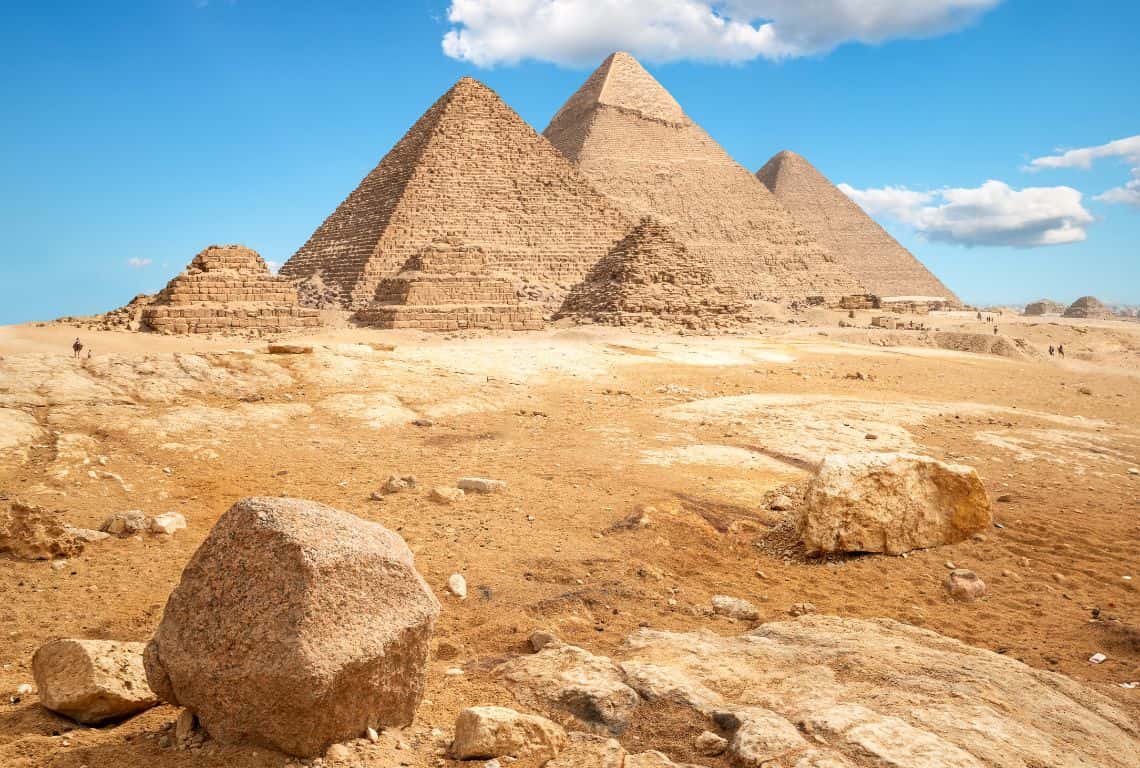
- Valley of the Kings in Luxor
For a period of nearly 500 years, from the 16th to the 11th century BC, known as the New Kingdom of Ancient Egypt, the Valley of the Kings was the burial ground for pharaohs such as Tutankhamun, Seti I, and Ramses II, as well as queens, high priests, and other elites of the 18th, 19th, and 20th dynasties.
There are some 65 magnificent royal tombs, that have been discovered so far.
Nowadays, their contents are gone. However, you can still see the amazing wall and ceiling decorations with religious images and texts from the netherworld books, designed to guide the pharaohs in their journey to the afterlife.
Learn More About Valley of the Kings
7 Best Tombs to Visit in the Valley of the Kings (Map+Photos+Useful Tips)
12 Practical Tips for First Visit to Valley of the Kings
- The Temples of Abu Simbel
One of the must-see sights when visiting Egypt is the Abu Simbel Temple Complex . However, some advance planning is advisable to enjoy this incredible place to its fullest. Here is everything you need to know about how to visit Abu Simbel:
Learn More About Abu Simbel:
How to Visit Abu Simbel: Everything You Need to Know to Plan Your Visit
Inside the Great Temple of Abu Simbel / Egypt Tips for First Timers
- Karnak and Luxor Temples in Luxor
Karnak is a massive Ancient Egyptian temple complex. At the heart of it lies the Temple of Amun, dedicated to the king of the gods. In addition, there are a number of smaller temples, chapels, and sanctuaries dedicated to other deities. Moreover, there are endless halls, a sacred lake, pylons, colossi, and obelisks.
Luxor Temple is one of the most beautiful temples located on the East Bank of the River Nile in Luxor.
Luxor and Karnak Temples need to be on your bucket list of places to visit.
Learn More Karnak and Luxor Temples in Luxor:
How to Visit Karnak Temple (9 Things You Can’t Miss)
What to See at Luxor Temple (11 Things You Can’t Miss)
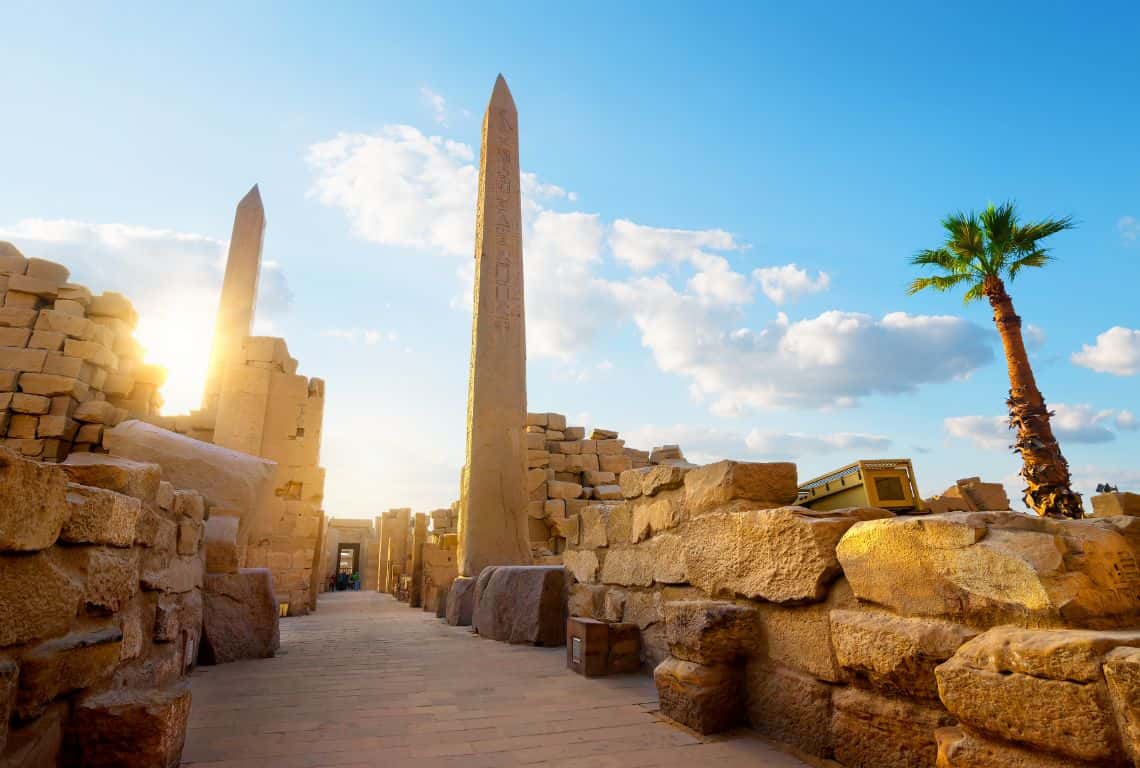
Karnak Temple / Egypt Tips for First Timers
- Temple of Hatshepsut in Luxor
The Temple of Hatshepsut, also known as Djeser-Djeseru (Holy of Holies), is one of the most stunning temples located on the West Bank of the River Nile in Luxor. Constructed by Pharaoh Hatshepsut and dedicated to herself and god Amun, the temple is built into a cliff face and consists of a series of spectacular terraces that can be reached by long ramps.
Learn More About Temple of Hatshepsut:
What to See at the Temple of Hatshepsut (7 Things You Can’t Miss)
14 Tips for Visiting Temple of Hatshepsut in Luxor
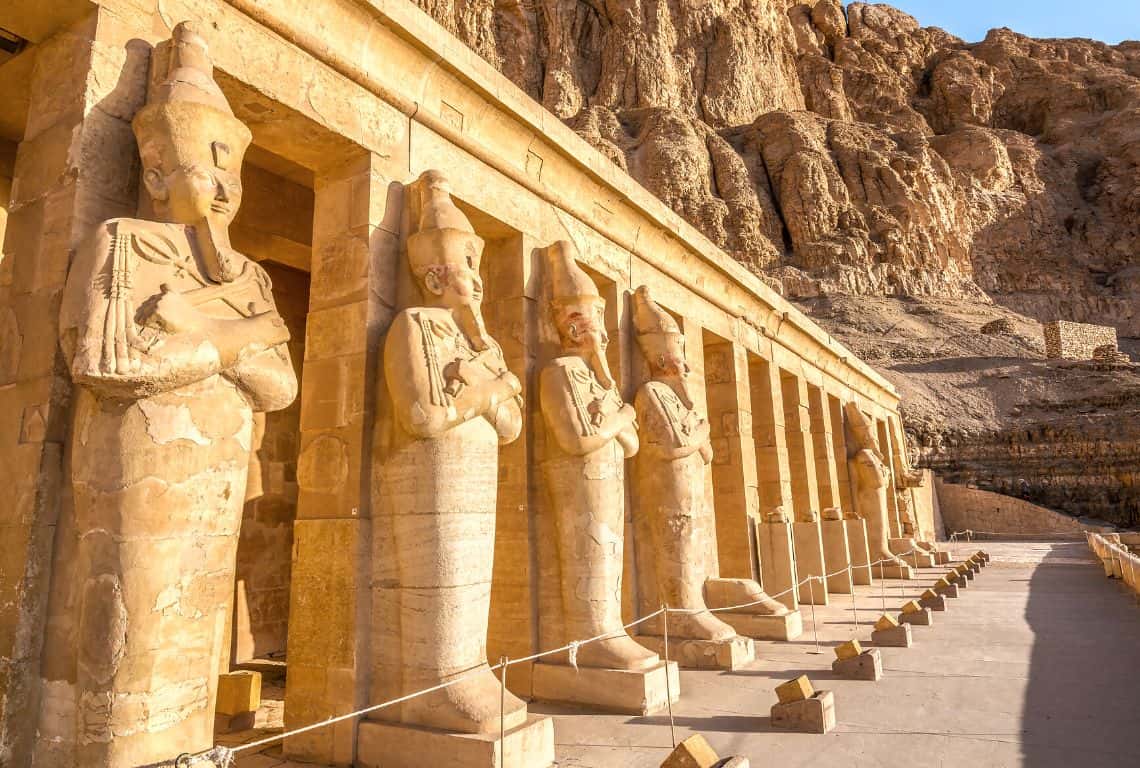
Temple of Hatshepsut / Egypt Tips for First Timers
- Cairo Egyptian Museum
The Museum houses the world’s largest collection of Pharaonic antiquities consisting of more than 120,000 items (with a representative amount on display and the remainder in storerooms). To see it all, would take you days! To make it manageable, read 19 must-see things at Egyptian Museum . PLUS, things you need to know before going to the museum.
Learn More About Cairo Egyptian Museum:
19 Must-See Things at Egyptian Museum in Cairo (+Practical Tips)
Intrepid Scout's Egypt Tips for First Timers
- Get your e-Visa before traveling to Egypt. Apply and get your visa to Egypt online. It is a simple process to apply online and it will save you time when you arrive in Egypt.
- The best time of the year to visit Egypt is during the winter months. The temperatures are mild and perfect for exploring Egypt.
- Book the Nile river cruise! The Nile river cruise is still one of the most popular ways to see Egypt’s ancient sights. Many of the most famous sites are located directly on the river. At night, many of the temples and monuments are beautifully illuminated, and the sight of them from the water is stunning.
More Information About Egypt
How to Visit and What to See at KHAN EL-KHALILI BAZAAR in Cairo
Perfect 7-Day Egypt Itinerary for First Visit (Cairo, Aswan, Luxor, Abu Simbel)
What to See at the TEMPLE of HORUS at EDFU (5 Things You Can’t Miss)
10 Epic Things to See and Do at the Pyramids of Giza
What to See at the TEMPLE of KOM OMBO, Egypt (9 Things You Can’t Miss)
How to Visit and What to See at the TEMPLE of PHILAE in Aswan
Best Day Trip from Cairo – Dahshur, Memphis, and Saqqara (Maps+Photos)
Read All the Posts About Egypt in:
Egypt Travel Guide
Don't Have Time To Read it Now?
Why not save egypt tips for first timers to your pinterest board.
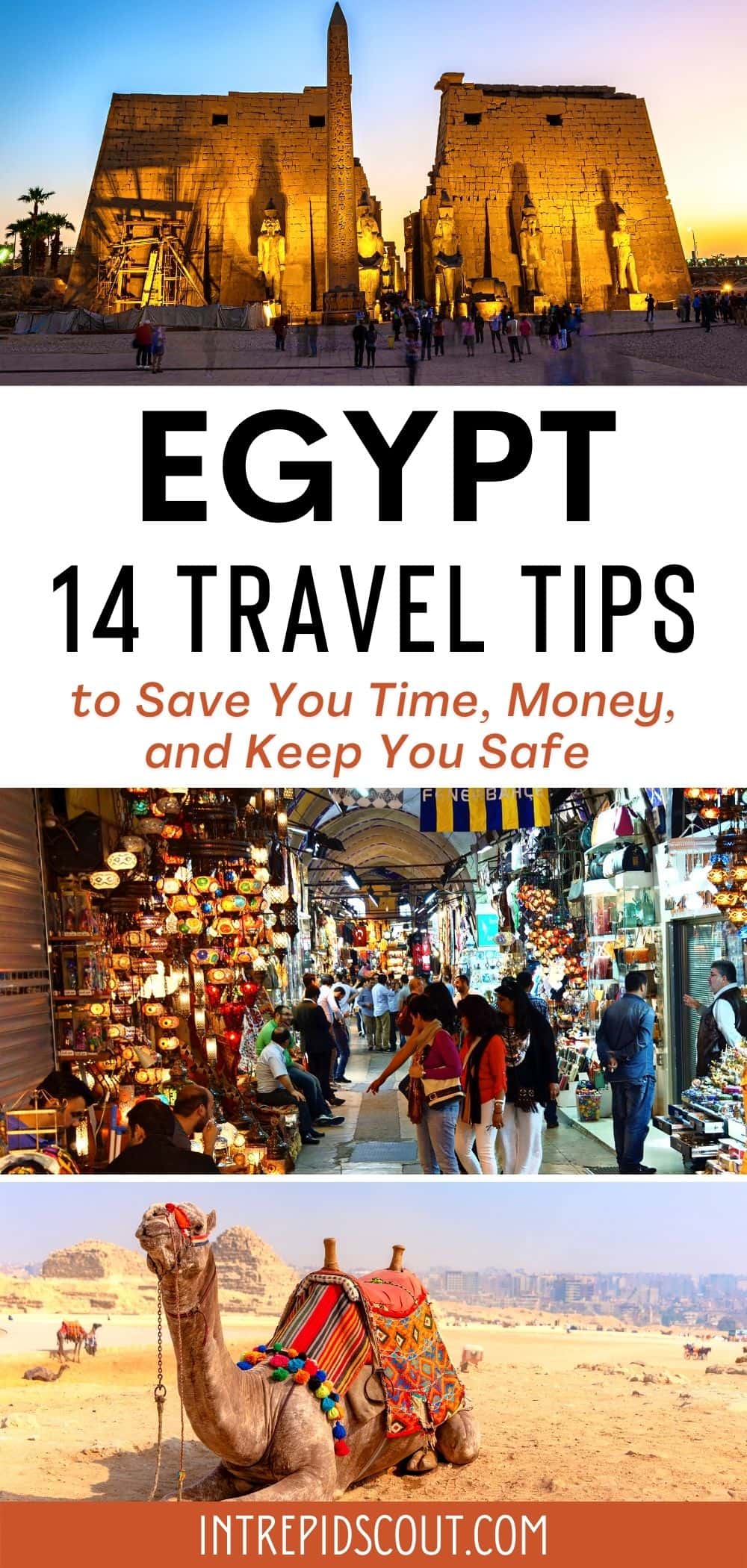
Now, It Is Your Turn, I Would Like to Hear Back from You!
Are you planning your trip to Egypt?
Please let me know! Drop me a quick comment right below!
Click on any of the images below to get inspired and to help you with the planning process for your trip to Egypt!
- alert('URL copied to clipboard.')).catch(err => console.error('Unable to copy to clipboard.', err))">
Share via Email
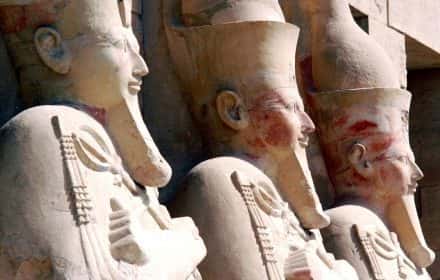
18 Amazing Things to Do in Luxor (Your Ultimate Luxor Bucket List)
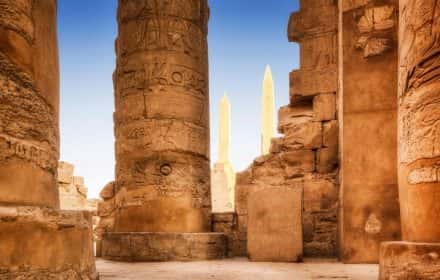
Perfect 2-Day Itinerary in Luxor (7 Things You Can't Miss)
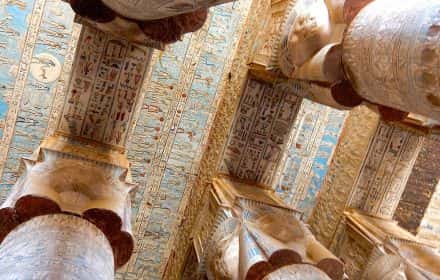
5 Best Do-It-Yourself Day Trips from Luxor (Maps+ Useful Tips)
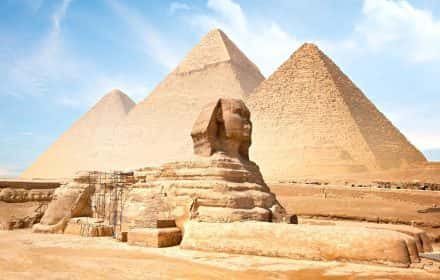
10 Epic Things to See and Do at the Pyramids of Giza (Unlock Giza's Gems!)
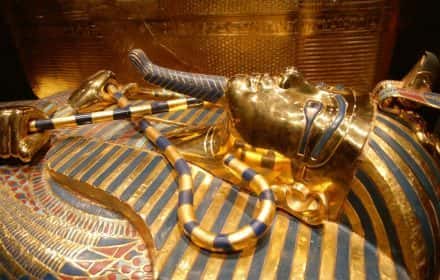
Amazing 19 Must-See Things at EGYPTIAN MUSEUM, Cairo (+BEST Practical Tips)
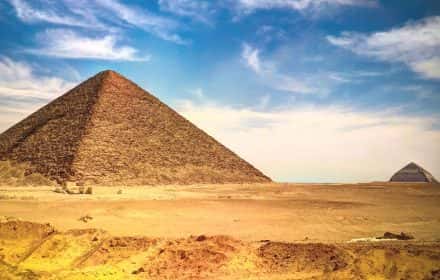
DIY Day Trip from Cairo to Dahshur, Memphis and Saqqara (Maps+Useful Tips)
@intrepid.scout
Leave an answer Cancel reply
Your email address will not be published. Required fields are marked *
The company processes your data to facilitate the publication and management of comments. You can exercise your rights of access, rectification, deletion and objection, among others, according to our Privacy policy .

No products in the cart.
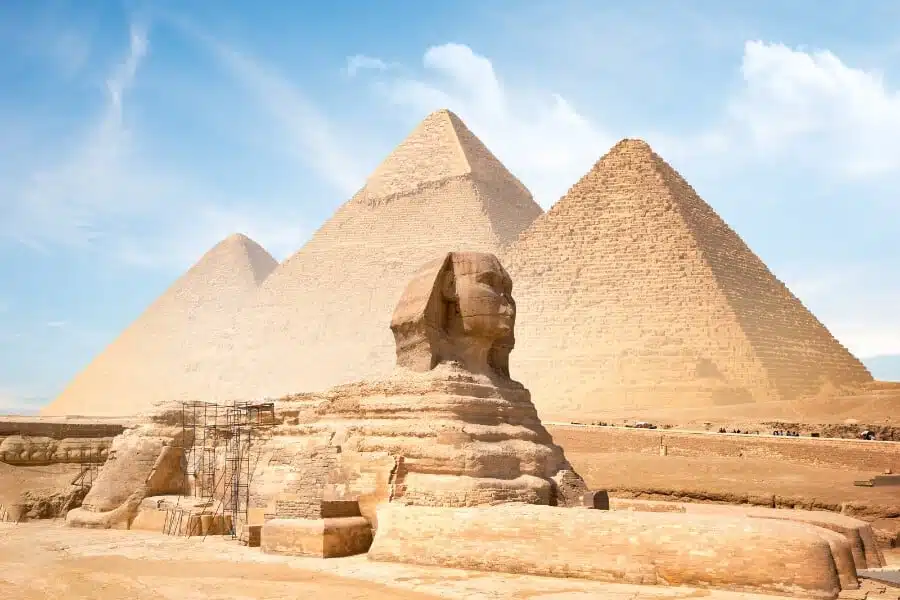
The Ultimate Egypt Travel Advisory: Essential Insights
The lure of egypt.
Ah, Egypt—the land of the Pharaohs, majestic pyramids, and the mighty Nile River. While this African gem offers a myriad of attractions, it’s crucial to be aware of travel advisories that may impact your trip. The information in this guide can help you prepare for a safe and enjoyable adventure.
Egypt Travel Advisory: What Does It Mean?
When it comes to travel advisories, many travelers aren’t sure what they mean or how seriously they should be taken. An Egypt travel advisory is essentially a set of guidelines and information issued by governments to inform citizens about current conditions in Egypt, especially about safety and security.
Understanding the Advisory Levels
Types of advisory levels.
Different countries have various ways of categorizing their travel advisories, but they generally fall into four main categories. These range from exercising normal precautions to do not traveling.
When the Levels Change
Advisory levels can change based on a multitude of factors, such as political stability, health crises, or natural disasters. It’s imperative to stay updated on these advisories.
Is Egypt Safe for Tourists?
The million-dollar question: Is Egypt safe? Overall, Egypt is considered safe for tourists, especially if you stick to touristy areas and take basic safety precautions. However, it’s essential to remain vigilant and informed.
Health Precautions and Vaccinations
Necessary vaccines.
Before traveling to Egypt, consult with your healthcare provider about necessary vaccinations like Hepatitis A, Typhoid, and Polio.
What to Pack in Your First Aid Kit
A well-equipped first-aid kit should be part of any travel plan. Essentials include band-aids, antiseptics, and medication for common issues like diarrhea and fever.
Recommended Egypt Tours with One Nation Travel

Embarking on a tour can be a fantastic way to discover Egypt’s rich tapestry of history, culture, and natural wonders. Tour operators such as One Nation Travel offer an array of meticulously planned Egypt tours to fit various travel styles and interests.
Why Choose One Nation Travel?
One Nation Travel stands out for its commitment to customer satisfaction, offering high-quality service from start to finish. Their tours are flexible and can be customized to cater to your specific needs, ensuring that your Egyptian adventure is as unique as you are.
Popular Tour Packages
- Nile Cruise: Discover the majestic Nile River and its history.
- Cairo and Giza: Explore the bustling city and the pyramids that have captivated travelers for centuries.
- Red Sea Adventures: Dive into the underwater wonders of the Red Sea.
- Cultural Immersion: Visit ancient temples, and tombs, and experience local customs.
The One Nation Travel Advantage
- Expert Guides: Knowledgeable and friendly guides make each trip educational and enjoyable.
- Safety: One Nation Travel prioritizes the safety and well-being of its travelers, adhering to all travel advisories and ensuring comfortable travel conditions.
- Convenience: From hotel bookings to airport transfers, everything is taken care of.
Choosing a reliable tour operator like One Nation Travel not only enhances your travel experience but also ensures that you are in safe and capable hands. By paying attention to travel advisories and selecting a trustworthy partner for your journey, you’re set for a memorable and enriching Egyptian adventure.
FAQs on Egypt Travel Advisory
What documents do I need to travel to Egypt? A valid passport with at least six months of validity and a tourist visa are the primary documents you’ll need.
Is tap water safe to drink in Egypt? It’s advised to drink bottled or boiled water.
What is the local currency and can I use my credit card? The local currency is the Egyptian Pound. Credit cards are widely accepted, but it’s smart to carry some cash.
How should I dress in Egypt? Respect local customs by wearing modest clothing, particularly in religious sites.
What is the emergency number in Egypt? The general emergency number is 112.
Are vaccinations required for Egypt? While not mandatory, vaccinations like Hepatitis A and Typhoid are highly recommended.
Conclusion: Final Thoughts and Recommendations
Armed with all the necessary information from this comprehensive Egypt Travel Advisory guide, you’re now set for a more secure and enriching journey to Egypt. From the bustling streets of Cairo to the tranquil beaches of the Red Sea, your Egyptian odyssey awaits. Travel wisely!
Top 3 Premier Egypt Tour Packages
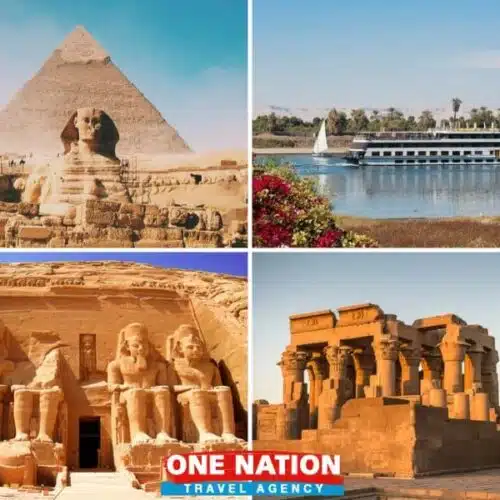
Similar Posts
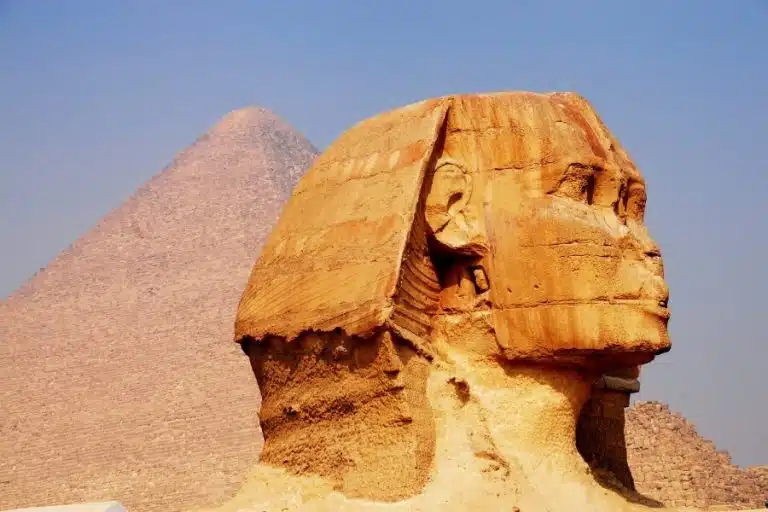
Egypt Travel Advice: Your Ultimate Guide
Explore vital tips in our Egypt Travel Advice guide. Dive into safety protocols, ideal travel times, top sightseeing spots, and more for a remarkable trip to Egypt!

The Most Popular Destinations for US Travelers
Embark on a journey through favored locales by American adventurers. Experience a blend of cultural richness and natural splendor.

How to Spend Three Days in Cairo: An Unforgettable Journey
Maximize your Cairo journey with the best tour agencies. Learn how to spend 3 unforgettable days exploring historic and modern Cairo.

The Perfect 5-Day Itinerary for Cairo and Luxor: Uncover Egypt’s Ancient Wonders
Discover the awe-inspiring ancient wonders of Egypt with our expertly crafted 5-day itinerary for Cairo and Luxor. Witness the Pyramids, Valley of the Kings, and more!
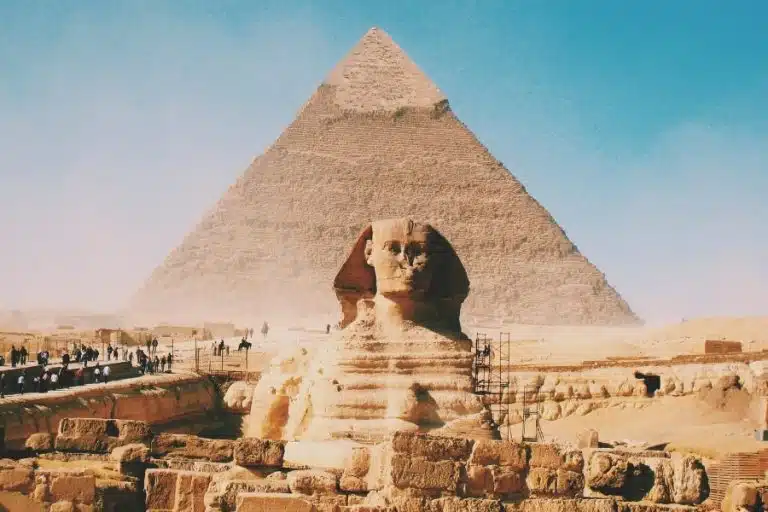
10 Tips for Your First Visit to Egypt
Discover essential travel tips for your first journey to Egypt. From must-visit landmarks like the Pyramids and Sphinx to safety measures and cultural nuances, our guide offers a comprehensive look at Egypt. Whether you’re a history buff or an adventure seeker, get ready to explore Egypt like a pro.

Explore Timeless Pyramids and Temples in Egypt
Dive deep into the mysteries of ancient Egypt with Egypt Tours, exploring the grandeur of its pyramids and temples, and uncovering the stories of the Pharaohs.
START PLANNING YOUR TRIP
Our team of experts have a wealth of knowledge and experience to help you plan your adventure of a lifetime.
- Central America
- New England
- South America
- Festivals/Holidays
- Responsible Travel
- Writers Guidelines and Sponsored Posts

40 Essential Egypt Travel Tips
There has never been a better time to plan a trip to Egypt. Having just recently returned with oodles of information, my Egypt Travel Tips will help your planning process. Travel these days has gotten a bit challenging; I hope my suggestions will make your preparation smoother and your international vacation a wonderful holiday.

With an Egyptian stamp clearly inked in my passport, I’m totally convinced the country is a destination everyone should have on their bucket list. I’m already trying to plan another visit with my husband, as I know the historical sites of temples and pyramids will be highlights of a lifetime of travel.
Organizing usually begins with the pyramids, structures dating back over 4000 years. On an eco-friendly note, new electric buses make travel around the Giza pyramids easier than ever. Add in the Nile, the Red Sea, Aswan, Cairo, and there is just so much ancient history and culture to experience. Oops, did I neglect Alexandria, a day trip to Abu Simbel, the western desert and Siwa oasis? I told you I was already planning a return!
Table of Contents
Travelling to Egypt: What You Need to Know Before You Go
The gem aka grand egyptian museum.
The GEM or Grand Egyptian Museum is set to open in early 2023 and will represent the largest archaeological museum in the world. Over one billion dollars have been spent on this spectacular attraction. Located near the Pyramids of Giza, the only remaining Ancient Wonder of the World, visitors will have an opportunity to see the first exhibition of King Tutankhamun’s full tomb collection.
Travel searches for Egypt have exploded and agents are having a hard time keeping up with demand. Egypt is one of the most mysterious destinations on the planet and it’s been on the top of my bucket list for many reasons, not least of which a desire to cruise on the Nile.
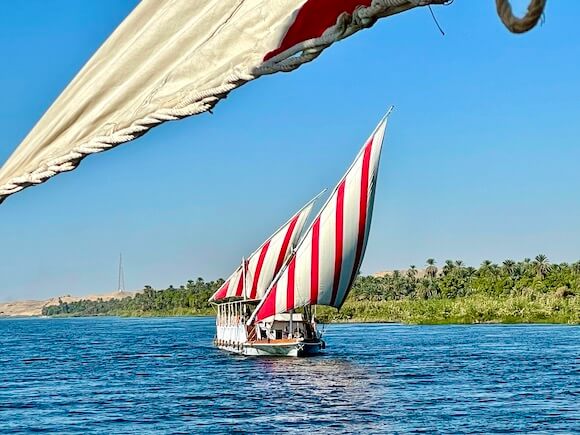
Dream come true. The view from my cruise on the Nile!
So, while I’ll hardly call myself an expert on Egypt, I am an expert traveler and always learn more from each travel experience. Bookmark these Egypt travel tips for when you start planning your vacation. The #1 question on everyone’s mind:
Is it Safe to Travel to Egypt?
While Egypt is a relatively safe place to visit, it still requires some caution as petty crimes, like pickpocketing, are common. Yes! It’s much safer than the media may lead you to believe. I long ago learned to use the State Department Guide only as a benchmark. I find first-hand experience from other travelers a much more dependable guide for my type of eco-luxe travel.
Insider Tip: I do make a habit of registering on the State Departments Smart Traveler Enrollment Program (STEP).
There are a few things you can do to help yourself stay safe.
Travel Tips for Added Safety when Traveling in Egypt
- Keep valuables packed away out of sight. Costume jewelry goes along way when on the road.
- Be aware of your surroundings.
- Take care with your phone (think about a leash) as well as your camera. Handing it over to one of the many “guides” that will offer to take your picture is not such a great idea.
- Enroll in the Smart Traveler Enrollment Program (STEP) to receive Alerts and make it easier to locate you in an emergency.
- U.S. citizens who travel abroad should always have a contingency plan for emergency situations. Make sure to have emergency numbers stored in your phone.
- Give a copy of your itinerary to a trusted friend/relative in your homebase
Note: I would suggest using the above common sense when traveling anywhere, even in my own country.
Tourism is big business in Egypt and Egyptian authorities have many safeguards in place to protect tourists during their time in the country. These include having large numbers of “Tourism Police” in place, you will see them all over in Cairo and particularly at landmarks in smaller destinations and touristy spots. While seeing guards armed with machine guns might seem alarming, I found these guards to be friendly and welcoming, proud to see visitors returning to their country.
As soon as I landed in Cairo and turned on my phone, I received the following text message from the Tourism Department:
Welcome to Egypt. For any issues or concerns, please contact the hotline of Ministry of Tourism and Antiquities (19654). In case of emergency, please call the following numbers, 122 for police, 123 for ambulance and 180 for the fire department.
That was a first! I’ve never received such a message when traveling internationally. I’m not sure whether it made me feel safer or more at risk.
All of the above being said, I found the Egyptians to be warm and welcoming. Never during my 12 days in the country did I feel unsafe or threatened in any way!
Egyptian Visa

Many citizens from other countries will need a visa for travel to Egypt. Check the government web site. For United States citizens you can get a visa on arrival. You’ll need to have $25 cash and pay for your visa at a special window before you go through immigration. There are plenty of online visa services that will charge you much more to get the visa. DON’T!
My travel companion got her visa from the official web site on line beforehand. I found the web site confusing and frustrating, eventually giving up. Must be a right brain/left brain thing! When we arrived at Cairo International Airport, it took us both the same amount of time to get through immigration. The visa is valid for up to a 30 day stay.
Money and Foreign Currency

Crisp Bills
You can use US currency to pay for many things in Egypt, including your hotel room. Note that Egyptians want clean, crisp bills and nothing printed before 2016. I was told banks will not accept large bills printed before 2016 from Egyptians, so they don’t want to be paid in older currency. The official currency is called the Egyptian pound.
Inform Your Bank That You’re Visiting Egypt Before You Travel
Inform your bank well ahead of time when and where you’ll be travelling so you can use your credit cards for international payments. Some credit cards send a text to confirm purchases (I’m looking at you Chase) and you don’t want international charges coming through on your phone if you haven’t signed up for an international plan.
Not Every ATM Works With Every Card in Egypt
The maximum withdrawal at most ATMs is $250. USD/day. Make sure to carry enough cash with you.
Not all ATMs will work with all cards. I’m sure there must be a rhyme or reason to it, but I’ll be dammed if I could figure it out. Just don’t be surprised if you get a flashing error message and your card returned without giving any cash.
Download a currency conversion app like XE.com to keep tabs on how much money you’re spending. Egypt was one of those places that I just could not make the mental conversion. Without the app, I would have been lost.
There is a limit for US currency you can bring – $10,000 USD.
Don’t forget to tip. The average tip percentage for waitstaff, tour guides, and taxi drivers is between five and 10%. I always bring some one-dollar bills or coins in my pocket for unexpected tips. (ie the ladies room). I hate fumbling through my wallet with a crowd around.
Travel Insurance
Please, please dear readers, purchase travel insurance for your trip. There are so many things that can go wrong in today’s travel landscape. I wouldn’t think of stepping outside of the US without my travel insurance.
Scams, Hassels and Tips
This was probably the most challenging thing for me when I was traveling in Egypt. Everyone on the street is trying to make a buck. Hawkers are everywhere and they are relentless. It’s very tough to not be friendly when someone asks you “where are you from” with a smile on their face. My best advice, come with a thick skin and wear it during your visit. Bring a good pair of dark sunglasses and just keep on walking. People don’t take no for an answer when you show the slightest sign of “weakness”.
Egypt relies heavily on tourism and I understand that tourists are seen as dollar signs. Just remember that nothing is free, this is the way many make their living. Learn to say No Thankyou (below) before you step off the plane.
I’ve never traveled to a country where I had my hand in the tip wallet more than when I was in Egypt. In fact, it was the least favorite part of the trip and the only true negative I would report. Salaries are low in Egypt, and although there is no set of rules and tipping is meant to be optional, it pretty much is mandatory – so you can safely assume you will have to tip for just about any service. Photo on the camel ride? TIP! Bathroom attendant? TIP! Waiter at a restaurant offers to take a photo of you and your family? TIP! Tour driver? Definitely tip! You get the idea.
If you come from a tipping culture, this will be easier for you. I also can’t help but feel grateful for the privilege of travel and am aware the tipping culture is a small price to pay for seeing this wonderful country. If you are prepared and have a few coins or pounds ready to go in your pocket, it becomes a lot less intrusive.
Weather in Egypt and Trip Planning
The Egyptian capital of Cairo has a hot desert climate. However, instead of experiencing dry heat, its proximity to the Nile Delta and the coast can make the city exceptionally humid. In June, July and August, heat wimps such as myself, would find the temperatures and humidity unbearable. You’ll have to be a hearty traveler to want to visit the inside of tombs in 100+ degree weather!
With the small exception of its strip of Mediterranean coastline, the whole of Egypt has an arid desert climate. Throughout Egypt, days are commonly warm or hot and nights are cool.

Light clothing and a comfortable pair of walking shoes are essential in Egypt.
Egypt is very dry and receives fewer than eighty millimeters (3.14 inch) of rainfall annually in most areas. Highest precipitation is along the coast, but even Alexandria, the wettest area, receives only about 200 millimeters (7.87 inch) of precipitation per year.
The geography and landscape of Egypt can make the selection of a travel month a bit problematic. You should consider the temperatures before selecting a month to travel. Keep in mind the crowds as well. I always prefer to travel during off peak or shoulder seasons.
High Season and More
The best time to visit is between October and April to get pleasantly sunny weather without the extreme summer heat. Out of all three seasons that occur during these months, autumn, which happens between September and November, is the best time to visit.I visited this past November and although it was warm, it wasn’t unbearable by any means. Evenings actually brought a chill to the air and I fully took advantage of the blankets on offer for our Nile cruise.
In April and May take note that the Khamsin Wind blows through Egypt. This hot sandstorm can cause disruptions and unpleasant weather during a trip, especially if you plan to be out in desert areas.
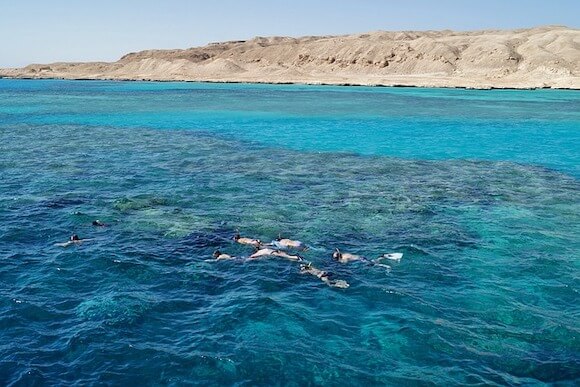
A most important tip regarding the weather: Don’t forget to stay hydrated, apply sunblock often, and bring your sunglasses. One of the most vital travel tips in Egypt people forget is that it is a desert climate with lots of sun and heat.
Keep in mind that winter is the peak season for tourism in Egypt. Because the weather has cooled, tourists crowd the ancient sites, making the lines longer and the hotel prices skyrocket. During Christmas and New Years, hotels and cruises raise their rates significantly and they book up far in advance so you’ll want to plan your travel accordingly.
Packing Tips

Egypt is a predominantly Muslim country that is still quite traditional. I make it a habit to follow local customs and dress conservatively to respect the religion and local culture. If you’re a female traveler, pack loose-fitting clothes covering your shoulders, chest, and knees to wear in the city. That being said, you will see a WIDE variety of styles of dress.
Men’s dress codes are more relaxed: if you cover your shoulders and wear trousers, you’re broadly OK. Leave the muscle shirts at home or bring only for the beach.
Pack a shawl–ALWAYS. If you’re visiting a mosque or holy building, you’ll need to wear clothes covering your elbows, legs and head. The temperature drops at night and a pashmina is an easy wrap.
Toilet paper can be an issue when you’re off the beaten path. A packet of your own toilet paper or wipes is a good idea.
Don’t Drink the Water
One thing I’m pretty crazed about in a foreign country is drinking water. It’s important to stay hydrated, and almost everyone will have stomach issues when switching from the water they normally drink. Geeze, I even have trouble when I travel in the states. A bad stomach bug can ruin a trip.
However, stomach adjustments and food/drink safety are two different issues. Travel tips for Egypt – don’t drink the water. This includes brushing your teeth, keeping your mouth shut in the shower and avoiding salads and cocktails with ice unless you’re sure the water is filtered.
Take along a reusable straw, water bottle and market bag. Plastic waste is an issue in Egypt (like almost everywhere else in the world) so consider a bottle with a filter like the LifeStraw Personal Water Filter. It helps to eliminate the need for bottled water. I used it all over India without any stomach issues and
While we’re talking plastic, try and limit packaging and the purchase of anything that isn’t recyclable. Say no to plastic and try to Think Zero Waste for a more responsible trip.
Using a local SIM card
If you want to get a local SIM card for unlocked phones, you can find them at the Cairo airport. Look for the orange kiosk near the Arrivals baggage claim. After showing your passport, the process is very efficient.
Photography Travel Tips while in Egypt
Do not pack a drone for your trip. Not only are they illegal to fly, they are basically not allowed in the country unless you obtain permission from Egypt’s Civil Aviation Authority before operating your drone.
It doesn’t matter if your drone never leaves your suitcase. You will have issues if you try to bring it in without the proper permission.
Egyptian Laws strictly forbid tourists to take pictures of or near military installations. You also shouldn’t take photographs of public buildings and infrastructures, such as train stations and bridges. I was questioned at one historical site and had to show the last several photos on my camera to the authorities.

Take pictures of the ancient artefacts and structures, but don’t take photos of any officials without their consent. It is also prohibited to take photographs of the infrastructures outside of tourist hotspots.
Photography of locals without their permission is disrespectful. Always ask beforehand. This is especially true when photographing children. Imagine how uncomfortable you would be if someone started taking photos of your child playing in the ocean at the beach.
There are many police/guards with rifles around entrances to all sorts of places. I found most to be quite friendly and would usually offer a “Welcome to Egypt.” However, they do not want their photo taken without asking first!
Responsible Travel Tips for a Trip to Egypt
Before arriving in Egypt, spend some time reading up on the history of Ancient Egypt. I found that many tour guides didn’t dig very deep. They covered a basic level of ancient Egyptian history and often I heard different stories about the same gods and/or pharaohs.
You’ll appreciate the sights so much more if you have a deeper understanding of the history of places you’re visiting.
- History of Egypt Podcast There are many episodes, the web site allows you to go through the list and find relevant themes. Very comprehensive and great reviews.
- I always like the Eyewitness Travel Series of Guide books and their Egypt volume is great.
- Nefertari-The Untold Story of Ancient Egypt’s Greatest Queen on YouTube
And of course, it’s fun to watch Charlton Heston in The Ten Commandments when a trip to Egypt is on your agenda. We stood in the spot (maybe yes, maybe no) where Moses was set adrift along the Nile. Makes for a good story anyway!
Hieroglyphics
I never knew hieroglyphics was an actual language–an alphabet– I always thought it was for telling a rudimentary story, like a picture book. After seeing our wonderful guide Ahmed read history in the Elkab Necropolis , it opened a whole new world. I was inside a tomb from 1475 BC and the early 18 th Dynasty. It was truly an overwhelming moment.

When I asked Ahmed how long it took to learn, he rolled his eyes indicating with a smile it wasn’t overnight! If you’d like to brush up or learn more, the library in Alexandria’s website also has some really cool resources like a step-by-step guide to reading Hieroglyphics . I also found this Ancient Egypt website quite helpful. You can search by monument, dynasty, king, and queen.
Language Learn Key Phrases
I’ll be the first to admit the language learning part of my brain does not work well. While most people in Egypt speak Egyptian Arabic, English is widely spoken and understood. You’ll especially encounter this if you stick to major cities like Cairo, Luxor and Alexandria near tourist hotspots, hotels, and resorts.
Learning a few Egyptian Arabic phrases is always a good idea. Thank you and H el lo go along way wherever I happen to be in the world. In Egypt I also found No Thank You very useful.
- la’ shukran ( no thank you )
- shukran ( thank you ),
- ayna al-Hammaam? – where is the restroom?
- aywa – yes
- la – no
Tip: Always carry your hotel’s business card with you. If you get lost or encounter a language barrier with taxi drivers, you’ll be happy you did! I have used this tip so many times.
Try Local Restaurants
Please please, venture out of your hotel to eat. There are food tours, great restaurants and plenty of markets to try some of the local flavors. Scroll Instagram with a few hashtags of your interests and you’ll be amazed at the results. I’m a lover of local vegetarian dishes and am always so disappointed when a guide takes me to a a spot geared to tourists.

Walking in Cairo’s Khan al Khalily bazaar and found this great spot for coffee and people watching.
Find your own restaurants ahead of time. I’m a HUGE foodie and want to discover the dishes and ingredients a country is known for. I love to research restaurants popular with locals on Instagram and other blogs when planning. Markets are usually my first stop when I get to a new destination. Get a birds-eye view of what’s in season.
The boom in culinary travel has given Baby Boomers the opportunity to spend your dollars where they’ll have an impact. Gastronomy represents one spoke in the sustainable tourism wheel where travelers can easily make a difference. As we explore and indulge in eating around the globe, this can begin with the way we nourish our bodies and support small businesses using local ingredients.
Learning simple, some might say old-fashioned ways of eating and choosing traditional dishes can make a statement with our pocketbooks. Who doesn’t love meals that are good for you, beautiful to look at and good for the earth?

So many choices of fresh and delicious fruits and vegetables in Egypt.
Go Meatless for the Planet
Vegetarians will find many offerings of traditional Egyptian dishes. Make sure to try a few –falafel, koshari tahini and zuchinni are just a few of the many offerings you’ll find. A plant based diet is better for you and the planet. Plant based proteins (such as beans and lentils) require far less water and produce less methane than meat. Follow these travel tips from Dr.Wink, my infectious disease guru, in this post safety tips when eating street food.
Should You Hire an Egypt Travel Guide
While I know many women who have traveled solo to Egypt, I usually feel more comfortable working with a guide, at least for the more complicated pieces of the itinerary. When I was planning to travel in Egypt with my girlfriend, I wanted to find a guide that would be flexible, knowledgeable about culture and local crafts and well versed in the rich history. I wanted to feel safe and thought I would get a lot more out of traveling in a place with such a rich history with an expert.
Alternatively, there are many group tours that cover different parts of Egypt. I personally enjoy small group tours, but feel picking the right company is key to an enjoyable experience. Do you like adventure? Looking for a culinary experience? Or is a combination of culture and hiking more to your liking?

Our guide in Luxor added a great dimension to the short amount of time we had.
Two groups immediately come to mind, and I have worked with both. With responsible travel at the forefront of their mission, they take care of all the details and have a range of trips to fit your budget. These are GAdventures and Intrepid Travel. Personally, I like to combine a bit of an eco-luxe stay with digging deep into the culture.
Egypt is such a diverse and beautiful country. There are countless ways to plan an itinerary. Be sure to return to Green With Renvy for my 10 day Egypt itinerary COMING SOON. It covers Cairo, Luxor and Aswan and includes all the incredible sights, food and an extraordinary cruise on the Nile.
When planning your trip to Egypt, make sure to check the dates for Ramadan. This holy month of fasting can have an impact on your trip and because the Muslim and Western calendars are quite different, the dates can vary greatly from year to year.
Many businesses close for much of the day during Ramadan. While tourists are not expected to fast, you might have a hard time finding cafes and restaurants open during daylight hours. When Ramadan ends a month of fasting, the religious celebration festival, Eid al Fitr, lasts four days.
Travel Passes
If you are traveling to Egypt independently, travel passes can save you a lot of money by combining the most popular sites into one fee. The Cairo Pass offers entrance to sites in Cairo, Giza, Dahshur, Mit Rahina, and Saqqara.
You need your passport, two photocopies of your main passport page, and two passport photos to get this pass. You can buy it at the Egyptian Ministry of Antiquities office and a few other attractions.
The Luxor Pass offers entry to all archaeological sites on the east and west bank of Luxor. You can purchase this pass at the visitor centre of the Valley of Kings and Karnak Temple.
Festival Calendar
There are many festivals held across Egypt. Listed below are a few of the more popular ones.
Coptic Christmas
Winter brings the first festival of the year with Coptic Christmas taking place on January 7th. At midnight, worshippers gather for mass and enjoy a feast together. Following the evening mass and prayers, people gather to celebrate with a traditional dish of rice, garlic, and meat soup.
Sham al Nessim
In April, Sham al Nessim, (also known as the Sniffing the Breeze Festival), celebrates the arrival of spring. This occurs every year on Easter and is celebrated by all, regardless of faith. Families gather and celebrate with picnics in parks and on riverbanks throughout Egypt.
Wafaa al Nil
With the Nile playing such an auspicious role in Egyptian life, there is no doubt a festival to celebrate her mighty power. During September, Wafaa Al Nil, an ancient festival devoted to the river takes place. The festival is filled with art competitions, poetry readings, concerts, and a focus on culture.
Abu Simbel Festival
The Abu Simbel Festival or Festival of the Sun is is held in February and October every year and it is a celebration of the glorious temple and most important Sun god. During the festival, the sun rays reach the inner sanctuary of the temple and the statues of Ra, Ramses and Amun are bathed in sunlight, receiving enlightment. For Ptah, goddess of darkness, her world remains obscured.
Moulid of Abu al-Haggag
This festival honors Luxor’s patron saint, Abu al-Haggag. His mosque sits on top of Luxor Temple. Giant floats travel through the crowded streets over the three day celebration. Sufi music, drumming, ritualistic stick fights add to the drama. Horse races and boat rides also mark the occasion. The moulid occurs the month before Ramadan and so the date changes each year.
Additional Random Travel Tips for Egypt
Cairo is a chaotic city with more than 15 million people. Traffic is crazy, crossing the street is an aerobic workout! Make sure to leave yourself plenty of time. I would not recommend renting a car or driving yourself. At times it feel like all of the 15 million residents are together on the road! Another thing to be aware of is that not all license plates and street signs will have numbers or letters that you’ll recognize, this can be a challenge if using UBER.
Think Twice About Interior Pyramid Tours
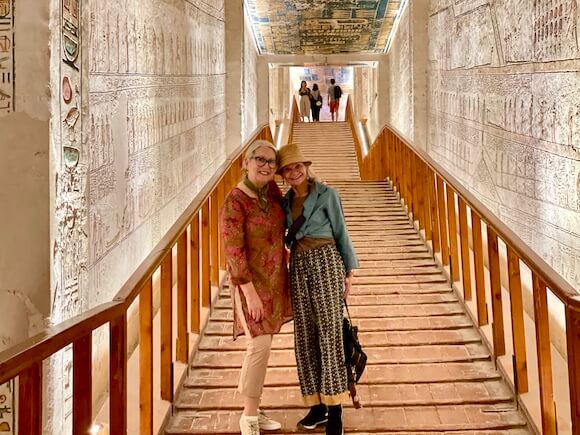
Visitors can access many of the pyramids interiors. Some are much more worth the time and effort than others. If you’re the slightest bit clausterphobic or limited on time, do your research and just choose a few. I selected the tomb of Ramses in the Valley of the Kings and happily paid a tip to the guard that offered to take our photo. They were excellent choices for me: colorful, filled with hieroglyphics and well lite. Decide for yourself what your priorities are when touring.
Skip the Tour Shops
Your average tour guide will drag you through papyrus, Egyptian cotton, perfume and Egyptianrug shops. If you want to take advantage of these indigenous products, by all means, do so! But again, do you research beforehand and know how much you should be paying.

One of my favorite stops, the Luxor Pottery School.
Often they can be completely unrelated to your interests and often the guides get a kick-back for bringing you there (the motivating factor). There are plenty of talented makers in Egypt. Look for the smaller spots where local crafts are being highlighted, not taken advantage of.
Though it may not seem like it, if you like the heat, Egypt can be considered a year-round destination. Who knew that you could lounge by the sea, camp in the desert, float in a crystal blue saltwater pond and visit the only remaining Ancient Wonder of the World all in the same destination? You might need a month to cover all these highlights, but there truly is something for everyone in the Land of the Pharaohs.
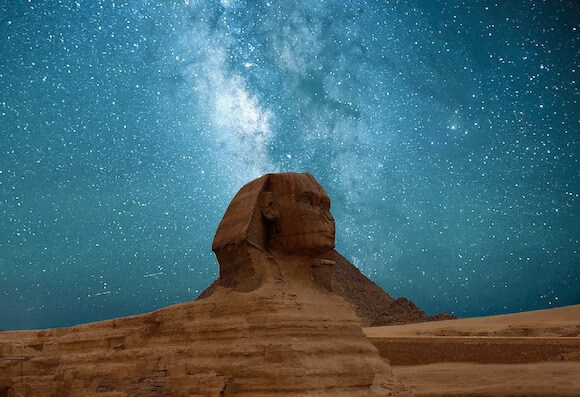
In reality, a world of swoon worthy attractions awaits. There is a site everywhere on the planet that makes for a good photo. There is also an authentic experience waiting to be had. All it takes is a little research and the use of a few responsible travel tips to make a positive impact wherever the road might take you.

Thank you for the excellent guide to Egypt, especially the links to other websites such as learning to read hieroglyphics.
See Our Limited Edition Travel Scarf

First Visit? Start Here
Get Green With Renvy in Your Inbox
Women in travel 2019-ethical travel award.

BEST BOOMER TRAVEL BLOGS 2018

BEST CULINARY TRAVEL ARTICLE 2017

- Meatless Monday 76
- Local Creatives 3
- Take Me There 3
- Passport Envy 0
- Maptastic 0
- Weekend Views 1
- Pay It Forward 2
- Armchair Travel 1
- Eco-Friendly
- Farm To Table
- Written Word
- Sustainable
Network Images Go Here

Recent Pins

- Farmhouse Home
- Green Global Travel
- Green Kitchen Stories
This page is having a slideshow that uses Javascript. Your browser either doesn't support Javascript or you have it turned off. To see this page as it is meant to appear please use a Javascript enabled browser.

Fall Nantucket A to Z

10 Reasons to Visit Ukraine Now

Beet Burgers for Meatless Monday

armchair-travel-no-9
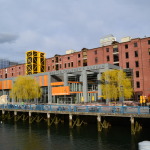
10 Urban Walks Across America
Sponsors images go here.

All original content and photos are © copyright Alison Abbott for Green With Renvy or have been obtained using Creative Commons. Sharing is caring and I appreciate a link back if you should decide to share content from Green with Renvy. You’re welcome to use photos together with a credit and link to the original post with the words Green With Renvy. If you pin my original images, please remember to link with love and list Green With Renvy as the source.

- Work With Me

- Sierra Leone
- South Africa
- United States
- New Zealand
- Falkland Islands
- Netherlands
- Accommodation
- Electrical Gear
- Essential Gear
- Working Abroad
- Blogging Resources

Africa , EGYPT
Complete packing list for egypt.
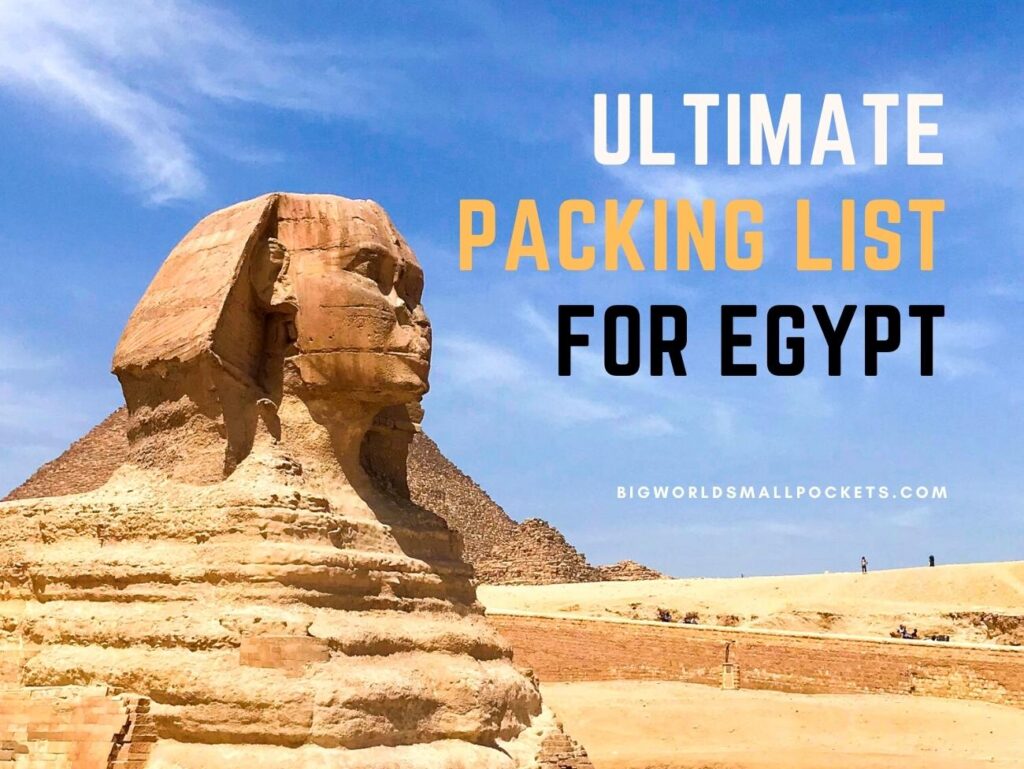
Located at the top of the African continent, but feeling more culturally similar to its neighbours in the near Middle East across the Red Sea, Egypt is a country with filled with fascinating geographies, histories, people and cultures… especially when it comes to travelling!
I spent 3 weeks in Egypt as a solo female adventurer and experienced very little hassle, in fact, I loved this country with its wonderful ancient treasures, world-class museums and incredible river cruises.
However I know that doesn’t ring true for all travellers to this country and that many people do find they get pestered in Egypt.
What I don’t want this to do however, is put you off going there.
The key to enjoying Egypt, rather than just surviving it, is probably to be prepared, be wise and to do some serious research before you go… of all which my blog can help you out with, so don’t forget to hunt around for all the Egypt content I’ve written previously!
And another good place to start is with this packing list, so you know exactly what to pack and wear during your time in Egypt for the least stressful and most rewarding experience possible.
Feeling comfortable will definitely help you to have a better and more relaxed time here, so it’s certainly a worthy bit of prep!
And on that note, it’s time to jump in…
Related Posts
- My 27 Top Tips for Travel in Egypt
- 10 Unmissable Things to Do in Aswan, Egypt
- The Perfect Egypt Itinerary
This page contains affiliate links meaning Big World Small Pockets may receive a small commission on any purchases at no extra cost to you.
Grab Your Copy of How to Travel Africa for Less
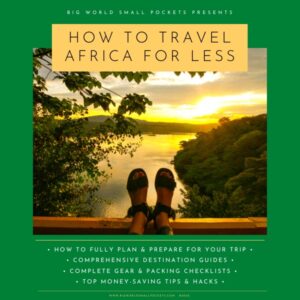
- Full Planning & Preparation Guides
- Detailed Destination Info
- Complete Packing & Gear Lists
- Top Money-Saving Tips & Hacks
Click Here to Check It Out!
What to wear as a female traveller in egypt.
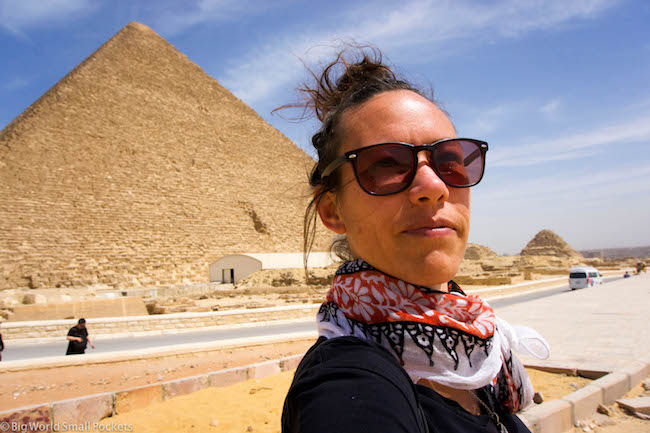
The general rule for female travellers when it comes to what to wear in Egypt is long pants and tops that don’t reveal your upper arms or chest, especially if you’re travelling alone.
At least this is true when travelling the major cities and Nile area of the country – the coast is slightly different and more relaxed in terms of dress code.
While no way near as conservative as other countries I’ve visited such as Sudan, Egypt is not as liberal as parts of Lebanon or Turkey either, so do beware that in mind.
Lying somewhere in the middle, female travellers in Egypt do not have to cover their heads, but I’d certainly advise only packing clothes that extend below the knee and that cover the shoulders or cleavage.
Having your arms exposed is ok (as long as your shoulders and chest are covered), but you may feel more comfortable wearing longer-sleeved garments that do cover your lower arms too.
Sarongs or thin scarves are a great option when travelling in Egypt as they are so versatile, compact and light. Sarongs or scarves can easily be draped over your head or shoulders too for extra coverage.
Evening wear certainly isn’t a must here – as a largely alcohol-free country (although it’s not illegal, few people in Egypt drink it and it’s very expensive), you’re unlikely to be going out or needing much specific evening attire, so that’s one thing you don’t have to worry about!
Ditto heavy make-up, which is not common here and will be a nightmare in the heat!
In terms of shoes, when it comes to what to wear in Egypt, I really do think you can limit yourself to 3 pairs – 1x comfy trainers / runners that can be used for any long sightseeing trips or travel days, 1 pair of good support sandals like Birkenstocks and perhaps some lowkey evening flats or pumps.
In my opinion, dress sandals, or anything with a heel, are definitely not required when travelling in this country.
For more specific ideas about exactly what to wear in Egypt, check out these sections below.
You can also download your own copy of my broader Middle East packing list (which also covers North Africa) by entering your details in the box below…
What to Wear when Sightseeing in Egypt?
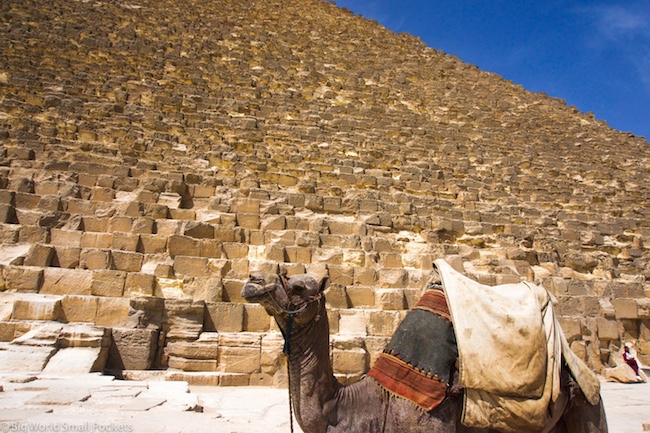
When it comes to sightseeing in Egypt, especially around any of the temples, you’ll want to make sure you’re fairly covered up – not only for cultural reasons, but also to protect yourself from the sun as, needless to say, the UV rays in Egypt can be fierce!
A long skirt or thin, ankle-length trousers will be perfect for sightseeing in this country as they’ll allow you to stay fairly cool.
They also provide some warmth when you go into any temples or pyramids, which can actually be pretty cold inside.
I’d advise a thin, long-sleeved bamboo or cotton top for the top half, so that you can ensure your chest and upper arms are covered.
Something loose and comfortable will help you stay comfortable and cool, because you don’t want to be fiddling around constantly with clothing in the heat when you’re trying to sightsee.
Ladies, I’d also take a thin scarf or sarong with you when sightseeing, so that this can be placed over your head if you’re visiting any religious sights.
Sunglasses, a good sunhat and some sunscreen are also top items and I highly recommend bringing a good daypack you can put them all in and carry easily throughout your sightseeing time in Egypt.
This Marmot Kompressor is ideal for the job as it packs down to nothing and is light, waterproof and comfortable.
And finally, you’ll also want to ensure you have some water with you for sightseeing days in Egypt and that you drink a lot to stay hydrated.
Rather than constantly buying plastic water bottles, I highly recommend you take a filter water bottle with you to Egypt, which will allow you to drink the tap water here (or anywhere in the world) safely.
An amazing piece of technology, I highly recommend Water-to-go bottles for the job.
And if you are looking for top sightseeing trips in Egypt, then check out these fantastic options .
What to Wear at the Coast in Egypt?
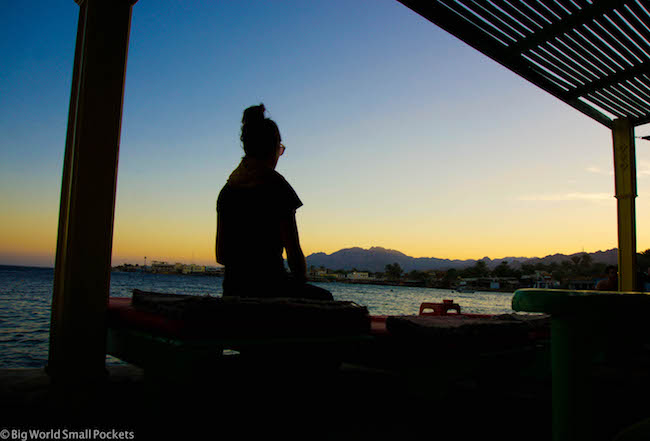
If you’re travelling to either Dahab, Sharm el Sheikh or Hurghada, you’ll find that dress codes are more relaxed than in other Egyptian destinations.
This means that coastal spots in this country are more chilled places to finish your trip and spend a few days relaxing.
With good temperatures and sandy beaches, you’ll definitely want to bring your swimwear and a towel to enjoy these spots.
Sunglasses, sun hats, sunscreen and sarongs are also a good idea.
Don’t forget a good book and your headphones too, and you may also want to bring a snorkel and mask set if you own one because, at the Red Sea, you’re on the edge of some of the best diving and snorkelling spots in the world, so don’t miss out!
And now I want to bring you a complete packing list for Egypt – a handy item-by-item guide so that you’re fully prepared and packed for your trip here.
Just enter your email address below and I'll send it to you for FREE!
Information will be sent to the email provided above
Clothes to Pack for Egypt
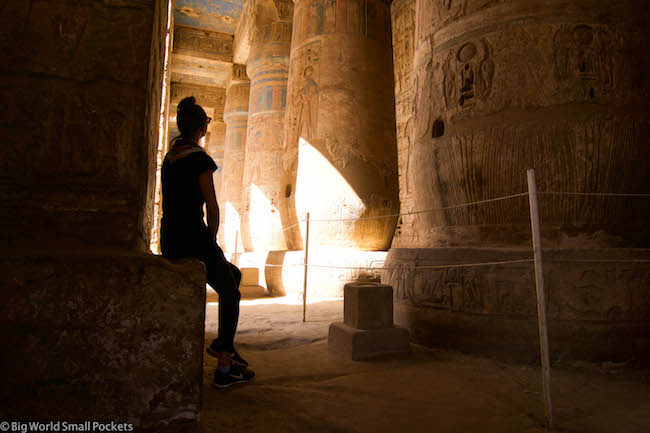
1 Thin Windproof Jacket
Egypt has a hot, dry climate, but at night it can get chilly if you’re out in the desert.
As such, I recommend taking a thin windproof jacket with you to this country – something light, compact but practical would be ideal and this North Face Venture 2 is perfect.
3 Thin Sweaters or Cotton Long-Sleeved Tops
Great for layering as, in certain parts of the country, you might not feel comfortable walking around with bare arms, which means some thin, light tops are crucial.
I always love a natural fibre long sleeve option to stop me sweating as much!
2 Cardigans / Denim Shirts
Helpful in the evening and /or if you want something a bit smarter during the day.
I’m loving the denim shirt look right now!
7 Singlets / T-Shirts
Choose a range of colours and styles that match the trousers / shorts you’ve selected.
I recommend loose ones that will keep you cool and aren’t too revealing.
T-shirts are best as they cover shoulders (good for avoiding sunburn), or go for my ventilation tactic, which is a singlet with a thin scarf or sarong draped around the shoulders.
7 is a good number of tops as it means you have enough to survive without doing laundry for a week!
2 Jeans / Trousers
Great for going out in the evening or wandering around cities like Luxor and Cairo, you’re likely to feel very uncomfortable in anything short or revealing in Egypt (outside of the coastal regions), so long-legged pants are a must.
Just make sure they are thin and light!
2 Pair Leggings
One of my travel essentials full stop (not just in Egypt!), leggings are especially ideal when you’re exploring the temples and cities, because they are thin and breathable… if you get the right pair.
In fact, I strongly recommend bamboo fibre ones because they are breathable, hypoallergenic, soft, thin and compact down really easily.
In Egypt especially, leggings are good under a casual dress or tunic when you need to dress modestly and are comfy to wear on any long bus or train rides you might have to make.
1 Pair Shorts
Shorts are really only worn in Egypt by travellers at the coast, which is why I’ve suggested just 1 pair.
If you’re keen on a diving or snorkelling adventure, the Red Sea has some amazing opps and dress codes are certainly more relaxed here.
1 Summer Dress
Another great item for Egypt beach times and / or to pair over leggings in the cities.
Those who aren’t a fan of dresses, may wish to double up on the shorts here.
You can’t take enough sarongs travelling in my opinion. As they are so light, I recommend 2 as a minimum!
Perfect for using as a beach towel, a headscarf, a shoulder wrap, a bathrobe, a sheet, a laundry bag … the list goes on!
Check out my post about the 20 reasons why you should always take a sarong travelling for more ideas.
These ones from One World Sarongs have some beautiful designs.
Thin Scarves
Ideal if you’re wanting to visit any mosques and need to cover your head.
Also good to cover shoulders – see above in the T-Shirt / Singlet section for more info.
Small and compact, 8 pairs is a good number to save the hand washing duties!
Bras & Sports Bra
Make them comfortable ones in this heat!
Bikini / Swimwear
Well you need something to enjoy Egypt’s fabulous coast with that’s for sure.
I always love Rip Curl’s offering.
Most days you’ll probably be wearing sandals in Egypt, but this is for those exceptional days when you’ll wear trainers – like when travelling in planes, buses or trains.
You can always double up on your daywear here to save room if needs be!
Sun Hat & Sunglasses
Whether you want to bring a cap or a floppy, or a large designer number, the choice is yours.
Just make sure you bring a sun hat of some description because walking all day in cities or around temples in Egypt’s heat can be tough!
I love this one from Hello Sunshine .
Shoes to Pack
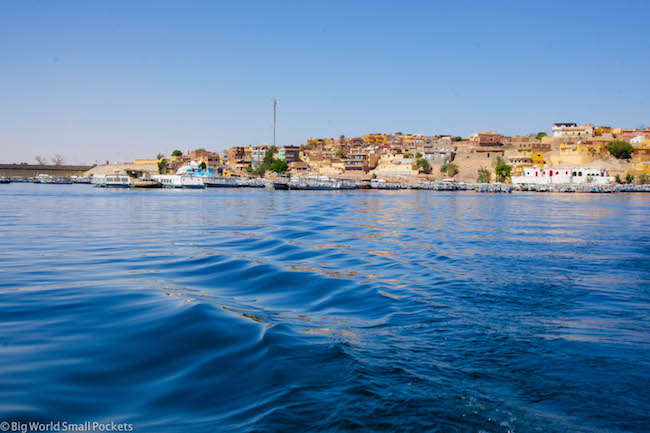
1 Pair Trainers / Runners
Versatile, comfortable and essential if you want to see all the sights in this epic country.
I highly recommend New Balance who create stylish city runners that you can still wear in the evening too.
1 Pair Flip Flops / Sandals
Personally, I love my Birkenstocks , which I basically lived in during my time throughout the Middle East and North Africa.
The support they offer means you can sightsee to your heart’s content and never get sore soles!
1 Pair Evening Flats
A great addition to any Egypt packing list if you want to go out for dinner at least a few times during your trip.
Toiletries to Pack
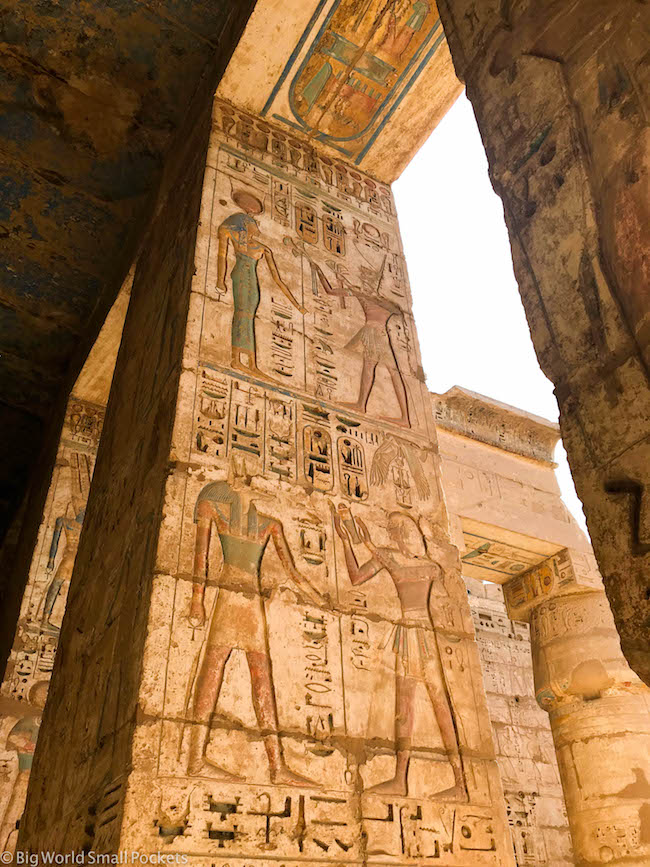
Thin Toiletries Bag
To hook or not to hook, that is the question!
Either way, just make sure it is light and thin.
This one is a great and affordable option.
Shampoo & Conditioner Bars
I always go for shampoo and conditioner bars when I travel to save the plastic and keep the space down!
Although they are a bit pricey, they last for ages.
Say goodbye to mid-travel spillages and bulky bottles people, this is the future!
I always pack a natural crystal deodorant when I travel as they last forever and are free from many nasty chemicals.
Antibacterial Soap
Keep your soap in a ziplock bag to prevent soap slime leaking on to everything you own!
Toothbrush, Toothpaste, Floss
Facial Wash, Toner, Serum, Moisturiser
Body Moisturiser
Cotton Buds / Pads
Hair Bands & Hair Brush
Glasses / Contact Lenses if you wear them
Razor & Spare Blades
Nail Scissors, Nail File & Tweezers
Medical / First Aid Bits to Pack
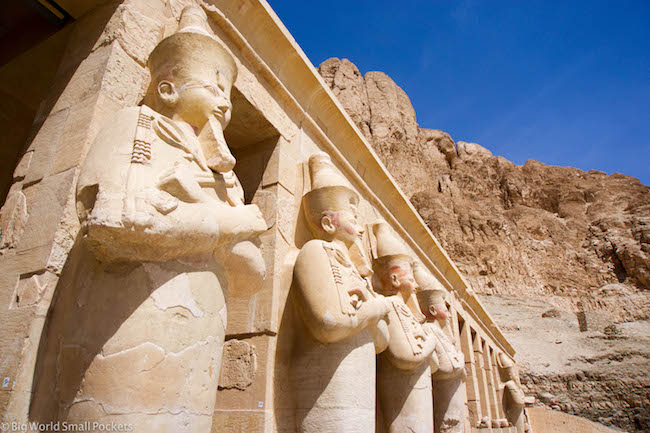
Natural Sunscreen
Choose a 30 SPF or higher for those helluva strong rays in Egypt and go natural if you can to keep the chemicals out of your skin.
This doubles as a great moisturiser, soother and aftersun.
SPF Lip Salve
Very important for those UV conditions in Egypt.
Natural Bug Repellent
See my post about how to make your own DEET-Free insect spray or else there are plenty of ready-made products on the market like this great one .
An ideal remedy for headaches, sore muscles and insect bites, tiger balm is a super versatile, travel essential for me!
Tea-Tree Essential Oil
A powerful antiseptic, anti-mould and anti-fungal treatment, tea-tree oil is also great to throw in with your washing, or you can use a few drops to freshen up smelly bags / laundry etc!
Get an organic tea-tree oil if you can.
Paracetamol, Antiseptic Cream, Antihistamines & Band Aids
The only medicine you need to take in my opinion!
There’s so many pharmacies in this country you’ll be able to get almost anything you need there anyway!
Menstrual Cup
The best way to deal with your time of the month when travelling ladies.
Check out the best prices for them here .
Electrical Items to Pack
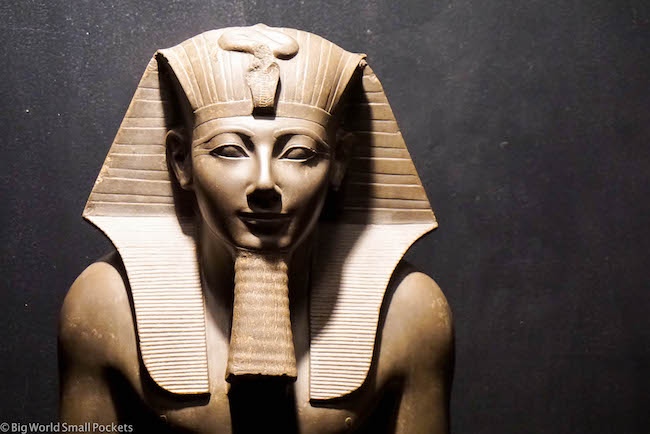
Smartphone & Headphones
Taking your smartphone to stay in touch with those at home, check maps, book activities and upload some pics while you’re in Egypt is a great idea.
I’d also download some audiobooks and music onto your phone before you leave home – a good shout for travel days.
I recommend Amazon Audible and Spotify Premium for these purposes and wouldn’t travel anywhere without either these days.
Portable Charger
Portable chargers are great when travelling without a solidly reliable charging source, like in Egypt, where power cuts can be a regular occurrence!
I recommend the Anker PowerCore which allows me to charge both my phone and my camera – BOOM!
Camera, Lens, Spare Battery & Charger
I love my Sony A600 mirrorless camera , which I’ve used across North Africa and beyond.
Light, compact and sturdy, it’s perfect for travelling.
I’d also recommend a GoPro for Egypt if you want to capture some of that Red Sea underwater action.
Memory Cards
Take a large memory card if possible – like this 64GB one .
Might not be a bad idea to double up in case you lose it or fill it up.
High-speed memory cards are also a good idea for snappier processing times.
How are you going to charge your devices without an adapter?!
Egypt has the same type of plugs as continental Europe, so get a cheap adapter here .
Otherwise, you can splash out on a worldwide adapter – better value if you’re travelling elsewhere after North Africa or anytime in the future.
Headlamp & Spare Batteries
Never travel in Africa without a headlamp and try to choose a product that uses commonly found batteries and has a red night light function.
I love my Black Diamond Storm , which has served me well during my time across Africa.. and the globe!
A VPN service is a must for me when I travel, especially in high-risk countries.
I love NORD VPN who offer a huge number of global servers for a quick and seamless connection.
Documents to Remember
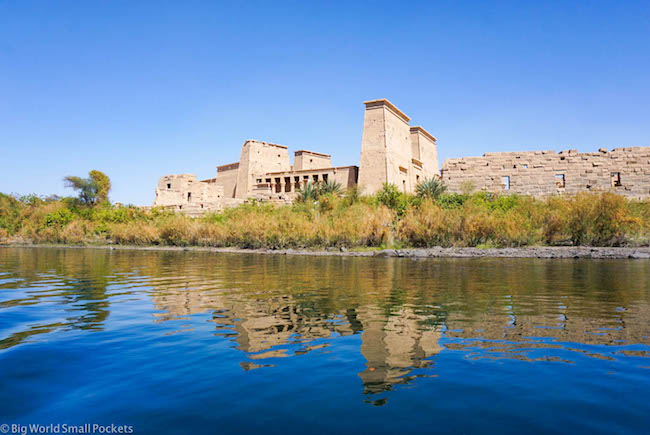
Passport & Photocopies
Definitely take a colour copy of your passport with you to Egypt and keep it with you at all times.
There are multiple checkpoints across the country and it’s necessary to have at least a copy of your passport with you if you get stopped.
Flight Tickets & Visa Documentation
Many nationalities can get free tourist visas for Egypt on arrival – hoorah!
Do check with your embassy before travelling however.
Immunisation Documentation
Always good to have with you wherever you travel.
Travel Insurance
Alternatively, if you’re a long-term traveller, digital nomad or frequent remote worker seeking travel health cover, check out Safetywing’s Nomad Insurance policies.
Credit Cards and Debit Cards
ATMs in Egypt are plentiful and accept both Mastercard and Visa.
They tend to dish out both USD and Egyptian Pounds (LE).
When it comes to using ATMs, or paying for things in Egypt generally, you want to ensure you’re not being charged overseas transaction fees or getting poor exchange rates, which is why I always take my Wise Card away with me wherever I travel.
The easy way to spend abroad with real exchange rates, no markups and no sneaky transaction fees, you can use your Wise card just like a debit card in Egypt… and it links easily with Google and Apple pay – sold!
Get yours here .
Cash in Small, Thin Purse
Bring US Dollars with you – they are most easily exchanged in Egypt.
And Don’t Forget…
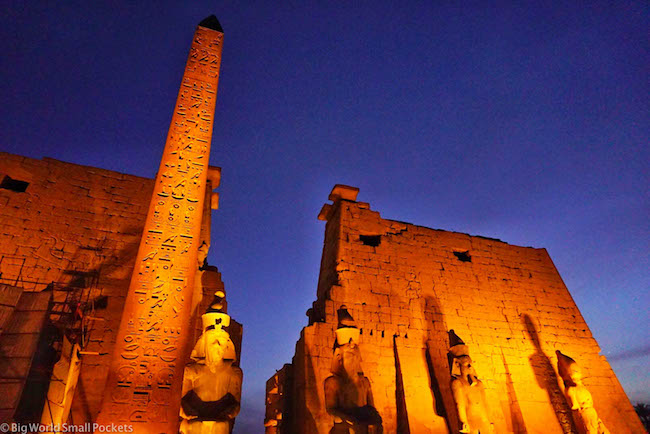
Large Backpack
This whole packing list should fit into a 40l backpack – I never travel with anything bigger and love this great example from Berghaus .
Travel Towel
I recommend Latrek travel towels, because they are cheap, compact, soft and don’t smell.
Love, love, love mine!
Read my review here .
Good for sightseeing and beach days, this one from PacSafe is perfect.
Combination Padlock
Very useful for locking up bags and valuables when staying in hostels, these don’t have to be expensive, just reliable!
Eye Mask & Earplugs
Key for sleeping on overnight train journeys and in hotels in Egypt.
This eye mask from Alaska Bear is super comfy and a great travel treat.
Filter Water Bottle
Amazing pieces of tech, filter water bottles allow you to drink tap water anywhere in the world safely.
My go-to brand are Water-to-go bottles , which are inexpensive, but very reliable and will allow you to drink Egypt’s non-potable tap water without any problems.
These great bottles also help prevent more unnecessary plastic waste from polluting our planet – double win!
Travel Handwash
Great for doing emergency washing such as underwear in a sink, travel handwash is always a must when I adventure anywhere.
SAVE IT TO PINTEREST!
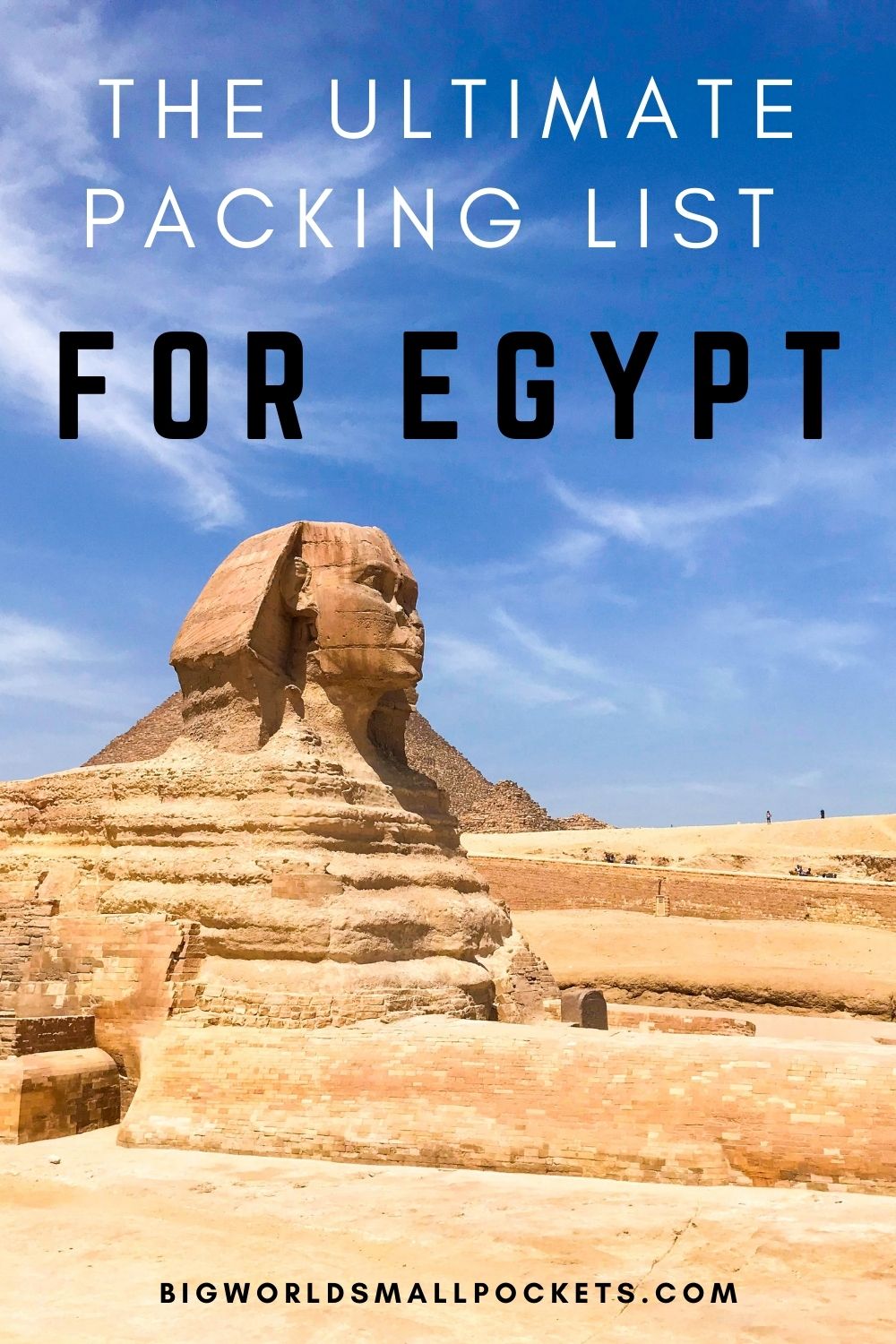
So that’s it, my complete Egypt packing list.
Have you been to this gem of a country?
What else did you pack that I might have missed?
Please let me know in the comments box below…
Creator of Big World Small Pockets, Stephanie Parker is a travel addict! Originally from Jersey in the Channel Islands, Stephanie adventures the world collecting tips, advice and stories, to share with a smile
Leave a Reply Cancel reply
Your email address will not be published. Required fields are marked *
This site uses Akismet to reduce spam. Learn how your comment data is processed .
Thank you for visiting nature.com. You are using a browser version with limited support for CSS. To obtain the best experience, we recommend you use a more up to date browser (or turn off compatibility mode in Internet Explorer). In the meantime, to ensure continued support, we are displaying the site without styles and JavaScript.
- View all journals
- My Account Login
- Explore content
- About the journal
- Publish with us
- Sign up for alerts
- Open access
- Published: 23 July 2021
Past and future trends of Egypt’s water consumption and its sources
- Catherine A. Nikiel ORCID: orcid.org/0000-0001-9785-7497 1 &
- Elfatih A. B. Eltahir ORCID: orcid.org/0000-0002-6148-7997 1
Nature Communications volume 12 , Article number: 4508 ( 2021 ) Cite this article
27k Accesses
34 Citations
74 Altmetric
Metrics details
- Socioeconomic scenarios
- Sustainability
For millennia the Nile supplied Egypt with more water than needed. As the population grew and the economy expanded, demand on water increased accordingly. Here, we present a comprehensive analysis to reconstruct how total demand on water outstripped supply of the Nile water in the late 1970s, starting from a surplus of about 20 km 3 per year in the 1960s leading to a deficit of about 40 km 3 per year by the late 2010s. The gap is satisfied by import of virtual water. The role of economic growth in driving per capita demand on water is quantified based on detailed analysis of water use by agriculture and other sectors. We develop and test an empirical model of water demand in Egypt that relates demand on water to growth rates in the economy and population. Looking forward, we project that within this decade of the 2020 s, under nominal scenarios of population and economic growth, Egypt is likely to import more virtual water than the water supplied by the Nile, bringing into question the historical characterization of Egypt as “the gift of the Nile”.
Similar content being viewed by others
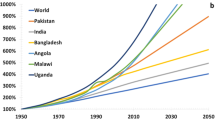
Reassessing the projections of the World Water Development Report

New water accounting reveals why the Colorado River no longer reaches the sea
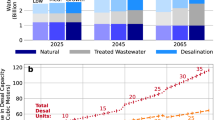
Effects of population growth on Israel’s demand for desalinated water
Introduction.
“The Egypt to which the Hellenes come in ships is a land which has been won by the Egyptians as an addition, and that it is a gift of the [Nile].” (Herodotus Book 2:5) 1 .
Following expansion of the Sahara Desert, thousands of years ago, and migration of native populations to shelter in the Nile Valley, an intimate relationship developed between an emerging Egypt and the Nile. This connection has manifested in historical, political, ecological, and hydrological dimensions. However, Egypt’s fast-growing population and developing economy have strained already scarce water resources through dietary changes and municipal and industrial consumption. Egypt is facing external pressures on perceived water rights, limited national water resource availability, and a struggle to fashion a sustainable development vision for its future. The current policies regarding irrigation in the New Lands, the current rate of water reuse, and the level of success achieved in reducing fertility rates will not be enough to close the demand gap in the future 2 .
Egypt’s population has been growing rapidly in recent decades, at a rate of 2.1% annually from 1989 to 2018 3 , following a similar trajectory of world population growth (Fig. 1a ). This added population places pressure on limited water resources, both through direct consumption and through increased demand for food and other products. In 2017, the total renewable water resource per capita was 628 m 3 /yr already below the level for water scarcity according to the Falkenmark Index 4 , 5 . This pressure due to population growth, while straightforward, is essential to include while drawing the picture of historical and future demand for water, as Egypt faces increasing scarcity of natural resources.

a Egyptian population [red line] and world population [black line] from 1 to 2020 C.E 3 . (Supplementary Table 1.4 ). b Qualitative comparison of stable Nile Flood heights from 641 to 1451 [black line – left axis] 13 and decreasing modern yearly average discharge from Aswan Dam [red line – right axis] and flow at Dongola [blue line – right axis] 16 , 17 (Supplementary Tables 1.14 and 1.20 ). We note that the reader should not interpret a 1:1 correlation between the y-axes, and that the two separate groupings of data have been presented together to reflect that there has been little change in the Nile based on geologic survey 15 . c Gross Domestic Product (Constant 2010 $US) [black line] and GDP per Capita [red line] in Egypt 6 (Supplementary Table 1.6 ). d Relative change in per capita food supply (kg/capita/year) relative to 1961 for meat [red line], cereals [black line], and pulses (beans, chickpeas, lentils) [blue line]. 1961 values for meat, cereal, and pulses are 10.71, 161.43, and 6.5 kg/capita/yr respectively 7 (Supplementary Table 1.10 ).
Egypt has also experienced rapid economic growth since the mid 1950’s (Fig. 1c ). From 1989 to 2018, the Egyptian GDP grew at 4.4% annually, while GDP per capita grew at 2.3% annually over the same period 6 . This growth has been concurrent with an increase in water consumption for both municipal and agricultural purposes and an increase in both domestic production and imports of agricultural commodities. As GDP has grown, the diet of Egyptians has changed dramatically; increasing trade connections with other food producers have increased availability of some goods, particularly animal products (Fig. 1d ). The average per capita supply of proteins from animal origins increased by 39% from 18 g/cap/day in 1999–2001 to 25 g/cap/day in 2011–2013 7 . At the same time, the prevalence of undernourishment dropped by 0.7 to 4.5% 7 . Egypt currently ranks among the top countries globally in the daily per capita caloric supply (3522 kcal/capita/day), just behind the United States 8 . These trends are projected to continue, especially in meat consumption which has a strong relationship with GDP per capita 9 . The projected consumption of red meat in 2030 is 1,581,000 tonnes up from 2001 to 2017 average of 1,136,050 tonnes; the projected consumption of white meat is 1,681,000 tonnes up from 2011 to 2017 average of 1,054,740 tonnes 10 . However, calories coming from meat are still a small percentage of overall daily caloric intake, increasing from 2.4% to 3.5% from 1961 to 2013 11 .
At the same time, water supply from the Nile, which accounts for 98% of renewable water resources in Egypt, has remained relatively steady (Fig. 1b ) 12 . While detailed flow records do not exist prior to the installation of modern gauging systems (circa mid to late 1800’s), the Nile’s floods have been monitored and recorded for millennia. Records of flood heights from the Rhoda Nileometer show these levels remained relatively constant over the 800-year record 13 , 14 . Geologic research has suggested “very little downcutting [in the riverbed has occurred] in Nubia since [the time of the New Kingdom some 3000 years ago]” suggesting that flood heights across the full 700-year record are directly comparable 15 . In the modern record, flows recorded at Aswan and Dongola have been slightly decreasing, as a result of increased withdrawal of natural flows upstream from Sudan’s withdrawal of 4 km 3 in 1959 to current withdrawals of 13–16.7 km 3 (refs. 16 , 17 , 18 , 19 , 20 , 21 ).
In this work we identify and quantify actions that Egypt has taken over the past six decades to manage internal pressures on water resources. A detailed, long term picture of the changes in water demand and water use is constructed and used as a foundation to project demand on water in the near future, and further to propose solutions that can be explored towards more efficient water use. While much past work 22 , 23 , 24 , 25 , including governmental literature, has presented snapshots in time of water use and virtual water trade in Egypt, we use water and crop data to quantitatively describe in significant detail water use in Egypt, over a period of six decades. The key innovations of our study are in the detailed year-by-year reconstruction of trends in water use down to the individual crop level, the improved understanding of the factors that drive these trends, and the use of this context to project water demand into the near future based on empirical demand relationships. The detailed diagnosis of water use in Egypt facilitates identification of opportunities for water saving, water reuse, and improved water use efficiency in general.
Water in Egypt: historical and future
This paper focuses on historical and future trends in Egyptian water management: first, in the historical period, Egypt has managed water supply and demand through five avenues (Fig. 2 ): improving water infrastructure and management by building the High Aswan Dam; increasing in-country agricultural production through harvested area expansion and improving crop yields; expansion of water reuse; reducing population growth rate; and increasing import of agricultural products – especially staples such as wheat and maize. We integrate extensive data sets to rigorously document this historical adaptation process.

a Flow of the Nile at Aswan in monthly [black line] and yearly [red line] averages 16 (Supplementary Table 1.20 ). Blue squares represent the total storage capacity and marks the construction of the Aswan and High Aswan Dams 12 (Supplementary Table 1.19 ). b production (harvested tonnes) [dotted lines] and yield (production/area) [solid lines] of cereal [black], primary fruit [red], and primary vegetable [blue] crop groupings. 1961 production values are 5.0, 1.9, and 2.8 million tonnes respectively, and 1961 yield values are 29,057, 169,113, and 152,611 hg/ha respectively (Supplementary Table 1.7 ). c Estimated water available for reuse from direct agricultural drainage reuse, Nile Delta and Valley groundwater, and treated wastewater reuse. The error bars shown account for estimates of wastewater reuse in the absence of data for those years 22 , 23 , 25 , 51 . Sources for individual components in Supplementary Fig. 9 . The black dotted line shows the reuse timeseries used in analysis. d Total Fertility Rate (births/woman) plotted for Egypt [black line], Africa on average [blue line], and the world on average [red line] 29 (Supplementary Table 1.5 ). e Virtual water imports (km 3 ) of agricultural goods (primary and secondary crops and animal products) scaled to Egypt use equivalent (Supplementary Tables 1.1 , 1.2 , 1.3 , and 1.11 ).
Second, future population and economic growth will increase water demand dramatically and require Egypt to rely more heavily on virtual water imports, at a higher annual growth rate than we have seen in the past. The concept of virtual water, coined in the 1990’s by Dr. Tony Allan, was first applied to the Middle East and North Africa as a region that addressed water scarcity with importation 26 . We show through our own bottom-up reconstruction of water-use that Egypt’s demand for water passed the carrying capacity of the Nile in the late 1970’s and was importing the use equivalent of at least 40 km 3 of virtual water in the late 2010’s. Assuming persistence of the recent socioeconomic trends, we project that Egypt will import 61.5 km 3 /year during this decade of the 2020s. At that point Egypt will be importing more virtual water from abroad than they have been withdrawing from the Nile internally on average for the past 30 years. A comprehensive analysis framework is shown in the results and methods sections for reconstruction of past water uses and projection of future water demand leading to these conclusions.
Egypt’s response to increasing water demands
Rapid changes in demographic and economic factors in Egypt have spurred equally large responses in an attempt to control and manage water supply and demand. Egypt’s effort in the areas of controlling variability in the Nile water supply, agricultural productivity, water reuse, fertility rates, and food imports have been substantial. However, future pressures will require Egypt to intensify some of these measures and adopt new approaches.
Much of the work done by Egypt can be viewed as a transition through several water states. As we have seen in Fig. 1b , the Nile river was largely uncontrolled for most of its history. Agriculture, and Egyptian life in general was guided by the seasonal flood and drought cycles of the river and water still flowed freely into the Mediterranean Sea. This began to change in earnest when Egypt built the High Aswan Dam from 1960 to 1970; the initial filling curtailed the flow of the river, and the resulting reservoir with a total design capacity of 160 km 3 reduced interannual variability of flow, providing a steady and controlled supply of water to farms, which could now control the application of irrigation to fields while minimizing losses to the Mediterranean (Fig. 2a ) 27 . These decades also saw the advent of major use treaties. Through the 1959 Water Agreement between Sudan and Egypt, Egypt would be allocated 55.5 km 3 of the Nile water annually while Sudan was allocated 18.5 km 3 (ref. 20 ). When the treaty was established, Egypt was consuming 48 km 3 according to the agreement.
In the 1980’s Egypt began to experience an agricultural boom. This was achieved partly through expansion of agricultural area, especially on the edges of the Delta (dubbed the “New Lands”), and partly through yield increases in virtually every major crop (Fig. 2b ). Egypt ranks among the highest yield producers of many crops including wheat, maize, rice, and cotton 28 . While this increased water demand, a concurrent push to increase the reuse of water – from direct agricultural drainage, groundwater pumping, and wastewater reuse – made up for some of the increased consumption (Fig. 2c ).
At the same time, Egypt began a push towards reducing population growth, and reduced its total fertility rate by nearly half in thirty years, down to a rate of 3 births per woman in the late 2000’s (Fig. 2d ) 29 . This decrease has been much steeper than the fertility rate drops in Africa as a whole and on par with global fertility rate reductions.
Even with these adaptation measures, Egypt’s demand continued to rise at a time when it was at full utilization of available natural water resources. Consequently, the 1970’s were also the beginning of increases in agricultural imports, viewed here through the lens of their virtual water equivalent (Fig. 2e ). Import rate increased dramatically after 2000, and the cereal import dependency ratio has increased from 34% to 42% from 1999–2001 to 2011–2013 30 .
Reconstruction of historical Nile water use
We apply a bottom up, individual crop-based analysis of agricultural water use (see Methods section) to dissect water demand in Egypt, from in-country production and trade, and identify which crops dominate in-country water use over time (Fig. 3a ). This analysis is made possible by the extensive and influential work in water footprint accounting for agriculture at the global and regional scale 31 , 32 . Figure 3b shows the agricultural use estimates combined with other water demands (municipal, industrial, reuse), compared to the available Nile water flow into Egypt which encompasses all water not consumed upstream. Two major conclusions about Egypt’s water demand are clear from this comparison.

a Historical water application in Egypt for agriculture broken down by crop (Supplementary Tables 1.1 , 1.2 , and 1.7 ). b Historical total Nile water use (agriculture + municipal + industrial − reuse) [red dotted line] compared to available supply [black lines]. Red squares mark values for 1995, 2000, 2012, and 2017. This is the flow at Dongola station adjusted by evaporation at Lake Nasser and from other surface water bodies (estimated at 10 km 3 and 2 km 3 respectively) 2 , with added rainfall and primary groundwater abstraction (1.5 km 3 and 0.5 km 3 respectively) 12 , 52 . Storage change in Lake Nasser is not considered in this availability estimate. These are compared to the AQUASTAT numbers for freshwater withdrawal in Egypt [blue dots] 46 (Supplementary Table 1.16 ). Dark Gray shading represents the amount of Virtual Water Import (shown in Fig. 2e ), and light red shading shows the amount of drainage, wastewater reuse, and GW reuse (shown in Fig. 2c ). These shaded areas represent the additional demand met by these sources, and not a range of values.
First, Egypt began fully utilizing available local water resources in the late 1970’s and has only met total water demand through increasing virtual water imports (dark gray shading) and increasing reuse (light red shading). Increases in irrigation application efficiency, and to a greater extent water reuse, have improved the water productivity of major crops and allowed Egypt to survive on a relatively constant Nile water use in the past two decades (Supplementary Figs. 3–4 ).
Second, even after accounting for reuse utilization in Egypt (Fig. 2c ) we show that Egypt’s direct consumption of the Nile is roughly 61.5 km 3 on average from 1988 to 2017 (Fig. 3b ). This aligns closely with water accounting in the literature for the modern period 22 . Adding the environmental flow to the Mediterranean of ~2–4 km 3 (ref. 33 ), Egypt utilizes 8.0–10.0 km 3 more than the share of 55.5 km 3 allocated through the 1959 Nile Agreement between Egypt and Sudan 20 . This additional water comes partially from Sudan’s unconsumed share of 1.8–5.5 km 3 out of the 18.5 km 3 enumerated in the 1959 Agreement 23 , and partially from increases in the Nile flow of ~5–6 km 3 (refs. 17 , 34 , 35 ). An accounting of Sudan’s historical use of the Nile water is beyond the scope of this Egypt centric study but is reported to be 13–16.7 km 3 /year 18 , 19 , 21 . Much of the increased water demand in Egypt has been met by virtual water imports, which reached 40 km 3 in the 2010’s (Fig. 2e ), a figure supported by other studies that quantified historical virtual water trade 22 , 35 , 36 .
Virtual water import is calculated identically to in-country use which is detailed in the Methods section. A comparison of the Egyptian Nile water system for 1988–1995 and 2010–2017 is presented in Fig. 4 to further document the evolving dynamics of water supply and demand in Egypt. This schematic relies on several independent sources of data where each flux is uncertain, and hence it does not necessarily satisfy strict water balance. A notable feature is the difference in evaporation from Lake Nasser between the two periods which arises from a 1000 km 2 difference in lake area (roughly 30%). (Supplementary Tables 1.15 and 1.17 ).
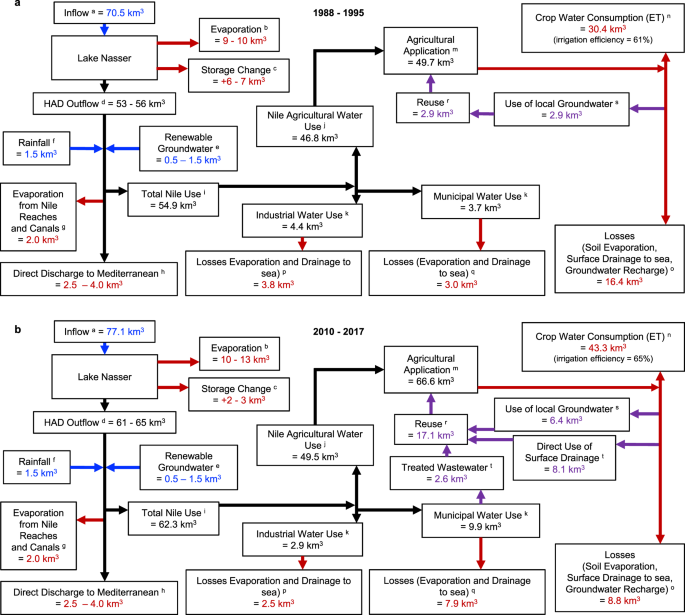
a Egyptian Nile water system 1988–1995 average annual fluxes (km 3 /year). Red values are sinks, blue are sources, and purple indicates reuse. b Same as panel a but for the period 2010–2017. A figure for the average fluxes from 1988 to 2017 can be seen in Supplementary Fig. 16 . a. Average annual inflow at Dongola. (Supplementary Table 1.14 ). b. Average annual Evaporation from Lake Nasser, 10 km 3 from literature 2 and outer bound calculated using Lake Nasser height (Supplementary Table 1.17 ), Height–Volume equation (Supplementary Table 1.15 ), and CRUTS4.04 Potential Evapotranspiration (Supplementary Table 1.13 ). c. Average annual storage change calculated using Lake Nasser height (Supplementary Table 1.17 and Height–Volume equation (Supplementary Table 1.15 ). d. Average annual outflow calculated through water balance of (a)–(b–c). Range of values reflect uncertainty in Lake Nasser balance components. e. AQUASTAT 12 . f. Abdel-Shafy et al., 2010 52 . g. Calculated through estimation of surface area and evaporation rate. Confirmed in refs. 22 , 25 . h. Hamza, 2006 33 . i. Calculated through methodology described in Methods section. j. (m)–(r). k. AQUASTAT Database 44 (see Supplementary Fig. 9 ). m. (n) × Irrigation Application Efficiency (see Supplementary Fig. 5 ). n. Calculated from production and water consumption data as described in Methods section. o. (m)–(n)–(t)–(u). p. (k) × 0.86. Loss rate from Omar and Moussa, 2016 36 . q. (l) × 0.80. Loss rate from Omar and Moussa, 2016 36 . r. (s) + (t) + (u). See Supplementary Fig. 9. s. Refs. 5 , 51 , 53 , 54 . t. AQUASTAT Database 44 . (Supplementary Table 1.16 ).
Projections of future water demand
Historical analysis has shown that Egypt is fully utilizing the available resources of the Nile River and yet is facing increasing internal and external pressures that will raise water demand and decrease availability of water. As detailed in the Methods section we develop an empirical model of historical and future water demand in Egypt with population growth and economic growth as inputs. Assuming a range of economic and population scenarios (Supplementary Fig. 11 ), and the empirical relationships between demand for crops and economic growth (Supplementary Fig. 1 ), we project future water demand for Egypt.
In keeping with our discussion about Egypt’s characterization as the gift of the Nile, we project when Egypt’s imports of virtual water will reach 61.5 km 3 (the 30-year average Nile water use for all purposes, accounting for both reuse and application losses), driven by an increase in demand that must be met externally (Fig. 5a ). For scenarios that assume population and economic growth rates close to the growth rates over the past 30 years, this important benchmark will be reached in this decade of the 2020s.
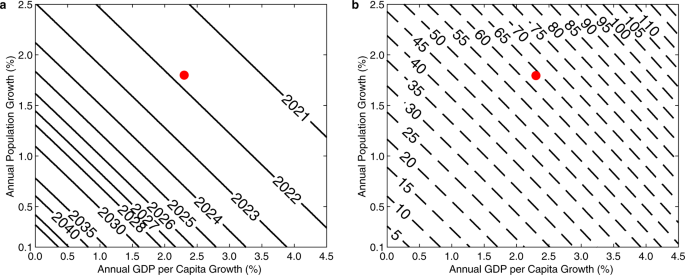
a Projected Year that Virtual Water Imports will Reach 61.5 km 3 with population increase and GDP per capita increase. Future increases in demand are added to the Hindcast (model) estimate of total demand minus total estimated Nile use. The red dot marks the nominal scenario of 1.7% population growth and 2.3% GDP per capita growth. b Additional virtual water (km 3 ) needed in 2030 to satisfy increased demand (i.e. projected virtual water Imports in 2030 values minus 2017 virtual water import amount). The red dot marks the nominal scenario of 1.7% population growth and 2.3% GDP per capita growth.
By 2030 the projected trend corresponds to a significant increase in virtual water imports in most population and economic growth scenarios (Fig. 5b ). To visualize this process along one growth trajectory, we show the projected virtual water imports for a nominal scenario with a GDP per capita growth rate that matches the 1988–2017 average (2.3%) and a population growth rate that matches the UN Medium Variant population projection in 2035 (1.7%) (Fig. 6a ). This is paired with increased demand in the municipal sector, which will need to be met by reallocating internal resources. The rate of increase of virtual water goes up over time (dotted black line) due to the compounding nature of the population and economic growths, as more people enjoy higher consumption rates per capita.

a Additional Virtual Water Demand (km 3 ) [blue line] and Annual Increase Rate (km 3 ) [black dotted line] for a nominal growth scenario (1.7% population growth, 2.3% GDP per capita growth) versus 2017 levels. Light blue shading represents the increased municipal water demand. Gray shading represents the additional virtual water imports in a 0% GDP growth, 1.7% population growth scenario. b Historical hindcast of total water use paired with the nominal projections of total water needed in panel a . The blue dotted line shows the total hindcasted water use, including efficiency scaled total agricultural demand, municipal use and industrial use, and reuse. This is compared to the sum of historical virtual water imports [blue shading] and the total Nile use estimate [red dashed line] and is shown as the solid blue line. Future projections are divided between in-country consumption [red dashed line] and increased virtual water demand [area between red dashed line and blue dashed line]. Future Projected Total Water Demand is shown by blue dashed line. Red squares mark total Nile use estimate for 1995, 2000, 2012, and 2017.
We apply the same demand relationships (Methods) to hindcast the historical water demand using data on population and GDP per capita data. As expected, the hindcasted water demand is close to the sum of the in-country Nile water use (which also accounts for municipal and industrial use and the water reclaimed from reuse) and virtual water import, which together meet the historical demand (Fig. 6b ). The future projection is less linear than the historical hindcast, mainly because the hindcast accounts for increasing reuse, which bends the demand curve downwards at an increasing rate in the early 2000’s. The future projection assumes the rate of reuse to be constant post-2017. This is further evidence of the importance of improving irrigation application efficiency. Uncertainty in the projections of future imports of virtual water are discussed in Supplementary Note 1 .
Egypt’s responses to increasing water demand in the past have demonstrated the severity of the water scarcity situation, and historical adaptations to rising demand on water will need to continue and strengthen. Efforts targeting an increase in productivity of agriculture should pivot to recognizing and leveraging the true value of water as a limited resource through a robust water pricing system 37 . As virtual water imports increase, smart management of agricultural export and import portfolios can leverage Egypt’s high agricultural yields and amplify their share of natural water resources through the export of high value, high water efficiency crops (fruits and vegetables) and the import of low value, low water efficiency crops (grains). Inter-basin connectivity will be key in the future and using these relationships to import water-intensive commodities like meat can allow allocation of water elsewhere 38 . Finally, studies have shown that a high rate of population growth is one of the most important factors in worsening future water deficits 35 , and further reducing rates of growth through proven methods like healthcare expansion and education 39 will slow decreases in per capita water share, a key metric of water scarcity. No single solution will be able to compensate for all additional needs.
Increased industrial demand for water will come with economic growth and diversification, and tourism and urbanization will drive municipal demand. As Egypt’s neighbors grow alongside Egypt, they have already begun to exert new pressures. This is especially important with the imminent completion and filling of the Grand Ethiopian Renaissance Dam (GERD). The effect of the GERD was not quantitatively included in our analysis, but is acknowledged as an additional potential stressor, especially with regards to increased upstream withdrawals 21 , 40 .
Demand and supply of water will also be affected by climate change, although we do not analyze those changes in this study. At a large scale, while climate change will result in small increases in the mean flow of the river, it will increase interannual variability of flow and increase the need for additional storage 34 . Sea level rise and saltwater intrusion are already a threat to freshwater resources in the Nile Delta and will further affect the potability of water for agricultural and municipal purposes 41 , 42 . Increased temperatures will affect both agricultural productivity and crop suitability, and also increase rates of evaporation from surface water and the field 43 . Optimizing ecological suitability and irrigation systems is crucial for being able to adapt to future changes more easily.
In the framing of this study, we posed the question of whether Egypt will continue to be the gift of the Nile. Historically and culturally the two are synonymous, and Egypt was, is, and will continue to be dependent on the resources the Nile provides. However, historical reconstruction and future projections show that the level of dependence has been and must continue to change. In the near future, Egypt will be dependent on external virtual water to the same level as its level of dependence on the River, and policies and attitudes will need to reflect and adapt to this new reality. Through the reconstruction of Egypt’s water demand we have shown here that Egypt is approaching a threshold between the Nile as a dominant force in sustaining Egypt’s growth and existence, and a new paradigm characterized by an equally important role for basin and global interconnection and cooperation.
Our results illustrate that the future of water in Egypt is just as reliant on external cooperation with its neighbors as it is on its own ability to optimally manage internal demand and use of water. Adaptations are ultimately in Egypt’s best interest, as they allow for continued growth and prosperity with more careful management of resources. Egypt has the chance to be an example for other developing water scarce nations, and a leader in the Nile Basin. If changes are not made it will soon serve as an ecological cautionary tale with implications for the entire region.
Terminology
In this study water use is used to define the water taken from the Nile. Total Use is defined as the water withdrawn for Industrial, municipal, and agricultural purposes. This use is added to reuse in order to determine the total demand for water in the country. In the case of agricultural use, crop water consumption is scaled by irrigation application efficiency, and then reuse is accounted for. Water consumption is based solely on the crop ET water requirement numbers taken from the literature. Our definition of total Nile water use aligns with the AQUASTAT definition of freshwater withdrawal, which is the total withdrawal less desalination, direct use of treated municipal wastewater, and direct use of agricultural drainage water. Our estimate counts subsequent pumping of local groundwater recharge as a reuse component, which is not the case in the AQUASTAT totals.
All data sources used can be found in Supplementary Table 1 . Agricultural and trade data used in this study comes from the Food and Agriculture Organization of the United Nations and is augmented by population and economic data from the World Bank and United Nations Population Division of the Department of Economic and Social Affairs. Water use numbers for available years are obtained from AQUASTAT, a division of the FAO.
The bottom-up analysis focuses on a group of crops that are selected with the goal of including the most significant water consumers. The primary agricultural crops considered in the analysis are wheat, maize, rice, seed cotton, sugarcane, sugar beet, banana, barley, broad beans, berseem, grape, groundnut, olive, onion, orange, potato, sorghum, tomato, dry beans, chickpea, lentils, green beans, lemons and limes, apples, mango, dates, watermelon, tea, sunflower seeds, garlic, strawberry, artichoke, cabbage, carrots & turnips, cauliflower & broccoli, chili pepper (green), cucumber, eggplant, melons, nectarines & peaches, pumpkins & squash, sweet potato, tangerine, vegetables fresh and leguminous (n.e.s.), and soybean. The grouping Fruits & Vegetables include Banana, Orange, Tomato, Potato, Onion, Olive, Lemons & Limes, Apple, Watermelon, Mango, Strawberry, Artichoke, Cabbage, Carrots & Turnips, Cauliflower & Broccoli, Green Chili Peppers, Cucumber, Eggplant, Melons, Peaches & Nectarine, Pumpkin & Squash, Sweet Potato, Tangerine, and other Vegetables Fresh & Leguminous n.e.s. Production, imports and exports focused on the primary commodity (i.e. no juices and processed forms) except when noted below. Secondary crops include cottonseed oil, maize oil, palm oil, raw sugar, molasses, cotton lint, cottonseed cake, sunflower seed cake, and soybean cake. Animal Products include beef, buffalo, sheep, chicken, milk (dried, whole fresh, whole skim), butter (cow & buffalo), eggs (hen in shell), and cheese (buffalo, whole cow, skim cow).
Per capita demand relationships developed for the period 1975-2014 with GDP per capita can be seen in Supplementary Fig. 1 for each individual crop. Only primary products are considered in production (in country) water use numbers for the historical period, to avoid double counting of feed and meat products. In the demand model used to project both future demand and create the historical hindcast, primary product demand is taken as the production and import quantity less the export quantity. Several of the crop products considered are traded primarily in their secondary form. When considering crop production, sugarcane, sugar beet, and seed cotton were used. The secondary products sugar (raw equivalent), molasses, and cotton lint were used in terms of trade demand (imports minus exports). Therefore, products that are primarily exported are already accounted for in the production of the primary crop. Additionally, some crops have demand relationships that are heavily influence by policy decisions – berseem, cotton, and sugarcane–and use a time-based relationship rather than one based on GDP per capita. All estimates of crop water consumption (historical production, historical imports, historical hindcast, and future projections) are scaled by irrigation application efficiency in order to simulate the Egypt equivalent use needed in order to meet the demand for those crops. Therefore, empirical and model-based estimates are consistent.
FAO data was available from 1961 to 2013 for most commodities, and available to 2017 in many cases. In the event that data was not available for the full period, the nearest recorded value to that date was used, and extrapolated outwards to ensure full period coverage for analysis. 2013 values were extrapolated to 2017 for cottonseed cake, soybean cake, sunflower seed cake, and artichoke imports. Berseem area, yield, and production values for 1978 are used for 1961–1977 and 2007 values are used for 2008–2017. Strawberry area, yield, and production values for 1980 are used for 1961–1979. Soybean area, yield, and production values for 1972 are used for 1961–1971. Sugar beet area and yield for 1979 were used for 1961–1978. Sunflower seed area, yield, and production values for 1971 were used for 1961–1970, and sunflower cake data from 1995 was used from 1961 to 1994. 2014 data was expanded to 2017 for Buffalo butter, Cow Butter production, buffalo cheese, skim cow cheese, whole cow cheese production, skim cow milk production, and eggs (hen in shell). Import and Export data for skim cow milk was filled with zeros prior to 1994. Finally large amounts of missing import data was replaced with zeros: pre-2000 for cabbages, all data except 2014/2016 for carrots and turnips, pre-1996 and post 2014 for cauliflower and broccoli, everywhere except 2013–2016 for chili peppers (green), pre-1993 for garlic, 1961–1999 for strawberries, pre-1997 and post-2013 for cucumber, everywhere except 2015 for eggplant, pre- 2005 for melons, in 2014 and 2016 for sweet potato and tangerine and in 2016–2017 for fresh vegetables (n.e.s.). For 2014–2017, food supply data was filled in using the New Food Balances data where available. This may cause slight inconsistencies due to differences in classification or calculation method. Beyond this extrapolation of data to ensure consistent availability of data between commodities, all publicly available data was integrated into the analysis, including FAO estimates. No data was removed due to flagging by the FAO as being an estimation or reconstruction based on a secondary source. Production, yield, and harvested area data for primary crops can be seen in Supplementary Fig. 2 .
Water use numbers
Overall water use numbers for Egypt have low independence between sources and are often available for only a handful of years in the last several decades. Most of the official numbers provided are dictated by the bounds established in the 1959 agreement between Egypt and Sudan where the former was allocated 55.5 km 3 /yr and the latter was allocated 18.5 km 3 /yr. According to flow measurements at Dongola, near the Sudan-Egypt border, the 30-year average flow (1988–2017) was 74.7 km 3 /year. All sources of water except desalination are included in our analysis. Municipal use, industrial use, and reuse values are interpolated and extrapolated from available data and literature values (Supplementary Fig. 9 ). So far, the increase in per capita water usage seems to have tracked closely with increases in per capita GDP. This growth may have also been driven by the increase in city population. The percentage of the population living in cities decreased from 42.8% in 1995 to 42.7% in 2017 (United Nations), however, because of the increase in population this means that in 2017, roughly 14.5 million more people lived in urban areas compared to 1995. We do assume though that per capita municipal consumption will remain constant in the future at roughly 112 m 3 /capita/year (305.4 liters/capita/day) 44 . A projection of municipal water demand for a range of population projections used in this analysis can be found in the Supplementary Fig. 12 .
Crop water numbers
Crop ET requirement numbers were taken from a single source for consistency and because they were specific to Egypt and the use of irrigated water 45 , 46 . For commodities that are traded in substantial amounts but not grown in Egypt (e.g. tea), a blue water number taking into account the source of the imports was used 47 . This study is concerned with irrigated water from the Nile and therefore uses only blue water numbers, which refer to the amount of surface and groundwater consumed 45 . In general, the numbers align with the water requirement numbers collected from the FAO which are given in terms of irrigation requirement 48 . Difference likely arise because FAO numbers are non-region or cultivar specific. We use in-country water consumption numbers for all crops and animal products, even when we are exploring virtual water and trade, as we are interested in the magnitude of water that trade replaces and what would otherwise be in-country production and consumption of water. Berseem water use numbers are not available from the same source and are taken from a study on evapotranspiration needs of berseem in northern India, a location at roughly the same latitude and average PET during the growing season 49 . This number is taken as the 2007–2011 average and scaled in the same manner as other crop water requirements discussed below.
In order to determine the water use requirements of different crops through time, we are aware that water application is a factor in determining yield. However, yield growth is also influenced by fertilizer application, climate, seed variety, soil salinity, and other management and ecological characteristics. In order to develop a realistic water requirement function, we use the 1996–2005 average crop ET water requirement from the literature 45 and the available FAO data on production, area harvested, and yield. Two scenarios for Nile water consumption for historical crop production were devised, both based on the literature value for crop specific, Egypt specific water consumption and the 1996–2005 averages of production and harvested area. The first is an estimate using a constant m 3 /ha for each crop, and the second uses a constant m 3 /tonne value. These estimates, scaled for irrigation application efficiency, can be seen as the blue and red lines in Supplementary Fig. 6 . In order to account for factors such as increasing yield and increasing water application, as well as the other yield influencing factors above, we settle on a m 3 /tonne water consumption requirement that equates to the average of these two estimates. This can be seen as the black line in Supplementary Fig. 6 . It is important to note that we assume all crops receive exactly their water requirement in any given year. Per tonne water requirements for secondary commodities remain constant due to the absence of comparable yield and area data and use the 1996–2005 average water requirement throughout.
Historical reconstruction assumptions
We apply a bottom up, individual crop-based estimate of agricultural water consumption and virtual water trade, using the assumptions covered above. This empirical reconstruction of water use is completely independent from official use estimates, and depends only on agricultural data, the physiologically based estimates of water requirement, and an estimation of irrigation application efficiency based on the use of different irrigation technologies. A comparison to AQUASTAT agricultural withdrawal figures adjusted with reuse estimates can be seen in Supplementary Fig. 6 .
Adjustments must be made to account for system losses between withdrawal of water from the Nile and field application, known as irrigation application efficiency (water use efficiency at the field scale). This irrigation application efficiency is calculated using proportions of irrigation type and the attributed efficiencies of the technologies 50 . The curve of irrigation application efficiency moves from roughly 61% in the 1960’s to 66% in the mid 2010’s and can be seen in Supplementary Fig. 5 . This loss rate is consistent with figures given in the literature 35 . As seen by these low efficiencies, and the small progress made in improving them in the last 50 years, the main true loss in the system is soil evaporation at the field scale.
Future projection assumptions
Future projections for water demand are made starting in 2017 and shown in this study until 2035. The main assumption in the projections is that all additional demand, which is driven by population increase and GDP per capita increase, will need to be satisfied through imports as Egypt is at its in-country production limit already.
There are two drivers of growth: population increase adds a full person’s worth of demand, and economic growth adds marginal demand to existing populations. The range of population projections considered in the future scenarios span from 0.1% to 2.5% annual growth and encompass the range of growth scenarios given by the United Nations 3 , and the 30-year historical rate falls in this range as well. Similarly, the economic range of scenarios considered was 0.1–4.5% annual growth, which also contained the historical 30-year growth rate. In order to present a single likely scenario to focus on when interpreting the projections, we highlight a nominal scenario. This scenario reflects 2.3% GDP per capita growth to match the last 30 years, and 1.7% population growth to match the UN Medium Variant Projection by 2035 3 .
In order to anchor the future projection and also make it compatible with the hindcast reconstruction, all future values were calculated as additional values versus 2017 levels.
Extrapolation of future demand for water is done through a historical linear regression of GDP per capita and demand or trade demand depending on the commodity from 1975 to 2014. No upper limit is imposed on the estimates of demand. We also hold berseem, seed cotton, and sugarcane per capita demand constant in the future to account for demand changes that are policy rather than growth driven, and to avoid combining an increased demand for meat from out of country and forage crops. The total tonnage demand of these crops will still increase due to population growth. As with historical imports, the water value given is in terms of an Egypt equivalent use by scaling with irrigation application efficiency.
Future projections include water demand coming from agricultural goods, as well as from increased municipal use. Industrial use and reuse were not extrapolated and were held at 2017 levels, since they are influenced more strongly by policy and other drivers not considered in this analysis. To maintain the scaling performed in the historical analysis, future water requirement numbers for individual commodities are the 2012–2017 average water requirement values.
Data availability
All data used in this analysis is publicly available at the locations listed in Supplementary Table 1 , with the exception of new streamflow data at Dongola. Dongola streamflow data (1890-2020) used in this study are available from the corresponding author upon reasonable request.
Herodotus. An account of Egypt by Herodotus, being the second book of his histories called Euterpe. (G. C. Macaulay, Trans.) https://www.gutenberg.org/files/2131/2131-h/2131-h.htm (2006).
Food and Agriculture Organization of the United Nations (FAO). AQUASTAT Country Profile – Egypt http://www.fao.org/3/i9729en/I9729EN.pdf (2016).
United Nations, Department of Economic and Social Affairs, Population Division. Total population (both sexes combined) by region, subregion and country, annually for 1950-2100 (thousands)). World Population Prospects 2019, Online Edition. Rev. 1. (File POP/1-1). https://population.un.org/wpp/Download/Files/1_Indicators%20(Standard)/EXCEL_FILES/1_Population/WPP2019_POP_F01_1_TOTAL_POPULATION_BOTH_SEXES.xlsx (2019).
Falkenmark, M., Lundquist, J. & Widstrand, C. Macro-scale water scarcity requires micro-scale approaches: aspects of vulnerability in semi-arid development. Nat. Resour. Forum 13 , 258–267 (1989).
Article CAS Google Scholar
Food and Agriculture Organization of the United Nations (FAO). AQUASTAT Country Profile – Egypt. Country Factsheet https://storage.googleapis.com/fao-aquastat.appspot.com/countries_regions/factsheets/summary_statistics/en/EGY-CF.pdf (2016).
Food and Agriculture Organization of the United Nations. Macro Indicators. FAOSTAT Statistical Database http://www.fao.org/faostat/en/#data/MK (1997).
Food and Agriculture Organization of the United Nations. Suite of Food Security Indicators. FAOSTAT Statistical Database http://www.fao.org/faostat/en/#data/FS (1997).
Roser, M., & Ritchie, H. Food Supply. Our World in Data. (Accessed August 2020) [ https://ourworldindata.org/grapher/daily-per-capita-supply-of-calories-vs-gdp-per-capita?time=latest ] (2013).
Ritchie, H. Meat and Dairy Production: Meat Consumption vs. GDP per Capita, 2017. Our World in Data. (Accessed August 2020) [ https://ourworldindata.org/grapher/meat-consumption-vs-gdp-per-capita ] (2017).
Al-Shishini, A. & El-Bardisy, H. An econometric economical study for animal protein sources in Egypt. (G.T. Gilbert, Trans.). Arch. Agric. Sci. J. 2 , 2 (2019).
Google Scholar
Food and Agriculture Organization of the United Nations. Food Supply – Livestock and Fish Primary Equivalent. FAOSTAT Statistical Database http://www.fao.org/faostat/en/#data/CL (1997).
Food and Agriculture Organization of the United Nations. AQUASTAT Country Profile – Egypt. Water Resources Factsheet https://storage.googleapis.com/fao-aquastat.appspot.com/countries_regions/factsheets/water_resources/en/EGY-WRS.pdf (2016).
Brooks, C. E. P. Periodicities in the Nile Floods. Mem. R. Meteorol. Soc. 11 , 9–26 (1927).
Hassan, F. A. Historical Nile Foods and their Implications for Climatic Change. Science. 212, 4499 (1981).
Said R. The River Nile . Page 55 (Pergamon, 1993).
Vörösmarty, C. J., Fekete, B. M. & Tucker, B. A. River Discharge Database, Version 1.1 (RivDIS v1.0 supplement). Aswan Dam Egypt. Available through the Institute for the Study of Earth, Oceans, and Space / University of New Hampshire, Durham NH (USA) https://doi.org/10.3334/ORNLDAAC/199 (1998).
Republic of Sudan Ministry of Irrigation and Water Resources. Monthly Streamflow at Dongola (1890-2020). Processed and Compiled by Elzein, A. S. (2020).
Omer, A. M. Water resources and freshwater ecosystems in Sudan. Renew. Sustain. Energy Rev. 12 , 8 (2008).
Salman, M. A. Salman. The new state of South Sudan and the hydro-politics of the Nile Basin. Water Int. 36 , 2 (2011).
United Nations. Agreement between the Republic of the Sudan and the United Arab Republic for the full utilization of the Nile waters signed at Cairo. Treaty Series, 453 , 51 [ https://treaties.un.org/doc/Publication/UNTS/Volume%20453/volume-453-I-6519-English.pdf ] (1963).
Wheeler, K. G. et al. Understanding and managing new risks on the Nile with the Grand Ethiopian Renaissance Dam. Nat. Commun. 11 , 5222 (2020).
Article ADS CAS Google Scholar
Abu Zeid, K. M. Existing and Recommended Water Policies in Egypt. Water Policies in MENA Countries , Global Issues in Water Policy, 23 , S. Zekri (ed.) (2020).
Nile Basin Initiative (NBI). in The Nile Basin Water Resources Atlas (2016).
Arab Republic of Egypt, Ministry of Water Resources and Irrigation (MWRI). Water for the Future: National Water Resources Plan 2017 http://gis.nacse.org/rewab/docs/National_Water_Resources_Plan_2017_en.pdf (2005).
Negm, A. M. (ed.). Conventional Water Resources and Agriculture in Egypt, 471. The Handbook of Environmental Chemistry 74 , p. 471–488 (2019).
Allan, J. A. Priorities for Water Resources Allocation and Management , p. 13–26 (Overseas Development Administration, 1993).
Food and Agriculture Organization of the United Nations. AQUASTAT Main Database, Water Resources: Exploitable Water Resources and Dam Capacity, Egypt. (2016).
Ritchie, H., & Roser M. Crop Yields. Our World in Data. (Accessed August 2020) [ https://ourworldindata.org/crop-yields ] (2013).
United Nations, Department of Economic and Social Affairs, Population Division. Total fertility by region, subregion and country, 1950-2100 (live births per woman). World Population Prospects 2019, Online Edition. Rev. 1. (File FERT/4). https://population.un.org/wpp/Download/Files/1_Indicators%20(Standard)/EXCEL_FILES/2_Fertility/WPP2019_FERT_F04_TOTAL_FERTILITY.xlsx (2019).
Food and Agriculture Organization of the United Nations. Suite of Food Security Indicators: Cereal Import Dependency Ratio (percent) (3yr average). FAOSTAT statistical database. (2020).
Mekonnen, M. M. & Hoekstra, A. Y. The green, blue and grey water footprint of crops and derived crop products. Hydrol. Earth Syst. Sci. 15 , 1577–1600 (2019).
Article ADS Google Scholar
Mekonnen, M. M. & Hoekstra, A. Y. A global assessment of the water footprint of farm animal products. Ecosystems 15 , 401–415 (2012).
Hamza, W. in Estuaries; Handbook of Environmental Chemistry, Vol. 5 Part H (ed. P. Wangersky) p. 149–173 (Springer Verlag, 2006).
Siam, M. & Eltahir, E. A. B. Climate change enhances interannual variability of the Nile river flow. Nat. Clim. Change 7 , 350–354 (2017).
Abdelkader, A. et al. National water, food, and trade modeling framework: the case of Egypt. Sci. Total Environ. 639 , 485–496 (2018).
Omar, M. E. D. M. & Moussa, A. M. A. Water management in Egypt for facing the future challenges. J. Adv. Res. 7 , 3 (2016).
Article Google Scholar
Tsur, Y. Economic aspects of irrigation water pricing. Can. Water Resour. J. 30 , 31–46 (2005).
Zeitoun, M., Allan, J. A. & Mohieldeen, Y. Virtual water ‘flows’ of the Nile Basin, 1998–2004: a first approximation and implications for water security. Glob. Environ. Change 20 , 2 (2010).
Eltahir, E. A. B. A path forward for sharing the Nile water: sustainable, smart, equitable, incremental (Published by the Author, 2019).
Basheer, M. et al. Quantifying and evaluating the impacts of cooperation in transboundary river basins on the Water-Energy-Food nexus: The Blue Nile Basin. Sci. Total Environ. 630 , 1309–1323 (2018).
Hereher, M. E. Vulnerability of the Nile Delta to sea level rise: an assessment using remote sensing. Geomat. Nat. Hazards Risk 1 , 4 (2010).
Abd-Elhamid, H., Javadi, A., Abdelaty, I. & Sherif, M. Simulation of seawater intrusion in the Nile Delta aquifer under the conditions of climate change. Hydrol. Res. 47 , 6 (2016).
Hatfield, J. L. Climate impacts on agriculture: implications for crop production. Agron. J. 103 , 2 (2011).
Food and Agriculture Organization of the United Nations (FAO). AQUASTAT Main Database. http://www.fao.org/nr/water/aquastat/data/query/index.html?lang=en (2016).
Mekonnen, M. M. & Hoekstra, A. Y. The Green, Blue And Grey Water Footprint Of Crops And Derived Crop Products . Value of Water Research Report Series No. 47, Vol. II, App. II. (UNESCO-IHE, Delft, 2010).
Mekonnen, M. M. & Hoekstra, A. Y. The Green, Blue And Grey Water Footprint Of Farm Animals And Animal Products (Grazing Method) . Value of Water Research Report Series No. 48, Vol. II, App. V. (UNESCO-IHE, Delft, 2010) (Volume 2, Appendix V).
Mekonnen, M. M. & Hoekstra, A. Y. National Water Footprint Accounts: The Green, Blue And Grey Water Footprint Of Production And Consumption . Value of Water Research Report Series No. 50, Vol. II, App. VI. (UNESCO-IHE, Delft, 2011).
Food and Agriculture Organization of the United Nations. Crop Water Information. http://www.fao.org/land-water/databases-and-software/crop-information/en/ [Accessed March 2020].
Tyagi, N. K., Sharma, D. K. & Luthra, S. K. Determination of evapotranspiration for maize and berseem clover. Irrig. Sci . 21 , 173–181 (2003).
Brouwer, C., Prins, K., & Heibloem, M. Annex 1: Irrigation Efficiencies. In Irrigation Water Management: Irrigation Scheduling: Training Manual 4 . http://www.fao.org/3/t7202e/t7202e08.htm (1989).
Sallam, O. M. Vision for future management of groundwater in the Nile delta of Egypt after construction of the Ethiopian dams. Hydrol. Curr. Res. 9 , 302 (2018).
Abdel-Shafy, H., El-Saharty, A., Regelsberger, M. & Platzer, C. Rainwater in Egypt: quantity, distribution and harvesting. Mediterranean Mar. Sci. 11 , 2 (2010).
Morsy, W. S. Environmental management to groundwater resources for Nile Delta region . PhD thesis, Faculty of Engineering, Cairo University (2009).
Mahmoud M. A. A. M. Negm (ed.), Groundwater in the Nile Delta (The Handbook of Environmental Chemistry, 73) p. 141–158 (2019).
Download references
Acknowledgements
Thank you to former group members of the Eltahir group at MIT for their previous foundational work in this region, and to Yeon-Woo Choi, Alexandre Tuel and Gin Kaijing Ong for their feedback on this research. Thank you to Gray T. Gilbert for his assistance in translating the data tables in reference Al-Shishini and El-Bardisy (2019). Thank you to Mr. Abdelrahman Saghayroon Elzein at the Sudan Ministry of Irrigation and Water Resources for providing the monthly flows at Dongola data. This work was made possible through funding from the Breene M. Kerr Professorship at the Massachusetts Institute of Technology.
Author information
Authors and affiliations.
Department of Civil and Environmental Engineering, Ralph M. Parsons Laboratory, Massachusetts Institute of Technology, Cambridge, MA, USA
Catherine A. Nikiel & Elfatih A. B. Eltahir
You can also search for this author in PubMed Google Scholar
Contributions
C.A.N. performed the data collection and analysis, and E. A.B.E. conceived and supervised the work. C.A.N. and E.A.B.E. wrote and edited the manuscript.
Corresponding author
Correspondence to Catherine A. Nikiel .
Ethics declarations
Competing interests.
The authors declare no competing interests.
Additional information
Peer review information Nature Communications thanks Kevin Wheeler and Yasmin Zaerpoor for their contribution to the peer review of this work. Peer reviewer reports are available.
Publisher’s note Springer Nature remains neutral with regard to jurisdictional claims in published maps and institutional affiliations.
Supplementary information
Supplementary info, peer review file, description of additional supplementary files, supplementary data 1, supplementary movie 1, rights and permissions.
Open Access This article is licensed under a Creative Commons Attribution 4.0 International License, which permits use, sharing, adaptation, distribution and reproduction in any medium or format, as long as you give appropriate credit to the original author(s) and the source, provide a link to the Creative Commons license, and indicate if changes were made. The images or other third party material in this article are included in the article’s Creative Commons license, unless indicated otherwise in a credit line to the material. If material is not included in the article’s Creative Commons license and your intended use is not permitted by statutory regulation or exceeds the permitted use, you will need to obtain permission directly from the copyright holder. To view a copy of this license, visit http://creativecommons.org/licenses/by/4.0/ .
Reprints and permissions
About this article
Cite this article.
Nikiel, C.A., Eltahir, E.A.B. Past and future trends of Egypt’s water consumption and its sources. Nat Commun 12 , 4508 (2021). https://doi.org/10.1038/s41467-021-24747-9
Download citation
Received : 26 September 2020
Accepted : 24 June 2021
Published : 23 July 2021
DOI : https://doi.org/10.1038/s41467-021-24747-9
Share this article
Anyone you share the following link with will be able to read this content:
Sorry, a shareable link is not currently available for this article.
Provided by the Springer Nature SharedIt content-sharing initiative
This article is cited by
Climate anxiety, environmental attitude, and job engagement among nursing university colleagues: a multicenter descriptive study.
- Mohamed Hussein Ramadan Atta
- Mohamed A. Zoromba
- Nadia Waheed Elzohairy
BMC Nursing (2024)
Seasonal evaluation of heavy metals and zooplankton distribution and their co-relationship in the Rosetta branch area of the Nile Delta in Egypt
- Mai L. Younis
- El-Sayed T. E. Rizk
- Hesham R. A. Mola
Applied Water Science (2024)
Efficient removal of E. coli from wastewater by novel phytofabricated nano-zinc using antibacterial potential, kinetic studies, and response surface methodology
- Safaa M. Ezzat
- Mohammed T. Moustafa
Examining the Accuracy of Using a Single Short-Term Historical Flow Period to Assess the Nile’s Downstream Water Deficit from GERD Filling: A Technical Note
- Essam Heggy
- Mohamed Ramah
- Abotalib Z. Abotalib
Earth Systems and Environment (2023)
Emerging mercury and methylmercury contamination from new artisanal and small-scale gold mining along the Nile Valley, Egypt
- Ahmed Abdelaal
- Mohamed Sultan
- Mohamed Elhebiry
Environmental Science and Pollution Research (2023)
By submitting a comment you agree to abide by our Terms and Community Guidelines . If you find something abusive or that does not comply with our terms or guidelines please flag it as inappropriate.
Quick links
- Explore articles by subject
- Guide to authors
- Editorial policies
Sign up for the Nature Briefing newsletter — what matters in science, free to your inbox daily.
- AU: 1-800-665-977
- UK: 0-808-189-1339
- Global: 86-29-8526-9897
- Destinations
- Middle East
- South America
- Central America
- North America
- Tailor My Trip
- Weather & Best Time
- Top 10 Things to Do
- Best Places to Visit
- Trip Planning
- Transportation
- Facts about Egypt
- Safety & Health
- Souvenirs & Shopping
- Egyptian Festivals

Travel Health in Egypt
Drinking-water in egypt, tap water safety, how to prevent water-borne diseases, 1. boil the drinking water, 2. bottled water, 3. treated water, food safety in egypt.
Visiting a new country has its perk and hogging on every new dish is just one of the advantages. However, falling sick in an unknown country is a big price to pay, you must always be careful while eating on the road and restaurants, there is a number of things that can go wrong.
See also Famous Egypt Food
How food becomes contaminated?
How to prevent food-borne diseases, travel insurance in egypt.
Egypt does not have any health agreement with countries like Canada, Australia, United States or the UK. This means that you will be left to take care of your health expenses on your own, you must get the travel insurance beforehand to avoid any such problem while you are in the country, which will cover all the issues related to health in Egypt.
See also Vaccinations for Egypt Trip
Stay Hydrated
Hand hygiene, you may like:.
Is It Safe to Travel to Egypt?
Safety Tips for Traveling to Egypt as a Woman
- About Agate
- In the Media
- Affiliate Program
- Customer Service
- Loyalty & Referral
- Terms & Conditions

Copyright © 1997-2024 All rights reserved
You are using an outdated browser. Upgrade your browser today or install Google Chrome Frame to better experience this site.
- Section 10 - African Safaris
- Section 10 - Saudi Arabia: Hajj & Umrah Pilgrimages
CDC Yellow Book 2024
Author(s): Noha Farag
Destination Overview
Infectious disease risks, environmental hazards & risks, safety & security, availability & quality of medical care.
The Arab Republic of Egypt covers a land area of approximately 1 million km2, the same size as Texas and New Mexico combined; >95% of the country is desert. With an estimated 106 million people, Egypt accounts for one-fourth of the Arab world’s population. Egypt has long been considered the cradle of civilization and may be the oldest tourist destination on earth. Throughout the world, Egypt is synonymous with the legends of the Pharaohs, the Great Pyramids, treasure-laden tombs, and hieroglyphs. Travelers visit Egypt to see ancient monuments and timeless river vistas along the Nile Valley. Egypt possesses one-third of the world’s monuments and is considered “the Mother of the World” by Arabs.
A typical visit to Egypt includes arrival in the capital city of Cairo, one of the largest cities in Africa and the Middle East, with a population of approximately 22 million. Cairo today is a modern, cosmopolitan mix of Arab, African, and European influences. Travelers generally spend at least a few days in Cairo seeing the Egyptian Antiquities Museum, National Museum of Egyptian Civilization (where the mummies are now housed), Pyramids at Giza, Citadel and Mosque of Al-Azhar, and Khan al-Khalili bazaar.
Most travelers include an Upper Nile River cruise as part of their itineraries (see Box 10-04 ). Egypt is a beach destination, with thousands of miles of Mediterranean and Red Sea coastlines. Alexandria, Egypt’s second largest city, with 5.5 million people, is located on the Mediterranean Sea and has a string of beaches and seafood restaurants. The World War II battlefield of El-Alamein lies along the Mediterranean coast, and divers will find an array of sunken cities and wartime wrecks to explore offshore. For a truly relaxing beach vacation, travelers can visit one of the many resorts along the North Coast referred to as “Sahel.” The resorts offer a wide array of very private secluded beaches as well as beaches with an active night life scene.
Egypt’s Red Sea coast has reefs offshore, with diving and snorkeling traditionally centered in Hurghada and Sharm El Sheikh. Edged by coral reefs and teeming with tropical fish, the Sinai Peninsula has excellent diving, snorkeling, and beaches; Sharm El Sheikh is the most developed and visited area of the Sinai. Visits to Mount Sinai (7,497 ft [2,285 m] above sea level) and Saint Catherine’s Monastery in the mountainous interior are popular destinations, especially with religious pilgrims. Adventure travelers favor desert jeep safaris and camel treks to remote oases and spectacular wadis . Travelers start in Cairo or Assyut and follow the “Great Desert Circuit” through four oases and the White Desert.
Map 10-15: Egypt
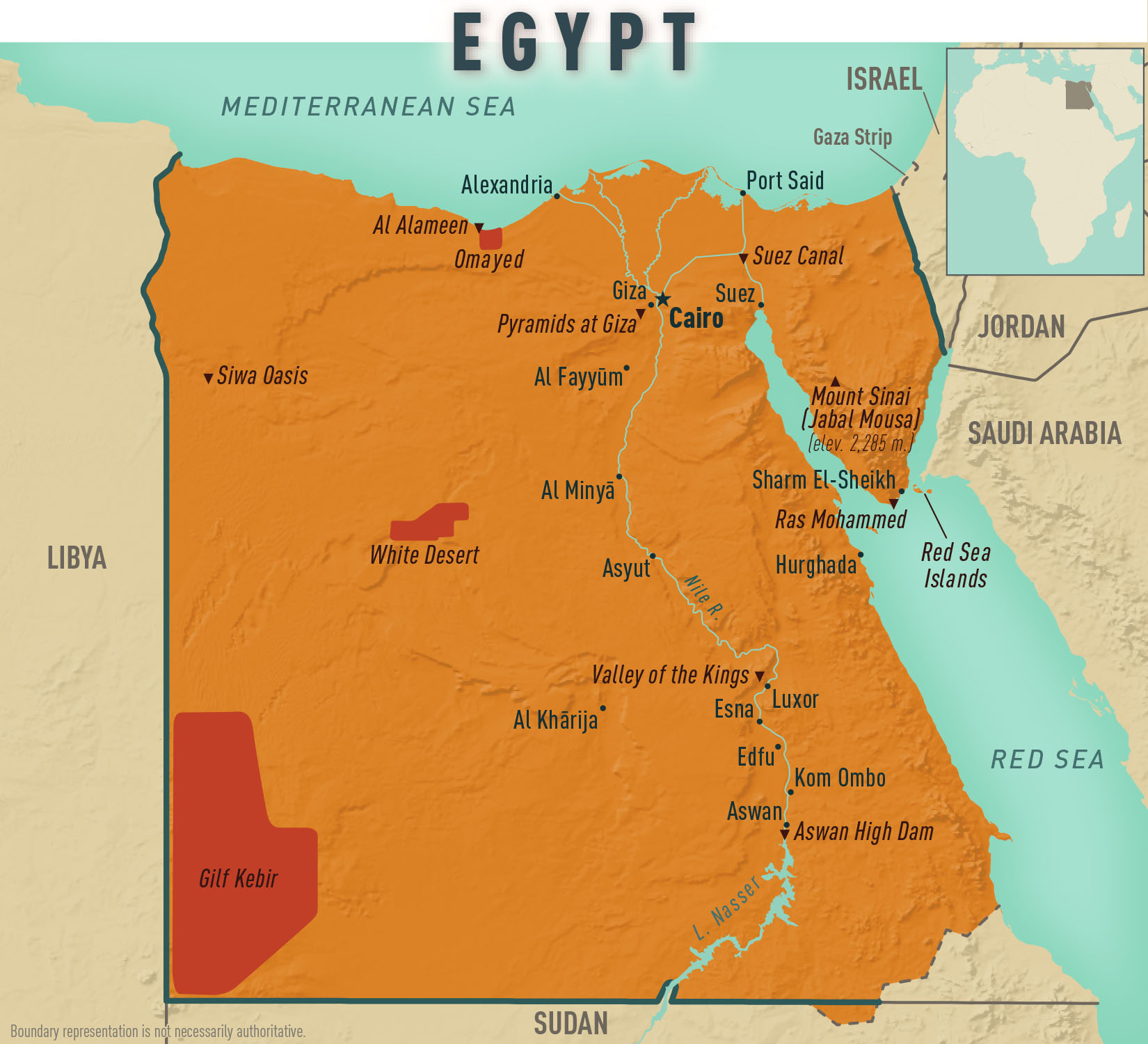
View Larger Figure
In addition to being up to date on routine vaccines, travelers to Egypt should obtain hepatitis A and B, typhoid, and coronavirus disease 2019 (COVID-19) vaccines. Detailed Egypt-specific travel advice can be found on the Egypt destination page .
Enteric Infections & Diseases
Hepatitis a.
Hepatitis A virus (see Sec. 5, Part 2, Ch. 7, Hepatitis A ) is transmitted through ingestion of contaminated food or water. Those who are fully vaccinated against hepatitis A have lower risk of infection. Instruct travelers to follow food and water safety precautions (see Sec. 2, Ch. 8, Food & Water Precautions ).
Travelers' Diarrhea
In most large international tourist hotels, the tap water is adequately chlorinated, but bottled water is generally provided for drinking. Tap water is not safe to drink outside of international tourist hotels because it might come from private water tanks not audited by the Ministry of Health. Eating thoroughly cooked meat and vegetables in tourist hotels, on Nile River cruise ships, and in tourist restaurants is generally safe. Eating raw or undercooked ground meat or shellfish should be avoided. As in many developing countries, the safety of uncooked vegetables and salads is questionable. The risk of travelers’ diarrhea in Egypt is high. Travelers affected by travelers’ diarrhea should hydrate to replace lost body fluids and minerals and use antimotility medications (e.g., loperamide). Clinicians could consider prescribing an antibiotic for travelers to Egypt to empirically self-treat travelers’ diarrhea (see Sec. 2, Ch. 6, Travelers’ Diarrhea ).
Respiratory Infections & Diseases
Coronavirus disease 2019.
All travelers going to Egypt should be up to date with their COVID-19 vaccines .
Sexually Transmitted Infections & HIV
Although the reported prevalence of HIV in Egypt is low, following standard precautions for prevention of sexually transmitted diseases is always advised. Egypt has historically had an alarmingly high prevalence of hepatitis C. However, in 2014 Egypt launched an intensive national elimination campaign that has led to a significant reduction in the prevalence of hepatitis C.
Soil- & Waterborne Infections
Schistosomiasis.
Egypt implemented a campaign to eliminate Schistosoma mansoni and Schistosoma haematobium, which were endemic. Although Egypt has made significant progress towards eliminating schistosomiasis, travelers should avoid wading, swimming, or other contact with freshwater, including the Nile River and irrigation canals. Swimming in saline pools of desert oases, chlorinated swimming pools, the Mediterranean Sea, or the Red Sea does not pose a risk for acquiring schistosomiasis (see Sec. 5, Part 3, Ch. 20, Schistosomiasis ).
Vectorborne Diseases
Mosquitoes and other biting insects can be problematic for travelers. Avoiding insect bites will prevent local discomfort and irritation and reduce the risk of vectorborne diseases (see Sec. 4, Ch. 6, Mosquitoes, Ticks & Other Arthropods ). Consider vectorborne diseases in the differential diagnosis of travelers with fever returning from Egypt (see Sec. 11, Ch. 4, Fever in the Returned Traveler ).
Dengue & West Nile virus
Dengue (see see Sec. 5, Part 2, Ch. 4, Dengue ) has been reported rarely in travelers who visited Egypt. Although some studies indicate that West Nile virus transmission is widely distributed, infections in returning travelers appear to be rare.
Isolated local transmission of malaria was last reported in Aswan Governorate in 2014. Although CDC does not recommend malaria prophylaxis for people going to Egypt, travelers should practice insect bite precautions.
Yellow Fever
There is no risk of yellow fever in Egypt. Egypt does, however, require travelers ≥9 months old arriving from countries with risk for yellow fever virus transmission to provide proof of vaccination against this disease. For more details, seeSec. 5, Part 2, Ch. 26, Yellow Fever , Sec. 2, Ch. 5, Yellow Fever Vaccine & Malaria Prevention Information, by Country , and International Certificate of Vaccination or Prophylaxis (ICVP) .
Animal Bites & Rabies
As in most other low-income countries, rabies is endemic throughout Egypt. For most travelers on a package tour, the risk will be minimal. However, travelers should be aware there are large numbers of stray dogs and cats in urban and tourist areas and are thus advised to avoid contact with all animals, wild, feral, and domestic. Rabies vaccine is available in Egypt for preexposure and postexposure prophylaxis; human rabies immune globulin is also available (see Sec. 5, Part 2, Ch. 18, Rabies ). Shark attacks are rare in the Red Sea; however, sporadic incidents have been reported, including two attacks in 2020 and two in 2022.
Climate & Sun Exposure
Temperature and weather conditions vary widely in Egypt. The desert is extremely hot in summer (>100°F; >38°C) and can be cold in winter (<32°F; <0°C). Thirst is a late indicator of dehydration, and travelers should drink fluids regularly in the heat (see Sec. 4, Ch. 1, Extremes of Temperature ). Because sweat evaporates immediately, people can become dehydrated without realizing it. Travelers who are elderly or take diuretic, anticholinergic, or neuroleptic medications are at increased risk of heat-associated illnesses. To stay cool and protect themselves from sun exposure, travelers should wear a hat and lightweight, loose-fitting clothing, as well as use sunscreen.
Sandstorms occur sporadically in the desert. Desert sand, dust, and smog can cause eye irritation and exacerbate asthma or other lung disorders (see Sec. 4, Ch. 3, Air Quality & Ionizing Radiation ). Travelers who wear contact lenses should ensure to pack eyeglasses and contact lens care supplies.
The majority of criminal acts in Egypt are crimes of opportunity such as purse snatching and pickpocketing. Travelers should be alert to being overcharged for various services and for being victimized in scams common to tourist destinations worldwide. The Department of State advises against travel to Sinai Peninsula (with the exception of air travel to Sharm El Sheikh), the Western Desert, and border areas due to risk of terrorism. Military and police road checkpoints are common, and security services enforce official travel restrictions. Travelers should check the US Department of State Egypt International Travel Information for up-to-date information on travel restrictions and safety precautions before travel.
Traffic-Related Injuries
Traffic incidents are common in Egypt due to overcrowded roads and reckless driving. Travelers should wear seat belts at all times (see Sec. 8, Ch. 5, Road & Traffic Safety ). Pedestrians should be very careful because traffic rules are different in Egypt and pedestrians do not have right of way when in a crosswalk.
Hotels in Egypt are required by law to have an onsite clinic and resident physician. If further clinical care is required, the traveler would be referred to a hospital. Hospitals are available throughout the metropolitan areas. Most medications are available without a prescription; however, travelers should bring an adequate supply of any routine prescription medications (see Sec. 6, Ch. 3, . . . perspectives: Avoiding Poorly Regulated Medicines & Medical Products During Travel ).
Box 10-04. Nile River cruises
Nile River cruises are usually 3–7-day trips to Aswan and Luxor. Approximately 200 riverboats are based on the Nile, and the average boat accommodates 120 passengers. The largest boats accommodate upwards of 300 passengers; chartered yachts might have just a few cabins. Riverboats have a range of accommodations from basic to 5-star luxury, and nights aboard are generally spent cruising from one port to the next while enjoying the passing riverside scenes of ancient villages, minarets, traditional feluccas (small boats), and farmers in galabiyas (traditional dress worn by farmers).
When travelers disembark they can visit the High Dam and Philae Temple in Aswan or Karnak Temple, Luxor Temple, Valley of the Kings, and Hatshepsut Temple in Luxor. The temples of Edfu, Esna, and Kom Ombo are all a must-see.
Generally, the Nile is a slow, smooth river. The combination of diesel fuel, heat, and motion can, however, cause distress for travelers. Most travelers do not consider the possibility of motion sickness on a river, so they are unprepared. Onboard medical services vary greatly. Travelers who know that they are sensitive to motion should carry motion sickness medication (see Yellow Book chapter, Motion Sickness). It is also important to keep in mind that the living conditions on river cruises worldwide, not only in Egypt, could be associated with spread of highly infectious diseases. Examples of this were seen during the COVID-19 pandemic, when cruise ships served as foci for spread of the virus not only on the cruise ship but onward transmission globally.
The following authors contributed to the previous version of this chapter: Ann M. Buff and Erik J. Reaves
Bibliography
Guagliardo, Sarah Anne J, et al. COVID-19 on the Nile: A Cross-Sectional Investigation of COVID-19 among Nile River Cruise Travellers Returning to the United States, February–March 2020. Journal of Travel Medicine, 29 Dec. 2022, 10.1093/jtm/taac153.
Hassanin a, Kamel S, Waked I, Fort M. Egypt’s ambitious strategy to eliminate hepatitis C virus: a case study. Glob Health Sci Pract. 2021;9(1):187–200.
HIV, Global Hepatitis And Sexually Transmitted Infections Programmes. Criteria for Validation of Elimination of Viral Hepatitis B and C: Report of 7 Country Pilots . 1 Sept. 2022, www.who.int/publications/i/item/9789240055292.
Saifullin MA, Laritchev, VP, Grigorieva YE, Zvereva NN, Domkina AM, Saifullin RF, Bazarova MV, et al. Two cases of Dengue Fever imported from Egypt to Russsia, 2017. Emerging Infectious Diseases 2018; 24 (4): 813-814.
Selim A, Radwan A, Arnaout F. Seroprevalence and molecular characterization of West Nile virus in Egypt. Comparative Immunology, Microbiology, and Infectious Diseases. Vol 71; 2020, 101473.
Yameny AA. The evolving schistosomiasis agenda 2017–2020 in Egypt: moving from control toward final elimination. J Biosci Appl Res. 2017; 3(2);48–54.
File Formats Help:
- Adobe PDF file
- Microsoft PowerPoint file
- Microsoft Word file
- Microsoft Excel file
- Audio/Video file
- Apple Quicktime file
- RealPlayer file
- Zip Archive file
Exit Notification / Disclaimer Policy
- The Centers for Disease Control and Prevention (CDC) cannot attest to the accuracy of a non-federal website.
- Linking to a non-federal website does not constitute an endorsement by CDC or any of its employees of the sponsors or the information and products presented on the website.
- You will be subject to the destination website's privacy policy when you follow the link.
- CDC is not responsible for Section 508 compliance (accessibility) on other federal or private website.
Update May 10, 2024
Information for u.s. citizens in the middle east.
- Travel Advisories |
- Contact Us |
- MyTravelGov |
Find U.S. Embassies & Consulates
Travel.state.gov, congressional liaison, special issuance agency, u.s. passports, international travel, intercountry adoption, international parental child abduction, records and authentications, popular links, travel advisories, mytravelgov, stay connected, legal resources, legal information, info for u.s. law enforcement, replace or certify documents.
Before You Go
Learn About Your Destination
While Abroad
Emergencies
Share this page:
Travel Advisory July 13, 2023
Egypt - level 3: reconsider travel.
Reissued with obsolete COVID-19 page links removed.
Reconsider travel to Egypt due to terrorism . Exercise increased caution in Egypt due to the Embassy’s limited ability to assist dual national U.S.-Egyptian citizens who are arrested or detained.
Do not travel to:
- The Sinai Peninsula (with the exception of travel to Sharm El-Sheikh by air) due to terrorism .
- The Western Desert due to terrorism .
- Egyptian border areas due to military zones .
Country Summary: Terrorist groups continue plotting attacks in Egypt. Terrorists may attack with little or no warning, and have targeted diplomatic facilities, tourist locations, transportation hubs, markets/shopping malls, western businesses, restaurants, resorts, and local government facilities. Terrorists have conducted attacks in urban areas, including in Cairo, despite the heavy security presence. Terrorists have targeted religious sites, to include mosques, churches, monasteries, and buses traveling to these locations.
Due to risks to civil aviation operating within or in the vicinity of Egypt, the Federal Aviation Administration (FAA) has issued a Notice to Air Missions (NOTAM) and/or a Special Federal Aviation Regulation (SFAR). For more information U.S. citizens should consult the Federal Aviation Administration’s Prohibitions, Restrictions and Notices .
Local law prohibits protesting or demonstrating without a permit. Being near anti-government protests can draw scrutiny from Egyptian police and security forces. U.S. citizens have been detained for participating in protests and for posting content on social media perceived as critical of Egypt or its allies.
The U.S. Embassy may have a limited ability to provide consular services to dual U.S.-Egyptian citizens. Egyptian law considers dual citizens to be Egyptian citizens.
Read the country information page for additional information on travel to Egypt.
If you decide to travel to Egypt:
- Stay alert in locations frequented by Westerners.
- Avoid demonstrations and crowds.
- Obtain comprehensive medical insurance that includes medical evacuation.
- Enroll in the Smart Traveler Enrollment Program (STEP) to receive Alerts and make it easier to locate you in an emergency.
- Follow the Department of State on Facebook and Twitter .
- Review the Country Security Report for Egypt.
- Visit the CDC page for the latest Travel Health Information related to your travel.
- Prepare a contingency plan for emergency situations. Review the Traveler’s Checklist .
Sinai Peninsula – Level 4: Do Not Travel The Sinai Peninsula remains a particularly dangerous area, with frequent attacks on security forces and civilians.
The U.S. government has limited ability to provide emergency services to U.S. citizens anywhere in the Sinai Peninsula as U.S. government employees are not authorized to travel to these areas (with the exception of the beach resort of Sharm El-Sheikh; travel to Sharm El-Sheikh is only permitted by air). Visit our website for Travel to High-Risk Areas .
Embassy Messages
View Alerts and Messages Archive
Quick Facts
Must have six months validity
At least one blank page
Less than $10,000
Embassies and Consulates
U.s. embassy cairo.
Consular Section 5 Tawfik Diab Street Garden City, Cairo Egypt Telephone: +(20) 2-2797-3300 Emergency After-Hours Telephone: +(20) 2-2797-3300 Fax: +(20) 2-2797-2472 Email: [email protected] Facebook
The American Citizens Services (ACS) Unit uses an online appointment system for those coming to the Embassy to receive routine consular services Sunday through Wednesday, except for official holidays (U.S. and Egyptian). U.S. citizens with non-emergency inquiries may send an email to the ACS Unit at [email protected] .
For emergencies during and after business hours, including on weekends and holidays, U.S. citizens can contact the ACS Unit via the Embassy switchboard at 02-2797-3300. The mailing address from the United States is: Consular Section, Unit 64900, Box 15, APO AE 09839-4900. Within Egypt or from a third country, it is 8 Kamal el-Din Salah Street, Garden City, Cairo, Egypt. Express mail services also use the physical address.
Destination Description
Learn about the U.S. relationship to countries around the world.
Entry, Exit and Visa Requirements
Passport and Visas:
- U.S. citizens must have a visa to enter Egypt.
- U.S. citizens can obtain a renewable single-entry 30-day tourist visa on arrival at Egyptian airports for a 25 USD fee. A multiple entry visa is also obtainable for 60 USD.
- The Government of Egypt has created a website for the issuance of “ e-visas .” There are other websites purporting to offer electronic visas, some of which reportedly charge double the official price, but this is the only official Government of Egypt portal for this service. U.S. citizens and the citizens of 44 other countries are eligible to apply through this means in advance of their travel.
- Egyptian immigration officials occasionally have denied entry to travelers without explanation.
- U.S. citizens who have experienced difficulty with their visa status in Egypt or are concerned about their eligibility for a visa upon arrival should apply for a visa at an Egyptian embassy or consulate prior to travel, but a visa obtained prior to entry does not guarantee admission to Egypt.
- Visas for gainful employment or study in Egypt must be obtained prior to travel.
Entry from Israel:
- U.S. citizens arriving from Israel at the Taba border crossing should obtain a visa ahead of time.
- If travelers do not obtain a visa prior to arrival, they may either apply for a no-fee, 14-day visa that is only valid for travel within the Sinai Peninsula, or they may obtain a 30-day tourist visa valid for travel throughout Egypt for 25 USD.
- The 30-day visa requires the submission of a travel agency support letter that may be obtained from travel agents at the border; their fees for providing this service vary.
- The Government of Egypt opens this border on an infrequent and unpredictable basis.
- Travel groups and/or humanitarian aid convoys that wish to cross at Rafah would need to contact the Egyptian Embassy in Washington for permission prior to travel.
- The Egyptian government screens travelers before allowing entry/exit through the Rafah border crossing with Gaza.
- The U.S. government advises its citizens to avoid travel to Gaza; the U.S. Embassy does not issue travel letters or provide any assistance in crossing to and from Gaza.
- Travelers to Gaza from Egypt should read the Travel Advisory for Israel, the West Bank, and Gaza and are reminded the Sinai Peninsula remains a particularly dangerous area, with frequent Islamic State of Iraq and ash-Sham (ISIS) attacks on security forces and civilians.
Diplomatic and Official Passports:
- Diplomatic and Official passport holders, when entering Egypt for official business, are required to have visas before arrival in Egypt.
- Diplomatic or Official passport holders must not use these passports to enter Egypt for unofficial travel, and should use their personal passports, following all appropriate regulations.
- Travelers attempting to enter Egypt with diplomatic or official passports who do not have visas will be denied entry and required to remain in the airport transit area, at their own expense, until their immediate departure from Egypt can be arranged.
- The U.S. Embassy in Cairo is unable to intervene in such situations. Military personnel arriving on commercial flights are not exempt from passport and visa requirements.
- The Egyptian Embassy in Washington currently requires at least three weeks, and sometimes much longer, to process official and diplomatic visa requests, an expedite letter from the Department of State notwithstanding.
- It is incumbent upon all official travelers to submit their visa requests and passports to the Egyptian Embassy well in advance of travel.
Work Permits:
- U.S. citizens who wish to come to Egypt for work must obtain work permits and work/business visas before arrival.
- All work permits must be obtained through the employer. These permits may be acquired from the Ministry of Manpower and Migration offices in the district of the employer; accordingly, these permits authorize residency in the country.
- U.S. citizens who arrive as tourists but want to change their status after arrival in country may acquire a three-month tourist/non-working residency visa to allow sufficient time to change their status from tourist to worker.
- U.S. citizens in Egypt on tourist visas are not permitted to work.
For additional information on entering Egypt, please contact the nearest Egyptian Embassy or Consulate.
Medical Requirements:
- U.S. citizens arriving from an area that has been infected with yellow fever will need to provide proof of immunizations.
- Please verify this information with the Egyptian Embassy before you travel.
Exit Requirements:
- U.S. citizen women married to Egyptians do not need their spouse's permission to depart Egypt as long as they have a valid Egyptian visa or valid Egyptian passport.
- A U.S. citizen departing Egypt with a dual-national child (U.S.-Egyptian) may be required by Egyptian immigration officers at the airport to demonstrate that they have proof of consent of the non-traveling Egyptian parent.
- If travelers attempt to depart Egypt after the expiration of their visa, they may be required to pay a fine at the airport. Travelers should ensure that they arrive to the airport early with sufficient Egyptian currency to pay any fines.
- The U.S. Embassy does not issue travel letters to exit Egypt.
Dual Nationals:
- If a dual national has the annotation “Egyptian origin” on their entry visa, they will require proof of Egyptian citizenship in order to exit Egypt.
- This is also true for dual nationals who remain in Egypt for more than six months.
- In some cases, if a dual national loses their U.S. passport, they will be required to present their parents’ Egyptian birth certificates and be documented as Egyptian citizens in order to obtain a temporary/replacement entry stamp to facilitate their travel out of Egypt.
- Male U.S. citizens who also hold Egyptian nationality, between 18-40 years old, who have stayed in Egypt more than 180 days, are required to finalize their Egyptian military status before departure, or risk being refused departure from Egypt by Egyptian Immigration officials. The U.S. Embassy is unable to intervene in these situations. For more information see: https://tagned.mod.gov.eg/ .
Find information on dual nationality , prevention of international child abduction and customs regulations on our websites.
Safety and Security
The Department of State Travel Advisory warns U.S. citizens to avoid travel to the Sinai Peninsula (with the exception of travel to Sharm El-Sheikh by air) and the Western Desert. Travel to the Libyan and Sudanese borders is also not recommended. U.S. citizens in Egypt should maintain a high level of vigilance throughout the country due to the threat of terrorism.
Between December 2018 and May 2019, terrorist incidents in tourist areas in greater Cairo killed four tourists and wounded at least 18 others. Terrorists may attack with little or no warning, and have targeted diplomatic facilities, tourist locations, transportation hubs, markets/shopping malls, western businesses, resorts, and local government facilities. There is a possibility of terrorist attacks in urban areas, including in Cairo, despite the heavy security presence. In August 2019, a car bomb explosion outside of a hospital in Cairo killed at least 20. Additionally, terrorists have targeted religious sites, to include mosques, churches, monasteries, and buses traveling to these locations.
The Egyptian government has attempted to address security concerns and has visibly augmented its security presence at tourist locations, but challenges persist, and the threat of terrorism remains. Police and military are also engaged in operations to combat terrorism and disrupt terrorist cells in the Sinai Peninsula and the Nile Valley.
- The Sinai Peninsula (with the exception of travel to Sharm El-Sheikh by air) due to terrorism.
The Sinai Peninsula remains a particularly dangerous area, with frequent terrorist attacks on security forces and civilians.
The U.S. government has limited ability to provide emergency services to U.S. citizens anywhere in the Sinai Peninsula as U.S. government employees are not authorized to travel to these areas (with the exception of the beach resort of Sharm El-Sheikh; travel to Sharm El-Sheikh is only permitted by air).
- The Western Desert due to terrorism.
- Egyptian border areas other than official ports of entry.
For more information, see our Terrorism page.
Egypt’s borders are under military control; movement of non-military persons and vehicles is substantially restricted, and in some cases prohibited, within these areas. U.S. citizens should not travel in these border zones.
It is illegal to photograph police stations, military barracks, and certain other sensitive public buildings.
U.S. citizens are urged to remain alert to local security developments, avoid demonstrations, and be vigilant regarding their personal security at all times throughout the country. U.S. citizens should also carry identification and a cell phone or other means of communication that works in Egypt, and it is advisable to pre-program the U.S. Embassy’s telephone number (+20 2 2797-3300) and email address ( [email protected] ) into the device.
Travelers must obtain permission and a travel route from the Egyptian Military Intelligence and the Tourist Police Headquarters via a local or overseas travel agency to access Egypt's frontiers, including the borders with Libya, Sudan, Israel, and parts of the Sinai Peninsula off paved roads.
High concentrations of World War II-era unexploded landmines are located in the World War II battlefields along the Mediterranean coast west of Alexandria, the Eastern Desert between Cairo and the Suez Canal, and much of the Sinai Peninsula. Travelers are urged to be especially cautious in these areas.
Crime: Crime levels in Cairo and Alexandria are moderate.
The vast majority of criminal acts against foreigners are crimes of opportunity, such as purse snatching and pickpocketing.
Harassment of women, including foreigners, remains a serious problem. Incidents of harassment range from lewd comments and gestures to indecent exposure and inappropriate physical contact.
Tourists should be alert to being overcharged for various services and for being victimized in scams common to tourist destinations worldwide. Tourists should expect to encounter aggressive vendors at Egypt’s shops in urban areas, as well as at the many temples and archaeological sites. Some will offer “free” gifts to tourists which, once accepted, lead to demands for money. Most sites have specially designated tourist police who can assist in uncomfortable situations.
International Financial Scams: See the Department of State and the FBI pages for information.
Internet romance and financial scams are prevalent in Egypt. Scams are often initiated through Internet postings/profiles or by unsolicited emails and letters. Scammers almost always pose as U.S. citizens who have no one else to turn to for help. Common scams include:
- Romance/Online dating
- Money transfers
The U.S. Embassy receives frequent reports of online financial scams, often involving a fraudulent romantic partner requesting money for hospital bills or legal expenses to depart Egypt. Be skeptical about sending money to anyone known only through online contact.
Victims of Crime:
U.S. citizen victims of sexual assault are encouraged to contact the U.S. Embassy for assistance.
Report crimes to the local police at 122 and contact the U.S. Embassy at +(20) 2-2797-3300. Remember that local authorities are responsible for investigating and prosecuting crime. The Embassy cannot intervene in legal disputes.
Failure to report crimes before leaving Egypt will make it impossible to seek prosecution at a later date. U.S. citizen tourists can forward their complaints for investigation to the Tourist Police Headquarters. For crimes involving children, you may call Egypt’s Child Emergency Help line by dialing 16000 . Egypt’s National Council for Women provides some assistance to women who are victims of domestic violence, or other complaints, at phone number 15115 or website: http://www.oo-ncw.org .
See our webpage on help for U.S. victims of crime overseas .
- Help you find appropriate medical care
- Assist you in reporting a crime to the police
- Contact relatives or friends with your written consent
- Provide general information regarding the victim’s role during the local investigation and following its conclusion
- Provide a list of local attorneys
- Provide our information on victim’s compensation programs in the U.S.
- Provide an emergency loan for repatriation to the United States and/or limited medical support in cases of destitution
- Help you find accommodation and arrange flights home
- Replace a stolen or lost passport
Domestic Violence: U.S. citizen victims of domestic violence are encouraged to contact the Embassy for assistance.
For further information:
- Enroll in the Smart Traveler Enrollment Program ( STEP ) to receive security messages and make it easier to locate you in an emergency.
- Call the State Department in Washington at 1-888-407-4747 toll-free in the United States and Canada or 1-202-501-4444 from other countries from 8:00 a.m. to 8:00 p.m. Eastern Standard Time, Monday through Friday (except U.S. federal holidays).
- See the State Department's travel website .
- Follow us on Twitter and Facebook .
- See traveling safely abroad for useful travel tips.
Tourism: The tourism industry is unevenly regulated, and safety inspections for equipment and adventure facilities may not frequently occur. Hazardous areas/activities are not always identified with appropriate signage, and staff may not be trained or certified either by the host government or by recognized authorities in the field. In the event of an injury, appropriate medical treatment is typically available only in/near major cities. First responders are not always able to access areas outside of major cities and to provide urgent medical treatment. U.S. citizens are encouraged to purchase medical evacuation insurance. See our webpage for more information on insurance providers for overseas coverage .
Local Laws & Special Circumstances
Criminal Penalties: Travelers are subject to local laws. The Egyptian legal system is different from the legal system in the United States, with significantly different standards of evidence, due process, and rule of law. Travelers should be conscious of their behavior and how it may be interpreted by Egyptian authorities. If one violate local laws, even unknowingly, one may be denied entry, expelled, arrested, or imprisoned. Individuals establishing a business or practicing a profession that requires additional permits or licensing should seek information from the competent local authorities, prior to practicing or operating a business.
- Egyptian police and security forces do not require probable cause in order to stop, question, and detain individuals. Failure to carry proper identification, such as a passport, may result in detention and questioning.
- Suspects may be detained without charges or access to immediate legal counsel for months during the investigative stage of a criminal case.
- U.S. citizens have been detained for several days or more in non-criminal cases, including immigration violations.
- Local laws prohibit protesting or demonstrating without a permit. Even being in the vicinity of anti-government protests can draw scrutiny from Egyptian police or security forces, including demands to search personal electronic devices. U.S. citizens have been detained for posting content on social media perceived as critical of Egypt or its allies.
- Punishments often can be harsher in Egypt for comparable crimes than they are in the United States. Penalties for drug offenses can be particularly severe, including life in prison or the death penalty.
Furthermore, some laws are also prosecutable in the United States, regardless of local law. For examples, see our website on crimes against minors abroad and the Department of Justice website.
Arrest Notification: If you are arrested or detained, ask police or prison officials to notify the U.S. Embassy immediately. See our webpage for further information.
Dual U.S.-Egyptian Citizens : Egyptian law considers dual nationals to be Egyptian citizens and thus the Egyptian authorities do not automatically notify the U.S. Embassy when a dual national is detained, or provide information about their alleged crime. Family members, friends, and/or traveling companions may notify the ACS Unit at U.S. Embassy Cairo if the arrested U.S. citizen is unable to do so. U.S. citizenship does not provide protection from detention or arrest by Egyptian authorities and individuals detained may be subjected to prolonged interrogations and extended detention. U.S. citizens arrested for any reason in Egypt may be deported, even if they are not convicted of a crime. Detained U.S.-Egyptian citizens have been asked by the Government of Egypt to renounce their Egyptian citizenship as a condition of their deportation to the United States.
Consular officers must obtain authorization from Egyptian authorities to visit American detainees.
- Entering or exiting Egypt with more than $10,000 is prohibited. Attempting to enter or depart Egypt with any instruments of currency in the sum of more than $10,000 could result in the confiscation of the money over $10,000 and other penalties.
Importation of all types of drones, including small civilian drones used for personal or touristic purposes is strictly prohibited. Potential penalties for violating are harsh, and a recently passed law authorizes the death penalty for using a drone in support of terrorist activity.
Counterfeit and Pirated Goods: Although counterfeit and pirated goods are prevalent in many countries, they may still be illegal according to local laws. You may also pay fines or have to give them up if you bring them back to the United States. See the U.S. Department of Justice website for more information.
Cultural Property: Travelers should note that Egyptian law prohibits the unauthorized removal of antiquities (including historic coins, ceramics, and architectural elements) both from archaeological sites and other sources in Egypt. Egyptian law also forbids the intentional damaging of antiquities, such as inscribing or painting on them or attaching advertisements. The trade, sale, or export in antiquities is also heavily restricted and regulated. Travelers may be prosecuted if found to be looting or damaging archaeological sites, buying antiquities, or smuggling antiquities out of Egypt. Penalties include fines and/or imprisonment.
Faith-Based Travelers: See the Department of State’s International Religious Freedom Report .
LGBTI Travelers: LGBTI individuals face significant social stigma and discrimination in Egypt. Egyptian law does not criminalize same-sex sexual activity, but LGBTI persons and advocacy groups have reported harassment, intimidation, arrests, and other forms of abuse, including by police. There are also reports that authorities have used social media, dating websites, and cell phone apps to entrap persons suspected of being gay or transgender in an act of “debauchery,” which is a criminal offense that carries sentences of up to 10 years. Police have confiscated rainbow flags and sometimes detained their owners. See our LGBTI Travel Information page and sections 1c and 6 of our Human Rights report for further details.
ACCESSIBILITY: While in Egypt, individuals with disabilities may find accessibility and accommodation very different from in the United States. Businesses and institutions in Egypt generally do not make special accommodations for persons with disabilities, and Egyptian authorities do not enforce laws mandating access to transportation, communication, and public buildings by persons with disabilities. Pedestrian sidewalks and walkways are limited, uneven, high, and sometimes used by cars and motorcycles.
Accommodations on public transportation are not offered for elderly individuals or persons with disabilities. Crosswalks are not in widespread use and motorists have the right of way. Pedestrians should exercise extreme caution.
Students: See the Students Abroad page and FBI travel tips .
Women Travelers: Many women travel safely each year without incident. However, when it comes to health and security, women travelers are more likely to be affected by religious and cultural beliefs of the foreign countries they visit. The truth is that women face greater obstacles, especially when travelling alone.
Women, especially those traveling alone, should exercise particular care in crowds, on public transportation, in rural areas, and in isolated sections of temple and pyramid complexes. Women have been groped in taxis and while in public places.
The Embassy continues to receive reports of U.S. citizen women subject to domestic violence, sexual harassment, verbal abuse, and rape in Egypt.
Some Egyptian NGOs provide assistance to victimized women within the Egyptian community. Women victimized overseas may be entitled to receive compensation for counseling and/or other services such as relocating back to the United States.
For further information see the travel tips for Women Travelers .
For emergency services in Egypt, dial 123 .
Ambulance services are not widely available and training and availability of emergency responders may be below U.S. standards.
Insurance: Travelers should make sure their health insurance plan covers them when outside of the United States.
- The U.S Embassy cannot pay medical bills.
- U.S. Medicare does not pay overseas.
- Doctors and hospitals often expect cash payment for health services.
- The U.S. Embassy strongly recommends supplemental insurance to cover medical evacuation, since medical transport out of the country can be prohibitively expensive or logistically impossible.
- See the webpage for more information on insurance providers for overseas coverage .
Medical Care:
Emergency and intensive care facilities are limited. Most Nile cruise boats do not have a ship's doctor, but some employ a medical practitioner. Hospital facilities in Luxor, Aswan, and Sharm el Sheikh are adequate, but they are inadequate at most other ports-of-call. The Egyptian ambulance service hotline is 123. Although availability of ambulances is improving, getting them through Cairo traffic can be very challenging.
Beaches on the Mediterranean and Red Sea coasts are generally unpolluted. However, persons who swim in the Nile or its canals, walk barefoot in stagnant water, or drink untreated water are at risk of exposure to bacterial and other infections and the parasitic disease schistosomiasis (bilharzia).
It is generally safe to eat freshly prepared cooked food in hotels, on Nile cruise boats, and in mainstream restaurants. When selecting a restaurant, travelers should select a clean and reputable place, eat only freshly prepared, cooked foods, avoid all uncooked food including raw fruits and vegetables. Tap water in some locations is not potable. It is best to drink bottled water or water that has been boiled and filtered. Well-known brands of bottled beverages are generally considered to be safe if the seal is intact.
Although the Embassy cannot provide medical advice or provide medical services to the public, a list of hospitals and doctors in Egypt can be found on the Embassy website.
Prescriptions: Travelers should carry prescription medication in original packaging, along with your doctor’s prescription.
Vaccinations: Travelers should be up-to-date on all recommended vaccinations , per CDC’s information.
Further Health Information:
- World Health Organization
- U.S. Centers for Disease Control and Prevention (CDC)
Travel and Transportation
Traffic Laws: Although the enforcement of traffic laws generally is lax, foreigners are subject to extra scrutiny and driving under the influence of alcohol or drugs could result in arrest or detainment.
Road Conditions and Safety: Driving in Egypt is extremely hazardous. Egypt has one of the highest occurrences of road fatalities per mile driven in the world. Intercity roads are generally in good condition, but unmarked surfaces, pedestrians, stray animals, sandstorms and fog, vehicles without lights, and disabled vehicles without reflectors are among the many hazards present on highways, especially after dark.
Driving Cairo’s busy maze of streets can be an extreme challenge to foreigners, especially those used to a culture of structured rules and regulations. Even residents of Cairo must use extreme care and situational awareness to navigate the capital’s hectic streets. Impatient drivers typically ignore traffic rules, which police seldom enforce. Most traffic lights in Cairo do not function; instead, police officers, using finger and hand movements to direct traffic, normally staff the main intersections.
Vehicle accidents remain a significant safety concern.
Visitors thinking about driving in Egypt should carefully consider other options, such as a taxi or hired driver. If visitors decide to drive, it is essential that they take the utmost precautions and drive defensively. Drivers should be prepared for unlit vehicles at night, few road markings, vehicles traveling at high rates of speed, vehicles traveling the wrong way on one-way streets, divided highways, and connecting ramps, pedestrians dodging in and out of traffic, and domesticated animals on the roadways. Motorists should be especially cautious during the rare winter rains, which can cause extremely slippery road surfaces and localized flooding; Egyptian drivers are not familiar with driving in wet conditions, making such periods particularly hazardous.
Pedestrians should also exercise extreme caution on high-volume/high-velocity streets, like Cairo’s Corniche, which follows the eastern bank of the Nile River, and Alexandria’s Corniche along the Mediterranean.
Public Transportation: Public buses and microbuses are not safe, and Embassy personnel are prohibited from using them. Embassy personnel are also prohibited from traveling on Cairo’s metro system. Embassy personnel are prohibited from traveling by train, which is a particularly unsafe means of transportation, with regular accidents that sometimes involve mass casualties.
Embassy personnel are generally prohibited from traveling outside the greater Cairo and Alexandria areas by motor vehicle, with the exception of travel to beach resorts on the western side of the Red Sea and near Alexandria. Furthermore, Embassy policy prohibits personal travel via privately-owned vehicle to any part of the Sinai Peninsula or the Western Desert.
Please refer to our Road Safety page for more information.
AVIATION SAFETY OVERSIGHT: The U.S. Federal Aviation Administration (FAA) has assessed the government of Egypt’s Civil Aviation Authority as being in compliance with International Civil Aviation Organization (ICAO) aviation safety standards for oversight of Egypt’s air carrier operations. Further information may be found on the FAA’s safety assessment page .
Maritime Travel: Mariners planning travel to Egypt should check for U.S. maritime advisories and alerts at the Maritime Security Communications with Industry Web Portal . Information may also be posted to the U.S. Coast Guard homeport website and as a broadcast warning on the National Geospatial-Intelligence Agency’s website .
For additional travel information
- Enroll in the Smart Traveler Enrollment Program (STEP) to receive security messages and make it easier to locate you in an emergency.
- Call us in Washington, D.C. at 1-888-407-4747 (toll-free in the United States and Canada) or 1-202-501-4444 (from all other countries) from 8:00 a.m. to 8:00 p.m., Eastern Standard Time, Monday through Friday (except U.S. federal holidays).
- See the State Department’s travel website for the Worldwide Caution and Travel Advisories .
- Follow us on Twitter and Facebook .
Egypt was cited in the State Department’s 2023 Annual Report to Congress on International Child Abduction for demonstrating a pattern of non-compliance with respect to international parental child abduction. Review information about International Parental Child Abduction in Egypt . For additional IPCA-related information, please see the International Child Abduction Prevention and Return Act ( ICAPRA ) report.”
Travel Advisory Levels
Assistance for u.s. citizens, learn about your destination, enroll in step.

Subscribe to get up-to-date safety and security information and help us reach you in an emergency abroad.
Recommended Web Browsers: Microsoft Edge or Google Chrome.
Make two copies of all of your travel documents in case of emergency, and leave one with a trusted friend or relative.
Afghanistan
Antigua and Barbuda
Bonaire, Sint Eustatius, and Saba
Bosnia and Herzegovina
British Virgin Islands
Burkina Faso
Burma (Myanmar)
Cayman Islands
Central African Republic
Cote d Ivoire
Curaçao
Czech Republic
Democratic Republic of the Congo
Dominican Republic
El Salvador
Equatorial Guinea
Eswatini (Swaziland)
Falkland Islands
France (includes Monaco)
French Guiana
French Polynesia
French West Indies
Guadeloupe, Martinique, Saint Martin, and Saint Barthélemy (French West Indies)
Guinea-Bissau
Isle of Man
Israel, The West Bank and Gaza
Liechtenstein
Marshall Islands
Netherlands
New Caledonia
New Zealand
North Korea (Democratic People's Republic of Korea)
Papua New Guinea
Philippines
Republic of North Macedonia
Republic of the Congo
Saint Kitts and Nevis
Saint Lucia
Saint Vincent and the Grenadines
Sao Tome and Principe
Saudi Arabia
Sierra Leone
Sint Maarten
Solomon Islands
South Africa
South Korea
South Sudan
Switzerland
The Bahamas
Timor-Leste
Trinidad and Tobago
Turkmenistan
Turks and Caicos Islands
United Arab Emirates
United Kingdom
Vatican City (Holy See)
External Link
You are about to leave travel.state.gov for an external website that is not maintained by the U.S. Department of State.
Links to external websites are provided as a convenience and should not be construed as an endorsement by the U.S. Department of State of the views or products contained therein. If you wish to remain on travel.state.gov, click the "cancel" message.
You are about to visit:
Going Awesome Places
Detailed itineraries + travel guides
Egypt Packing List – What To Wear, Camera Gear, and more!
Last Updated May 1, 2024 William Tang
You are here: Home » Travel Packing Lists » Egypt Packing List – What To Wear, Camera Gear, and more!
So you’ve just booked your flight to Egypt and secured your spot in a tour. You’ve got the Nile, the pyramids, and Pharaohs on your mind but before you take off, you have to figure out what you’re actually going to bring on this trip. I faced this exact problem a few days before leaving home on my recent trip to Egypt with Djed.
Before I left, I captured everything that I brought with me and so I wanted to share with you a practical Egypt packing list that covers things that I found as must-haves, things I could’ve done without, and tips that I learned from being in the country.
- What kind of trip to Egypt are you on?
To tee things off, it’s first worth discussing what kind of trip to Egypt you’re doing. For almost everyone, your trip is going to include the Ancient Egyptian sites. How much of it you do will depend on how your itinerary is organized but that’s guaranteed. What some of you may or may not have included is that trip out to the Red Sea.
For this Egypt packing list specifically, a trip out to Hurghada or Sharm El Sheikh was not included so beach vacation items weren’t included but if they are for you, make sure you factor those things in there.
With any classic trip to Egypt, there are a couple of things that make it challenging:
- The climate is dry – it is mostly desert out there.
- It is hot – Even in the high season of travel in Egypt (October – March) it is still hot. We’re talking about the middle of the day hitting close to 40C/104F temperatures with no cover. Heat exhaustion is real as I learned quite quickly.
- Conservative wear – Being mindful of Muslim culture means being more covered up but that might be something you want to do anyways.
- Lots of sand – Sand kind of gets everywhere and while there’s not much you can do about it, it can affect what you pack and what you wear.
- Tight quarters – If you plan on entering the pyramids, get ready for tight quarters, a serious squat work out, buzzing flies, and humidity from all the other bodies inside.
- Thirsty – Your guides should have a near unlimited supply of water but one thing you’ll notice is that you’ll be constantly thirsty so make sure at least one of your travel partners can carry water.
Read the full 10 Day Egypt Itinerary
As a companion piece to this packing guide, make sure to head to the full breakdown of our entire trip to Egypt including what we did, where we ate, and where we stayed.
READ THE ITINERARY
- Is Egypt safe now?
- Full review of the dahabiya experience
- 3 day Cairo itinerary
- Why Dahabiya is the best way to cruise the Nile
Looking for a local tour operator in Egypt?
- If you’re looking for a reliable and highly rated local tour operator, my recommendation is to look at Djed Egypt Travel . I’ve travelled with them twice and I wouldn’t go to Egypt with anyone else. With Djed you get excellent local guides on the ground, a company that owns the best fleet of Dahabiya cruise ships, and are going to be much more affordable than working with companies outside of Egypt that simply contract work with locals on the ground.
Table of Contents
Looking for something specific in this packing list? Jump to what you want to read.
In This Article
What kind of traveller are you?
How many days will you be gone for, clothes for egypt, personal items, camera gear, electronics, what i missed in the photos, what was absolutely necessary, what i didn’t use or barely used, what i wish we had, the “rules”, the reality, hotspot wifi vs sim card, travel insurance.

If you’re regulars on Going Awesome Places and you’ve seen other packing lists such as for Ethiopia , New Zealand , or Inca Trail , you’ll know that I try to pack light and minimal but my camera gear and some personal comforts always manage to bulk things up.
It’s worth noting this because every person travels differently and packs in a certain way. As a guy, my set up is totally different than my wife’s but at the same time we are the kind of travellers that make sure we never bring too many pants, that most of our clothes are easily hand-washable, we bring versatile clothes and with that, leverage layers as a way to keep things warm if we need to.
If this isn’t you, that’s totally fine. This Egypt packing list is meant more as a starting point if you’re looking for ideas of what to bring and also to be reminded of things you might not’ve thought of.
Without further ado, let’s jump into what to pack for a trip to Egypt.

The duration of your trip shouldn’t matter but it does in terms of counting how many sets of things you need to pack or how aggressively you need to hand wash your underwear and clothes.
For our 10 day trip to Egypt , what mattered was that we’d be moving pretty swiftly from city to city but also that we had a different type of way to travel in the Dahabiya Nile cruise.
Book with Djed Egypt Tours
Djed is a local tour operator that also has a full fleet of Dahabiya Nile cruise sail boats. They are a full-service operator and truly a fantastic crew of people from the office down to the Egyptologists and drivers. I’d recommend them in a hearbeat!
CHECK THEM OUT
The Egypt Packing List

For the past year, I’ve been travelling with this awesome combination of bags that really satisfies my needs as a traveller and photographer/videographer. The key for me is that it’s versatile. The backpack can be used as a day pack if I need to carry a lot of things and the sling can fit inside when commuting. In situations where I need something light and portable, the 5L Sling was perfect.
I learned quickly in Egypt that more than anything having something that is light and not bulky makes things a lot easier because heat exhaustion can hit you pretty hard.
- Peak Design Travel Backpack – This is my carry-on bag and large enough to store my documents, laptop, all my camera gear, the 5L Sling, Tech Pouch, and additional personal items. It gets large and heavy but it’s worked well for me. Ignore the drone that’s in here though as I’ll get to that later on.
- Peak Design Large Camera Cube – This sized camera cube is great because I can still do side-access but also has a ton of divider space to store everything from lenses, drone, microphones, clothes, or anything else. It keeps everything organized.
- Peak Design Capture – The metal do-hickey attached to the strap is what I use to clip my camera on for quick-access.
- Peak Design 5L Sling – The latest addition to my set up and pairs so well with the Travel Backpack. It’s big enough to fit my camera attached to a lens, additional lens, extra batteries, and personal items which is more or less all you need when you’re exploring ancient sites in Egypt. While I wasn’t able to carry water with this set up, luckily my wife had a good backpack (Marimekko Kortteli Backpack) to keep us hydrated.

Backpack vs suitcase? In the end, we decided that travelling with a suitcase to Egypt would work just fine because this was the kind of trip where we didn’t need to be incredibly mobile. Travelling with a tour company that was full-service like Djed Egypt Travel, you have the luxury of travelling with a bit more bulk because there is a level of service where your luggage is transported from hotel to van, van to Dahabiya, Dahabiya, back to van, and to and from the airport, etc. You don’t need to worry about this sort of thing.
- Standard check-in size expandable suitcase – 4-wheel 26″ roller suitcase.
- Travel-size sports towel – We knew that there would be towels at each accommodation but felt that this was an easy throw-in in case since we heard that there was a swimming opportunity on the Nile.
- Photocopy of important documents – Something you always want to travel with in case you lose something like your passport, credit card, or other important document. Leave this in your suitcase and separate from your day-use bag.
- Stuff sack for dirty clothes – This is a standard 20L/ medium stuff sack that I use to throw in things that need to be hand washed.
When it comes to what to wear in Egypt, this is honestly my typical set up for trips. You’ll find that it’s t-shirt heavy but what may be a bit unique is that I brought along more of my “safari”-type of clothing in the buttoned shirts which are great because they’re more conservative and also well-ventilated.

- Eagle Creek Pack-It Cube – This is the medium size and perfect for rolled up t-shirts. I do prefer this over the Peak Design packing cubes because of simplicity and matching size to t-shirt width. I can easily fit up to 8-10 t-shirts in here.
- Assorted t-shirts – I packed a total of 7 t-shirts for a 10 day trip.
- Pistol Lake long-sleeve henley and t-shirt – I reviewed them here and it’s been a staple in my travel setup. These are super light, easy to wash, and simple shirts that go with any travel scenario.

- Columbia PFG long sleeve shirts – Two long sleeve “PFG” shirts that are Columbia’s line of “fishing shirts” that are perfect for safari’s and hot climate trips such as Egypt. They’re well-ventilated, light, and blocks UVA rays.
- Mesh stuff sack – A medium stuff sack.
- Calvin Klein white linen shirt – While not completely necessarily, this was a nice clean shirt to be able to switch to at the end of the day on the Dahabiya.
- Mountain Hardwear short sleeve shirt – Similar to the Colmbia shirts, this is the long-sleeve version that has all the same benefits.

Pants are always hard to decide because you’d love to bring more but you have to be resigned to the fact that you’re just going to wear the same few pants over and over. Nobody’s judging! The key here is that jeans just don’t make a lot of sense (ever) and to bring a mix of things depending on what situations you might run up against.
- Swim trunks – Didn’t think we needed this but we learned that swimming in the Nile was part of the Dahabiya itinerary and so I packed this really for that one activity.
- Shorts – Knowing that temperatures would get close to 40C, this was a late addition.
- Capris – Mixing things up for variety.
- Casual pants – These are great pants by Uniqlo that are light, comfortable thanks to the drawstring waist and quite breatheable.
- Khakis – One pair of more technical khakis by Columbia that were perfect for dessert conditions and again light, washable, breatheable, and comfortable.

Here’s what I packed in terms of undergarments.
- Exofficial Boxer Brief – 5 pairs of underwear to use for the 10 day trip. Hand-washing of course was key!
- Various socks – I mainly brought short sport socks but also brought 2 pairs of longer socks and 2 pairs of hiking socks. I’ll get into down below what worked out well and what didn’t.

For PJs, I brought two tank tops in case I could use them at some point on the trip.

To round this out, here are a few additional layers and shirts that I packed for Egypt.
- Columbia Jackson Creek half-zip fleece – You’ll definitely want at least one warm layer for evenings on the Dahabiya.
- J. Crew shirt – A nice layer to have for dinners on the Dahabiya and in case you need something a little nicer in photos.
- Switchfoot light windbreaker – A super thin outer layer in case it’s needed.
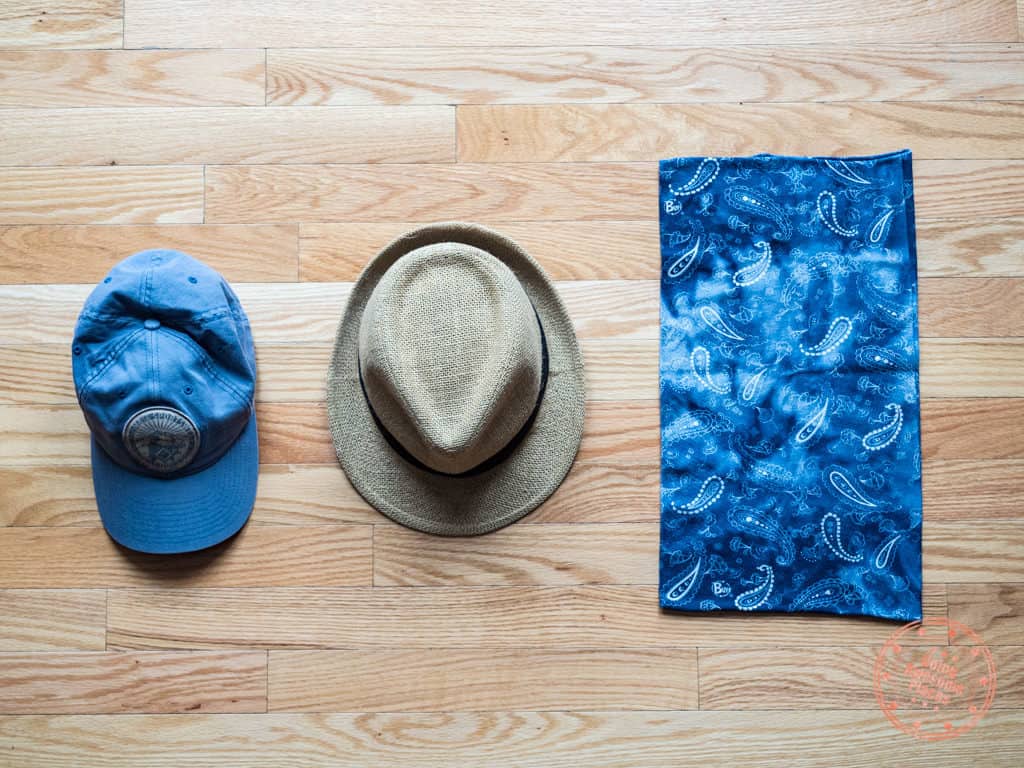
Okay probably a little bit extra but I brought two hats and a buff for this trip. The full-brimmed hat was what I was feeling for Egypt and something I was looking to use in photos.
- Columbia hat – You’ll definitely want a basic hat for a trip to Egypt with how much sun you’ll be facing.
- Full-brimmed hat – Functionally not the smartest thing to bring but wanted a bit of a different look for this trip.
- Buff headwear – Something I bring as a versatile piece of gear great for wiping sweat, as headwear, to clean things, or anything else you can come up with.
Lastly, is footwear. This is also another challenging part of packing because it’s easy to get carried away here and that can be a problem because shoes are very bulky. I may have gotten carried away here but here goes.
- Slippers – These are easy to throw in on the outside compartment of the suitcase. Thanks Marriott!
- Rainbow sandals – Useful to have to use in the hotel
- Keen Glenhaven shoe – A more formal shoe but is also good for hiking and is waterproof.
- Keen Explore Vent – In Merlot, this was my primary shoe for the trip and it did incredibly well. The fact that it was ventilated meant that my feet stayed relatively cool but that also did mean that sand could get in.
- Peak Design shoe pouch – A small accessory by Peak Design but nonetheless quite useful as a lightweight bag to store shoes while keeping your suitcase clean.
I won’t bother listing out everything that I have here but this is everything that I am able to fit in the Sea to Summit TravellingLight Hanging Toiletry Bag minus the Braun shaver.

The below are a few miscellaneous items packed as well that are going to be important for a trip to Egypt.

- Swiss Card – With knife and scissors removed, just a few items here that I keep in my kit in case.
- Nail clippers – You’ll definitely need these especially with how dry it gets in Egypt.
- After Bite – In-case especially for those that are easily bitten.
- Sun Bum 50SPF sunscreen – There’ll be LOTS of sun.
- Strepsils – I get sore throat easily so a pack of these is always in my bag.
- Hand-sanitizer – Always handy to have especially at restaurants and spontaneous snacking.
The usual important travel documents and cards should be packed.

As far as other personal items, these are some of the things that were usually on me or in my pocket.

- Croakies eyewear retainer – Not the coolest accessory I have but almost mandatory because I always have to take off my sunglasses to use my camera and I’ve dropped my sunglasses way too many times clinging to my shirt collar.
- Maui Jim Chee Hoo sunglasses – As I’ve said many times before, once you go Maui Jim, you can’t go back.
- Burt’s Bee’s lip balm –
- Sea to Summit wallet –
- OCS dive watch – Not that we were going to be diving on this trip but this is my only rugged sports watch so it usually comes with me.
- Travel insurance paperwork – Using Kanetix , I purchased another year of multi-trip annual travel insurance and this slip is just a small “cheatsheet” of my policy and coverage provided by Allianz.
- iPhone 11 Pro – A recent upgrade of tech that has been totally worth it. The extra battery life and wide angle lens has been so incredibly useful for travel.
For this trip to Egypt, extra gear had to be packed because I knew that I’d be filming video as well. That said, most of what you see here are part of my standard photography and videography kit.
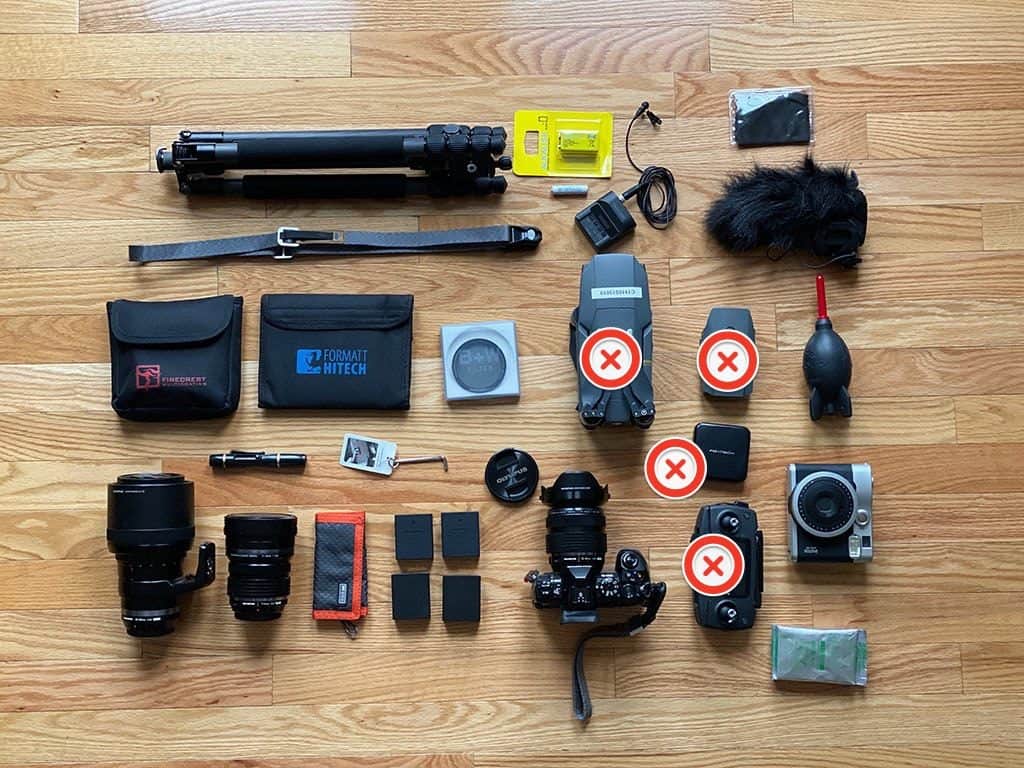
Starting from the top and working my way down:
- Sirui T-024X carbon fibre tripod – With the Peak Design tripod not out yet until December 2019, I still travel with this lightweight tripod.
- Ikea 9V battery – I’ve learned over the years to always bring backup batteries. This is for the shotgun mic.
- Eneloop AAA battery – This is a backup battery for the lav mic.
- Olympus microfibre cloth
- Peak Design Leash – While I don’t use this very often, in situations where I need my camera to sit around my neck, this is always available in my backpack.
- TASCAM DR-10L portable lav – Not something I normally bring but I knew I needed something to record good audio for interviews.
- Rode VideoMic Pro – Shotgun mic for those same interviews as better back up audio.
- Formatt Hitech filter set – This is primarily used for long-exposure photography and consists of the Elia Locardi Signature Edition set.
- B+W circular polarizer filter – Great for sunny skies and water reflections from the Nile.
- Giottos Rocket Air Blaster – With all the dust and sand from Egypt, this is something that you’ll need to clean your lenses.
- Lenspen – Another lens cleaning tool.
- Olympus 4o-150mm lens – Telephoto lens that I envisioned to be using it for portrait photos and from the Dahabiya.
- Olympus 7-14mm lens – Wide angle lens especially for the temples and pyramids we’d be close up to.
- Think Tank Photo SD Pixel Pocket – Memory card carrier with tons of SD and MicroSD cards.
- Peak Design hex key –
- Extra batteries for the camera
- Olympus OM-D E-M1 Mark 2 – My primary camera body for photo and video for the past 3 years and honestly the perfect set up for someone like me.
- Olympus 12-40mm lens – This is the lens attached to the camera body.
- Instax Mini90 – I brought this for kicks because I knew we’d be travelling with friends and this is a great way of creating mini memory keepsakes.
- Extra film for Instax
What about the drones? Well I planned on bringing them to Egypt but on the night before, I did some research to find out what the rules were and it turns out that drones are completely not allowed in the country. As I dived deeper into research, there were many stories of drones being confiscated at the airport, never to be seen ever again because of the hoops they’d put you through to get them back from the airport.
This is the last section of this Egypt packing guide and we get to some of the electronics that I brought with me on the trip. While a laptop certainly isn’t necessary, I usually bring mine because I can do work if something arises and it also allows me to back up my photos and edit photos on the fly much more easily than through my phone. The Tech Pouch is also another key part here and I basically don’t travel without it now because it keeps all of this gear nice and organized.

Starting from left to right:
- Apple 13″ Macbook Pro (2018) – Powerhouse machine that I use for all of my blogging and vlogging content creation.
- KableKard – A Kickstarter project out of Singapore that I usually have in my Tech Pouch that’s handy for storing SIM cards, adapters, SIM card pin tool, and also acts as a stand.
- Samsung T5 2TB SSD – The perfect external hard drive where I store all of my photos and videos. I back up my photos onto here as the trip goes on.
- Various adapters – The reality of things with Thunderbolt/USB-C.
- Anker PowerCore II 10000 – While the iPhone 11 Pro has excellent battery life, this is a good back up incase of heavy usage.
- Apple AirPods – Primarily for watching Netflix on the plane.
- Pen – For filling out custom forms
- Business card holder
- Power blocks for the Macbook Pro and iPhone
- Ultimate Ears UE900 – Old earbuds that I use for airline entertainment systems.
- Peak Design Tech Pouch – I do a full review and breakdown of the tech pouch . This is a great organization system especially when you have a lot of small gadgets that need to be kept together. This bag is perfect for all the things you see above (minus the laptop of course).
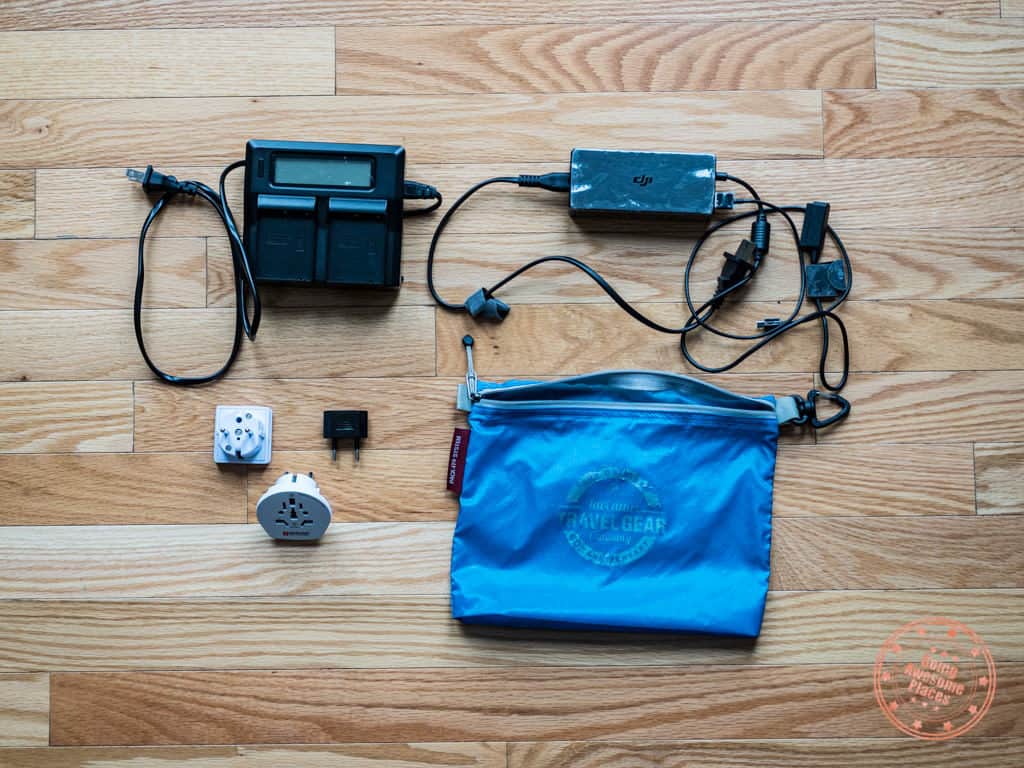
Lastly are the various chargers for all of the camera gear and electronics for the trip. Of course, the big DJI charger to the right was removed because the drone didn’t come with me.
- Dual charger for the Olympus OM-D E-M1 Mark 2 – Since I go through at least 2 camera batteries a day, single battery chargers just don’t cut it anymore so having a dual charger is mandatory.
- European outlet adapters – Got a bunch here but the most best of the bunch is the Skoss Europe adapter . That said, the outlets in Egypt don’t have the circular receptacle that you find in most parts of Europe so even something as simple as the black one here work fine.
- Eagle Creek sac – This is an all-purpose travel pouch (medium size) that I turned into a bag for my chargers.
- Bug spray – We knew October wasn’t mosquito season but just in case
- Bag for single day clothes – Something I learned to do is always pack a separate bag that comes with you with an additional day’s worth of clothes in case the airline loses your bag.
- GoPro – Since I had to pull out the drone, I ended up replacing it with my GoPro Hero 5 , grip , battery and charger
Real-life feedback from the trip

So of course all the photos were taken prior to going to Egypt but thinking what you’ll need is often different from what you end up using or realizing you wish you had on a trip. So the below is a quick breakdown of the things that I picked up on from our 10 day trip to Egypt .
- Sunscreen – At one point we thought we’d run out but between the two of us we were constantly applying and re-applying especially on those intense days in Cairo and Luxor where there was no cover at all and we were bouncing between ancient sites.
- Sunglasses – Goes with the sunscreen above
- Long-sleeve shirts – The warmer layer is helpful but what I wanted to say here is that most people on the Dahabiya put on their nice clothes for dinner and so it was actually good that I packed a few nicer long sleeves for the evening.
- Half-zip fleece – Now I don’t mean to say that a lot of warm layers are needed but the Dahabiya does get cold at night and at sunrise when I was on the deck so I either threw this
- Hand sanitizer – You’ll get super hungry on those long days in Cairo and Luxor so this is good to have when you want to snack in the car or while on the go.
- Hats – A must-have. The sun is so intense in Egypt.
- Peak Design 5L Sling – So thankful that I had this with me on this trip. I don’t know if it was heat exhaustion but at times when I had the heavy backpack, it was really slowing me down. The 5L Sling was perfect for those situations where you’re running out of the van or Dahabiya to see something.
- Sandals/flip-flops – Let’s just say we had a unique bathroom situation in Luxor with our “open concept” bathroom.
- Imodium – Unfortunately I and a few others did end up getting some stomach issues along the way so always come prepared.
- Chapstick – Glad I had mine as I definitely felt the dryness almost immediately when arriving in Egypt.
- Moisturizer – Whether it’s hand, face, or body moisturizer, you’ll need it all. For some reason my fingers started getting extremely dry and resulted in hang nails and peeling skin.
- Telephoto lens – I used this a handful of time while on the Dahabiya because we had more free time and I could shoot animals and fishermen along the Nile but while we were in Cairo or Luxor, there was never a moment where it made sense to lug it around since I was mostly travelling with the 5L Sling while the Travel Backpack stayed in the van.
- GoPro – This has always been the issue with the GoPro where it’s only useful for water-related activities and POV type of shots.
- Peak Design Neckstrap – The only scenario where I thought I could’ve used it was on the camel but because of how rushed the whole thing was, the 5L Sling ended up being ok.
- Sports towel – We use this after taking a dip in the Nile but we totally could’ve just used the Dahabiya’s bath towels.
- Formatt Hitech long exposure filter kit – Didn’t get any use at all because there just weren’t any opportunities to do any serious shooting
- Windbreaker jacket – This stayed in the suitcase the whole time because the half-zip fleece was the only thicker layer I needed.
- Tank tops – It was hot but considering the more conservative dress in Egypt, it was just never a good idea.
- Hiking socks – Those thick hiking socks I had to wear because I was running out at one point but they were just a bit too thick in this climate. Stick to the low-ankle, thin socks if you can
- More European plug adapters – We managed to charge all of our different devices since I had my laptop but with 4 outlets in the Dahabiya cabin, I think we could’ve used another adapter to charge more devices while the power was on.
- Toilet paper – More for the ladies or #2s but you’ll find that most public bathrooms will not have any toilet paper so it’s a good idea to have a roll or tissue paper packs with you
- SPF Chapstick – In retrospect, SPF protection on the lips would be helpful to have.
- Headlamp – Not absolutely necessary but with power out on the Dahabiya, this can be useful although I just ended up using my phone’s flashlight.
- More cash – We certainly underestimated how much cash we needed for this trip. We budgeted $500 USD in cash for the two of us but ended up converting some extra CAD we had with us to supplement. What you’ll end up spending more on is not so much the shopping but the tipping. More on this on the Egypt 10 day itinerary .
- Snacks and granola bars – Our time in Cairo and Luxor was amazing but we had to skip a ton of meals because our schedule was that packed. I’d recommend packing a bunch and keep them in your backpack or in a bag in the van.
What to Wear in Egypt

Something that’s worth noting in this Egypt packing list is a breakdown of whether there’s a “dress code” in Egypt. Even as a seasoned traveller, you’ll want to tailor your packing to the country and make sure you’re respecting customs and dressing smart.
Let’s dive into what to wear in Egypt.
The combination of hot climate and conservative Muslim culture makes it challenging when deciding what to wear in Egypt. You’re probably wondering, “can I wear shorts?”, “are dresses ok?”, “are sleeveless shirts allowed?”, and “do I need to cover my hair?”
In general, Muslim culture is conservative so the overall rule of thumb is that you should limit the amount of skin you show and curves especially if you’re a woman. That said, the question I’m sure you’re asking is “how much” you should limit your skin showing? Legit question!
For travellers to the country though, there’s no imposed Muslim dress that’s applied and so when you’re trying to figure out what to wear and what to pack in Egypt, it’s all about dressing for comfort but also not blatantly being rude.
As a woman, do you need to cover your hair or wear a hijab? – The answer is no. There are some thoughts that as a solo traveller it’s a good idea especially if you’re travelling without a guide in the big city but as a non-Muslim, it’s not something that people will impose on you. At the end of the day, wear what’s comfortable for you. The only exception is when visiting mosques where you’re expected to cover yourself up with a scarf.
Do you have to wear long sleeves? – No absolutely not. With such hot climates, you’ll want to wear t-shirts but the part you want to know about is whether tank tops and anything revealing shoulders or cleavage is okay. Showing elbows isn’t a problem. Tank tops revealing your shoulder is frowned up and you’ll probably get some looks but that’s certainly not to say that I didn’t see people wearing this.
Can you wear shorts or capris? – For women, it’s expected you cover your knees so capris are perfect. I’ve read that shorts are okay for men but it’s still preferable to cover the knees and so capris are perfect. What you wear instead should be also then balanced by what you’ll be looking for in terms of sun cover and keeping your legs clean from the sand and dust.
Are tight clothes ok? – There’s no rule here for this but again especially if you’re a woman that you’ll get looks and unwanted attention if you do but a lot of that is because you’re a foreigner. On my latest trip to Egypt, I saw tons of locals wearing tight jeans and ripped jeans as well so those styles have definitely made their way over. Just like the above, use your best judgement here. Loose clothing has the benefit of not drawing too much attention but also helping you stay cool.
Are flip flops and sandals allowed? – Actually most locals wear these so you’re in the clear. I did want to point out that one thing to consider about any type of sandals or flip flops. I didn’t wear them while on the road (mine were exclusively used in the room as slippers), because I didn’t want to be covered in dust and sand. On the Dahabiya this means rinsing your feet every time you get back on the boat but of course the advantage being that you have full ventilation while you’re exploring temples or walking through a village.

The truth of the matter is that while in large crowds and throughout our entire trip to Egypt, I saw people dressing the whole range of clothes. No matter what you wear, when you’re walking through the street of souvenirs, you’re going to get hassled and it’s not because of what you’re wearing but because you’re a tourist.
Dressing respectfully is a good idea but as you’ve seen from my recommendations above, a lot of it is paired with being smart with the climate.
The other thing to consider is that you’ll most likely be travelling through Egypt fully guided like we did. If that’s the case, you’ll never be put into situations where you’ll get awkward stares or aggressive attention. On the Dahabiya Nile cruise, it’s even more easy going because you’ll be spending a ton of time on the boat and on deck, you can wear anything you want.

For my latest trip to Egypt, I had two choices – I could either get a local SIM or use my Skyroam. Since our tour guide, Djed Egypt Tour, said that they’d be taking care of our data needs for us, I ended up leaving Skyroam at home.
When we landed in Cairo, we picked up a Vodafone SIM card at the airport. Their “tourist bundle” packages are pretty straight forward and are laid out below.

That said, I think we could’ve easily brought our Skyroam as well and used their day passes for unlimited usage that is also shareable with your friends and family because it’s a wifi hotspot and no SIM card is required. You can read my full review of Skyroam to decide for yourself whether it’s something you want to pick up before you go to Egypt.
(As a reader of Going Awesome Places, you can save 10% on Skyroam products by using the code SKYROAMINGAWESOMEPLACES !)
Alternatively, also take a look at the competitor to Skyroam which is Pokefi. Their starter bundle is $194 USD but by using code GAP24300 you save almost $25 USD off of that. It comes with an extra battery and 5GB of data already built in. For extra data packages, theirs is only $15 USD for 5GB which beats most other packages in the market. Watch my unboxing of PokeFi on YouTube !

Another top question that I had and what I’ve gotten the most questions about is “is Egypt safe?”. To answer that question will require another blog post . That said, I’ve been to Egypt twice post-revolution and on both trips I’ve always found Egypt to be safe .
Now does Egypt have some quirks in terms of being hassled by souvenir shop owners and locals finding creative and aggressive ways to ask for tips? Yes but unlike in Athens , I never felt like there were gangs of pickpockets or general thieves ready to pounce. It’s not that kind of country and the Egyptian people are very friendly and welcoming.
With that said, I never travel without travel insurance these days because you never know what might happen. Politically, Egypt is unstable and I’m not going to lie, there have been incidents in the country so even more reason to have at a minimum basic medical travel insurance coverage.
In Canada, I typically go through RATESDOTCA to make sure I can find the cheapest rates for travel insurance. Another place I’d recommend buying coverage is through World Nomads .
Have specific questions about your own Egypt packing list as you prepare for your trip? Don’t hesitate to drop a comment below and I’ll get back to you as soon as I can!
What you should read next
Le Meridien Bora Bora Overwater Bungalow and Resort Review Islands of Tahiti Packing List – French Polynesia including Bora Bora, Rangiroa, and Fakarava The Islands of Tahiti Travel Guide – What You Need To Know for French Polynesia
About William Tang
William Tang is the Chief of Awesome behind the award-winning Going Awesome Places which is focused on outdoor adventure, and experiential travel. His true passion lies in telling stories, inspiring photography and videos, and writing detailed itineraries and travel guides. He is a member of Travel Media Association of Canada (TMAC), Society of American Travel Writers (SATW), Adventure Travel Trade Association (ATTA), and Travel Massive. He has also been featured in publications such as Reader's Digest, Entrepreneur, Men's Journal, and Haute Living. Make sure to learn more about William Tang to find out his story and how Going Awesome Places started.
Find us on social media

What to Pack for Egypt (Simple Packing List)
Our simple ‘what to pack for Egypt’ trip list covers everything you need, from clothes and accessories tosuncare and electronics.
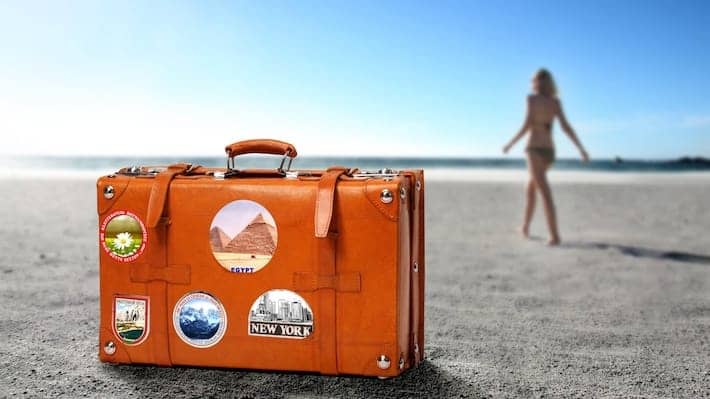
Packing the right belongings is essential when travelling, especially when you are visiting a new country with a different climate, culture, and morals. But don’t let that put you off. Egypt is a bucket-list-worthy destination with awe-inspiring sites and attractions. With the right Egypt packing list, you can enjoy all of Egypt in total comfort.
The What to Pack for Egypt List
Egypt is hot and bustling with activity. Carrying around a huge bag or struggling with too many clothes is going to make you tired and sweaty – and you might end up losing something important. So, the trick to packing for your first Egypt trip is to stick to the basics and avoid overpacking.
Besides, finding replacements is relatively easy in Cairo and other large cities in Egypt . You can find deodorant, sun lotion, phone chargers, water bottles, and more – so, don’t panic if you don’t have space in your luggage for all these items.
The real essentials are packing the right clothes, money, and travel documents, and booking the Egypt itinerary you’ve been dreaming of.
Design Your Custom Tour
The Simple Egypt Packing List
To avoid overpacking, here is our simple Egypt packing list. With your smartphone (make sure you have the right data roaming plan) and power adaptor, you can skip packing the heavy cameras and paper guidebooks… unless you want to take those too!
- Loose long pants or maxi skirts
- Shorts (ideally knee-length)
- Airy long-sleeve shirts and tops
- Short-sleeve tops and t-shirts
- Lightweight jacket
- Swimsuit or swim trunks
- Beach cover-ups
- Socks and underwear
- Scarf or head covering
- Breathable walking shoes
- Sunscreen lotion
- After-sun skincare
- Toothbrush and toothpaste
- Mini travel bottles of liquids
- Insulated water bottle with built-in filter
- Power adaptors
- Reusable day bag
- Mini first aid kit with bug spray
- Essential medications
- Photocopies of travel documents
What to Wear in Egypt
When packing your clothes for Egypt, there are two very important considerations: Egypt is hot and often conservative.
Covering your skin when entering religious buildings and sites is essential, and maintaining modesty, in general, can help you feel more comfortable traveling around the country.
Besides, did you know that covering your skin will help you stay cooler!?
Women’s Clothes
Choose light and airy clothes made from cotton and linen. Avoid polyester and other synthetic fibers that won’t let your skin breathe.
You can absolutely wear shorts and vest-style tops in Egypt; however, you’ll be battling sunburn and mosquitos at every corner, and you may feel uncomfortable with the attention you receive in crowded places. Covering up your skin with light, breezy long-sleeve shirts (a linen shirt is a fashion must-have) and choosing palazzo or wide-leg pants is an incredibly classy look for Egypt and will protect you from the sun.
For visiting beautiful religious sites and in some rural areas, you will be required to cover your hair and wear a long-sleeved top. So, pack a light cotton scarf and blouse that you can fold up small in the bottom of your daily bag. Then you can wear what you like, and still cover up when required!
Is There a Dress Code for Women in Egypt?
Egypt is a religious country where modesty is valued. As a tourist, especially in the modern and urban areas of Egypt, no one expects you to dress like the locals. You can wear whatever makes you feel comfortable. Just keep in mind that the summer clothes you wear at home may be a bad way to protect your skin from the Egyptian sun, and you may draw some unwanted attention if you are revealing quite a lot!
If you want to fit in and feel comfortable, a general rule is to make sure your arms are covered at least over the elbows, and your legs are covered past the knees. It is also more acceptable to wear loose-fitting clothes rather than skin-tight or fitted clothes.
The only places where dress codes are enforced:
- Religious sites (mostly mosques)
- Some private establishments (bars, clubs, restaurants, etc.)
- Private resorts (though these are typically tourist-oriented dress codes).
Men’s Clothes
For men, dress codes are more relaxed… but you’d be a fool to not take sun protection seriously. Pack cotton and linen shorts or airy pants, as well as cotton t-shirts.
Although men do not need to cover their heads when entering religious sites, packing a scarf may still be a good idea. You can soak a scarf in cold water and place this over your head to keep cool and protect from the sun, for example.
A light jacket may be nice for the evenings. You may also want to pack slightly more formal wear if you plan to dine in the hotel/resort restaurant.
Summer vs Winter Clothes to Pack for Egypt
Average temperatures in Egypt are hot, hot, hot. Most visitors come between October and April , with November and March being a good choice if you want to avoid the peak season ( December and January ).
The time of year that you visit Egypt will not drastically change your packing list. As we explored in our Best Time to Visit Egypt Guide, inland Egypt where you’ll find Cairo and many archaeological sites is incredibly hot all year round.
If you are visiting the Mediterranean and Red Sea coasts during winter (November to February) you can pack an additional jacket or cover-up for the evenings. But otherwise, our packing list is unchanging: stick to light and breezy cotton clothes that can be layered.
What Shoes to Wear in Egypt
The best shoes to wear in Egypt are tennis or sports shoes. You will be doing a lot of walking over different terrains, so your shoes must be comfortable, breathable, and protective. Avoid hiking and mountain shoes: even if they are comfortable, your feet will get too hot.
While you can wear sandals or flip-flops at the hotel, your feet will get dirty and sandy if you wear them for walking around. Wear cotton socks for extra breathability. Make sure you have some band-aids in your bag too!
Sun Protection
Although these items are either bulky, fragile, or heavy, they are essential for your ‘what to pack for Egypt list’.
Sunhat and Sunglasses
Choose a sunhat with a wide brim – preferably a floppy one so you can fold it up and carry it easily. A baseball cap is good for keeping the sun out of your eyes, but it won’t protect the back of your neck. As for sunglasses, the best pairs are rated UV 400 which provides total protection against UVA and UVB rays.
You can take an umbrella or parasol to create shade, but these are typically bulky and annoying to carry around all day. Wearing a hat will keep your hands free to take lots of pictures anyway!
Sun Lotion and After-Sun
Wearing sun protection is essential. Even if your body is covered, a correct amount of sun lotion on your face, neck, and hands is a must. You can buy sun lotion at the airport or once you are in Egypt, but if you want to make sure you get a specific lotion, it’s best to pack in advance. Always look for lotions with a high sun protection factor (SPF). SPF30 should suffice for most people, but if you burn easily then opt for SPF50.
The heat in Egypt is not at all humid – it’s desert dry everywhere but the Mediterranean and Red Sea coasts ! So, even if you don’t get burnt, your skin may still feel dry and tight. It can be relieving to apply a soothing after-sun care product at the end of each day. Choose one with aloe vera for an extra cooling effect.
Packing a Daily Bag for Sightseeing in Egypt
Once you are in Egypt, here’s what you need to pack in your bag each day as you explore:
- Scarf or head cover, for visiting religious sites.
- Sun lotion, to top up throughout the day or after swimming.
- Water bottle – preferably insulated so it stays cold for longer.
- Wallet with money.
- Photocopies of your travel documents.
- Extra space for souvenirs !
Use a backpack or other bag that has a hidden or zip-up compartment. Place your wallet and photocopied documents (travel visa, credit cards, ID, etc.) here – like with every major city in every country around the world, pickpocketing is always possible.
Unless you want to take photographs with a specialist camera, you’ll likely use your phone to record your adventures. So, another good thing to pack is a rechargeable power bank.
How Much Money Should I Pack for Egypt?
You can get by with $20 per person, per day – many establishments will prefer to transact in US dollars. That will cover basic food and transportation, plus a few trinkets. If you want to splurge on other luxuries, bring more.
If you’ve already got your itinerary sorted with Egypt Tours Plus , all your transportation is already paid for. Just bring enough money for tips (usually 5% to 10%), entrance fees, and all the souvenirs you see!
What Electronics to Pack for Egypt
Your smartphone should be capable of doing almost anything, including setting an alarm (many hotels won’t have an alarm clock) and helping you navigate. Remember to bring your phone charger and an adapter when you pack for Egypt.
Egypt uses rounded two-prong plugs with a 220-volt power supply. So, as well as an adapter for the plug socket, you might need a power converter. Check what power supply your home country uses and whether your devices will be compatible for charging in Egypt.
We also recommend printing off a map, the details of your hotel, important phone numbers, and the location of your country’s embassy to have on paper. Even if your phone dies in an emergency, you’ll be able to navigate safely.
How to Pack Medicine, Cigarettes and Alcohol for Travelling to Egypt
When you pack for Egypt, remember to bring any important medicines that you need to take. While you can find pharmacies across Egypt, not all medicines are available, and many will have different brand names.
There is no problem bringing most prescription, over the counter, and non-prescription drugs into Egypt for personal use. You may also want to bring Imodium, charcoal supplements, and anti-nausea medication if you usually fall foul of traveler’s tummy.
As for cigarettes and alcohol, both are available to purchase in Egypt, but you’ll find that the range available is limited. Egyptian cigarettes are much harsher than European and American brands. Likewise, Egypt has a lot of amazing wine and beer to try, but not much hard liquor.
So, for a specific brand of cigarette that you like, or hard liquors, it’s best to bring them with you or purchase them at the airport. You can bring up to 1 liter of alcoholic beverages and 200 cigarettes into the country in your Egypt travel bag.
What to NOT Pack for Egypt
You don’t want to be dragging around a heavy bag of unnecessary belongings. So, here are some things that we recommend you leave at home when you pack a bag for Egypt:
- Winter coats and heavy jackets (you only need a lightweight, foldable jacket).
- White clothes that will quickly show any dust, sand, and dirt.
- Jewelry and valuables that you’d be devastated if you lost.
- Full-size liquids – use the travel-size bottles for toiletries.
- Strong perfumes and fragrances, as they may attract mosquitos.
- Makeup products that will melt off quickly in the heat.
Prohibited Items to NOT Pack for Egypt (Avoid!)
When you travel to Egypt, make sure you don’t have any of these items in your bag. They are prohibited and will be removed at customs.
- Narcotics and illegal drugs.
- Firearms, ammunition, and general weapons.
- Bird products (including meat and eggs, frozen, live, and stuffed birds).
- Informational materials that are indecent (pornography) or incite hate.
- Cotton fiber (cotton clothes are fine!).
- Items that could be used for spying (e.g. a drone for taking photos).
Consult the travel advice by your country’s government for more info plus a specific and detailed list of the drugs that are banned.
Now You Know What to Pack for Egypt
One last note in our guide to what to pack for Egypt: check the travel luggage restrictions at the airport in your country! Make sure that everything you bring can be taken to Egypt and back again, without worry.
Next, choose your itinerary and follow our Egypt packing list to pack enough clothes and other essentials for your entire stay. We can’t wait to welcome you!
Design Your Custom Egypt Tour
Explore Egypt your way by selecting only the attractions you want to visit
CREATE YOUR DREAM TRIP
Egypt Packing List FAQs
Others often ask about:
Do I Need to Bring Toilet Paper?
You don’t need to bring toilet paper from your home country – hotels are typically well-stocked. Take some hotel toilet paper (or a pack of tissues) on excursions, as many public toilets do not always have toilet paper. You may also need some spare change to pay to use some public toilets.
Do I Need Bug Spray in Egypt?
There are mosquitos in Egypt, mostly at dawn and dusk, so you can pack bug spray if you like to use it. You should also avoid wearing strong fragrances and re-wearing sweaty clothes, as this can also attract insects.
Can I Wear Flip-Flops in Egypt?
You can wear flip-flops in the hotel or at a resort, however, closed-toe shoes are best for walking around and sightseeing. Tennis shoes will be breathable but protect your feet from the sun, sand, and dirt.
Can I Wear Jewelry in Egypt?
You can wear jewelry in Egypt – many locals do – but we don’t recommend taking anything valuable that could be lost or stolen.
Can I Take Paracetamol to Egypt?
Yes, you can take paracetamol and ibuprofen to Egypt for personal use. Don’t take more than you need. You can also purchase these basic medicines in stores across Egypt.
Can I Wear a Bikini in Egypt?
Bikinis are best left for tourist resorts on the coasts of Egypt, where revealing this much skin is a little more acceptable. A standard swimsuit should suffice for almost everywhere else. If in doubt, look at what other people wear on the beach or around the pool first!
Enjoy Your Vacation in Egypt Your Way!
Now that you know what to pack for Egypt, are you ready to experience its wonders? Start crafting and booking your dream Egyptian adventure with us today !
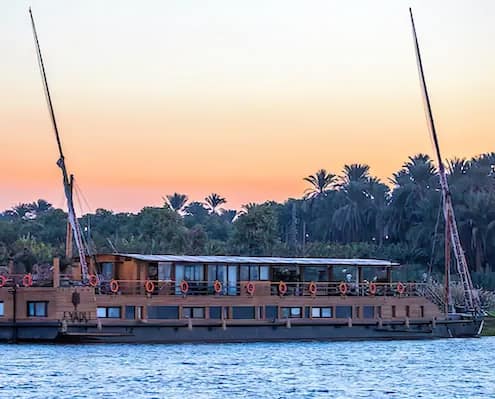
11-Day Dahabiya Luxury Cruise and Cairo
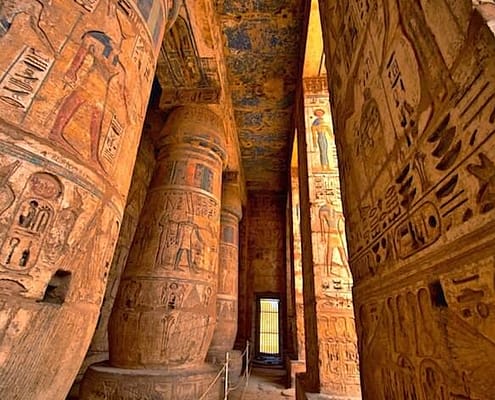
11-Day Egypt Luxury Small Group Tours – Cairo & Oberoi Zahra Nile Cruise
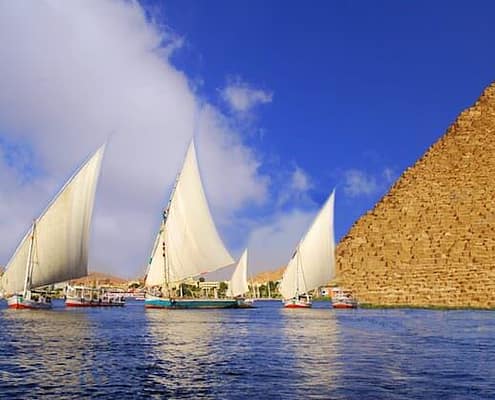
12-Day Cairo, Nile Cruise And Red Sea Stay
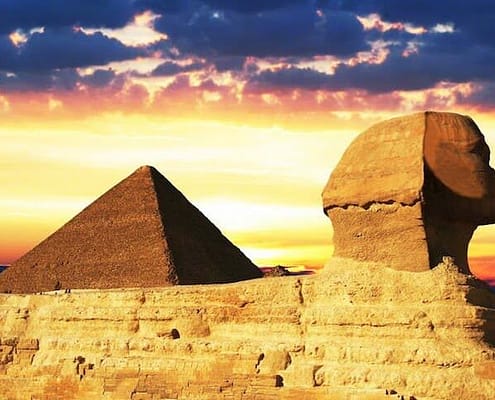
10-Day Luxury Nile Cruise and Cairo Tours
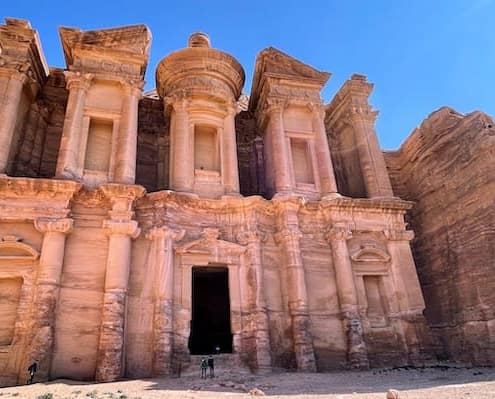
10-Day Egypt and Jordan Luxury Tours
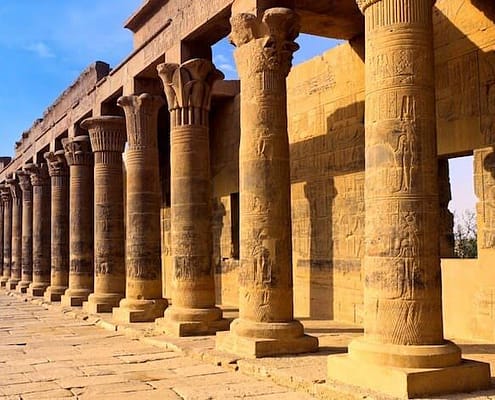
10-Day Egypt Overland Tour: Cairo, Aswan, Luxor, and Hurghada
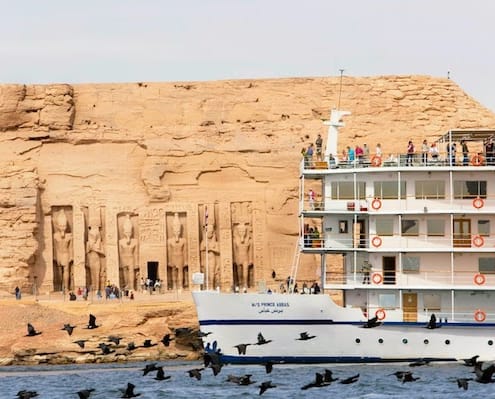
8-Day Cairo to Abu Simbel Tour w/ Nile Cruise
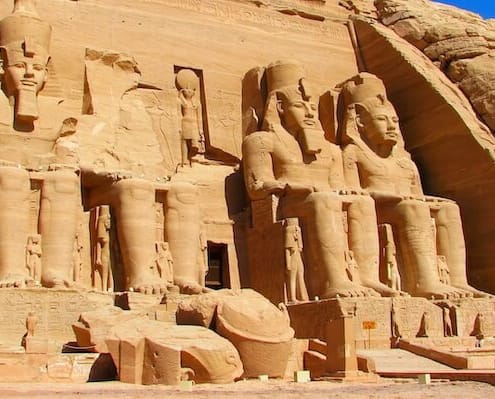
8-Day Cairo, Luxor, Aswan, Abu Simbel Tour
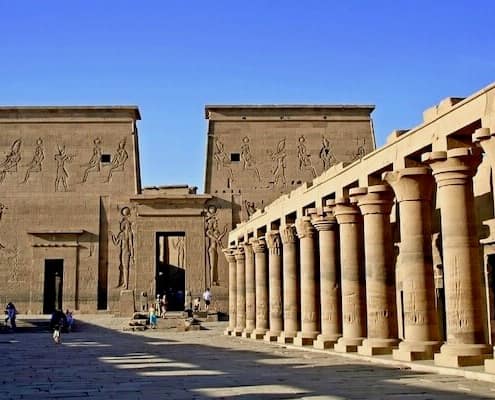
8-Day Best of Egypt Tour – Cairo and Nile Cruise [By Air]
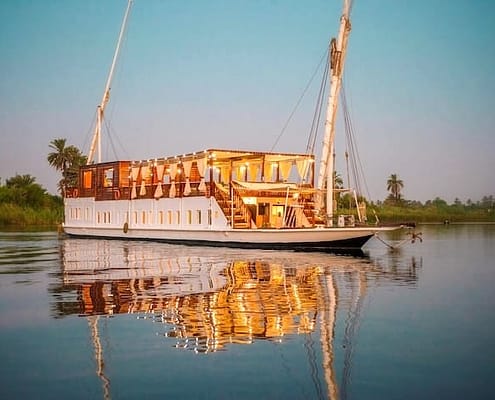
8-Day Luxury Small Boat Nile Cruise and Cairo Highlights Tour
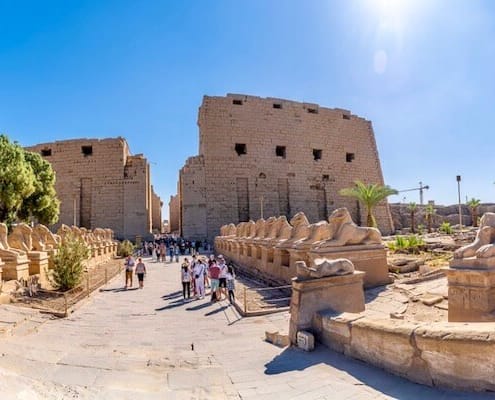
7-Day Ancient Egypt Tour [Small Group] Cairo, Nile Cruise
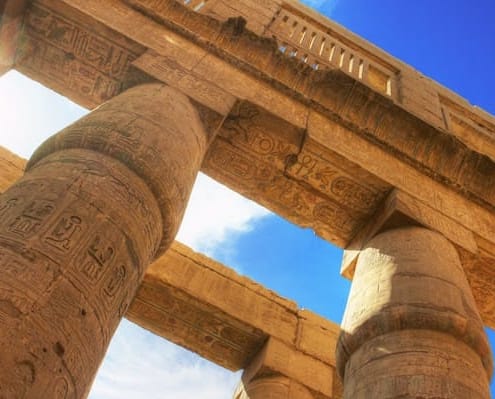
5-Day Cairo to Luxor Tour
Egypt travel information.
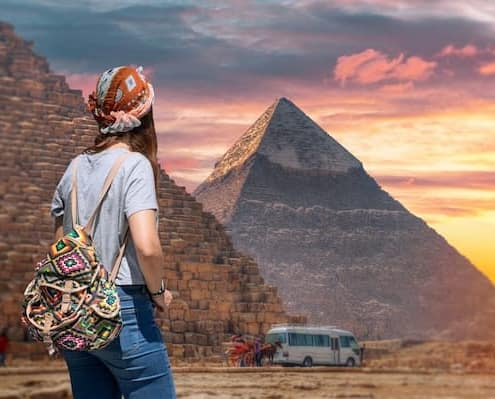
Full Safety Guide: Is It Safe to Travel to Egypt?
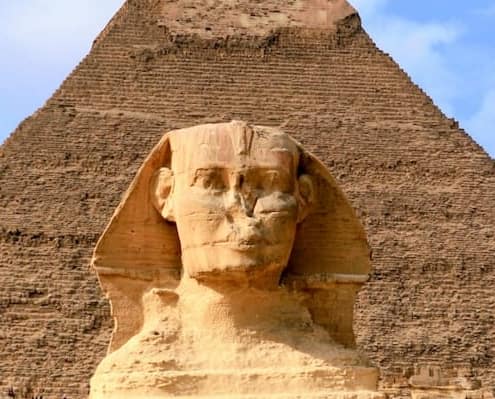
What are the Must Visit Places in Egypt?
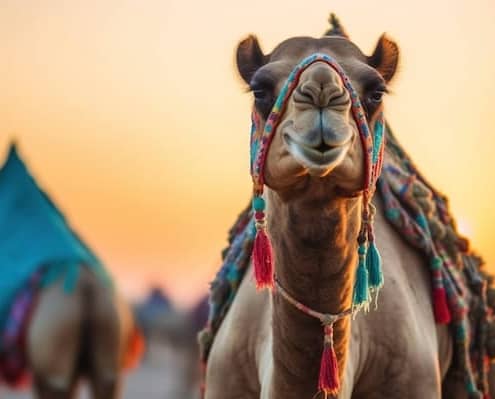
Egypt Travel Tips: This You Need to Know
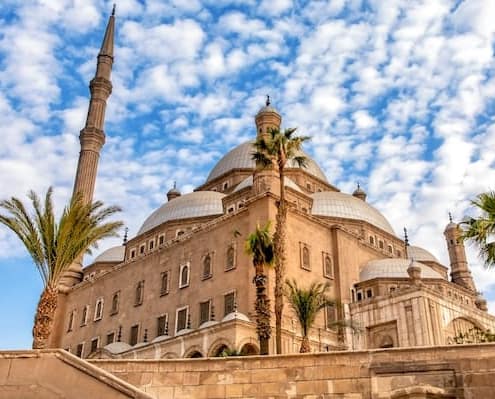
How to Plan a Trip to Egypt – Start Here!
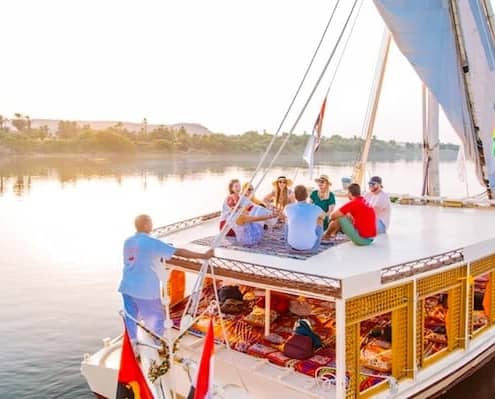
Best Time to Visit Egypt and When to Book!

Last Updated on March 25, 2024
You might also like

We Don't Just Sell Amazing Tours, We Make Dreams Come True!
Private tours since 1955.

Award-Winning Service
Create your dream trip.

The Ultimate Guide to Egypt: Dos and Don’ts Every Traveler Must Know!
W aving hello from the land of the Pharaohs , it's Kevin Erickson , your trusty travel companion. Ever dreamed of marveling at the Sphinx , floating on the Nile , or relishing in the historic hustle and bustle of Cairo's streets? Ah, Egypt, a majestic place! But, wait – do you know the etiquettes and local customs? Dive in as I unravel the treasures of Egypt and help you navigate potential pitfalls. 🌍
- Dress modestly and respect religious practices
- Greet, haggle, and tip like an Egyptian pro
- Stay hydrated, savor local delicacies, but know where to draw the line
- Relish history but respect boundaries
- Dive deep into the culture but keep American sensibilities in mind
Why Egypt Should Be on Every Traveler's Bucket List
According to the World Tourism Organization, Egypt welcomed a staggering more than 11.3 million tourists in 2018. A beacon of history, culture, and cuisine, Egypt promises a travel experience like no other.
Cultural Nuances: Navigating Egypt's Rich Tapestry
1. dress to respect.
Egypt's culture is an intriguing mix of modern and traditional elements. In religious and rural areas, dressing modestly is the key.
Women, consider long skirts or pants and tops with sleeves, while men might ditch the shorts.
Remember, dressing appropriately is not just about blending in, it's about showing respect!
2. Communicate Like a Local
Starting with a warm " As-salamu alaykum" can break many barriers. It’s an essential phrase that means "Peace be upon you".
Plus, trust me; locals appreciate it when you put in the effort.
3. Fun with Finances: Haggle and Tip!
Haggling isn't just a transaction; it's an art form in Egypt .
Dive into the vibrant bazaars, start with half the price, and let the dance begin! And when it comes to tipping, small gestures can bring big smiles.
4. Food, Drinks, and the Egyptian Way
Egypt offers a culinary journey that your tastebuds will cherish.
From falafels to koshary, there's a world to explore. And here’s a zinger for my American friends: while Egypt is a Muslim-majority country, alcohol is indeed legal and available in many restaurants, hotels, and bars.
However, remember: public drunkenness isn't just frowned upon—it can land you in hot water!
5. Dive Deep into the History, but Respect the Boundaries
Egypt is, as Anthony Bourdain rightly said,
" a unique fusion of civilizations, cultures, and religions. Traveling here is like walking through layers of history."
But remember, while the Pyramids might tempt you, climbing them is a big no-no. Let's keep history preserved!
From a Traveler's Eye: Kevin's Secret Tips
- The Nile - More Than Just a River - The Nile isn't just about those mesmerizing boat rides. Avoid swimming, especially near urban areas, due to pollution.
- Not Everyone's After Your Bucks - Sure, there are hustlers, but many Egyptians are genuinely warm. Embrace the culture, make friends, and you'll discover the true heart of the country.
- Step Outside the Tourist Spots - Discover Egypt's hidden gems. Beyond the Pyramids and Sphinx, there’s a whole world awaiting.
Embracing the Egyptian Adventure: A Final Word
The magic of Egypt is something that has enticed travelers for generations. Whether it's the mysterious allure of the Pyramids, the sprawling beauty of the Nile , or the vibrant tapestries of the bazaars, every corner of Egypt is a testament to its rich heritage and captivating culture. But beyond the visual spectacle, the soul of Egypt lies in its people – warm, welcoming, and eager to share their stories.
Traveling here is not just about checking off sites from a bucket list; it's about immersing oneself in a timeless narrative that has shaped much of the world's history. It's about understanding the delicate balance of tradition and modernity that Egyptians navigate daily. By respecting local customs and approaching each experience with an open heart, travelers can forge connections that transcend mere tourism.
Kevin Erickson' s insights and tips are crafted from a place of deep respect and admiration for this land. While the dos and don'ts serve as a practical guide, they also underscore a more profound message: Travel with empathy. Every "do" is an invitation to embrace and every "don't" a nudge to respect boundaries.
In conclusion, as you set out to experience Egypt, remember that it's a journey both external and internal. The monuments will leave you awestruck, the cuisine satisfied, but it's the memories made and the friendships forged that will truly stand the test of time.
So here's to Egypt – an eternal story waiting for your chapter. Safe travels!
What currency should I carry in Egypt?
Egypt uses the Egyptian Pound (EGP). While major cities and tourist areas accept credit cards, it's wise to carry some local currency for smaller vendors, tipping, and haggling in bazaars.
Do I need any vaccinations before traveling to Egypt?
It's recommended to consult with your healthcare provider before your trip. Common vaccines suggested for Egypt include Hepatitis A, Typhoid, and Yellow Fever, especially if you're planning to visit rural areas.
Is English spoken widely in Egypt?
While Arabic is the official language, English is widely understood and spoken, especially in tourist areas, major cities, and by younger generations. However, it's always appreciated if you learn a few basic Arabic phrases.
Are there specific cultural or religious festivals I should be aware of?
Yes, Egypt has several religious and cultural festivals, the most notable being Ramadan, a month of fasting. During this time, many shops and restaurants may have altered hours. Eid Al-Fitr and Eid Al-Adha are also significant festivals with grand celebrations.
Is vegetarian or vegan food easily available?
Yes, Egyptian cuisine offers a variety of vegetarian and even vegan-friendly dishes. Staples like falafel, koshary, and molokhia are both delicious and vegetarian-friendly.
How do I get around within the country?
Egypt boasts a range of transportation options from trains, buses, and domestic flights to more local means like tuk-tuks and horse-drawn carriages. For major attractions like the Pyramids, it's often convenient to hire a taxi for the day or join a guided tour.
Is the tap water safe to drink?
It's advisable to stick to bottled water in Egypt, both for drinking and brushing your teeth, to avoid any potential stomach upsets. Always ensure the bottle seal is intact when purchasing.
- World Tourism Organization
- Egyptian Tourism Board
- "Parts Unknown" by Anthony Bourdain
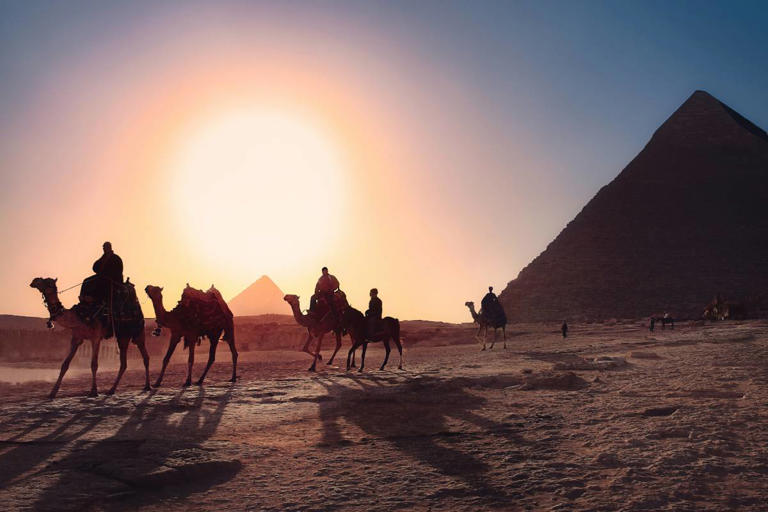

26 Top Egypt Packing List Items for 2024 + What to Wear & NOT to Bring

Egypt is renowned worldwide as a land brimming with ancient history and culture. From the Great Pyramids of Giza to the bustling city of Cairo, any trip to Egypt is sure to be packed with excitement. Though this region has warm to mild temperatures year round, its religious roots require more conservative dress. This can make things a bit tricky when it comes to knowing what to pack!
To help you out, we’ve put together this complete packing list with what to wear in Egypt , what NOT to pack, and answers to all your top Egypt frequently asked questions.
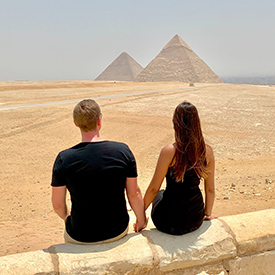
What to Pack for Egypt – 26 Essentials
1. egypt power adapter.
If you’re coming from North America or countries outside of the Middle East, you will need a power adapter to plug in your electronics while in Egypt. This universal power adapter will have you covered in Egypt as well as in 100+ popular countries throughout the world. With a built-in fuse protector, you won’t risk your phone or camera on shotty outlets. Plus, it comes with a lifetime replacement guarantee!
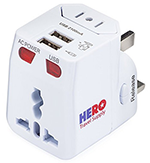
View on Amazon.com ➜
2. Pashmina Shawl
A pashmina shawl is an invaluable item to bring with you on your trip to Egypt. Whether you’re entering a holy site or mosque and need to cover your head or shoulders or just want to wear it as a wrap on a chilly evening, you’ll be glad you packed one! I also use it as a seat cover, packing cushion, picnic blanket, etc.
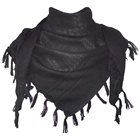
3. Virtual Private Network (VPN)
In the wake of several Egypt cybersecurity attacks – A VPN is beneficial for for travelers going abroad. Use it to prevent hackers from stealing your sensitive information whenever you’re connecting to Wi-Fi in public places (like hotels, restaurants, coffee shops, airports, etc.) It will act to mask your IP address for a truly private connection. We learned the importance of this first-hand when my credit card number was stolen from an Airbnb in Paris.
A quality VPN will also grant you access to websites from home that may be geo-blocked or censored by the host country. We use NordVPN because they offer unlimited data, faster streaming, no pesky ads or pop-ups, and an extensive server network to choose from (more than 6,000 servers in over a 100 countries). They also offer a no-logs policy for an anoynmous IP address, which is invaulebale for privacy-concious users.

View NordVPN.com Options ➜
4. Neck Wallet
A neck wallet is a total game-changer in any destination that’s particularly touristy or crowded. Between strolling through the markets in Cairo and visiting the iconic pyramids, you’ll likely find yourself surrounded by crowds and tourist traps. Wear a neck wallet tucked beneath your shirt to secure your passport, wallet, credit cards, and smartphone against pickpocketing and petty theft.

5. Water Bottle with Built-in Filter
Though the tap water in Egypt is not safe to drink, you won’t want to keep shelling out money for bottled water. Plus, single-use plastics are awful for the environment. Instead, use this reusable Grayl water bottle that comes with a built-in filter so you can ensure the water you’re drinking is safe. This one is a little pricey, but it’s worth it to us for top-quality filtration that removes harmful bacteria, pathogens, viruses, chlorine, sediment, dirt, microplastics, and more.

6. Travel Insurance for Egypt
There is almost nothing more important for your Egypt trip than reliable travel insurance. Travel in Africa can be unpredictable, and you’ll need to make sure you’re covered in case of a medical emergency, lost luggage, evacuations, flight cancellations, theft, rental car issues, etc.
Faye has beat out any provider we’ve worked with because they add that rare ‘human’ touch to insurance. As the first 100% digital provider, their 24/7 support is like having a travel concierge in your pocket. Claims are handled through their mobile app for efficient reimbursements, and we’ve never experienced hidden fees with them. They also have affordable add-ons like ‘adventure & extreme sport’ and ‘trip cancelation for any reason,’ which can save you a ton in the long run.
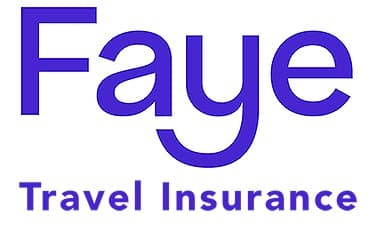
Get a quote in less than 60 seconds with Faye ➜
7. Packing Cubes
Make your life easier by using packing cubes for your trip to Egypt. These travel organizers will help you avoid overpacking and stay in order so you won’t have to dig through your luggage searching for your last pair of clean socks. Simply label each cube (tops, bottoms, shoes, essentials, etc.), and you’ll love that this set includes extra cases for shoes and laundry!

8. Jet Lag Relief
If you’re visiting from North America, Egypt is a long way from home! Avoid the unpleasant symptoms of jet lag by taking these homeopathic jet lag relief pills. They work as both a prevention and a cure and will keep you on your feet during the first day of your trip. We like that they’re formulated with chamomile and other botanicals rather than the caffeine and stimulants of similar products.
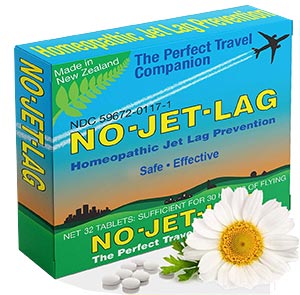
9. TSA-Approved Luggage Locks
We never travel without these TSA-approved luggage locks. You can usually trust your checked luggage to arrive intact, but we learned first-hand that things can be stolen from your suitcase when it’s not in your possession. Keep these locks handy for bags, backpacks, lockers, or to leave things in the hotel as the cleaning staff comes through.
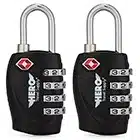
10. Lipstick-Sized Portable Charger
You don’t want to be stuck in Egypt without access to your smartphone since you’ll be relying on it for communication, navigation, or photos. We’ve dealt with a dead battery at inconvenient times (when stranded far from the hotel, unable to call for a ride or help). Now we travel smarter by tossing this lipstick-sized portable charger in our daypack. You can quickly charge up your devices while you’re out and about.

11. Luggage Straps
Don’t allow your weak zippers to sabotage you! I’ve seen plenty of suitcases bust open mid-transit due to rough mishandling or the crazy conveyor belt system at the airport, which shows no mercy.
Baggage loss or damage is actually way more common for international trips (happening about 800% more than for domestic trips). I reinforce my luggage using these adjustable straps that can withstand more than 700-pounds of force tension. They offer support to keep the zippers shut, the retractable handle in place, and the weight centralized. I also get through baggage claim way faster since my colors are easy to recognize from afar. With heavy-duty belts and a lightweight design, they’re backed by a lifetime replacement guarantee, so you can trust the quality craftsmanship.

12. Quick-Dry Travel Towel
If your accommodations don’t provide a towel, or if the towel provided is unclean, you’ll be glad you packed your own lightweight, compact, microfiber travel towel. This one is great because it dries 10x quicker than cotton and isn’t bulky and heavy like a regular towel.

13. Mosquito-Repelling Wristbands
Mosquitos are relentless and you’ll find them extra ravenous here in the summertime. Egypt does not generally have cases of malaria, but they do face other mosquito-borne illnesses like dengue, West Nile virus, etc., so play it safe with mosquito-repellent wristbands. These are deet-free, which means they’re safe for kids and you’ll be protected without choking on harsh chemicals all day.

14. Cooling Towels
Rainfall is almost non-existent in Egypt, and the high temperature in the Sahara Desert can reach 120°F/49°C. Beat the heat with a set of cooling towels. These magical babies drop to 20-30 degrees colder than the outside temperature, staying cold for up to an hour! Simply add water and enjoy the chilly, refreshing sensation wrapped around your neck or head (when the effect diminishes, just add more water). We never travel to warm destinations without these and can’t recommend them enough.
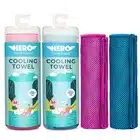
15. Long Skirt
It’s important to be respectful of cultural norms during your time in Egypt. That means women should be sure to cover their knees, shoulders, and everything in between! The weather in Egypt can get HOT, so a long flowy maxi skirt is the way to go as far as blending in and keeping cool.
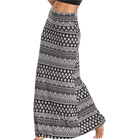
16. Daypack
As you’re spending the day strolling through the streets of Cairo or cruising down the ancient waters of the Nile, you’ll definitely need a daypack to carry everything you need with you. This pack is durable and large enough to hold your camera, jacket, snacks, sunscreen, and anything else you might need for exploring. Plus, it’s super lightweight and folds into its own pocket when not in use.
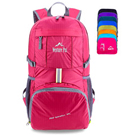
17. Discounted Tickets to Egyptian Attractions
Get Your Guide is our preferred booking service for local tours that are reputable and authentic. Since you can read reviews and cancel within 24-hours of your tour, you won’t get caught in a lackluster experience or be limited to an inflexible itinerary.
While in Egypt, you absolutely must discover popular antiquities like the Giza Pyramids and Sphinx of Cairo , and the Luxor Valley of the Kings . A river cruise down the Nile is also a fan favorite, with options for dinner cruises or 3-day journeys .
Outdoor fanatics will love snorkeling through the Blue Hole National Park or stargazing in the Hurghada Desert . And if you have the time, we recommend day trips to historical Alexandria , tropical Marsa Alam , or the magnificent Abu Simbel Temple (built in 13th century BC).
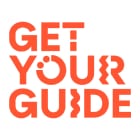
See all Egypt attractions at GetYourGuide.com ➜
18. Modest Swimsuit
There are tons of stunning beaches to hit in Egypt (Naama Bay, El Gouna, Dahab Lagoon, etc.), but keep in mind that 90% of the population is Sunni Muslim. The dress code is considered much more conservative than Western attire, so a modest swimsuit is best. Dressing appropriately will make your hosts and the new people you meet feel more comfortable and at ease with you, which will lead to a better time for all involved!

19. Activated Charcoal (Food Poisoning Remedy)
It’s important to be extra cautious of food and drink in Egypt, as cleanliness standards might not be up to what you’re used to at home. Travelers commonly get sick because the bacteria is completely different than that at home. So if you feel like you might have eaten something that doesn’t agree with you, take these activated charcoal tablets to quickly expel the toxins in your system to keep you from getting sick.
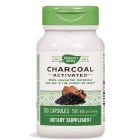
20. Hanging Toiletry Bag
Egyptian bathrooms can vary from resorts to Airbnbs to rustic sites. But one commonality is the general lack of countertop space. Plan ahead for limited storage with this hanging toiletries bag. It has 4 giant pockets that hold more products than you would imagine, neatly folded up into a compact case. We haven’t had any luggage leaks or spills since using these, and you can hang it on any door, hook, pole, branch, etc.
It’s made by Eco Sun, an awesome woman-owned brand based in Hawaii that supports female education and environmental sustainability. Their products are thoughtfully designed and made to last – they come with a lifetime guarantee to prove it! If anything goes wrong with your hanging toiletry bag, you can send it back, and they’ll replace it at no extra cost.

21. TSA-Approved Toiletries Bottles
Don’t forget that TSA will require bottles under the 3.4-ounce at the security checkpoint. Any liquids, gels, creams, and pastes need to be in travel-sized bottles, or you will be asked to throw them out. We favor these silicon tubes since they have a 3-layer leakproof design and are super easy to fill up.

22. Electrolytes
When you’re spending long days adventuring in Egypt’s dry desert heat, it’s important to keep hydrated! Add some of these electrolytes to your drinking water to help your body absorb the vitamins and nutrients you need. Electrolytes will also come in handy to soothe a hangover or to help get over food poisoning, boosting your hydration significantly faster than water alone would.
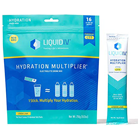
23. Deodorant Wipes
Instead of feeling sticky and icky while discovering the best of Egypt, use these deodorant wipes to keep smelling your best. I find them incredibly refreshing since they use pre/probiotics to restore the skin’s natural barrier and reduce odors. They’re pocket-sized wipes in individual packets, so you can throw a few in your daypack and wipe down freely to get rid of any funk. You’ll feel a lot better and your travel partners will thank you!

24. Maxi Dress
The land of ancient history and majestic pharaohs is also one of the best hot-spots for nightlife! You’ll be enjoying dinner cruises, the opera house, the sound & light show at the Giza Pyramids, discotheque clubs, and more – so bring at least one gorgeous evening dress for nights on the town. This one is long and modest but still fitted for a flattering silhouette. It’s thin enough material that you won’t overheat, and the built-in pockets are just the cherry on top!

25. Sturdy Sandals
Skip the blister-inducing and sweaty shoes that will only slow you down. Instead, opt for breathable sandals that suit the arid climate of Egypt. These are very cute and lightweight yet still offer plenty of support with a shock-absorbing sole. I also like that they’re quick-drying if you get any water on them, and they have enough traction for slippery or muddy areas.

26. Packable “Just in Case” Bag
We recommend avoiding the tourist trap of crappily made souvenirs (typically sold near the pyramids or in tourist bazaars). But! So long as you stick to reputable workshops and retailers that sell authentic goods, there are SO many gorgeous things you will want to take home (for yourself or as gifts for loved ones).
Treat yourself to the likes of Egyptian perfume, Papyrus, textiles, handmade jewelry, spices, inlay work, and precious stones . This “just in case” bag counts as your personal item for the flight home, making it easy to do a little shopping without paying double fees on your checked luggage.
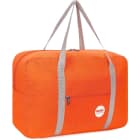
Other Egypt Packing List Items
- Travel Neck Pillow
- Motion Sickness Relief
- Protein Bars
- Swimsuit Cover Up
- Hiking Shoes
- Compression Flight Socks
- Steripod Toothbrush Cover
- Makeup Remover Wipes
- Hanging Toiletry Case
- TSA Approved Travel Size Bottles
- Travel Sheet
- Contact Solution
- Noise Cancelling Headphones
- Passport Photos
- Over the Counter Medications
- Hard Copies of Vital Documents
- ATM or Debit Card without International Fees
What to Wear in Egypt
Expect daytime temperatures in Egypt to be mild to hot throughout the year, while cooling off a bit at night. Keep in mind that Egypt is a Muslim country, which means more conservative dress than you’re used to will be required. Despite the heat, avoid shorts and tight or revealing clothing, and instead opt for loose, flowing pants, skirts, and shirts everywhere you go.
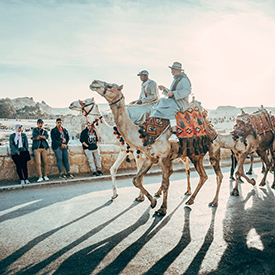
Women in Egypt’s big cities, like Cairo and Alexandria will often opt for more modern, westernized dress, while still keeping with conservative customs of covering their shoulders, chest, and knees. At more touristy resorts and beaches, you’re free to wear shorts and bathing suits, though you still might be a bit uncomfortable on the streets with men catcalling and yelling at you. Throughout the country women are expected to dress more conservatively, so try your best to respect the culture both to blend in and for your own safety. What Should MEN Wear to Egypt? – (Click to expand) Below is a sample men’s clothing list. (All items link to Amazon.com for your convenience).

Packing for the Seasons in Egypt
Egypt has an arid desert climate, meaning winters are mild to cool but rarely cold, and summers are intensely hot. Regardless of the heat, locals and tourists alike will be expected to cover up to keep in line with the region’s cultural customs. Opt for loose-fitting, flowing, breathable clothing that will keep you cool but will also help you blend in.
WINTER – December, January, February
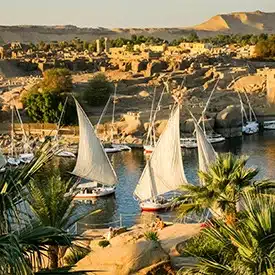
SPRING – March, April, May
Spring in Egypt can be unpredictable, but expect temperatures to rise starting in March. Again, be prepared for warmer or hotter temperatures during the day and cooler temperatures at night. Sandstorms can also be prevalent during this time, but they mostly occur outside of major cities. Pack lightweight long and short-sleeved shirts and layers to adjust to changing temperatures.
SUMMER – June, July, August
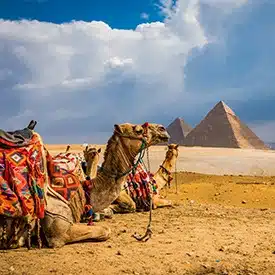
FALL – September, October, November
Fall in Egypt is much more mild, with pleasant temperatures averaging around 85°F (29°C). Due to the improved weather, fall is one of the most popular tourist seasons in Egypt. Expect higher prices and bigger crowds at major tourist attractions during this time. You might also experience some rain in the fall, so pack your umbrella!
Nile River Cruise – Nile river cruise attire is a bit more relaxed than many of your other Egyptian destinations, as you’ll likely be surrounded by other tourists in western dress. Bare shoulders, shorts, and swimsuits are fine, but as a general rule, try to remain respectful of the crew and local Egyptians by proceeding with caution when it comes to overly revealing clothing.
Exploring the Cities – In the bigger cities like Cairo and Alexandria, many locals tend to opt for western style clothing like skinny jeans and t-shirts, as long as they are covered from the shoulders down to their knees. As long as you keep with this general rule and don’t wear overly tight or revealing clothing, you should be absolutely fine with western style clothing in the big cities.
Beach Resorts – Beach resorts in Egypt will also be a bit more relaxed when it comes to what to wear. Feel free to wear shorts and bathing suits as you’ll likely be surrounded by majority tourists. That said, consider opting for a more conservative swimsuit like this one to ward off unwanted attention and to show respect for the local culture.
Mosques and Holy Sites – It’s essential to dress appropriately and conservatively when entering mosques and holy sites in Egypt. That means women may be required to cover their head with a scarf or shawl, and both men and women will need to make sure they’re covered from their shoulders down to below their knees.
What NOT to bring to Egypt
1. don’t pack white clothing.
Egypt can get windy and dusty, so leave your white and light colored clothing at home! You won’t want to walk around in a dirty, dusty, brown outfit, so opt for darker colors instead.
2. DON’T BRING a winter coat
Egypt enjoys warm to mild temperatures year round, and even in the dead of winter it likely won’t get cold enough to warrant a winter coat. Instead, bring clothes that will work for layering so you can easily adapt to the weather.
3. DON’T TAKE full-size liquids
The last thing you need is to have your expensive jewelry or electronics lost, stolen, or broken during your trip to Egypt. Save yourself some stress (and maybe even some money) by leaving your valuables at home and only bringing what you absolutely need.
4. DON’T PACK too much stuff
Egypt is a country with amazing things to do and see from north to south. Save yourself the hassle of lugging around excessively heavy, overstuffed baggage by using packing cubes to stay organized and avoid overpacking.
5. DON’T BRING revealing clothes
Egypt’s culture requires visitors to dress more conservatively than they may be used to. This means avoiding wearing tight or revealing clothing, and instead opting for loose fitting clothes with more coverage.
6. DON’T TAKE full-sized liquids
Don’t risk having your expensive liquid toiletries dumped out by security at the airport or having them leak and spill all over your luggage during the journey. Instead, pack your liquids in these TSA approved travel-sized bottles and bring only what you need.
Travel FAQs and Tips for Egypt
1. is it safe to drink the water in egypt.

No, it is not safe to drink tap water in Egypt. Instead, opt for bottled water or fill up your reusable bottle with filtered water which you can find at many hotels and higher-end restaurants and cafes. Avoid eating fresh fruit and vegetables without a peel, and be wary of drinking beverages that come with ice, as the ice was likely made with tap water.
2. Should I take public transportation in Egypt?
No, it’s not advisable to take public transportation in Egypt. Trains are prone to crashing and often result in casualties. Busses are overcrowded, slow, and get caught in the crazy traffic and congestion of Egypt’s larger cities. Using any public transportation option will be chaotic and difficult to use unless you have a good knowledge of Arabic. We recommend taking taxis or even Uber instead.
3. Is it safe to travel to Egypt?

It is currently safe to travel to the more touristy parts of Egypt, including Cairo and the Great Pyramids. That said, it’s always important to remain cautious and keep your wits about you at all times, keeping wary of pickpocketing and petty theft. The majority of the Sinai Peninsula with some exceptions is considered to be dangerous for tourists, and visitors should proceed with extreme caution.
4. Do you need vaccines to visit Egypt?
As long as you are up to date with the standard vaccinations, no additional vaccines are required to visit Egypt. That said, it’s always prudent to check with your healthcare professional and make sure you’re all set before you go.
5. Do I need a visa to visit Egypt?

If you’re visiting from the US, you do need to get a visa to enter Egypt. You can obtain a visa by paying $25 USD upon your arrival at the airport. If you’re visiting from Europe or other nations, you will also need to obtain a visa for entry to Egypt, though you’ll need to check online for the details specific to your country of residence.
- (+20) 100 405 1515
- Local Time : 06:34 PM
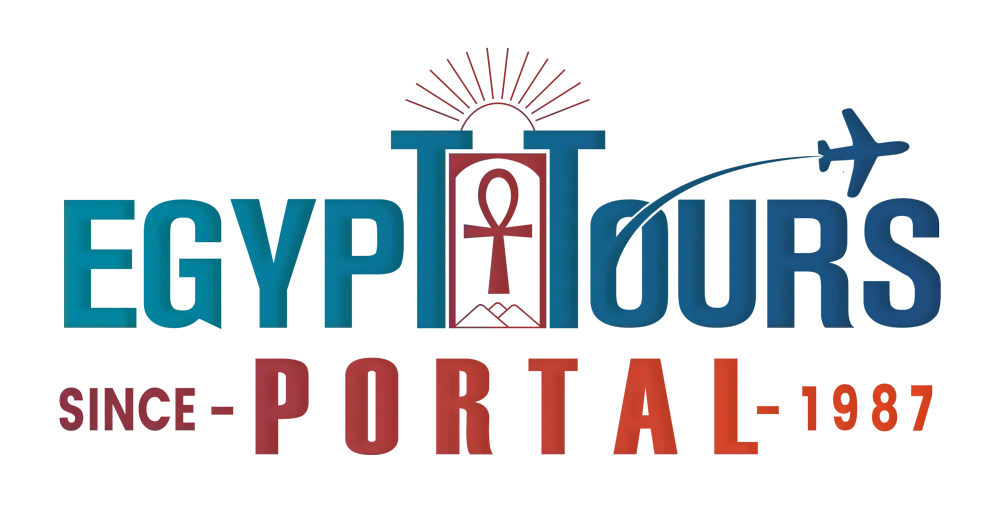
- Egypt Travel Blog
10 Best Places for Water Sports in Egypt
By: ETP Team Published: 22 December, 2020 Updated: 16 October, 2021
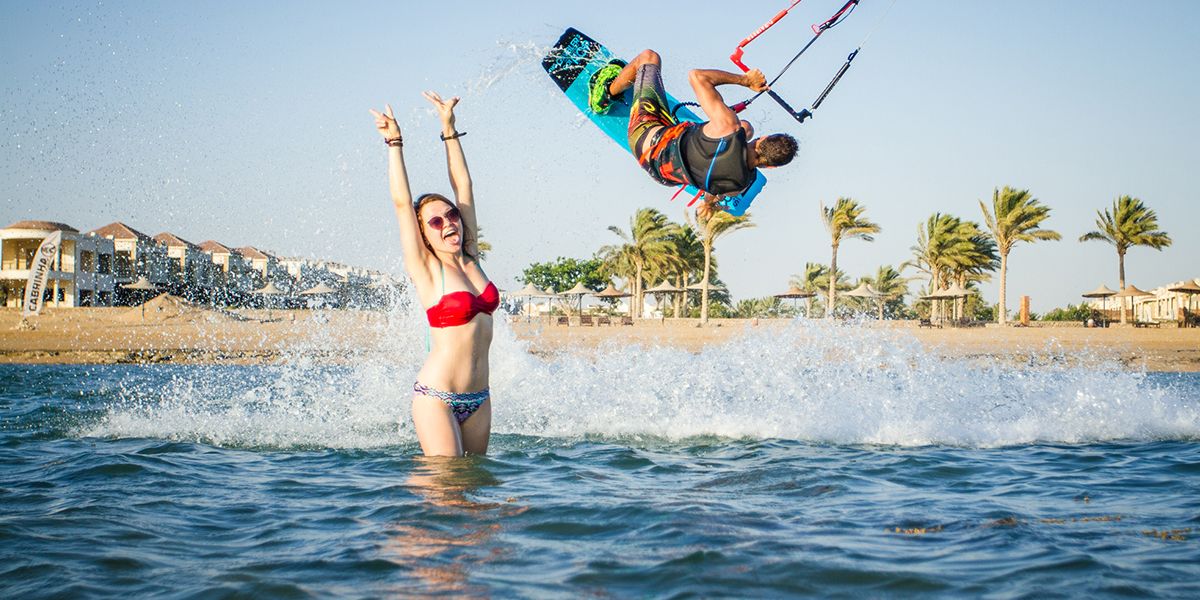
Awards & Recognitions
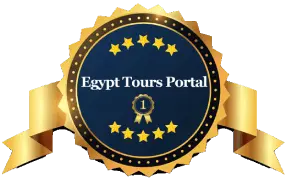
The Best place for water sports in Egypt are all located across the shores of the majestic red sea. The main goal of this article is to provide every traveler with all the information and facts about the best places to enjoy the most entertaining water sports in Egypt. This article was written by a group of tour operators, tour guides, and travel consultants who know all the finest places to do the most fun aquatic activities in Egypt.
The Red Sea is one of the most famous things that characterizes Egypt and makes it a truly complete country that has all of what a tourist may need to spend a perfect vacation full of enjoyment and fun. The concept of civilization and great culture is well-represented in Egypt and with the magical beaches & resorts that are located in Egypt’s different cities; tourists can spend an unforgettable historical, cultural, and recreational vacation in the great land of Pharaohs. In this article, you will find a guide to some of the best-recommended water sports that can be practiced in Egypt and the best location to enjoy each of them so keep reading to have an overall idea about those activities and water sports:
Enjoy Snorkeling & Diving Excursions in Sharm El-Sheikh
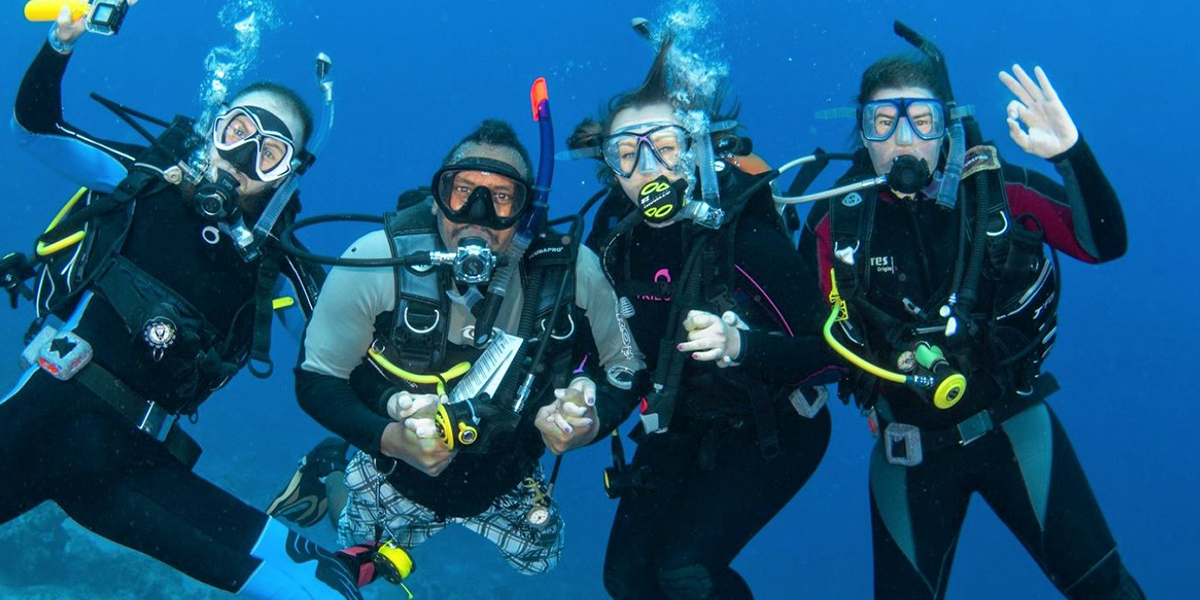
Have The Best Snorkeling Tours in The Blue Hole of Dahab
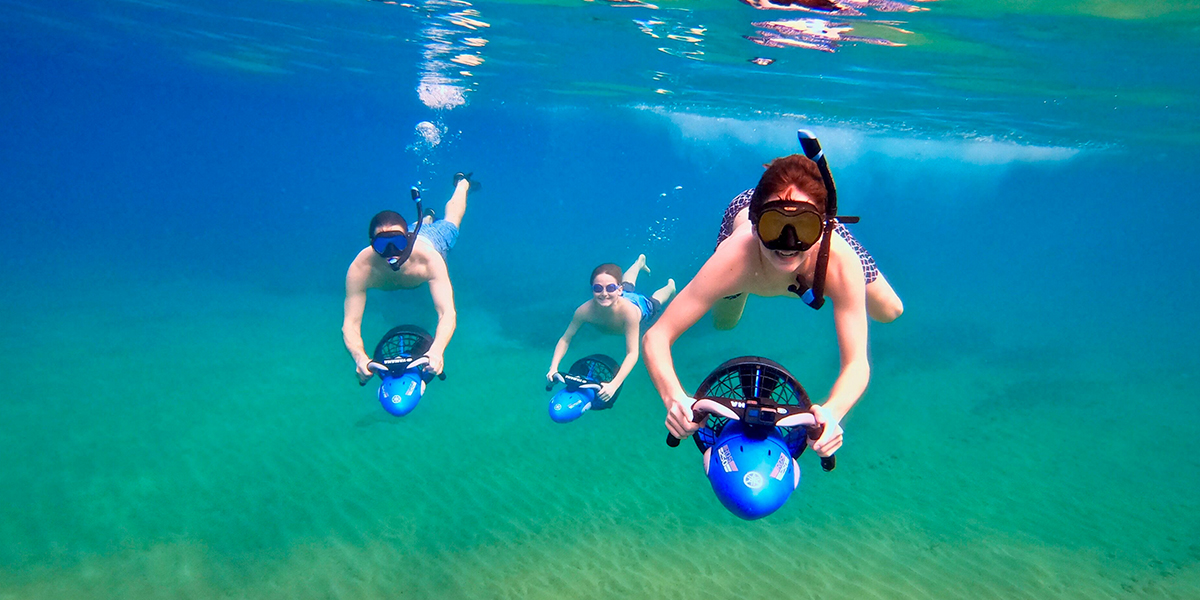
Head to The Incredible Dolphin House and Enjoy a Terrific Banana Boat Ride
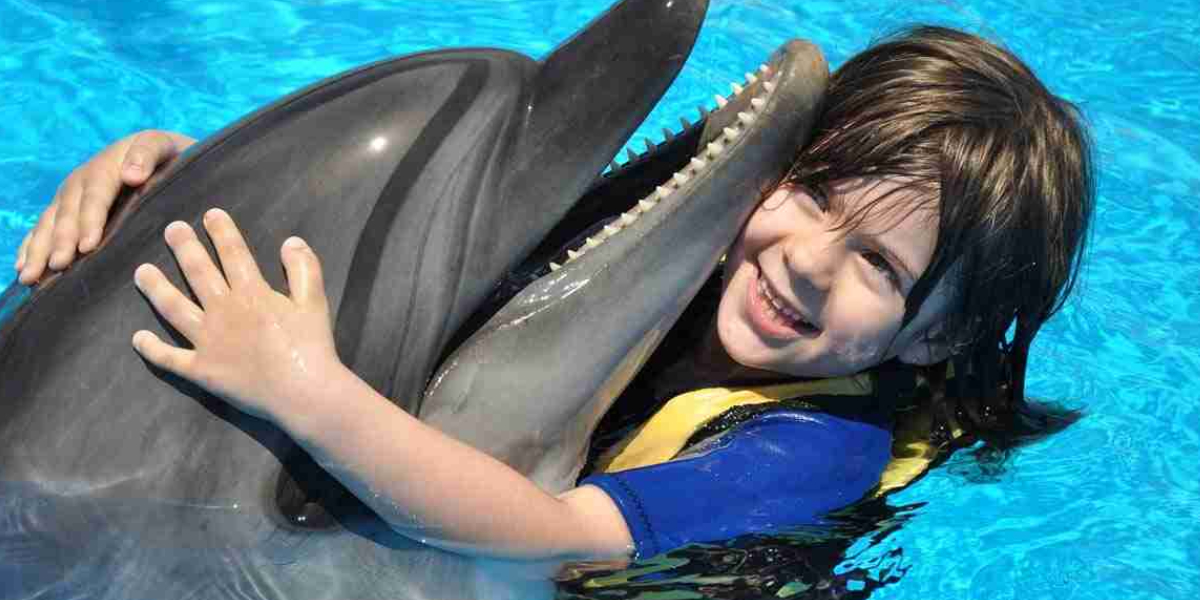
Have The Best Scuba Diving Excursion in Hurghada
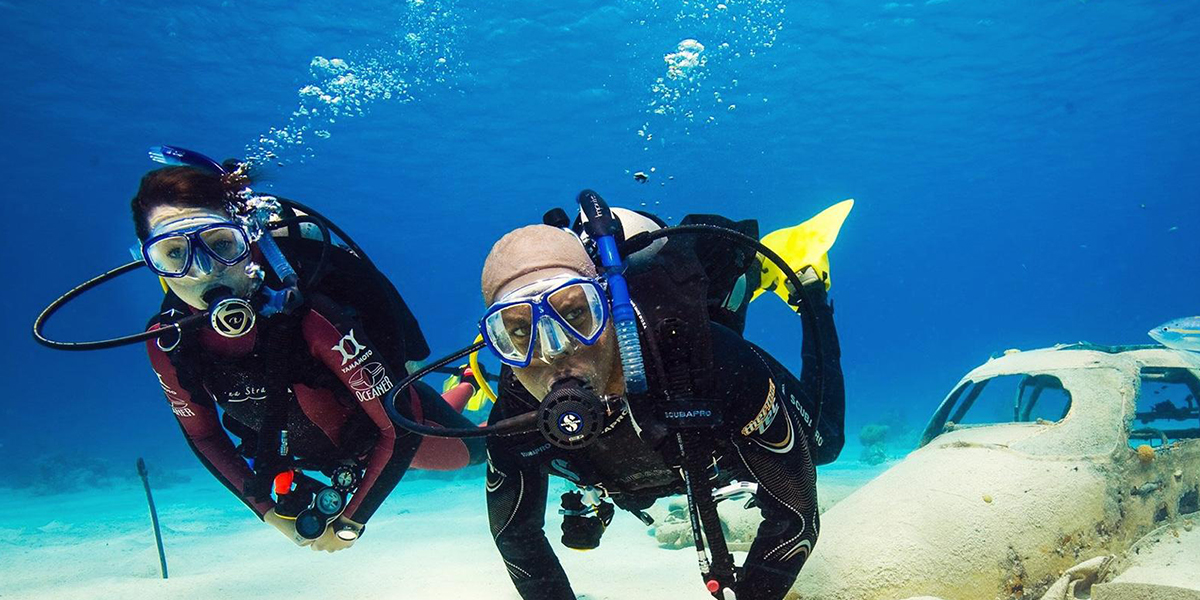
Enjoy Parasailing in Sharm El-Sheikh
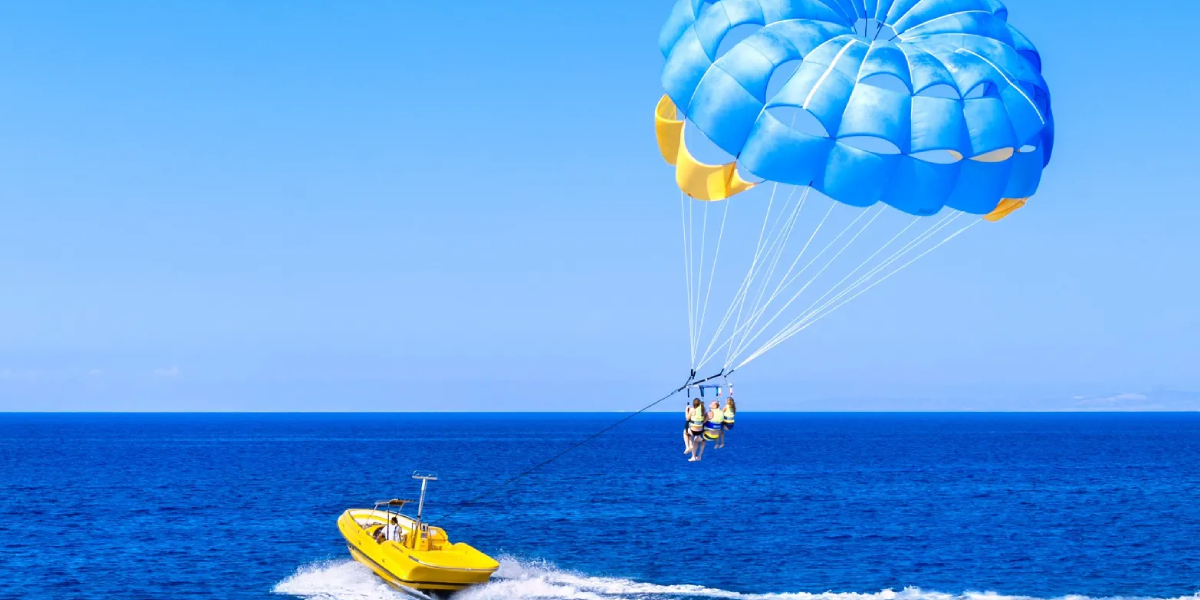
Have The Best Felucca Ride in Aswan
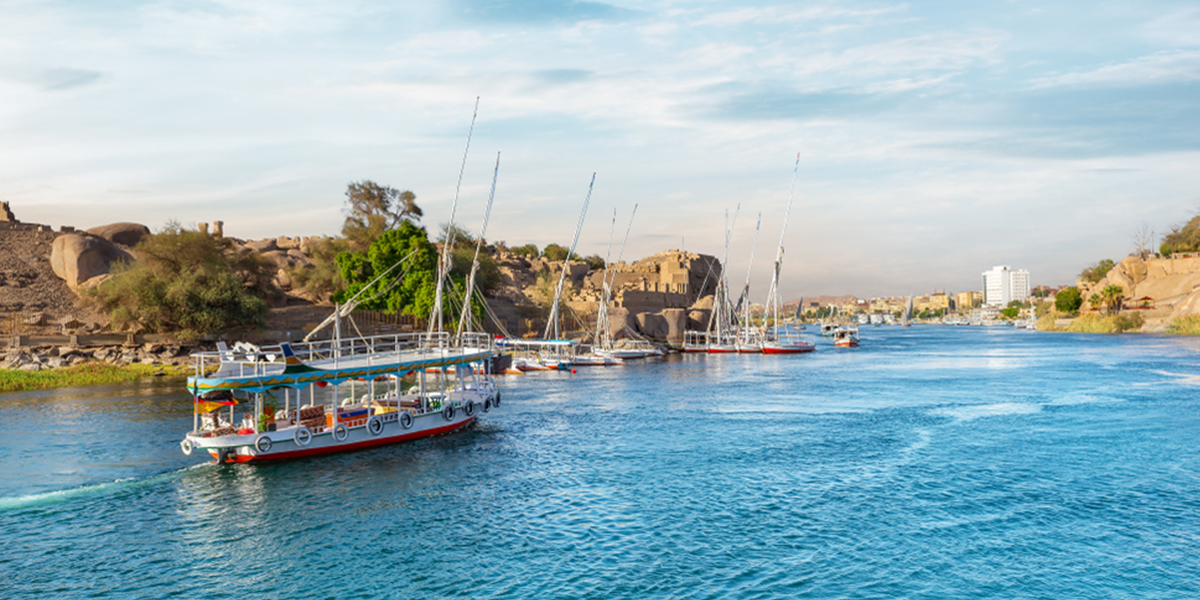
Take a Diving Ride in Soma Bay
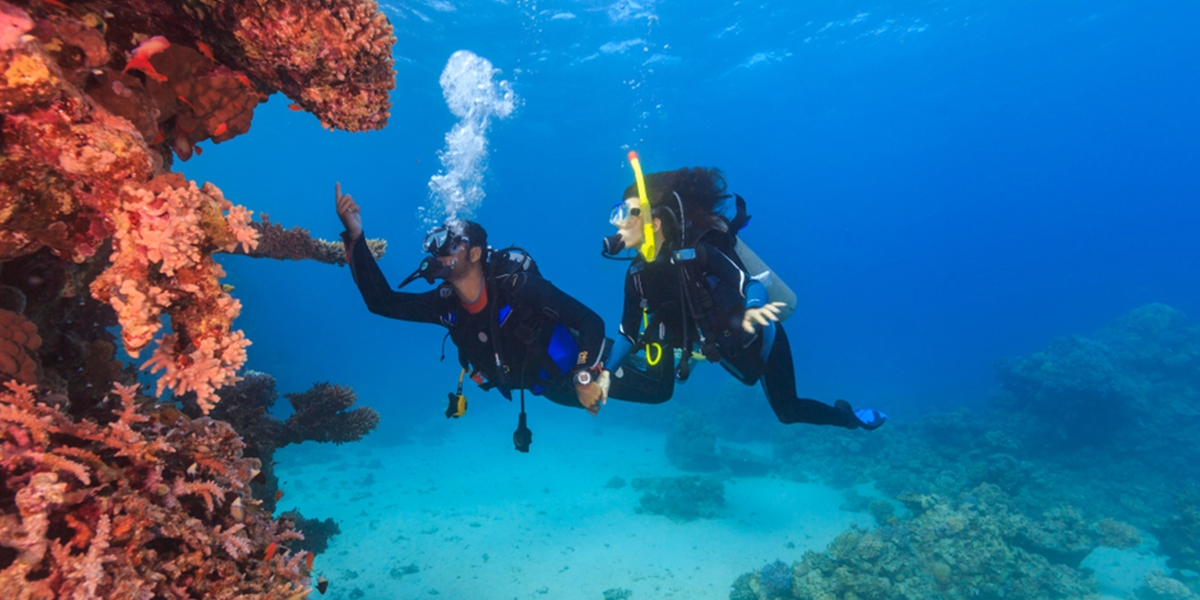
Take a Boat Ride While Being in Sharm El-Sheikh
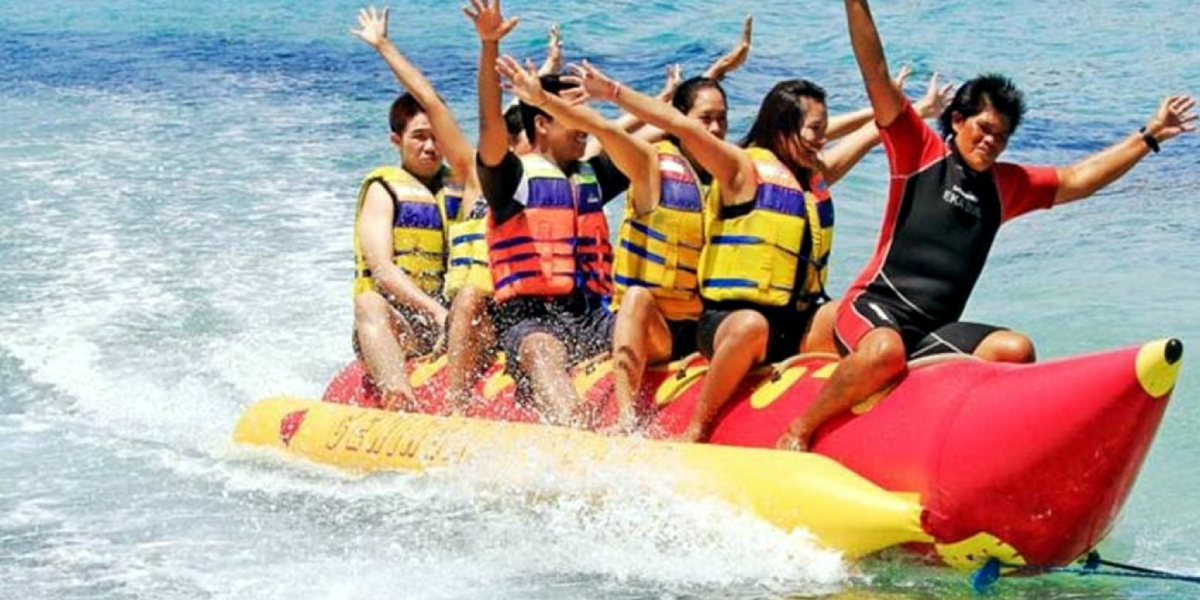
Book a Snorkeling Trip in Makadi
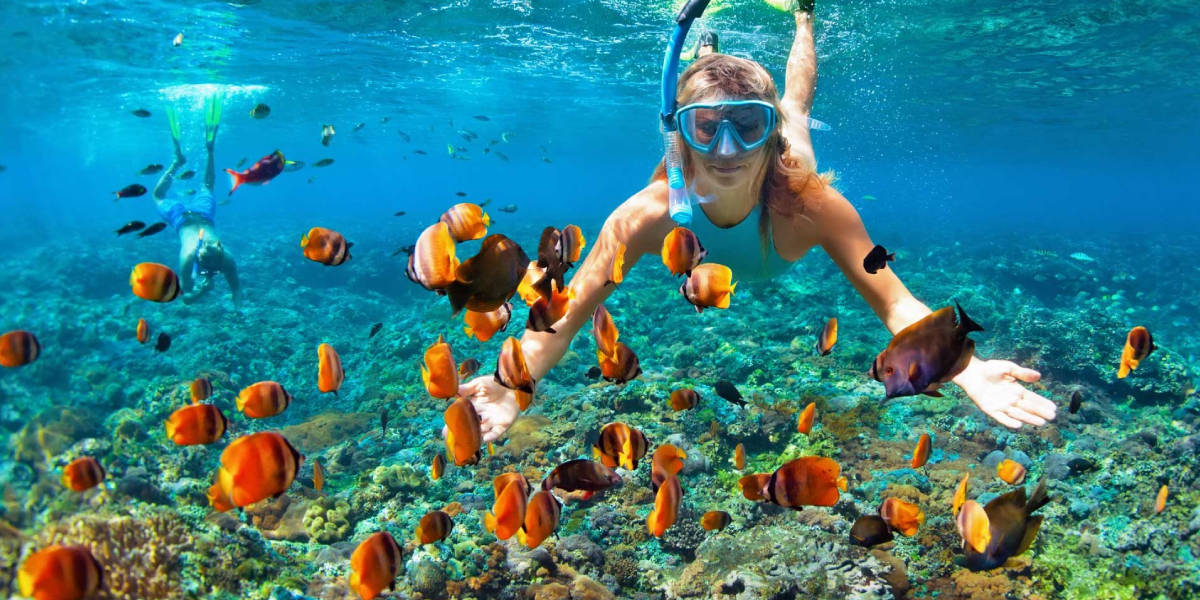
Have a Fanciful Snorkeling Tour in Marsa Alam
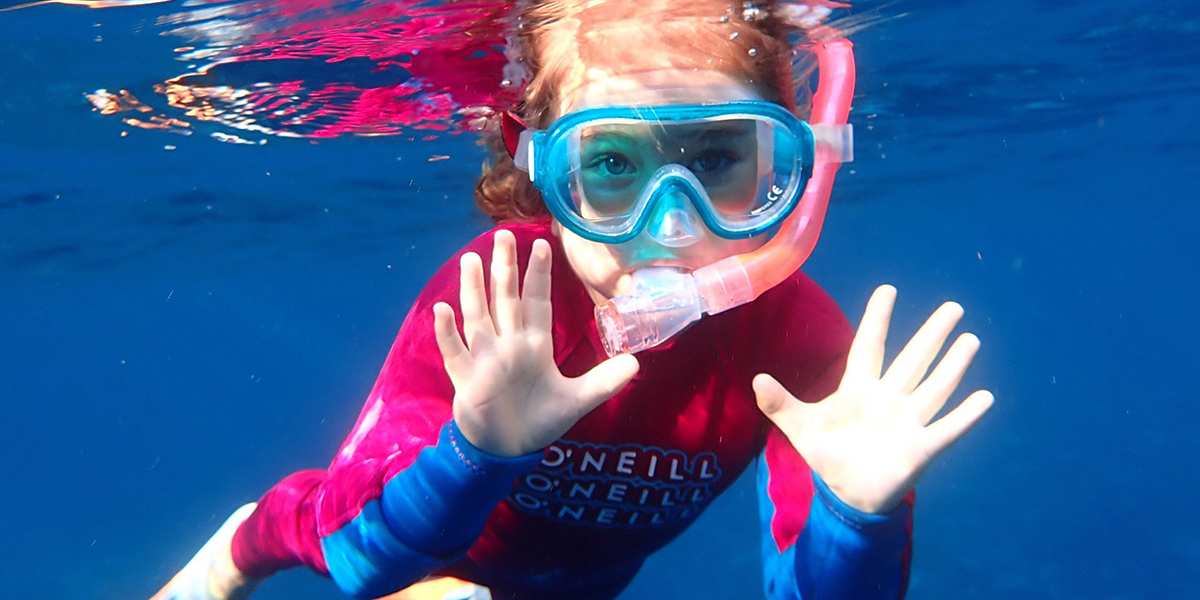
Enjoy the Best Egypt Red Sea Holidays
After knowing the most recommended water sports & activities in Egypt, you can start planning your vacation with us now to visit as many tourist spots as you want and head to its impressive coastal beaches where the beauty of its waters is mixed with the glamorous charm of its golden sandy beaches. This is the perfect time to book Egypt Red Sea Holidays with us so don’t waste the chance and contact us now.
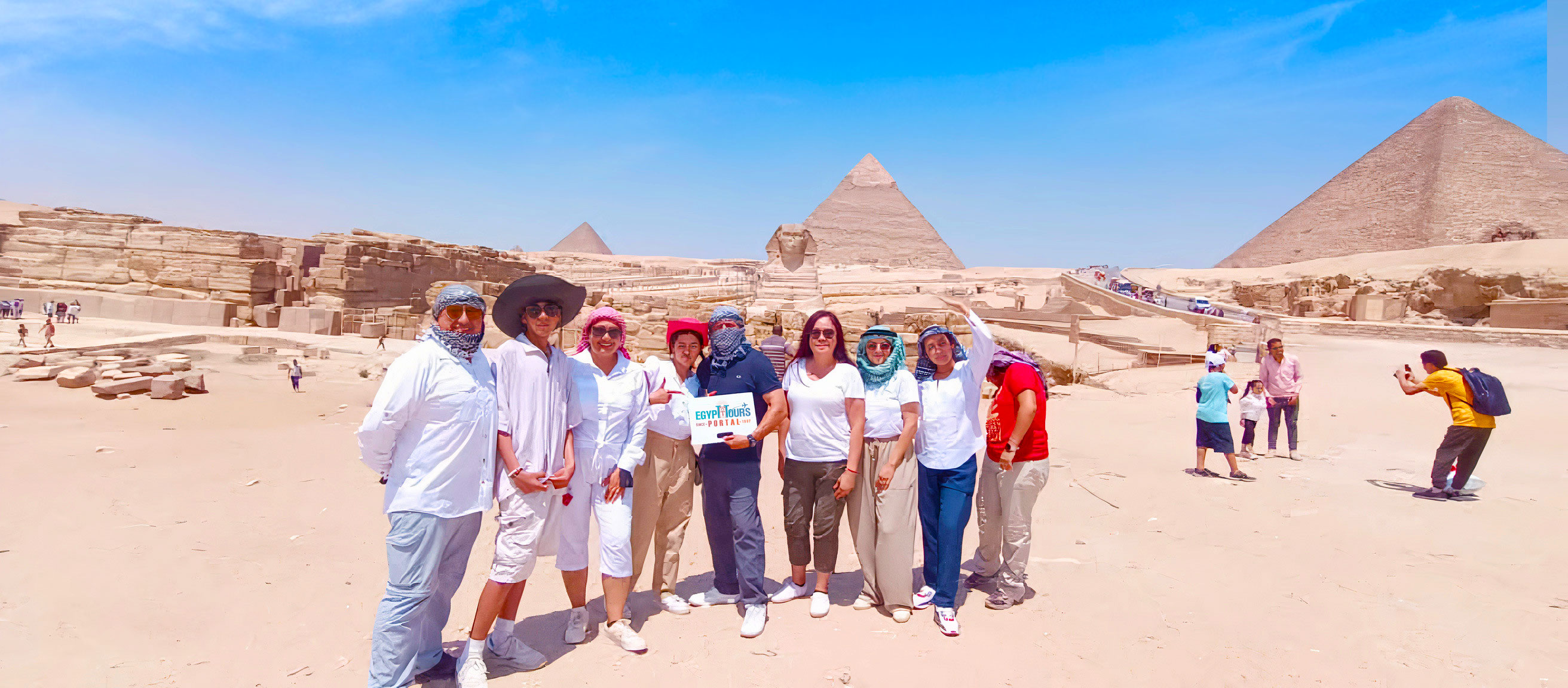
8 Days Cairo Nile Cruise and Hurghada Tour
Special 8 Days Cairo Nile Cruise and Hurghada Tour for American Travelers 8 days Cai...
Tour Location: Cairo/Giza/Aswan/Kom Omb...
8 Days / 7 Nights
Classic Tour
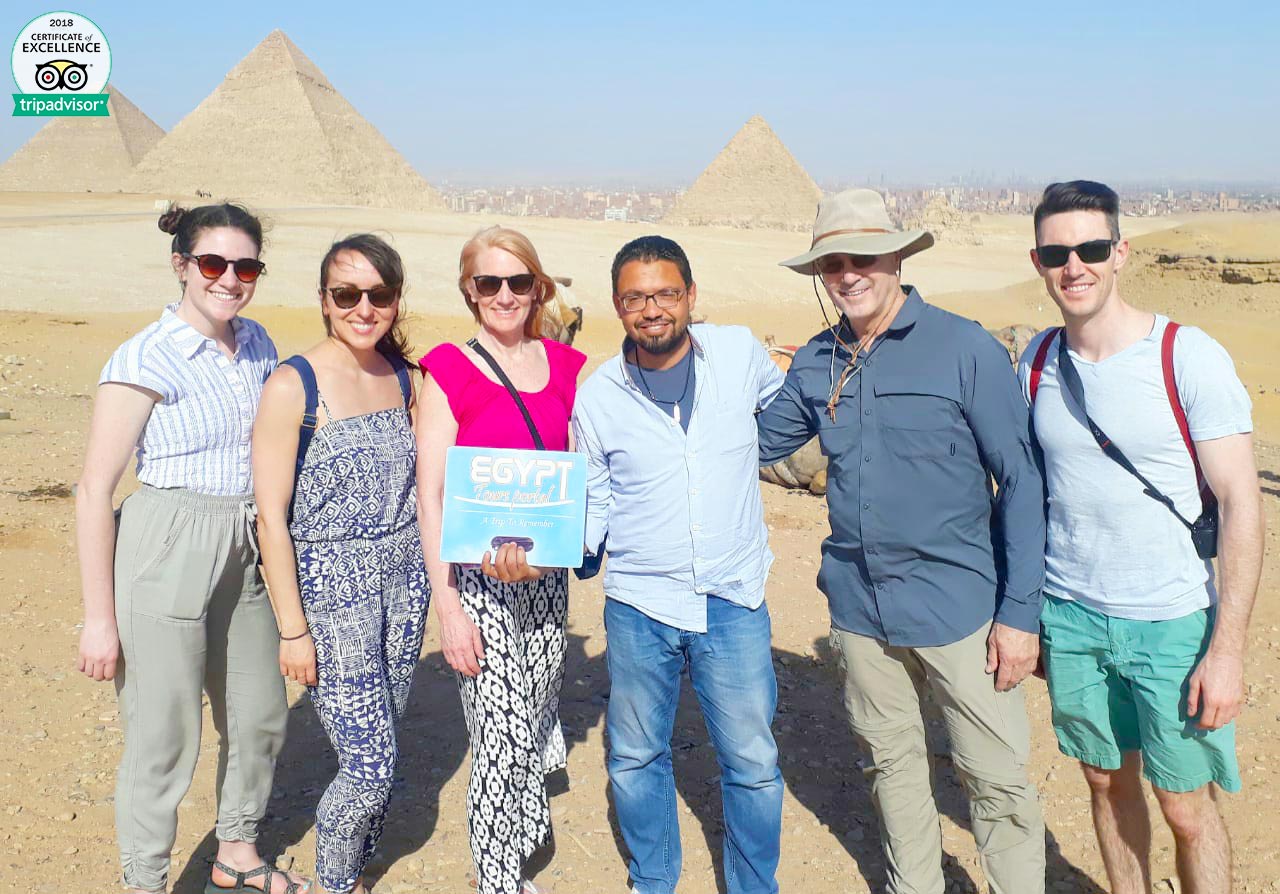
9 Days Cairo, Luxor & Hurghada Tour Package
8 Nights Cairo, Luxor & Hurghada Tour Package for American Travelers 9 days Cair...
Tour Location: Cairo/Giza/Luxor/Hurghad...
9 Days / 8 Nights
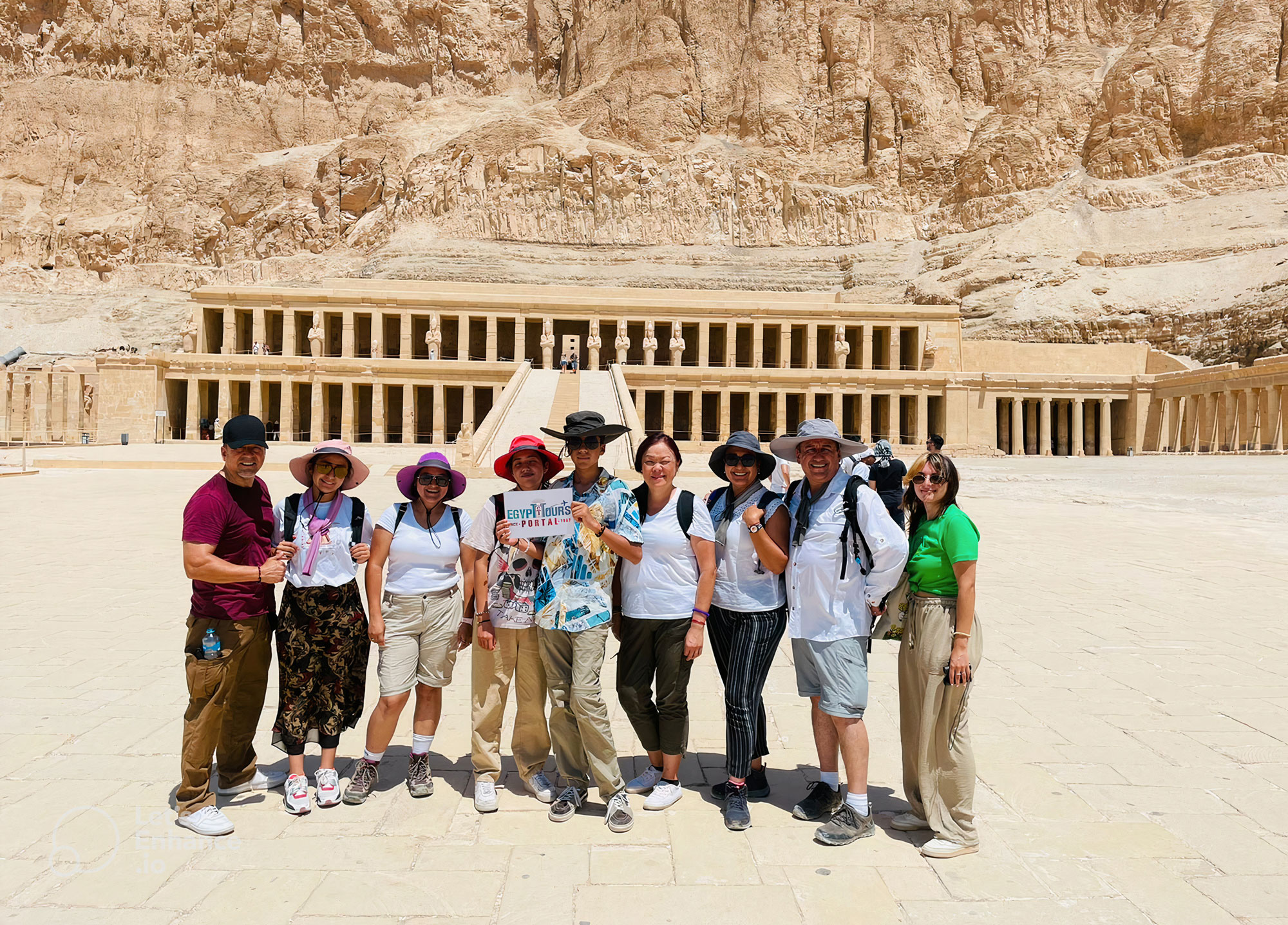
10 Days Egypt Tour Cairo, Nile Cruise & Hurghada
10 Days Egypt Tour Cairo, Nile Cruise & Hurghada for American Travelers 10 days ...
10 Days / 9 Nights
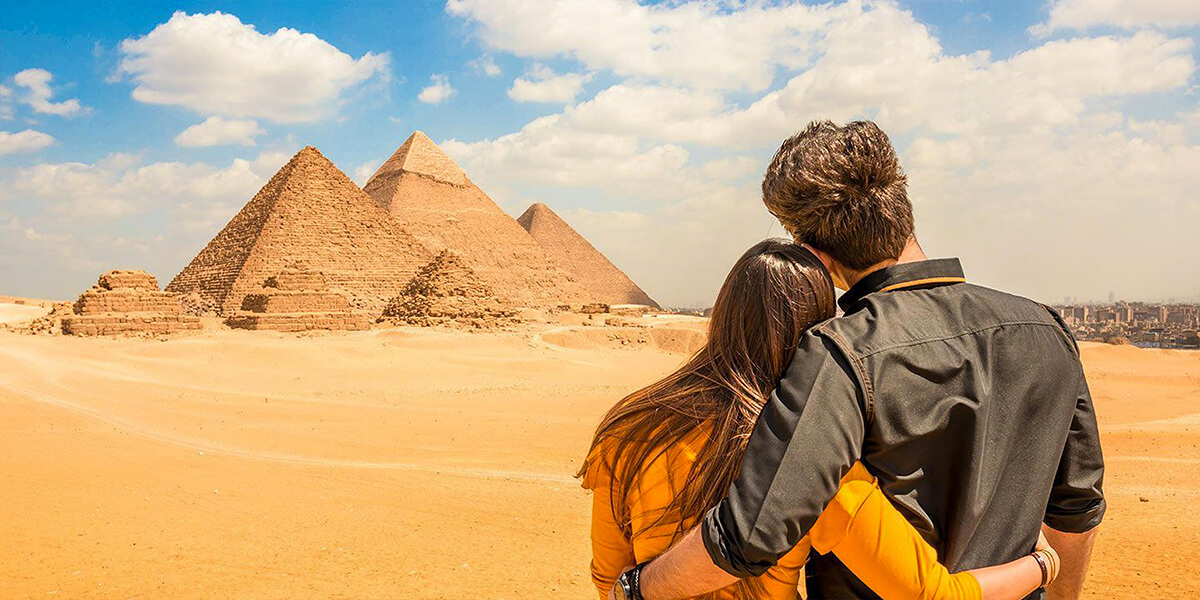
12 Days Hurghada, Cairo & Nile Cruise Holiday Packages
12 Days Egypt Tour to Cairo, Nile Cruise & Hurghada for American Travelers 12 Da...
12 Days / 11 Nights
- Introducing Egypt
- Before You Travel
Was This Article Helpful?
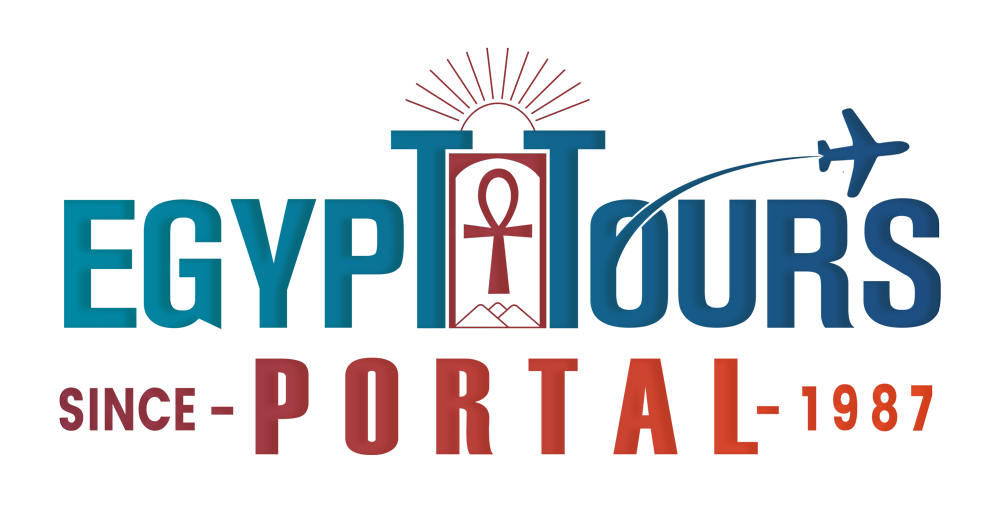
About the Author: ETP Team
Egypt Tours Portal team dedicates its time and energy to preserving and showcasing the vast history and mysteries of the ancient Egyptians that trace back more than 5000 years across their most famous destinations that hold an incredible number of monuments and attractions. The team’s main purpose is to shed light on the infinite wealth of natural, historical, cultural, and mythological knowledge for everyone who wished to learn something new and prepare for their journey across the magical destinations of Egypt.
All the team members of the Egypt tours portal are a highly knowledgeable and qualified group of Egyptologists, Archaeologists, historians, world travelers, content creators, digital marketers, consultants, and explorers who have a vast experience in each of their fields, stretching from 5 to 20 years where everyone gained an unfathomable understanding of their craft that provide all the visitors and clients to gain priceless information and all the means needed to have the most entertaining travel experience in Egypt.
The information mentioned on the website was created over a long period of time by a number of the most qualified experts in each of their fields which was updated regularly on a monthly basis and depends on a number of highly trusted sources with confirmed facts to ensure the safest delivery and consumption of each information in the most useful and positive manner.
All our sources and resources of the Egypt tours portal which was cultivated for over 35 years that were made to provide the most incredible Egypt tours & vacation packages, Egypt Nile cruises, Egypt day tours & excursions, and Egypt shore excursions that have won the praise of all our clients as shown by own clients on TripAdvisor, won a number of awards, and mentioned by a number of renowned news agencies and travel blogs plus provides an enriching educational and entertaining travel experience for everyone.
Search Articles
Latest articles.

Resorts & Hotels in Dahab, Egypt
14 April, 2024

Best 10 Hotels Near Cairo International Airport
08 April, 2024
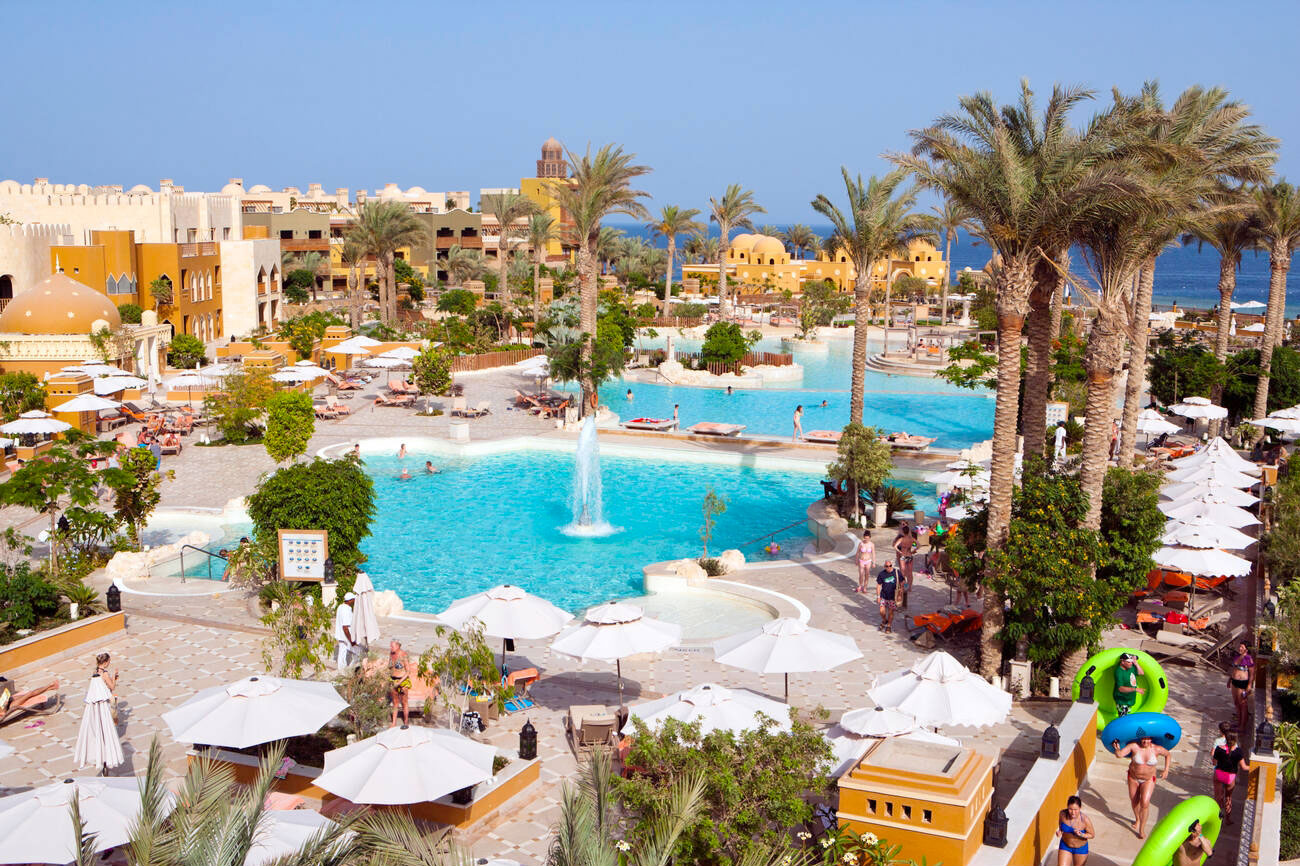
Best 11 Hotels in Makadi Bay
21 March, 2024
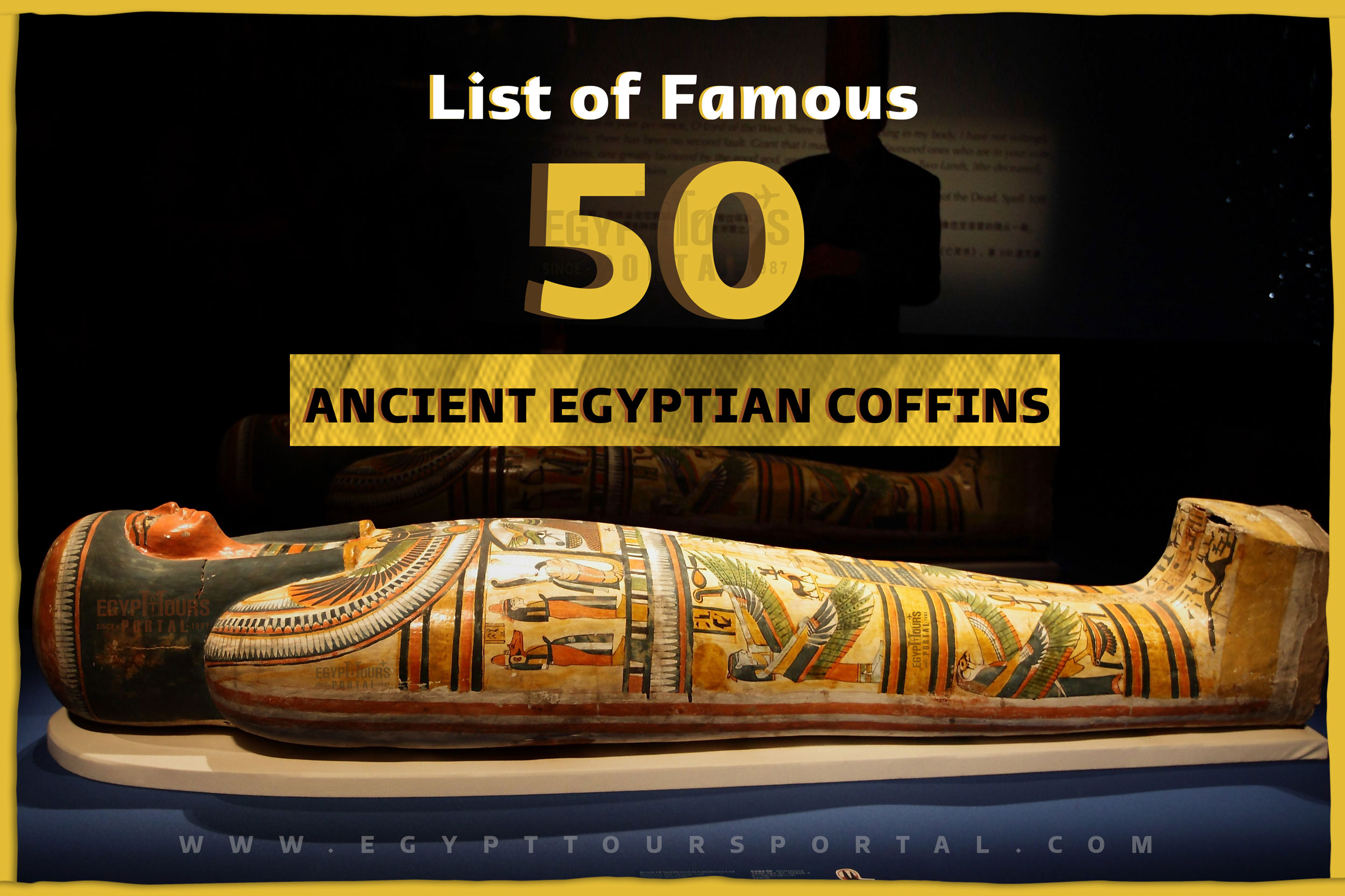
List of Famous 50 Ancient Egyptian Coffins with Photos
02 September, 2023
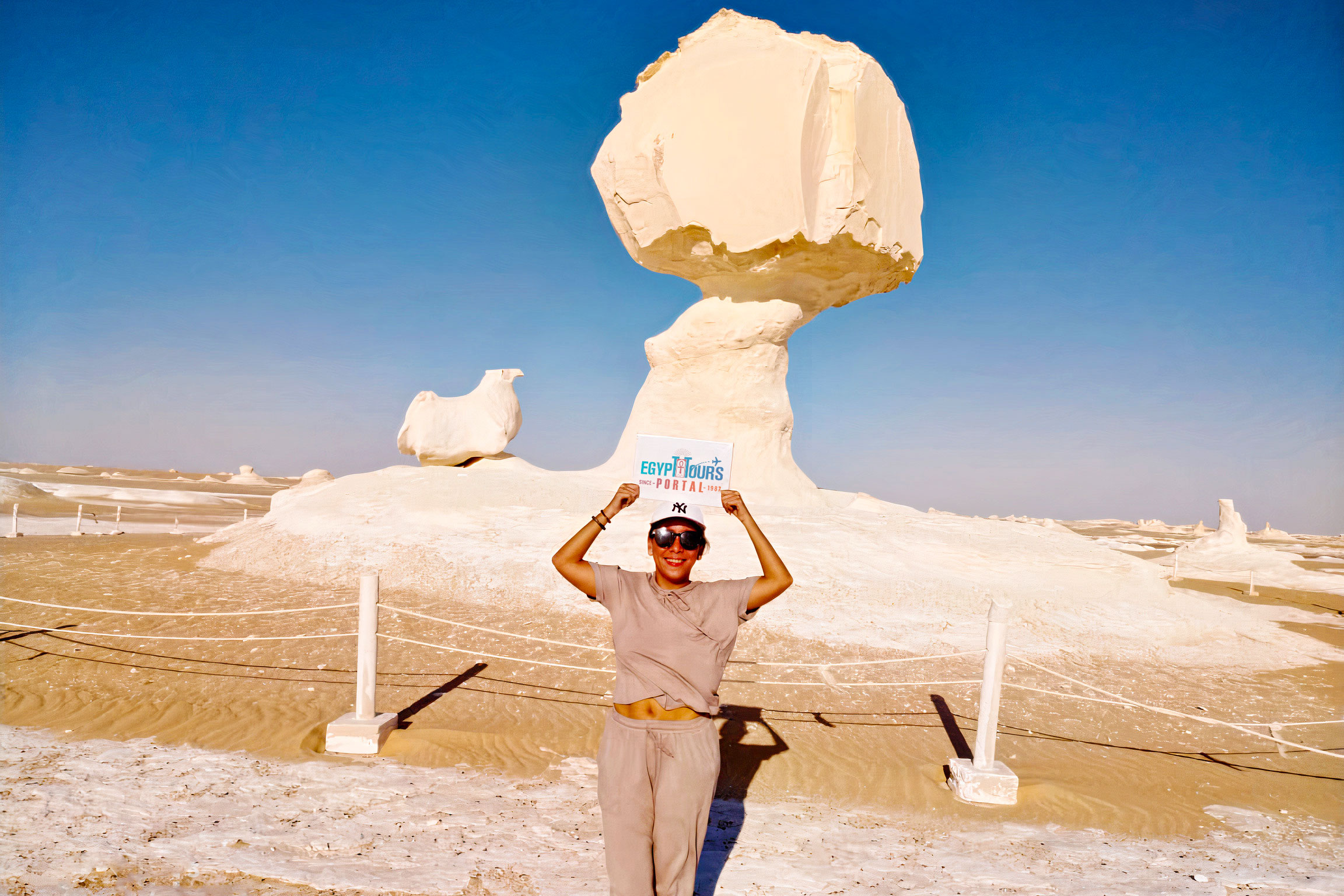
The White Desert National Park
16 February, 2023

The Red Pyramid of Dahshur
13 February, 2023
- Oasis Egypt
- Egypt Civilization
- Cairo Monuments
- Egypt Historical Artifacts
- Egyptian Mythology
- Alexandria Landmarks
- Luxor Landmarks
- Aswan Landmarks
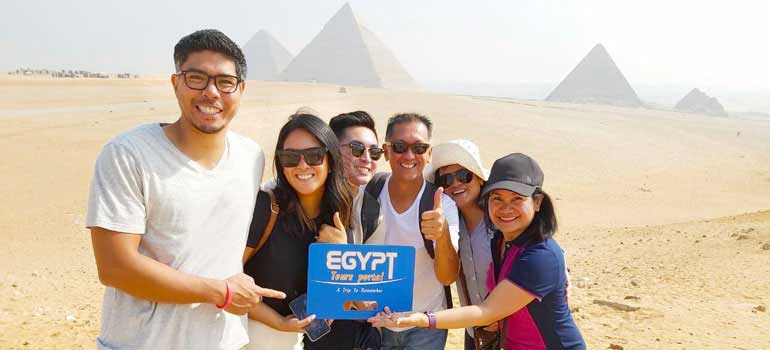
Egypt Tours Portal
Egypt Tours Portal was established in 1987 and we have more than 33 years of experience in the field of tourism in Egypt. We have defined the word of professionalism throughout the tours that we have arranged through the past years as it is not just business to us but it is a matter of proving to the whole world that we are the best travel agency in the middle east who can arrange perfect well-organized tours in Egypt with the whole required element to make it one of its kind.
Enter email address
Subscribe for latest updates & promotions
Send This Article To a Friend
Related articles.
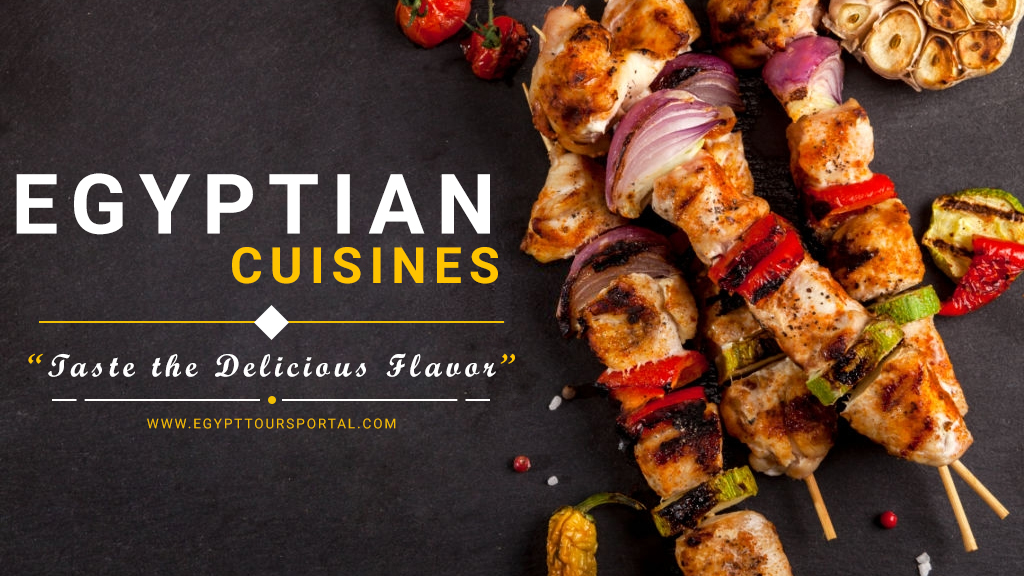
The Top 25 Types of Egyptian Food
Read more information about the top 25 types of Egyptian food, discover Egyptian culture food, the best m...
19 March, 2018
Egypt Travel Tips 2024
Will you travel to Egypt? Here are the best Egypt travel tips for 2024 which will give you important hi...
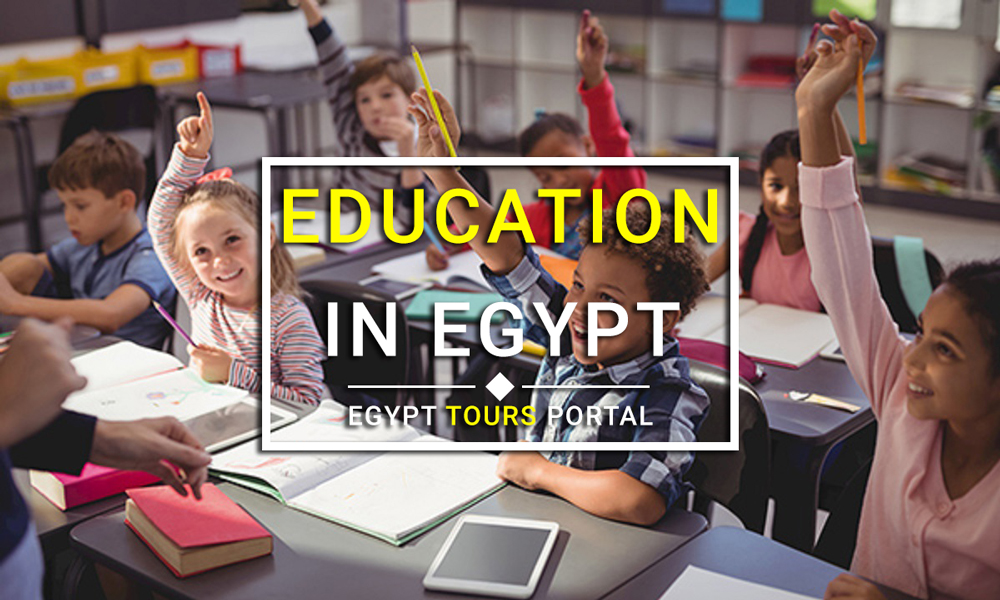
Education in Egypt
The education in Egypt, the stages of education in Egypt, educational materials in Egypt, which consists ...
24 March, 2018
Our Clients Feedback
Eoffers valuable insights straight from the source, capturing the voices and experiences of those who matter most – our cherished clients

Tour Name: 5 Days Tour of Group Witnessing Egypt’s Jewels
Experience Date: 11 May, 2024
My fiancé and I booked a private 5 day tour of Egypt with ETP starting in Cairo followed Read More by Aswan, Abu Simbel and Luxor. We just got home and continue to talk about how amazing the trip was. The communication with ETP was excellent. Very fast responses and they are very accommodating. Our tour was nonstop which was okay by us as we wanted to see all the sights in 4 days. Read Less

Tour Name: Experience Egypt Cultural Sightseeing in 10 Days
This was the trip of a lifetime that I was able to have with my eldest son - an absolutely Read More amazing experience. To be able to actually see the places and artifacts that I had read about and studied was truly phenomenal. Our hotels were great, the travel to and from sites was completely taken care of, we never felt unsafe or left to our own devices, and the itinerary was just right. But what made the experience so fab was our two guides - Mahmoud Nour in Luxor/Aswan/Abu Simbel and "Max" in Cairo/Memphis/Saqqara. They taught us history and context as it related to each site we visited and they indulged my myriad questions. They were both so incredibly knowledgeable and my questions were never ignored or unanswered. In addition, they shared their culture with us and treated us to some awesome dining experiences. We were reminded that Egypt is more than just ancient ruins. I would recommend without reservation this tour experience. And "hats off" to Mahmoud and Max!!! I left feeling like I had made some great new friends. And I can't wait to try some home-made kushari. Read Less
L Joe Smith
Tour Name: Experience Egypt in 9 Days
Egypt Tours Portal is an excellent company to use to arrange your visit to Egypt. They wor Read More k with phenomenal guides (we had Mahmoud Nour in Upper Egypt and Mohsen aka Max in Lower Egypt...I would recommend asking for these guides by name, as they were truly superb), make all the necessary arrangements in terms of drivers, covid testing, hotels, and in-country flights, and can tailor your tour to whatever it is you most want to see. The entire experience was smooth from start to finish. Both Mahmoud and Max spoke excellent English, were extremely knowledgeable, and went out of their way to ensure our experience was everything we hoped it would be. This was the second time I have used ETP, and I will continue to recommend them to anyone who expresses any interest in exploring Egypt. We especially liked that our tour group was limited to only our party, which meant we got one-on-one attention at all the sites, and allowed us to get answers to all our questions. And for those of you who are worried about safety or health in Egypt, in our experience it was extremely safe, and we never had any issues related to COVID-19. Cannot recommend Egypt Tours Portal enough. Choose them, you won't regret it. Read Less
Tour Name: 5 Days Cairo, Luxor & Abu Simbel Tour
It was an absolutely amazing trip where we saw some of the most historical and beautiful s Read More ights in Egypt. Our tour guide Mohamed Elshemei was extremely knowledgeable and accommodating to our needs Read Less
Tour Name: 5 Days Nile River Cruise Luxor to Aswan
Highly recommend this tour company!!! Our guides, Moses, Mahmoud, Magred and Mohamed were Read More exceptional, their knowledge of the history is more that accurate, they are also very patient!! For the price and all the attractions, the Nile cruise and the included meals.....well worth it!!! It is a very busy tour, but well worth it!!! Read Less
This review is a late, but I had to provide some feedback. My brother and I went on vacati Read More on in October 2022 and booked with Egypt Tours Portal. With on-line scams on-going, I was a little wary at first. BUT, the experience was amazing. Personal guides and drivers, lodging, food was amazing and perfect. The guides were very knowledgeable, but more importantly PASSIONATE about their job and culture. They went out of their way to take care of us. If you happen to get Zeze or Marianne, you have gotten the best. Read Less
Timmy Lovett
Frequently asked questions, what are the finest destinations to visit in egypt.
The entire country of Egypt deserve to be explored with its every heavenly detail but there are places that must be seen before any other such as the breathtaking Hurghada's red sea, The wonders of Cairo the pyramids of Giza, the great sphinx, the Egyptian Museum, Khan El Khalili Bazaar, the wonders of Luxor like Valley of the Kings, Karnak & Hatshepsut temple and the wonders of Aswan such as Abu Simbel temples, Philea temple, Unfinished obelisk and The Wonders of Alexandria like Qaitbat Citadel, Pompey's Pillar and Alexandria Library. Read more about the best places to visit in Egypt .
What Are Egypt's Visa Requirements?
If you want to apply for a Visa On Arrival that lasts for 30 days then you should be one of the eligible countries, have a valid passport with at least 6 months remaining and pay 25$ USD in cash, as for the E-Visa for 30 day you should have a valid passport for at least 8 months, complete the online application, pay the e-visa fee then print the e-visa to later be presented to the airport border guard. You could also be one of the lucky ones who can obtain a free visa for 90 days. Read more about Egypt travel visa .
What Is the Top Traditional Egyptian Food?
Egypt has a variety of delicious cuisines but we recommend “Ful & Ta’meya (Fava Beans and Falafel)”, Mulukhiya, “Koshary”, a traditional Egyptian pasta dish, and Kebab & Kofta, the Egyptian traditional meat dish.
What is the Best Time to Visit Egypt?
The best time to travel to Egypt is during the winter from September to April as the climate becomes a little tropical accompanied by a magical atmosphere of warm weather with a winter breeze. You will be notified in the week of your trip if the Climate is unsafe and if any changes have been made.
What to Pack for Your Egypt Tour?
You should pack everything you could ever need in a small bag so you could move easily between your destinations.
Why Book With "Egypt Tours Portal"?
We have been creating the finest vacations for more than 20 years around the most majestic destinations in Egypt. Our staff consists of the best operators, guides and drivers who dedicate all of their time & effort to make you have the perfect vacation. All of our tours are customized by Travel, Financial & Time consultants to fit your every possible need during your vacation. It doesn't go without saying that your safety and comfort are our main priority and all of our resources will be directed to provide the finest atmosphere until you return home.
Is it Safe to Travel to Egypt?
You will feel safe in Egypt as the current atmosphere of the country is quite peaceful after the government took powerful measures like restructuring the entire tourist police to include all the important and tourist attractions in Egypt. Read more about is it safe to travel to Egypt .
What to Wear While in Egypt?
Wear whatever feels right and comfortable. It is advised to wear something light and comfortable footwear like a closed-toe shoe to sustain the terrain of Egypt. Put on sun block during your time in Egypt in the summer to protect yourself from the sun.
What are the Best Activities to Do in Egypt?
The best activity is by far boarding a Nile Cruise between Luxor and Aswan or Vise Versa. Witness the beauty of Egypt from a hot balloon or a plane and try all the delicious Egyptian cuisines and drinks plus shopping in old Cairo. Explore the allure and wonders of the red sea in the magical city resorts of Egypt like Hurghada and many more by diving and snorkeling in the marine life or Hurghada. Behold the mesmerizing western desert by a safari trip under the heavenly Egyptian skies.
What are Egypt Festival and Public Holidays?
There are a lot of public holidays in Egypt too many to count either religious or nation, the most important festivals are the holy month of Ramadan which ends with Eid Al Fitr, Christmas and new years eve. Read more about festivals & publich holidays in Egypt .
What are Special Advice for Foreign Women in Egypt?
Egypt is considered to be one of the most liberal Islamic countries but it has become a little bit conservative in the last couple of decades so it is advised to avoid showing your chest, shoulders or legs below the knees.
What are the Official Languages of Egypt?
Arabic is the official language and Most Egyptians, who live in the cities, speak or understand English or at least some English words or phrases. Fewer Egyptians can speak French, Italian, Spanish, and German. Professional tour guides, who work in the tourism sector, are equipped to handle visitors who cannot speak Arabic and they will speak enough English and other languages to fulfill the needs of all our clients.
What is the Transportation in Egypt?
The fastest way is a car, of course, a taxi. If you are in Cairo ride a white taxi to move faster or you could board the fastest way of transportation in Egypt metro if the roads are in rush hour.
What is the Weather is Like?
The temperature in Egypt ranges from 37c to 14 c. Summer in Egypt is somehow hot but sometimes it becomes cold at night and winter is cool and mild. The average of low temperatures vary from 9.5 °C in the wintertime to 23 °C in the summertime and the average high temperatures vary from 17 °C in the wintertime to 32 °C in the summertime. The temperature is moderate all along the coasts.
What are the Reasons That Make You Visit Egypt?
It is the home of everything a traveler might be looking for from amazing historical sites dating to more than 4000 years to enchanting city resorts & beaches. You will live the vacation you deserve as Egypt has everything you could possibly imagine.
Our Partners

- Privacy Policy
- How It Works
- Loyalty Program

Egypt Tours specializes in providing the most pleasing Egypt tours & vacations, Egypt Nile River cruises, Egypt day tours & excursions, Egypt shore excursions, at the most affordable prices, and excellent services for the past 35 years.
Popular Tour Categories
- Egypt Travel Packages
- Egypt Shore Excursions
- Group Tours to Egypt
- Egypt Family Holiday Packages
- Egypt Nile Cruises Packages
- Egypt Calendar Holidays
- Egypt Vacation Packages
- Egypt Transfers
- Payment & Cancellation Policy
- Reviews & About Us
- Terms and Conditions
- Egypt Travel Guide
- Why Choose Egypt Tours Portal
- Send Your Feedback
- Subscribe to Our Newsletter
- Contribute With Us
Official Pages
- Global Code of Ethics for Tourism
- Responsible Travel
- Travel Alerts & Safety Guidelines
- Travel Insurance
- Become Our Partner
- PCR Testing For Egypt Visitors
- Brand Ambassador Program

© Copyright Egypt Tours Portal 2024.

IMAGES
VIDEO
COMMENTS
According to multiple sources, including travelers on TripAdvisor, Egypt's tap water is generally safe to drink in tourist areas. While the taste may not be as pleasant as bottled water, there is no significant health risk associated with drinking tap water. However, it is important to note that some people may experience stomach upset due to ...
Now, let's get into the niggity gritty of the everyday realities of travelling in Egypt. Top 24 Egypt Travel Tips You Should Know Before You Visit Egypt Health 1. Water. The tap water in Egypt is heavily chlorinated and tastes terrible. It's okay for brushing your teeth with, but don't drink it. Especially if you have a sensitive stomach.
Haggling is mainly confined to souvenir spots, souks (markets) and less formal selling areas. 11. Don't drink the tap water and beware of food carts. To dodge any stomach bugs that might ruin your Egyptian adventure, avoid drinking tap water unless it's filtered, especially if you have a sensitive stomach.
Avoid swallowing water when swimming. Untreated water can carry germs that make you sick. To prevent infections, wear shoes on beaches where there may be animal waste. Schistosomiasis, a parasitic infection that can be spread in fresh water, is found in Egypt. Avoid swimming in fresh, unchlorinated water, such as lakes, ponds, or rivers. Hide
How to do it: Responsible Travel's 12-day Nile & Red Sea tours take in historic sites on a river cruise as well as the Giza Pyramids and time on the Red Sea. Prices start at £2,249 per person ...
Practical Travel Tips For Egypt. Let's get started with the absolute basics 🙂. 1. Never (Ever) Drink The Water In Egypt! Of all the travel tips for Egypt, this is the top one - and you need to be very clear about it. Tap water in Egypt is unsafe for human consumption everywhere - on swanky cruise ships, in posh hotels or anywhere else.
Most foreign visitors who want to visit Egypt need a visa as well as a valid passport. The best and simplest way to obtain a visa is to apply for an e-Visa.Currently around 150 countries can apply for an electronic visa for Egypt through a quick online application. Once approved, the e-Visa will be electronically linked to the passport and a copy will also be sent via email.
Rated 5.00 out of 5 based on 12 customer ratings. $. Our team of experts have a wealth of knowledge and experience to help you plan your adventure of a lifetime. Start by completing our inquiry form. Embark on a safe and unforgettable journey with our comprehensive Egypt Travel Advisory. Get the latest advice on everything from health to local ...
Travel tips for Egypt - don't drink the water. This includes brushing your teeth, keeping your mouth shut in the shower and avoiding salads and cocktails with ice unless you're sure the water is filtered. Take along a reusable straw, water bottle and market bag.
Rather than constantly buying plastic water bottles, I highly recommend you take a filter water bottle with you to Egypt, which will allow you to drink the tap water here (or anywhere in the world) safely. ... This eye mask from Alaska Bear is super comfy and a great travel treat. Filter Water Bottle. Amazing pieces of tech, filter water ...
Through the 1959 Water Agreement between Sudan and Egypt, Egypt would be allocated 55.5 km 3 of the Nile water annually while Sudan was allocated 18.5 km 3 (ref. 20 ). When the treaty was ...
For keeping good travel health in Egypt, don't drink the running tap water. Boil it or drink bottled water. Eat in proper restaurants instead of street side places. US & Canada: 1-800-315-3949. ... Travel Insurance in Egypt Egypt does not have any health agreement with countries like Canada, Australia, United States or the UK. ...
Most of Egypt's population, which now stands at 104 million, is crowded along the narrow Nile river. In July, Egypt's submission to the UN Framework on Climate Change revealed that its water ...
Detailed Egypt-specific travel advice can be found on the Egypt destination page. Enteric Infections & Diseases Hepatitis A. Hepatitis A virus (see Sec. 5, Part 2, Ch. 7, Hepatitis A) is transmitted through ingestion of contaminated food or water. Those who are fully vaccinated against hepatitis A have lower risk of infection.
Call us in Washington, D.C. at 1-888-407-4747 (toll-free in the United States and Canada) or 1-202-501-4444 (from all other countries) from 8:00 a.m. to 8:00 p.m., Eastern Standard Time, Monday through Friday (except U.S. federal holidays). See the State Department's travel website for the Worldwide Caution and Travel Advisories.
The drawback is you have to replace the filter after 160 refills so that would probably be every month or two if you used it everyday. At a cost of about $17 per filter it is still a very cheap ...
Equipped with UV light, the SteriPen Ultra UV Water Purifier can destroy pathogenic germs in tap water, saving you from potential diseases in contaminated water. The UV light's intensity can kill up to 99.9% of the microbes. Once you charge this travel water purifier, it lasts up to 50 treatments.
With any classic trip to Egypt, there are a couple of things that make it challenging: The climate is dry - it is mostly desert out there. It is hot - Even in the high season of travel in Egypt (October - March) it is still hot. We're talking about the middle of the day hitting close to 40C/104F temperatures with no cover.
Once you are in Egypt, here's what you need to pack in your bag each day as you explore: Scarf or head cover, for visiting religious sites. Sun lotion, to top up throughout the day or after swimming. Water bottle - preferably insulated so it stays cold for longer. Wallet with money.
Why Egypt Should Be on Every Traveler's Bucket List. According to the World Tourism Organization, Egypt welcomed a staggering more than 11.3 million tourists in 2018. A beacon of history, culture ...
Wear a neck wallet tucked beneath your shirt to secure your passport, wallet, credit cards, and smartphone against pickpocketing and petty theft. 5. Water Bottle with Built-in Filter. Though the tap water in Egypt is not safe to drink, you won't want to keep shelling out money for bottled water.
Enjoy the top 10 places for water sports in Egypt and know more about the best water activities that you can do. Read more!!! (+20) 100 405 1515; [email protected] ... The best time to travel to Egypt is during the winter from September to April as the climate becomes a little tropical accompanied by a magical atmosphere of warm ...
Major Bodies of Water: Aside from the Nile, Egypt's major bodies of water include the Mediterranean Sea to the north and the Red Sea to the east. Both seas are vital for trade, transportation, and tourism. The Red Sea, in particular, is known for its coral reefs and abundant marine life. Political Map of Egypt. Egypt has 27 governorates.
Heidi Köpp-Junk of Universität Trier wrote: "Travel was a crucial element of ancient Egyptian culture. An extensive traffic system by land and by water already existed as early as the Old Kingdom, including various means of transport that did not fundamentally change right through to the New Kingdom. Traveling activity attested for various ...
A report by the US government has said that Israel's use of US-provided weapons in Gaza likely violated international humanitarian law. In the findings of a state department report - known as the ...
Stays at the Pickalbatros Water Valley Resort - Neverland Hurghada cost from £802pp on an all-inclusive basis. To make it even better, the hotel still has plenty of free child places available ...